Ordinary
Meeting of Council
TO
BE HELD ON Tuesday, 21 May 2024 AT 7:00PM
Level
3, Council Chamber
Agenda
** ** ** ** ** **
NOTE:
For Full Details, See Council’s Website –
https://www.krg.nsw.gov.au under the
link to business papers
The Livestream can be viewed here:
https://www.krg.nsw.gov.au/Council/Council-meetings/Council-meeting-live-stream
Disclaimer: All Ku-ring-gai Council Ordinary Meetings of
Council are livestreamed for on-demand viewing on the KRG website. Although
Council will do its best to ensure the public is excluded from the livestream,
Council cannot guarantee a person’s image and/or voice won’t be
broadcast. Accordingly, attendance at Council meetings is considered consent by
a person for their image and/or voice to be webcast. Council accepts no
liability for any damage that may result from defamatory comments made by
persons attending meetings. As per clause 15.21 of Council’s Code of
Meeting Practice, a person must not live stream or use an audio recorder, video
camera, mobile phone or any other device to make a recording or photograph of
the proceedings of a meeting of the council or a committee of the council without
the prior authorisation of the council.
In accordance with clause 3.23 of the Model Code of Meeting Practice,
Councillors are reminded of the oath or affirmation of office made under
section 233A of the Act, and of their obligations under the Council’s Code
of Conduct to disclose and appropriately manage conflicts of interest.
Please refer to
Part 4 of Council’s Code of Conduct for Pecuniary Interests and Part 5 of
Council’s Code of Conduct for Non-Pecuniary Interests.
The Oath or
Affirmation taken is as below:
Oath:
I [name of
Councillor] swear that I will undertake the duties of the office of
Councillor in the best interests of the people of the Ku-ring-gai Local
Government area and the Ku-ring-gai Council, and that I will faithfully and
impartially carry out the functions, powers, authorities and discretions vested
in me under the Local Government Act 1993 or any other Act to the best
of my ability and judgement.
Affirmation:
I [name of
Councillor] solemnly and sincerely declare and affirm that I will undertake
the duties of the office of Councillor in the best interests of the people of
the Ku-ring-gai Local Government area and the Ku-ring-gai Council, and that I
will faithfully and impartially carry out the functions, powers, authorities
and discretions vested in me under the Local Government Act 1993 or any
other Act to the best of my ability and judgement.
APOLOGIEs
DECLARATIONS OF INTEREST
Documents Circulated to Councillors
Confirmation of Reports to be
Considered in Closed Meeting
NOTE:
That in accordance with the provisions of Section 10 of the Local
Government Act 1993, all officers’ reports be released to the press and
public, with the exception of following confidential report(s) and attachments:
C.1 Ku-ring-gai
Hub Projects Status - Confidential Update
In accordance with 10A(2)(c), (d)(i) and (d)(ii)
CONFIRMATION OF MINUTEs
Minutes
of Ordinary Meeting of Council 19
File: EM00043/3
Meeting held 16 April 2024
Minutes numbered 60 to 79
Minutes
of Extraordinary Meeting 44
File: S02131
Meeting held 1 May 2024
Minutes numbered 80 to 81
minutes from the Mayor
MM.1 Vale John Krummel -
Former Artistic Director, Marian Street Theatre 47
File: CY00455/12
It is my sad duty to inform my
Councillor colleagues and the community of the death of one of Ku-ring-gai
‘s cultural leaders.
John Krummel was the Artistic
Director of the Marian Street Theatre Company for two vital periods in the
1980s and 1990s. He was the theatre company’s longest-serving, best-known
and most successful leader and played a major role in restructuring the
theatre’s finances at this time.
John Krummel was born in Broken
Hill in 1943 and soon after his family moved to Wagga Wagga. It was during his
childhood that John decided he wanted to be an actor, becoming fascinated by
the actor Charles Laughton at the age of nine.
After leaving school, John
Krummel enrolled in the National Institute of Dramatic Art (NIDA) in 1962. He
appeared in his first play in 1968, performing a memorable role as a Vietnam
veteran haunted by his wartime experiences. In the same year he became one of
the leading actors in the play Boys in the Band which ran for two years,
despite attracting controversy at the time.
By the mid 1970s, John had moved
to Melbourne and it was there he gained valuable experience under his mentor
John Sumner on running a subsidised theatre. He also spent time in Brisbane
learning how to direct plays and was subsequently invited to become the
Queensland Theatre Company’s resident director.
In 1982, John Krummel became
artistic director of Marian Street Theatre and the theatre quickly became popular
with north shore residents for attracting actors such as Googie Withers and
Tony Sheldon, as well as providing opportunities for recent NIDA graduates and
local talent such as Georgie Parker. Marian Street also became known for the
quality of its plays, hosting productions by writers as varied as Eugene
O’Neill and Alan Ayckbourn.
John Krummel first left the
theatre after nine years as its manager in 1990, with over 5000 subscribers and
a healthy bank balance. Five years later he was recalled to restructure the
theatre’s finances to prevent its collapse. The HIH Insurance company
eventually became the theatre’s main sponsor, funding Marian Street for
three years. Despite suffering a stroke, John Krummel still managed to lead the
theatre for four more years until the collapse of HIH Insurance in 2001.
John was an extraordinary actor,
director and theatre manager and his work was well recognised by his peers
through several awards. Despite the financial obstacles and his own health
challenges, John Krummel was devoted to giving the Ku-ring-gai community high-quality
live theatre. His influence on generations of actors is still felt today.
On behalf of the Council and our
community, I offer sincere condolences to John Krummel’s family and
friends. May he rest in peace.
Recommendation:
A. That
the Mayoral Minute be received and noted.
B. That
we stand for a minute’s silence to honour John Krummel
C. That
the Mayor write to John Krummel’s family and encloses a copy of the
Mayoral Minute.
Petitions
PT.1 Resident sponsored
proposal to change traffic flow on Khartoum Lane from two way to one way 49
File: TM4/16
This proposal is being submitted to Ku-ring-gai Council by
the concerned residents that live on or near Khartoum Lane to change the
traffic flow on Khartoum Lane from two way to a one way traffic flow. The
traffic flow would be one way to the EAST. Namely, away from the Train Station,
to facilitate people picking up and dropping off from the Gordon Heavy Rail
station. The current LANE is NOT wide enough to accommodate two way traffic.
Cars are not able to pass each as the lane is not wide enough.
Historical background
Khartoum Lane was built in the
1930’s, as houses were developed and was designed as a night waste lane.
Many of the houses during the early part of the 20th century did not have
indoor toilets -- so the houses of that period had structures built in the back
garden. These privies or outhouses were built on the lane so at night the waste
could be collected (similar to today’s garage collection). Indeed, nearly
100 years later the lane’s primary used to collect residents waste and
recycling. Therefore the lane was never built to accommodate modern day two way
traffic. In fact, visual inspection will show that the Lane is considerably
more narrow than the surrounding streets, such as Park Street, Khartoum Ave,
Robert Street and Werona Avenue – all of which are two way traffic. Cars
cannot pass on the lane and when two cars confronting each other going
different directions, someone must back down the lane to allow the other car to
progress.

The safety of pedestrians and the
protection of property in our laneway are at risk due to cars speeding. Despite
recent efforts to regulate speed in surrounding streets, the laneway remains
excluded, leaving it vulnerable. It's imperative to have a speed limit to the
laneway. This can be communicated by painting the speed limit on the street at
both entry points and installing clear, visible signage within the laneway,
ensuring a safer environment for all.
The Need for the request
The popularity of the Commuter
Rail station at Gordon sees a large amount of traffic in the area. Commuters
park out the residential streets (despite garages at the station) and drop off
people at the station. Bus stops located on Werona avenue are directly across
from the entrance to Khartoum Lane. All this activity means that traffic in the
area is certainly more than the suburban streets were designed for. This
becomes a huge problem when you have a LANE which is NOT wide enough for 2
vehicles to pass by each other. Additionally, pedestrian traffic is heavy - as
school children use the bus stops. Added to this is at the entrance of Khartoum
Lane are 2 apartment buildings whose entrances are on Khartoum Lane.

What is being proposed increases safety.
The proposal to make Khartoum Lane one way is to prevent
cars entering from Rosedale Road only to get half way down the lane and meet
traffic coming from the popular train station. Additionally, having the lane
one way increases the safety for pedestrians - as many of them use the Lane as
a walkway. Having the traffic moving in one direction means it is more
predictable for the pedestrians.
This traffic flow has been observed over many years by the
residents that live on this lane and making this change will have minimum
impact to people using the station, as most people are dropping off and picking
up from the station and driving down the lane to the East (the proposed flow)
to get to Rosedale Road.
Making the Lane one way will also
increase safety on Rosedale Road. Rosedale Road is a major traffic artery in
Gordon extending from Gordon to St. Ives High School. It has a large amount of
traffic.
As Khartoum Lane currently is classified as two way, people
can attempt to turn right into the Lane from Rosedale Road. If they are
traveling south on Rosedale Road, they must slow to make the turn and making
this turn is against oncoming traffic (often accelerating up a hill or coming
from Robert Street). An additional danger is that they are slowing (and
stopping -- if they have to wait for oncoming traffic) and they are on a hill,
so a car or bus coming south on Rosedale Road suddenly encounters a stopped
vehicle in the middle of the road where they would not expect one. This
situation is exacerbated if someone is already in Khartoum Lane -- as there is
no way to fit two vehicles into the lane (they cannot pass each other). It
should be noted that Rosedale Road is the bus route from St. Ives to Gordon and
the buses travel fast and have difficulty in stopping. In short, making
Khartoum Lane one way will increase safety for pedestrians and motorists. For
motorists, by reducing cars making right turns on a major road -- across
traffic. For pedestrians, a one way lane provides for a way to watch for
traffic in a predictable manner.
This proposed change will not
impact commuter traffic as they have two streets -- Robert Street and Khartoum
Avenue that are two way and Khartoum Lane can be used exclusively to move
people away from the station quickly after picking up or dropping off.
We,
the undersigned, here by support the establishment of ONE WAY traffic flow on
Khartoum Lane and urge Ku-ring-gai Council to consider and approve this request
by concerned citizen of the area. (9 Signatures).
Recommendation:
That the petition be received and
referred to the appropriate Officer of Council for attention.
PT.2 Establish a Safe
Pedestrian Footpath on Winchester Avenue, Lindfield 52
File: TM6/16
Roseville Ward Councillors have
received the following 1-page petition from Hayley Pentermann, advocating for a
pedestrian footpath on Winchester Avenue in Lindfield:
As a family with young children
living in Lindfield, we often find ourselves walking along the busy Winchester
Ave connecting Lyle Avenue to Eton Road. The nature strips are inadequate,
especially when trying to push prams and walk with our toddler to the local
parks. In just a few short years, our children will need to navigate this
street themselves to reach local schools and public transport.
This road is not just frequented by us but also by many other pedestrians
including children attending the local school, children attending sports
training and games at Charles Bean Oval and the many residents who enjoy
exercise and walk their pets. Yet there is no safe pedestrian footpath
established here. This poses significant safety risks for all pedestrians, especially
during peak hours when traffic is heavy.
According to the Australian Bureau of Statistics (ABS), pedestrian fatalities
account for 14% of all road deaths in Australia (source: ABS). A dedicated
footpath would significantly reduce this risk and ensure that everyone can
travel safely within our community.
We urge the local council of Ku-ring-gai NSW, Australia to take immediate
action on this matter. By establishing a safe pedestrian footpath along this
busy road, we can protect all pedestrians - from young families like ours to
school-age children who rely on this route for their daily commute. Please sign
this petition if you believe in creating safer streets for everyone in
Lindfield. Your support could make a real difference in our community's safety
and quality of life.
Please sign this petition if you believe in creating safer streets for everyone
in West Lindfield. Your support could make a real difference in our community's
safety and quality of life. (89 Signatures)
Recommendation:
That the petition be received and
referred to the appropriate Officer of Council for attention.
GENERAL BUSINESS
i.
The Mayor to invite Councillors to
nominate any item(s) on the Agenda that they wish to have a site inspection.
ii.
The Mayor to invite Councillors to
nominate any item(s) on the Agenda that they wish to adopt in accordance with
the officer’s recommendation allowing for minor changes without debate.
GB.1 Minutes of
Audit, Risk & Improvement Committee Meeting held on 21 March 2024 53
File: CY00458/12
To provide Council with the
Minutes from the Audit, Risk & Improvement Committee meeting held on 21
March 2024 for adoption.
Recommendation:
That the minutes from the Audit,
Risk & Improvement Committee meeting held on 21 March 2024 be adopted.
GB.2 Sustainable
Recreation Advisory Group - Meeting Minutes 4 April 2024 64
File: S13163
That
Council receive and note the minutes from the Sustainable Recreation Advisory
Group (‘SRAG’) meeting held on 4 April 2024 and endorse the
recommendations within.
Recommendation:
That
Council receive and note the Sustainable Recreation Advisory Group minutes from
4 April 2024 and endorse the recommendations within.
GB.3 Youth
Advisory Committee 72
File: S04477
To provide Council with
information about how Youth Advisory Committees are operating within other
councils in metropolitan Sydney, and to provide a draft Terms of Reference for
a Youth Advisory Committee for Ku-ring-gai Council.
Recommendation:
That Council determine whether to
develop a Youth Advisory Committee immediately, or whether Council staff
undertake further consultation with young people about the structure and
establishment of a Youth Advisory Committee for Ku-ring-gai Council, prior to
establishing the committee.
GB.4 2023 - 2024
Budget Review - 3rd Quarter ended March 2024 93
File: S09112/12
To inform Council of the results
of the second quarter budget review of 2023/24 and proposed adjustments to the
annual budget based on the actual financial performance and trend for the
period 1 July 2023 to 31 March 2024.
Recommendation:
That the March QBR 2023/24
Quarterly Budget Review and the recommended changes are received and noted.
GB.5 Analysis of
Land and Environment Court Costs - 3rd Quarter 2023 to 2024 115
File: FY00623/6
To report legal costs in relation
to development control matters in the Land and Environment Court for the
quarter ended 31 March 2024.
Recommendation:
That the analysis of Land and
Environment Court costs for the year ended 31 March 2024 be received and noted.
GB.6 Investment
Report as at 30 April 2024 134
File: FY00623/6
To present Council’s
investment portfolio performance for April 2024.
Recommendation:
That the summary of investments
performance for April 2024 be received and noted; and that the Certificate of
the Responsible Accounting Officer be noted and the report adopted.
GB.7 St
Edmund’s College community fundraising event 141
File: CY00043/16
To advise Council of the
opportunity to purchase tickets for St Edmund’s College’s community
fundraising event (Eddie’s Big Night Out) on 15 June 2024.
Recommendation:
That:
A. Council
decides whether to purchase a table for St Edmund’s College’s
community fundraising event (Eddie’s Big Night Out); and
B. If
supported, that Councillors interested in attending advise the General Manager
by 24 May 2024.
GB.8 Project
Status Report - May 2024 144
File: FY00621/6
To provide Council with the
Project Status Report for February, March and April 2024.
Recommendation:
That Council receive and note the
Project Status Report for February, March, and April 2024.
GB.9 No net loss
of tree canopy 152
File: S12227
Report back as per NM.5 of the
OMC of 19 March, which resolved that, Council reports back by May 2024 on the
feasibility of:
A. Amending the KDCP to achieve no net loss of canopy area at maturity and seek to
achieve a net gain, including some
quantification of the
historical change in canopy area pre and post development (at maturity) for
different types of development.
B. Adopting a policy of 'achieving a net
gain' of canopy area and under-storey vegetation during material changes to
Council-owned land; and
C. A system with supporting marketing to
promote and supply resident planting of locally indigenous trees and vegetation
across all storeys, from an ecosystem to suit their site-specific soils and
initially targeting green corridors.
Recommendation:
That Council receive and note
this report.
That possible future amendments
to the Ku-ring-gai DCP be investigated as part of the Urban Forest Canopy Loss
Analysis in Ku-ring-gai Local Government Area project.
GB.10 Planning
Proposal 17a Edward Street, Gordon - Consideration of Submissions 171
File: S14395
For Council to consider the
submissions received during the public exhibition of the Planning Proposal to
heritage list 17a Edward Street, Gordon.
Recommendation:
That Council resolves to make the
plan under Section 3.36 of the Environmental Planning and Assessment Act
1979.
Extra Reports Circulated to Meeting
Motions of which due Notice has
been given
NM.1 Marian
Street Theatre, Lindfield Library 290
File: S12062
Notice
of Motion from Councillor Lennon dated 2 May 2024
Council owns the land on which
the Lindfield Library stands. That land also provides space for the Ku-ring-gai
Youth Development Service (KYDS), a senior citizens centre, accommodation, car
parking, and lawns. If Council resolves to sell that land, it would ensure that
it provides replacement library, KYDS, and senior citizen facilities, with
parking.
On 14 February 2023, Council
resolved at GB.1:
C. The required proceeds from
the future sale of the existing Lindfield Library will be quarantined and
dedicated to the Lindfield Village Hub project.
As a result of the state
government (through Transport for New South Wales) in November 2023 withdrawing
$9.8 million funding for additional commuter car parking in Ku-ring-gai, the
Lindfield Village Hub might not proceed at this time.
Council has not previously sought
federal government, New South Wales state government, philanthropic, or
community funding for the repairs and/or construction necessary to re-open the
Marian Street Theatre as a functional professional theatre.
I, therefore, move that:
A. Council
explore federal government, New South Wales state government, philanthropic,
and community funding for the repairs and/or construction necessary to re-open
the Marian Street Theatre as a functional professional theatre.
B. If
Council resolves to sell the Lindfield Library site, Council apply such of the
proceeds of any sale of the Lindfield Library site as are necessary to fund the
redevelopment of the Marian Street Theatre, after setting aside:
i. any
amount required for the Lindfield Village Hub, and
ii. if
the Lindfield Village Hub does not proceed or proceeds without a replacement
library, any other amount required to establish a new Lindfield library and to
replace the other community facilities that Council currently provides on the
Lindfield Library site.
Recommendation:
That the above Notice of Motion
as printed be adopted.
NM.2 Updating the
Code of Meeting Practice to improve the accessibility and transparency of our
public forums and take action on urgent issues 291
File: CY00438/12
Notice
of Motion from Councillor Kay dated 2 May 2024
Ku-ring-gai Council is committed
to principles of good governance: transparency, accessibility, and
accountability. We recognise the crucial role of community engagement in the democratic
process.
As councillors are elected by
their communities to make decisions on their behalf, it is important that the
community can see this decision-making in action and understand how and why
decisions are made. Live streaming of council meetings assists with this (see
the NSW Office of Local Government’s Guide to Webcasting Council and
Committee Meetings 2021).
By further leveraging this
technology, we propose livestreaming public forums as well. This would extend
participation beyond the physical council chambers, making these forums
accessible to all, regardless of physical limitations, geographic location, or
scheduling constraints.
Livestreaming not only broadens
engagement by offering a real-time view into council operations, but also promotes
greater public confidence in the integrity of our processes. It ensures that
council decisions and the decision-making process are open and visible to the
community, reinforcing our dedication to transparency and ensuring the
community's voice is heard.
This approach will also provide a
reliable record of discussions and decisions. It curtails the spread of
misinformation by allowing direct public access to source material and enhances
the accountability of everyone involved in the council’s operations.
Adopting a policy to livestream
all public forums would meet the expectations of Ku-ring-gai residents for a
modern, accessible and responsive government. It would ensure that every
community member can see and participate in local government no matter where
they are. This will maintain and enhance public trust, engagement and allow a
broader community to participate.
Lane Cove, Kiama and Kempsey
Councils also hold public forums on separate nights from meetings and
livestream them. The benefits of this are:
· Enhanced
Transparency: This openness builds trust between council and its residents
by showing that council is committed to transparency.
· Increased
Accessibility: By live streaming public forums, council can ensure that all
community members, including those who are unable to attend in person due to
disabilities, transport limitations or time constraints can stay informed and
engaged with local issues.
· Broader
Engagement: Live streaming can reach a larger audience, engaging residents
who might not typically attend council forums. This can lead to greater
community involvement and input in local government affairs, potentially
increasing public participation in surveys, feedback sessions and community
discussions.
· Accountability:
When meetings are accessible to a wider audience, council members and officials
are likely to be more mindful of their conduct and decisions. This
accountability can lead to more thoughtful, deliberate decision-making and can
enhance the integrity of the council.
· Record Keeping
and Review: Recorded live streams provide a permanent record of meetings,
which can be useful for creating accurate minutes, reviewing decisions and
allowing residents to access past forums at their convenience. This can be
particularly helpful for people who want to stay informed but have scheduling
conflicts.
· Reduction of
Misinformation: Providing direct access to meetings via live stream helps
ensure that information disseminated in the community is accurate and sourced
directly from the decision-makers, reducing misunderstandings and
misinformation.
Remote participation in public
forums
This Council recently provided
the opportunity for community members to join our public forums remotely via
Zoom.
In the same spirit of
accessibility and inclusivity, it is time to re-establish this option for the
members of our community who are unable to attend in person - and amend the
Code of Meeting Practice to make this permanent. We should be increasing
opportunities for all our residents to have their voices heard.
Granting the General Manager
the authority to call an extraordinary meeting.
This amendment would clarify any
uncertainty in the current Code of Meeting Practice about whether the General
Manager can call an extraordinary meeting to deal with urgent or unforeseen
operational matters.
In line with Section 366 of the
Local Government Act, the current Code of Meeting Practice requires that the
Mayor call an extraordinary meeting if requested in writing by at least two
councillors. However, the Act and Code is silent on other ways that a meeting
could be called.
There will be times when Council
needs to come together to deal with a matter of great urgency and importance.
This could be to deal with a natural disaster, an unexpected event in a major
contract, a major policy announcement, or to take advantage of a funding
opportunity.
By updating the Code of Meeting
Practice to incorporate these amendments, we can create a more accessible and
transparent Council, encourage greater public engagement and take more timely
action on critical issues.
I, therefore, move that Council:
A. prepare
a new draft Code of Meeting Practice to allow for:
· public forums to
be webcast and recordings of public forums to be made available on
Council’s website
· public forums to
always be held as a hybrid meeting, unless the meeting is unable to be held
physically in the Council Chamber in which case it will be held by audio-visual
link only
· the General
Manager, in consultation with the Mayor, to call an extraordinary meeting to
consider urgent business without the need to obtain the signatures of two
councillors.
B. place
the draft Code of Meeting Practice on public exhibition for 28 days and bring a
report back to Council at the end of the consultation period summarising the
public response and providing a final version of the new Code of Meeting
Practice for adoption.
Recommendation:
That the above Notice of Motion
as printed be adopted.
NM.3 Explore
Regional Sister City Relationships 294
File: S03289
Notice
of Motion from Councillor Kay dated 3 May 2024
Sister cities or twin towns are
cooperative agreements between communities, formalised through memorandums of
understanding and typically signed by local government representatives.
These agreements aim to promote
collaboration and connection through cultural exchange and understanding,
economic collaboration, and mutual support.
Sister Cities Australia
facilitates such relationships by matching communities within Australia, as
well as internationally, that share similar values yet offer diverse
experiences. Establishing a Sister City relationship could offer Ku-ring-gai
Council significant cultural enrichment and opportunities for economic and
educational interchange, especially with another town, city, or shire within
New South Wales that shares our commitment to sustainability and cultural
diversity.
Potential Benefits of a
Regional Sister City Relationship:
1. Enhanced
cultural exchange that promotes deeper understanding and appreciation of
diverse Australian cultures, including Aboriginal heritage.
2. Economic
collaborations that could range from joint tourism promotions to shared local
business support initiatives.
3. Educational
exchanges focused on best practices in environmental sustainability,
particularly around Net Zero and Climate Wise communities.
4. Increased community engagement
through shared projects involving youth ambassadors, culturally and
linguistically diverse (CALD) communities, and volunteer programs.
This initiative not only promises to enrich our community's
cultural landscape and economic vitality but also strengthens ties with other
regional centres, fostering a broader sense of cooperation and mutual growth
within the state.
I, therefore, move that
Ku-ring-gai Council:
A. investigate
the potential benefits, opportunities and costs of establishing Sister City
relationships with other regional communities in New South Wales.
B. reach
out to Sister Cities Australia to express interest in identifying and
progressing potential partnerships that align with our values and priorities.
Recommendation:
That the above Notice of Motion
as printed be adopted.
NM.4 Domestic
Violence 295
File: S08654
Notice
of Motion from Councillor Ward dated 3 May 2024
Based on data provided by the NSW
Police, it is distressing to note that, on average, one woman loses her life
every week due to violence inflicted by a current or former partner.
One in three women has
experienced physical or sexual violence at the hands of someone they know.
Shockingly, one in four young people is willing to excuse violent behaviour
from a partner. One in five women have experienced violence from a partner. A
woman is killed every two weeks in Australia by their partner.
In 2023, NSW Police reported that
there were 128 incidents of domestic violence reported in Ku-ring-gai, along
with 102 cases of sexual assault or offence.
Domestic and family violence does
not discriminate and has increased. It impacts everyone no matter their age,
background or socio-economic status. People from culturally and linguistically
diverse backgrounds may misunderstand what domestic violence is and not know
their legal rights in relation to it.
The cycle of domestic and family
violence starts with disrespectful personal and/or family attitudes and
behaviours.
All violence is unacceptable,
whether it occurs in the home or elsewhere, and no matter who perpetrates it.
The underlying causes of violence are complex but there is a growing body of
research and evidence linking gender-based violence to gender inequality.
Violence against women and girls
is a prevalent, serious and preventable violation of human rights, therefore we
must take action and do all we can to change the landscape. Everyone deserves
to be safe, supported and respected.
Domestic Violence Remembrance Day
was on 1 May 2024, and communities across Australia came together to remember
those we’ve lost to domestic and family violence. I attended a number of
events held by various Councils where we came together to light a candle and
honour the memory of those lost as a result of domestic or family violence.
As a Patron of Hornsby Ku-ring-gai
Women’s Shelter - I am acutely aware that domestic and family violence is
the main reason women and children leave their homes which leads to so many
issues including housing insecurity and homelessness. Whilst the Shelter
support many, sadly many aren’t helped because of a lack of resources.
As a council, we must do
everything we can to raise awareness, partner with other levels of government,
and support the critical work of our community groups.
I, therefore, move that Council:
A. Develops
and implements an Action Plan to increase awareness and prevention of domestic,
family, and sexual violence.
B. Embeds
gender equality and respect in Council and our community.
C. Marks
Domestic Violence Remembrance Day by holding or supporting an event in Ku-ring-gai.
Recommendation:
That the above Notice of Motion
as printed be adopted.
NM.5 Optimising
the management of natural turf sporting fields to enable increased usage 297
File: S07823
Notice
of Motion from Councillor G. Taylor dated 3 May 2024
Across Ku-ring-gai, and as
reported in the recently developed Recreation Needs Study, demand for
recreational spaces and sports fields is high. This demand for sports fields is
expected to increase along with population growth and increased housing
density. This increased demand for recreational spaces in Ku-ring-gai reflects
trends seen across Greater Sydney.
Due to the scarcity and
affordability of land for new public spaces within Ku-ring-gai, meeting any
increased demand for sporting fields poses a significant challenge. Land for
new sports spaces may not be financially, socially, or environmentally feasible
and as such there is a need to improve the capacity and quality of existing
sports fields.
There are many factors in the
construction and development of high-capacity fields including location and
solar access, soil and turf selection, drainage, construction method, budget,
and water availability. Similarly, there are many factors for the management of
high-capacity fields including activity types, player numbers and intensity as
well as budget, nutrient, fertilisation and chemical regimes, aeration and soil
improvement, pest and disease management practices and education of users. By
addressing these factors, the capacity and quality of natural turf fields could
be significantly improved, providing sustainable and high-quality playing
surfaces for sports and recreational activities.
Ku-ring-gai currently has 55
sports fields and optimising the quality and capacity of these fields may
represent a significant opportunity to meet future demand. By selecting key
sites that have recently been constructed or which are below average condition,
Council could partner with industry experts to design a trial aimed at
improving management practices and capacity across the LGA.
I, therefore, move:
That a report be brought back to
Council outlining a trial aimed at increasing the usage capacity of selected
existing natural turf sporting fields when supported by optimal soil and turf
amendments, maintenance, and wear and usage management regimes.
Recommendation:
That the above Notice of Motion
as printed be adopted.
NM.6 Support for
Pymble Ladies College 299
File: S13239
Notice of Motion from Councillor Ward
dated 3 May 2024
Pymble Ladies’ College has
been a steadfast supporter of HerVillage Foundation since former student
Tahmara Thomas presented her ideas to assist recently arrived refugees from
Afghanistan following the resurgence of the Taliban in 2021. The College
readily provided access to its sports fields, buildings, buses and staff, while
actively encouraging student participation and promoting Tahmara’s
initiative.
Recognising the importance of
cultural cohesion in Sydney, the school, renowned for celebrating its diverse
student population, places great value on fostering intercultural understanding
and cultivating a sense of belonging. Through various inclusive avenues such as
sport, performing arts, curriculum, STEM activities and interfaith dialogue,
Pymble Ladies’ College actively endeavours to bring people together,
nurturing familial and communal engagement in inclusive spaces.
HerVillage Foundation is a
non-for-profit that focuses on empowering young women of refugee background as
the leaders of our tomorrow. At HerVillage, the vision is to create
lifelong learning opportunities for girls who are recently arrived refugees in
Australia. Their program, the Village Championship, focuses on raising funds
and awareness as well as promoting settlement into Australian society for
recently arrived refugee students through friendship-building and sport.
In partnership with Pymble
Ladies’ College and Barker College, HerVillage Foundation is
expanding the communities they work with to involve students from the Ukrainian
community and the Rohingya community as well as the Afghan
community. An event is planned, which will be held at Pymble
Ladies' College on Sunday June 2nd from 12.45-5pm. Day one is a leadership
program/ice break event, day two is a football training day and day three is
the big cultural festival that is open to general public. On this day there
will be food stalls, inspirational speakers, live music and cultural
activities, and it all centres around a football match played by the girls
involved.
HerVillage Foundation and
PLC are doing amazing work in this space, and I believe the community will
benefit from learning more about this work.
I, therefore, move that Council:
A. Support
the event by acknowledging and allowing the use of its logo
B. If
practicable promote through its social media and or website
C. Promote
in its newsletter
Recommendation:
That the above Notice of Motion
as printed be adopted.
BUSINESS WITHOUT NOTICE – SUBJECT TO CLAUSE 9.3 OF code
of meeting practice
Questions With Notice
QN.1 What is Council's
Position on Environmental Issues at the North Turramurra Recreation Area
("NTRA") and if Leased will the Lessee be Legally Responsible? 301
File: S13633
QN.2 Norman Griffiths Oval 302
File: S13191
QN.3 Stranded Heritage Items
in Transport Oriented Development Precincts 304
File: S12198
InspectionS– SETTING OF TIME, DATE AND RENDEZVOUS
Confidential Business to be dealt
with in Closed Meeting
C.1 Ku-ring-gai
Hub Projects Status - Confidential Update
File: S12165-4-6
In accordance
with the Local Government Act 1993 and the Local Government (General)
Regulation 2021, in the opinion of the General Manager, the following business
is of a kind as referred to in sections 10A(2)(c), 10A(2)(d)(i) &
10A(2)(d)(ii), of the Act, and should be dealt with in a part of the meeting
closed to the public.
Section 10A(2)(c) of the Act
permits the meeting to be closed to the public in respect of information that
would, if disclosed, confer a commercial advantage on a person with whom the
Council is conducting (or proposes to conduct) business.
The matter is classified
confidential because it deals with the proposed acquisition and/or disposal of
property.
It is not in the public interest
to release this information as it would prejudice Council’s ability to
acquire and/or dispose of the property on appropriate terms and conditions.
Section 10A(2)(d) of the Act
permits the meeting to be closed to the public for business relating to
commercial information of a confidential nature that would, if disclosed:
(i) prejudice
the commercial position of the person who supplied it, or
(ii) confer
a commercial advantage on a competitor of Council, or
(iii) reveal
a trade secret.
This matter is classified
confidential under section 10A(2)(d)(i) because it deals with tenders.
Tender details, should they be revealed, may result in commercial disadvantage
to parties involved in the tender process. Some information provided to
Council by tenderers is provided on the basis that Council will treat it as
commercial in confidence.
It is not in the public interest
to reveal details of these tenders or the assessment process. Tenderers
have provided sensitive information about their operations in the confidence
that their details will not be made public by Council. The practice of
publication of sensitive information provided by tenderers could result in the
withholding of such information by tenderers and reduction in the provision of
information relevant to Council’s decision.
Section 10A(2)(d) of the Act
permits the meeting to be closed to the public for business relating to
commercial information of a confidential nature that would, if disclosed:
(i)
prejudice the commercial position of the person who supplied it, or
(ii)
confer a commercial advantage on a competitor of Council, or
(iii)
reveal a trade secret.
This matter is classified
confidential under section 10A(2)(d)(ii) because it would confer a commercial
advantage on a competitor of the Council.
Report by
General Manager.
David Marshall
General
Manager
** ** ** ** ** **
Minute Ku-ring-gai
Council Page
MINUTES
OF Ordinary Meeting of Council
HELD ON Tuesday, 16 April 2024
|
Present:
|
The Mayor, Councillor S Ngai (Chairperson)
Councillors J Pettett & G Taylor (Comenarra Ward)
Councillors S Lennon & B Ward (Gordon Ward)
Councillor A Taylor (Roseville Ward)
Councillors C Kay & M Smith (St Ives Ward)
Councillors C Spencer & K Wheatley (Wahroonga Ward)
|
|
|
|
|
Staff Present:
|
Acting General Manager (David Marshall)
Director Community (Janice Bevan)
Acting Director Corporate (Angela Apostol)
Director Development & Regulation (Michael
Miocic)
Acting Director Operations (Peter Lichaa)
Director Strategy & Environment (Andrew Watson)
Corporate Lawyer (Jamie Taylor)
Manager Corporate Communications (Virginia Leafe)
Manager Governance and Corporate Strategy (Christopher M
Jones)
Governance Support Officer (Nicole Kratochvil)
|
|
|
|
|
Others Present:
|
Group Lead Major Projects (Geoffrey Douglas)
Manager People & Culture
(Jennie Keato)
|
The Meeting commenced
at 7:00PM
The Mayor offered the
Acknowledgement of Country and Prayer
|
|
Apologies
File: S02194
Nil
|
DECLARATIONS OF
INTEREST
The Mayor referred to the necessity for
Councillors and staff to declare a Pecuniary Interest/Conflict of Interest in
any item on the Business Paper.
No Interest was declared.
DOCUMENTS CIRCULATED
TO COUNCILLORS
The Mayor referred to the documents circulated in the
Councillors’ papers and advised that the following matters would be dealt
with at the appropriate time during the meeting:
|
Late
Items:
|
MM.1
Housing Policy Updates (April 2024)
Report by Mayor Ngai on 16 April 2024 with
attachments.
|
|
60
|
CONFIRMATION
OF REPORTS AND ATTACHMENTS TO BE CONSIDERED IN CLOSED MEETING
File: S02499/9
|
|
|
Resolved:
(Moved: Councillors
Lennon/A. Taylor)
That in accordance with the
provisions of Section 10 of the Local Government Act 1993, all
officers’ reports be released to the press and public, with the
exception of:
C.1 Lindfield Village Hub - Confidential
Update
In
accordance with 10A(2)(c), (d)(i), (d)(ii) and (g):
Attachment
1: LVH - FINAL Lindfield Hub Valuation Report
Attachment
2: LVH - Lindfield Library (Pacific Hwy) valuation letter of opinion
CARRIED
UNANIMOUSLY
|
CONFIRMATION OF
MINUTEs
|
61
|
Minutes
of Ordinary Meeting of Council
File: EM00043/2
|
|
|
Meeting held 19 March 2024
Minutes numbered 36 to 56
|
|
|
Resolved:
(Moved: Councillors Wheatley/Smith)
That Minutes numbered 36 to
56 circulated to Councillors were taken as read and confirmed as an accurate
record of the proceedings of the Meeting.
CARRIED
UNANIMOUSLY
|
|
62
|
Minutes
of Extraordinary Meeting
File: S02131
|
|
|
Meeting held 25 March 2024
Minutes numbered 57 to 59
|
|
|
Resolved:
(Moved: Councillors
Wheatley/Smith)
That Minutes numbered 57 to
59 circulated to Councillors were taken as read and confirmed as an accurate
record of the proceedings of the Meeting.
CARRIED
UNANIMOUSLY
|
minutes from the Mayor
|
63
|
Housing
Policy Updates (April 2024)
File: S14450
Vide: MM.1
|
|
|
This Mayoral Minute provides a history (for noting) on
local activity regarding the State Labor Government’s proposed housing
policies.
On 9th November 2023, the Mayor received a
letter from the Minister for Planning and Public Spaces hinting that in
response to the National Housing Accord, there would be substantial uplift in
density across NSW involving the redefinition of the housing stock that Low-
and Mid-Rise Residential zones could take.
At the next Ordinary Meeting of Council on 21st
November 2023, Council resolved that the Mayor would write to the Planning
Minister to outline Council’s concerns about the feasibility of what
was proposed.
On 24th November 2023, the Mayor wrote a
letter to the Planning Minister requesting a meeting to discuss
Council’s concerns.
On 27th November 2023, the Minister’s
office responded by saying that they are open to a meeting “to
discuss broader housing targets”. That meeting was later confirmed
to be 15th February 2024, and later postponed by the minister to
29th February 2024.
On Tuesday 28th November 2023, the State
Government released a media statement announcing upcoming reforms to low and
mid-rise housing (LMRH SEPP). The details of this reform (explanation of
intended effect) were not made public until 18th December, at
which point a ‘public feedback’ process was made available over
the Christmas holidays and due 23rd February 2024.
Regarding a separate ‘Transport Oriented
Development’ SEPP (TOD SEPP), this was first hinted when the NSW
Government accidentally published its intention to rezone 31 train stations
on 5th December 2023. The webpage was quickly pulled down but in
the media, the parameters of 400m radius, 21m height, FSR 3:1 were rumoured
for stations including Roseville, Lindfield, Killara and Gordon. Details were
released in late December (see attachment 1). There was no community
consultation process for the TOD SEPP.
Regarding details of the TOD SEPP, representatives
from the Department of Planning met with council staff on 16th
January 2024, then followed up by a 30-minute meeting with councillors on 24th
January 2024. In these meetings there was no genuine exchange of ideas,
it was merely a top-down presentation of what the State Government was going
to impose on Councils across NSW. Council staff and councillors expressed
their concerns, but there was no sense that concerns around the details were
genuinely being heard.
On 29th February 2024, over three months
after requesting the original meeting, the Minister for Planning finally met
with the Mayor and staff. Here, the Mayor’s expectation was that it was
“to discuss broader housing targets”. However, at this
meeting:
· The
Minister was clear that he was not interested in discussing the housing
targets for the LMRH SEPP, and that he was only there to talk about the TOD
SEPP.
· The
Minister said that if Councils were to establish a new Local Environment Plan
(LEP) that met or exceeded housing targets, then the requirements of the SEPP
would be set aside.
· The
Mayor and council staff said that if a new LEP was to be established, the
preference would be to review the entire LGA in one go. It would not be
efficient to start a process for the TOD SEPP area, followed by the LMRH SEPP
area a few months later. To revise the LEP for the entire LGA, housing
targets for the entire LGA would be required (as was the original scope of
the meeting).
· The
Minister said that housing targets will not be provided for the LMRH SEPP
area, and that housing targets for the TOD SEPP would be provided later in
the week.
· The
Minister offered the prospect of a 6-month deferred commencement for local
planning at some of the TOD SEPP sites. However, he required at least one to
commence April 2024 as announced.
· The
Mayor and council staff said that 6 months was not a realistic timeframe for
planning in line with Department guidelines and public expectation. The Mayor
said that 12-18 months would be more realistic.
· The
Department staff promised to provide Council staff with a copy of the draft
TOD SEPP prior to its gazettal.
· The
Minister and Mayor thanked each other for the productive conversation, and
the Minister said that they would meet again the following week.
On 1st March 2024, the Department contacted
Council to inform that each of the four TOD SEPP locations was expected to
take on 4,500-5,000 new dwellings within a 400m radius.
On the following week, and after robust discussions
with Councillors at a workshop, the Mayor was looking forward to a
constructive second meeting with the Minister as promised, where he hoped to
further explore a 12-18 month deferred commencement. But closer to the
meeting date of 8th March 2024, he was told that he would be
excluded from the meeting. Only Department staff and Council staff met on 8th
March 2024.
On the evening of 11th April 2024, Minister
Scully issued a letter to Council addressing the Department’s position
on Heritage Conservation, Traffic and Local Roads, and Tree Canopy (see
attachment 2).
The Department issued a statement the following day
claiming that 12 out of 13 councils had collaborated on the TOD SEPP but
implied that Ku-ring-gai had not (see attachments 3 and 4). Other councils
had been offered deferred commencements ranging 3-15 months, which for
Labor-led councils happens to defer the issue to the other side of the Local
Government Elections.
From the Mayor’s perspective, the message about
Ku-ring-gai not being willing to collaborate does not feel genuine. The first
meeting took over three months for the Minister to commit to, and the second
meeting was cancelled.
On 12th April 2024, the Mayor issued a
response to the Minister addressing weaknesses in the Department’s
position regarding Heritage Conservation, Traffic and Local Roads, and Tree
Canopy (see attachment 5). He also said that despite the rhetoric of
non-co-operation, he was still waiting for the promised second meeting with
the Minister. From the Mayor’s perspective, the Minister had cancelled
the meeting as he had not been interested in co-operating on reasonable
terms.
As of today, Council awaits to receive a draft of the
TOD SEPP as promised prior to the gazettal. Having said that, it is also
clear that the Department’s current position is to impose the TOD SEPP
on Gordon, Killara, Lindfield and Roseville later this month, with an
additional 18,000 to 20,000 dwellings to be added in the next 15 years. The
impact of this on our heritage conservation areas, urban canopy and local
congestion will be profound, and while it will be accompanied by over $200
million of Housing Contributions to the State, not a single cent has been
committed to improving local open space, active transport, roads, education,
health or any other infrastructure.
Meanwhile, targets from the LMRH SEPP have yet to be
revealed although the 42-page Explanation of Intended Effect (see attachment
6) provides sufficient detail to conservatively anticipate the doubling of
Ku-ring-gai’s population as a combination of both SEPPs. Once again,
the impacts are profound and while hundreds of millions of Housing
Contributions will go to the State, not a single cent has been promised for
improving local infrastructure.
|
|
|
Resolved:
(Moved: The Mayor,
Councillor Ngai)
That
Council notes and receives this Mayoral Minute.
For
the Resolution: The
Mayor, Councillor Ngai, Councillors Kay, Lennon, Pettett, Smith, A. Taylor,
G. Taylor, Ward and Wheatley
Against
the Resolution: Councillor
Spencer
CARRIED
|
PETITIONS
|
64
|
Objection
to building a Childcare Centre on the site of 5 Holmes Street Turramurra
File: EDA0109/24-2
Vide: PT.1
|
|
|
Councillor G.Taylor tabled the following petition:





(167 signatures)
|
|
|
Resolved:
(Moved: Councillors G.
Taylor/Pettett)
That the
Petition be received and referred to the appropriate Officer of Council for
attention.
CARRIED
UNANIMOUSLY
|
|
65
|
Petition
for Childcare Centre at 5 Holmes Street Turramurra
File: EDA0109/24-2
Vide: PT.2
|
|
|
Councillor Pettett tabled a petition from local
residents (also tabled by Councillor G.Taylor under item PT.1).
|
|
|
Resolved:
(Moved: Councillors
Pettett/G. Taylor)
That the petition be
received and referred to the appropriate Officer of Council for attention.
CARRIED
UNANIMOUSLY
|
GENERAL BUSINESS
|
66
|
Flood
Risk Management Committee Meeting Minutes February 2024
File: S10746
Vide: GB.1
|
|
|
For Council to consider and note the minutes of the
Flood Risk Management Committee meeting held on 13 February 2024.
|
|
|
Resolved:
(Moved: Councillors A.
Taylor/Lennon)
That Council receives and
notes the Minutes of the Flood Risk Management Committee meeting held on 13
February 2024 (Attachment A1).
CARRIED
UNANIMOUSLY
|
|
67
|
Status
of Women's Advisory Committee - draft updated submission form
File: S13683
Vide: GB.2
|
|
|
To provide
Council with a draft updated submission form for the Status of Women’s
Advisory Committee.
|
|
|
Resolved:
(Moved: Councillors A.
Taylor/Lennon)
That
Council consider and endorse the draft updated submission form for the Status
of Women’s Advisory Committee.
CARRIED
UNANIMOUSLY
|
|
68
|
Investment
Report as at 27 March 2024
File: FY00623/6
Vide: GB.3
|
|
|
To present Council’s investment portfolio
performance for March 2024.
|
|
|
Resolved:
(Moved:
Councillors A. Taylor/Lennon)
That:
A. The summary of
investments and performance for March 2024 be received and noted.
B. The Certificate
of the Responsible Accounting Officer be noted and the report adopted.
CARRIED
UNANIMOUSLY
|
|
69
|
2024
National General Assembly of Local Government - Proposed Motions
File: FY00581/9
Vide: GB.4
|
|
|
To submit two motions for debate at the Australian
Local Government Association (ALGA) National General Assembly 2024.
|
|
|
Resolved:
(Moved: Councillors A.
Taylor/Lennon)
That Council submit the
following motions to the Australian Local Government Association National
General Assembly 2024:
A. Building
community trust in the delivery of housing (Attachment A1)
B. Voluntary withholding tax on councillor allowances
(Attachment A2)
CARRIED
UNANIMOUSLY
|
|
70
|
Council’s
Submission to the Parliamentary Inquiry into the ability of local governments
to fund infrastructure and services
File: FY00260/18
Vide: GB.5
|
|
|
To advise Council of the Terms of Reference into the ability of local governments to fund
infrastructure and services released by the NSW Parliament’s Standing Committee
and to seek Council’s endorsement of a draft submission to the inquiry.
|
|
|
Resolved:
(Moved: Councillors A.
Taylor/Lennon)
That Council:
A. Prepare a submission to the Parliamentary Inquiry into
the ability of local governments to fund infrastructure and services.
B. Authorise the General Manager to prepare the submission
consistent with the positions put forward in this report
C. Note
that the draft submission will be circulated to Councillors prior to
submission to the Inquiry.
CARRIED
UNANIMOUSLY
|
|
71
|
OLG
Guidelines: Risk Management and Internal Audit for Local Government in NSW -
Status Update
File: S08410-35
Vide: GB.6
|
|
|
The purpose of this report is to provide an overview
of Council’s progress towards achieving compliance against the
Guidelines for Risk Management and Internal Audit for Local Government in
NSW.
|
|
|
Resolved:
(Moved: Councillors A.
Taylor/Lennon)
It is recommended that:
A.
The report be received noting that changes
required under the Guidelines are currently being actioned to ensure full
compliance by 1 July 2024.
B.
Council determine to include a Councillor
(excluding the Mayor) and alternate(s) who meet the eligibility criteria
specified under the Guidelines as a non-voting member on the ARIC from 1 July
2024.
C.
The draft ARIC Terms of Reference as
attached to this report (A4) replaces the current ARIC Charter effective from
1 July 2024 and be adopted subject to required updates relating to Councillor
membership as referred to in recommendation (2) above.
D.
Council notes the revised ARIC Annual
Agenda (retitled ‘ARIC Workplan’) as attached to this report (A5)
which will become effective from 1 July 2024.
CARRIED
UNANIMOUSLY
|
|
72
|
Resourcing
Strategy 2024-2034, Delivery Program 2022-2026 and Operational Plan 2024-2025
File: FY00382/16
Vide: GB.7
|
|
|
To obtain Council’s endorsement to place the
revised Resourcing Strategy 2024-2034, revised Delivery Program 2022-2026 and
draft Operational Plan 2024-2025 (incorporating the budget, capital works and
fees and charges for 2024-2025) on public exhibition.
|
|
|
Resolved:
(Moved:
Councillors A. Taylor/Lennon)
That Council:
A. endorse
the revised Resourcing Strategy 2024-2034, revised Delivery Program 2022-2026
and draft Operational Plan 2024-2025 (including Fees and Charges 2024-2025)
for public exhibition for 28 days
B. note
that a report will be provided to Council in June 2024 for further
consideration of any submissions and adoption of the plans.
CARRIED
UNANIMOUSLY
|
|
73
|
Preparation
of a Ku-ring-gai Reconciliation Action Plan
File: S13797
Vide: GB.8
|
|
|
To seek Council’s endorsement to develop a draft
Ku-ring-gai Reconciliation Action Plan.
|
|
|
Resolved:
(Moved: Councillors A.
Taylor/Lennon)
A. That
Council endorse the preparation of a draft Ku-ring-gai Council
Reconciliation Action Plan.
B. That
the final draft Ku-ring-gai Reconciliation Action Plan be reported to
Council prior to submission to Reconciliation Australia for finalisation.
CARRIED
UNANIMOUSLY
|
|
74
|
Getting
the balance right on companion animal regulation
File: CY00445/12
Vide: NM.2
|
|
|
Notice
of Motion from Councillor Kay dated 29 February 2024
While cats are valued companion animals for many
people within Ku-ring-gai, they are also one of the world’s most
successful predators. The impact of roaming cats on native fauna and cat welfare
in Australia has been well documented.
Pet cats that are allowed to freely roam outside kill
an estimated 527 million animals annually, the majority native. This equates
to an average of 186 animals killed each year per free-roaming cat.1
Native species in Ku-ring-gai are impacted by cats
just as they are across Australia. In fact, with Ku-ring-gai’s
extensive bushland urban interface and numerous native species including
threatened species, Ku-ring-gai has a particularly significant responsibility
to protect our native species and prevent cats impacting our ecosystems and
biodiversity. With an increase in high density housing, such as that
proposed under the NSW planning reform, the Ku-ring-gai Area will likely see
an increase in cat ownership along with the associated impacts on native
animals, particularly birds. For this reason, it is now more urgent than ever
to get the balance right on companion animal regulation.
All cat owners have a responsibility to their cat,
their community and the environment.
Preventing pet cats from freely roaming not only helps
reduce the impact on local biodiversity from hunting, but helps protect pets
from contracting diseases, reduces their risk of becoming injured or killed
through fighting and accidents, prevents accidental breeding, increases the
opportunity for owner-animal interaction, minimises transmission of diseases
like the zoonoses toxoplasmosis and reduces disturbance caused to neighbours
by roaming pets2.
However, NSW local councils have limited powers to
control roaming cats.
The NSW Companion Animals Act 1998 sets out the duties
and responsibilities of pet owners. These are enforced at a local government
level. However, the Act currently provides limited controls for the
management of free-roaming pet cats by local government.
NSW local governments can prohibit the presence of
cats in very specific circumstances, namely, prohibition from food and
consumption areas and areas declared wildlife protection areas.
The Act does not allow local governments to regulate
roaming cats generally.
Ku-ring-gai Council must support calls on the NSW
State Government to introduce to Parliament amendments to the Companion
Animals Act (1998) to enact Cat Containment regulations across New South
Wales to better respond to the local risk levels, nuisance and noise issues,
cat welfare and impacts on native fauna. Additionally, council should be an
active voice, supporting other land managers across Australia in improving cat
management and improving conservation outcomes.
I, therefore, move:
That Ku-ring-gai Council take an active stance, among
other initiatives, to:
A. Amend the
Companion Animals Act 1998 and associated Companion Animals Regulation 2018
to enable local governments to enforce the containment of pet cats in NSW.
The introduction of these containment laws to include phase-in periods and
community support and monitoring frameworks.
B. Streamline pet
identification and registration processes into one process managed by Service
NSW and accessible through self service functions within the Service NSW app.
C. Transition to
mandatory desexing laws that align with existing state approaches in Western
Australia, Tasmania, Australian Capital Territory, South Australia and
Victoria.
D. Establish a $10
million, three-year state-wide grant program to support councils to implement
domestic cat containment policies and associated responsible cat ownership
programs. The program to include: identification and registration measures,
large scale desexing and microchipping programs and effective education
programs to support people to keep their cats contained.
E. Implement a
state-wide 'Safe cat, safe wildlife' campaign that includes the development
of a central, state-wide online platform, in consultation with councils,
relevant agencies and animal welfare bodies to make responsible pet ownership
information easily accessible.
1RSPCA NSW, https://www.rspcansw.org.au/keeping-cats-safe/cat-lovers-2
2Legge, S, Woinarski, JCZ, Dickman, CR,
Murphy BP, Woolley, LA & Calver, MC 2020, ‘We need to worry about
Bella and Charlie: the impacts of pet cats on Australian wildlife’,
Wildlife Research, vol. 47, pp. 523-539.
|
|
|
Resolved:
(Moved: Councillors
Kay/Pettett)
That the above Notice of
Motion as printed be adopted.
CARRIED
UNANIMOUSLY
|
|
75
|
Preserving
Open Space at Former Roseville Chase Bowling Club Site for Future Generations
File: S11890
Vide: NM.6
|
|
|
Notice of Motion
from Councillors
Ngai and A. Taylor dated 27
March 2024
In the
December OMC Council resolved:
“That
Council receive and note the report on the draft land use option prepared for
the former Roseville Chase Bowling Club site at 47 Warrane Road, Roseville
Chase until there is more clarity in relation to the State Government.”
Since then
it has become clear that the State Government intends to follow through with
their new housing policies, and Council has also endorsed Ku-ring-gai’s
Open Space Recreational Needs Study.
Ku-ring-gai
will continue to fight the one-size-fits-all housing policies with all
available resources, but the enormous pressure on housing will remain across
the country regardless, and particularly in East Roseville as it is
'well-located'.
The
Department of Planning’s Explanation of Intended Effect for the Low and
Mid-Rise Housing SEPP, along with commentary from the Premier and the
Minister of Planning, has made it clear that the SEPP will permit an
extensive uplift of density across all of Ku-ring-gai except for North
Turramurra and East Killara.
Correspondence
from the Department and Council’s own analysis also indicates that
Roseville Chase has been flagged as one of many centres for concentrated
uplift, regardless of whether it is under the SEPP or under a revised LEP.
This is largely because it is ‘well located’ – it has a
neighbourhood centre and main road access within 30 minutes of the city by
public transport.
On 19 March
2024, Council unanimously adopted Ku-ring-gai’s Open Space and
Recreation Needs Study and committed to undertaking detailed studies
for outdoor recreation spaces. The Study’s conclusions included that:
- Land is limited, constrained and
expensive.
- Ku-ring-gai’s population is
growing and more diverse.
- People need more spaces for
informal recreation.
In
particular, the study found that:
- The Southern Catchment of Ku-ring-gai
was the most deficient in parks (0.3 hectares per 1,000 people) as compared
to the Northern Catchment (0.5 hectares) and Eastern Catchment (1.5 hectares)
(p. 5).
- An additional 48 hectares of parks are
required by 2021, and a further 17 hectares by 2041 (p. 115).
It should
also be noted that the study was prepared prior to the announcement of the
State Government’s housing policies, when assumptions for population
growth were much lower than current expectations. Any gaps and needs
identified in the report will therefore be exacerbated by the increased
growth.
A
responsible Council of today must therefore consider this new information
regarding the deficit of open space in lower Ku-ring-gai, existing and
increasing pressure on housing in Ku-ring-gai and particularly
‘well-located’ East Roseville, and provide for the recreation
needs of current and future residents. We therefore propose that the Council
land at 47 Warrane Road, Roseville Chase be retained for existing and future
public recreation needs.
We
move:
That
Council retains ownership of the whole of 47 Warrane Road Roseville Chase
(Lot 33 DP 3285, Lot 34 DP3285, Lot 3 DP 26343, and Lot B DP403780), and the
land be reclassified from ‘operational land’ back to
‘community land’ in accordance with Section 33 of the Local
Government Act 1993.
|
|
|
Resolved:
(Moved: Councillors A.
Taylor/Lennon)
That the above Notice of
Motion as printed be adopted.
CARRIED
UNANIMOUSLY
|
Motions of which due
Notice has been given
Councillor Smith departed from and returned to the Meeting
during discussion on the following item.
|
76
|
Affordable
Housing Policy
File: S12139
Vide: NM.1
|
|
|
Notice
of Motion from Councillor Kay dated 29 February 2024
Ku-ring-gai Local Government Area is one of the least
affordable residential areas in the Greater Sydney Metropolitan Region
The affordability of suitable housing is a critical
issue for social sustainability, well-being and resilience of the local
Ku-ring-gai community. Affordable housing provides an opportunity to reduce
gaps in, and the displacement of, certain population groups in affluent
areas. Affordable housing creates self-sufficiency on a local level by enabling
local areas to have a mixed and growing population across age groups,
genders, household types, and employment profiles. It is important to be able
to age-in-place in suitable housing, to retain connections to our area if our
life circumstances change, and to be able to sustain access to a variety of
services without employees enduring unsustainable commuting times.
Ku-ring-gai’s Local Strategic Planning
Statement (LSPS) (adopted in March 2020) identifies that providing
affordable housing is important to retain and strengthen the local
residential and business community by enabling local residents and workers to
live within the area close to family, established networks and places of
employment. The LSPS includes a short-term action to undertake a Housing Affordability
Study to determine the profile of local residents and essential workers in
need of affordable housing, and the appropriate mechanisms for viable
provision. It also includes an action to investigate the development of an
Affordable Housing Contributions Plan under Division 7.2 of the Environmental
Planning and Assessment Act 1979 (EP&A Act) in the medium term.
The Ku-ring-gai Housing Strategy to 2036
(adopted December 2020) identifies the need to further investigate issues
around housing affordability. It includes the action to prepare a Housing
Affordability Study to determine the needs of residents and essential workers
and mechanism to determine appropriate locations for viable provision.
The Local Housing Strategy endorsement letter from the
Department of Planning and Environment dated 16 July 2021 requires Council to
prepare an Affordable Housing Contribution Scheme that commits Council to
examining the feasibility of levying affordable housing contributions for any
new proposals that would result in development uplift or an increase in land
value. It also asked for Council to develop a transparent and robust
framework to consider opportunities including social and affordable housing
contributions for ‘out of sequence’ development such as planning
proposals.
On 14 December 2023 the NSW Government implemented
affordable housing reforms to encourage private developers to boost
affordable housing and deliver more housing. The reforms include a floor
space ratio bonus of 20–30% and a height bonus of 20–30% for
projects that include at least 10-15% of gross floor area as affordable
housing. The height bonus only applies to residential flat buildings and
shop-top housing.
In addition, the recently released Transport
Oriented Development Program by the State Government requires 2%
affordable housing contribution for developments in the Part 2 station
precincts. This includes Roseville, Lindfield, Killara and Gordon in
Ku-ring-ga. This could be an in-kind or monetary contribution.
At the Ordinary Meeting of Council on 20 February 2024
Council considered a report on draft submissions on the Transport Oriented Development Program and
the Explanation of Intended Effects: Changes to Create low and mid-rise
housing and resolved, in part:
E. That Council communicate
to the NSW Government its willingness to provide for additional housing
through a consultative planning process that delivers high quality urban
outcomes and respects the built and natural environment.
Any future Council led up zonings or increases in
housing densities present an opportunity to capture the provision of
affordable housing to the benefit of the broader Ku-ring-gai community.
Many councils in the Sydney region already have
affordable housing strategies and policies in place that proactively deliver
affordable housing. This includes councils in more affluent area such as
Willoughby, Waverly and the City of Sydney.
Ku-ring-gai Council needs to be in a position whereby
it can accept affordable housing delivered as part of future increases in
density, whether it be physical housing or via monetary contributions.
Therefore, Council needs to put in place the appropriate
policies and enabling mechanisms to ensure the delivery of affordable housing
as well as the management strategies to ensure that any affordable housing
that is provided meets the changing housing needs of our local residents and
essential workers.
I, therefore, move that:
A. Council
undertake a Housing Affordability Study to investigate the options for
policies and enabling mechanisms to ensure the delivery and management of
affordable housing in Ku-ring-gai. The study should include the following
matters:
i.
An Affordable Housing Needs Analysis to determine the nature and
extent of housing affordability issues in Ku-ring-gai.
ii.
A review of current and upcoming affordable housing policy settings
being pursued by the Federal and State Governments.
iii.
An analysis of options for the relevant models for delivery of
affordable housing provision in the local council context, including case
studies of other local councils.
iv.
Recommendations to set out the steps and processes that Council needs
to undertake to implement an Affordable Housing Strategy and Contributions
Scheme
v.
A Draft Affordable Housing Policy to be prepared based on recommendations
from Options Paper.
B. Council allocate
$150K budget to undertake this work.
|
|
|
Resolved:
(Moved: Councillors Kay/G.
Taylor)
A.
Council undertake a Housing
Affordability Study to investigate the options for policies and enabling
mechanisms to ensure the delivery and management of affordable housing in
Ku-ring-gai. The study should include the following matters:
i.
An Affordable Housing Needs Analysis to
determine the nature and extent of housing affordability issues in
Ku-ring-gai.
ii.
A review of current and upcoming affordable
housing policy settings being pursued by the Federal and State Governments.
iii.
An analysis of options for the relevant models
for delivery of affordable housing provision in the local council context,
including case studies of other local councils.
iv.
Recommendations to set out the steps and
processes that Council needs to undertake to implement an Affordable Housing
Strategy and Contributions Scheme.
v.
A Draft Affordable Housing Policy to be
prepared based on recommendations from Options Paper.
B.
Council recognises the need to have
an Affordable Housing Policy in place to support emerging State Government
policy obligations and allocate $150K budget to undertake this work.
CARRIED
UNANIMOUSLY
|
|
77
|
Pennant
Avenue Gordon - Former Gordon Bowling Club Site
File: S11955
Vide: NM.3
|
|
|
Notice
of Motion from Councillors Ward and G. Taylor dated 27 March 2024
At its meeting of December 12, 2023, Council
considered a report on draft land use options for the former Gordon Bowling
Club site at 4 Pennant Avenue, Gordon. At the time Council took a cautious
approach given the policy uncertainty surrounding the TOD Program and the
proposed Low and Mid-rise Housing SEPP. On consideration of the report
Council resolved:
That Council receive and note the report on
the draft land use options prepared for the former Gordon Bowling Club site
at 4 Pennant Avenue, Gordon until there is more clarity in relation to the
State Government’s recently announced Draft Housing SEPPs.
While there is still considerable uncertainty around
the TOD Program and the proposed Low and Mid-rise Housing SEPP, it is
unlikely that Council could ever justify disposal for redevelopment of all or
part of this site given the number of dwellings and likely future residents
that the State Government’s housing policy changes are likely to bring
to Ku-ring-gai. What is being denied to the community in the short term,
however, is access to the site for active and passive recreational
opportunities on an interim basis. This is both unnecessary and unwarranted.
I, therefore, move that Council:
A. Continue with
the remediation work necessary to remove or reduce the fence and reopen the
walkway between the site and Bushlands Avenue, Gordon, in line with the
approved Remedial Action Plan.
B. Carries out the
necessary maintenance of this site to enable recreational use in line with
the site contamination analysis, pending identification of longer term uses
for the community.
|
|
|
MOTION:
(Moved: Councillors Ward/Lennon)
That Council:
A.
Continue with the remediation work necessary to remove or reduce the
fence and reopen the walkway between the site and Bushlands Avenue, Gordon,
in line with the approved Remedial Action Plan.
B.
Carries out the necessary maintenance of this site to enable recreational
use in line with the site contamination analysis, pending identification of
longer term uses for the community.
C.
Notes that the State Government’s changes to housing policy in
the form of the TOD Program and the Low and Mid-rise Housing SEPP will
increase population and consequently so will the demand for public open space
in and around Gordon and Killara. This increased demand is consistent with
Council’s recently adopted Recreational Needs Study and the report on
the Public Hearing into the Planning Proposal regarding the former Gordon
Bowling Club site dated April 2022.
D.
Include a new action in the 2024/2025 Operational Plan to prepare a
masterplan for the site at 4 Pennant Avenue, Gordon.
E.
Investigate interest in the local community to establish a resident
committee to operate and manage a community garden.
AMENDMENT:
(Moved: Councillors Lennon/Ward)
A.
Notes the report dated April 2022 on the Public Hearing Planning Proposal regarding
the former Gordon Bowling Club site,
being part of 4 Pennant Avenue, Gordon, confirming the need for
recreational space on the west side of the Pacific Highway at Gordon.
B.
Notes the most recent Recreational Needs Study for
Ku-ring-gai, further confirming the need for recreational space on the west
side of the Pacific Highway at Gordon.
C.
Notes the state government’s housing proposals
will add to the population pressures forced upon Gordon, Killara, and other
suburbs.
D.
Retains the former bowling club at 4 Pennant Avenue
Gordon as public open space and that an action be included in the 2024/2025
Operational Plan to prepare a masterplan for the site.
E.
Urgently carries out the remediation work necessary
to remove or reduce the fence and reopen the walkway between the site and
Bushlands Avenue, Gordon.
F.
Carries out the necessary maintenance of this site to
enable recreational use, pending identification of longer term uses for the
site.
G.
Facilitate a community garden if sufficient interest
is received from residents.
H.
Staff report back to Council with a condition
assessment and the cost to restore the old clubhouse building at Pennant Park
(4 Pennant Avenue, Gordon) for public access.
The Amendment was put and declared CARRIED
UNANIMOUSLY.
The Amendment became the Motion. The Motion was put
and declared CARRIED UNANIMOUSLY.
|
|
|
Resolved:
(Moved: Councillors
Lennon/Ward)
A.
Notes the report dated April 2022 on the Public Hearing Planning
Proposal regarding the former Gordon Bowling Club site, being part of 4 Pennant Avenue, Gordon,
confirming the need for recreational space on the west side of the Pacific
Highway at Gordon.
B.
Notes the most recent
Recreational Needs Study for Ku-ring-gai, further confirming the need for
recreational space on the west side of the Pacific Highway at Gordon.
C.
Notes the state
government’s housing proposals will add to the population pressures
forced upon Gordon, Killara, and other suburbs.
D.
Retains the former bowling club
at 4 Pennant Avenue Gordon as public open space and that an action be
included in the 2024/2025 Operational Plan to prepare a masterplan for the
site.
E.
Urgently carries out the
remediation work necessary to remove or reduce the fence and reopen the
walkway between the site and Bushlands Avenue, Gordon.
F.
Carries out the necessary
maintenance of this site to enable recreational use, pending identification
of longer term uses for the site.
G.
Facilitate a community garden if
sufficient interest is received from residents.
H.
Staff report back to Council with
a condition assessment and the cost to restore the old clubhouse building at
Pennant Park (4 Pennant Avenue, Gordon) for public access.
CARRIED
UNANIMOUSLY
|
Item NM.4 Former Gordon Bowling Club (4 Pennant Avenue,
Gordon) – Notice of Motion from Councillor Lennon was withdrawn as
the matter had been resolved under NM.3.
Councillor Spencer and Wheatley separately departed from
and returned to the meeting during discussion on the following item.
Following a motion moved by the Mayor, the meeting was
adjourned during debate on the following item due to a medical incident. The
meeting was adjourned at 8:51PM and resumed at 9:03PM.
|
78
|
Low
and Mid-Rise SEPP Community Forums
File: S14427
Vide: NM.5
|
|
|
Notice
of Motion from Councillor Kay dated 27 March 2024
Since the announcement by the State Government of the
TOD Program and the Low and Mid-rise SEPP in mid-December 2023, Council has
conducted an intensive program of information dissemination and community
engagement in relation to these housing policy changes.
While Council’s public engagement so far has
dealt with both the policies together, because of the urgency attached to the
TOD Program, there has naturally been greater focus and community engagement
on the TOD.
The impacts of the Low and Mid-rise SEPP are arguably
greater than the impacts of the TOD program, particularly in relation to
biodiversity, tree canopy loss, traffic congestion and strain on existing
infrastructure such as stormwater.
There appears to be a significant gap in the
appreciation of many residents of the full potential impacts of the Low and
Mid-rise SEPP. To assist residents in understanding the potential
implications of the SEPP, it is appropriate to continue and expand
Council’s community engagement and information dissemination in areas
of Ku-ring-gai outside the TOD stations.
I, therefore, move that Council conduct community
forums in each of the Wards dealing specifically with the Low and Mid-rise
SEPP.
|
|
|
MOTION:
(Moved: Councillors Kay/G.Taylor)
That council conduct community forums in each of the
Wards dealing specifically with the Low and Mid-rise SEPP.
AMENDMENT:
(Moved: Councillors Smith/Pettett)
That a report be brought back to Council on the Low to
Mid-rise SEPP after the Department of Planning, Housing and Infrastructure
provides more information to Council in May 2024.
The Amendment was put and declared CARRIED.
For the Amendment: The
Mayor, Councillor Ngai, Councillors Lennon, Pettett, Smith, Spencer,
A.Taylor, Ward and Wheatley
Against the Amendment: Councillors
Kay and G.Taylor
The Amendment became the Motion.
AMENDMENT:
(Moved: Councillors Kay/G.Taylor)
A.
That a report be brought back to Council on the Low to Mid-rise SEPP
after the Department of Planning, Housing and Infrastructure provides more information
to Council in May 2024.
B.
That following the report that Council conduct community forums in
each of the Wards dealing specifically with the Low and Mid-rise SEPP.
The Amendment was put and declared CARRIED
UNANIMOUSLY.
The Amendment became the Motion
and was put and CARRIED UNANIMOUSLY.
|
|
|
Resolved:
(Moved: Councillors Kay/G. Taylor)
A.
That a report be brought back to Council on
the Low to Mid-rise SEPP after the Department of Planning, Housing and Infrastructure
provides more information to Council in May 2024.
B.
That following the report that Council
conduct community forums in each of the Wards dealing specifically with the
Low and Mid-rise SEPP.
CARRIED
UNANIMOUSLY
|
BUSINESS WITHOUT NOTICE – SUBJECT TO
CLAUSE 9.3 OF code of meeting practice
Council resolved to consider business without notice
after a motion moved by Councillor Smith and Councillor Pettett was CARRIED
UNANIMOUSLY, and ruled by the Mayor to be of urgency and requiring a
decision before the next scheduled ordinary meeting of the council
Council resolved itself into Closed Meeting between
9:17PM and 9:57PM with the Press and Public Excluded to deal with the following
item after a Motion moved by Councillors Smith and Ward was CARRIED
UNANIMOUSLY.
Councillor Kay, Pettett and G.Taylor separately
departed from and returned to the Meeting during discussion on the following
item.
Council resolved itself into Open Meeting from 9:57PM.
|
79
|
Delegation
of authority for the Mayor to publish an open letter
|
|
|
MOTION:
(Moved: Councillors Smith/Pettett)
That the Mayor be delegated the authority to publish
an open letter in paid and unpaid national, metropolitan and local news
publications to address Council’s concerns about the impacts of both
SEPPs.
|
|
|
Resolved:
(Moved: Councillors
Smith/Pettett)
That the Mayor be delegated
the authority to publish an open letter in paid and unpaid national,
metropolitan and local news publications to address Council’s concerns
about the impacts of both SEPPs.
For
the Resolution: The
Mayor, Councillor Ngai, Councillors Kay, Lennon, Pettett, Smith, Spencer,
A.Taylor, Ward and Wheatley
Against
the Resolution: Councillor
G. Taylor
CARRIED
|
QUESTIONS WITH NOTICE
NIL
Inspections– SETTING OF TIME, DATE AND
RENDEZVOUS
NIL
Council resolved itself into Closed Meeting between
10:00PM and 11:10PM with the Press and Public Excluded to deal with
the following item after a Motion moved by Councillors Kay and Spencer
was CARRIED UNANIMOUSLY
Councillor Smith and Wheatley separately departed from
and returned to the Meeting during discussion on the following item.
Council resolved itself into Open Meeting from 11:10PM.
|
|
Lindfield
Village Hub - Confidential Update
File: S12165-4-6
Vide: C.1
|
|
|
In accordance with the Local Government Act 1993 and
the Local Government (General) Regulation 2021, in the opinion of the
General Manager, the following business is of a kind as referred to in
sections 10A(2)(c), 10A(2)(d)(i), 10A(2)(d)(ii) & 10A(2)(g), of the Act,
and should be dealt with in a part of the meeting closed to the public.
Section 10A(2)(c) of the Act permits the meeting to be
closed to the public in respect of information that would, if disclosed,
confer a commercial advantage on a person with whom the Council is conducting
(or proposes to conduct) business.
The matter is classified confidential because it deals
with the proposed acquisition and/or disposal of property.
It is not in the public interest to release this
information as it would prejudice Council’s ability to acquire and/or
dispose of the property on appropriate terms and conditions.
Section 10A(2)(d) of the Act permits the meeting to be
closed to the public for business relating to commercial information of a
confidential nature that would, if disclosed:
(i) prejudice
the commercial position of the person who supplied it, or
(ii) confer
a commercial advantage on a competitor of Council, or
(iii) reveal
a trade secret.
This matter is classified confidential under section
10A(2)(d)(i) because it deals with tenders. Tender details, should they
be revealed, may result in commercial disadvantage to parties involved in the
tender process. Some information provided to Council by tenderers is
provided on the basis that Council will treat it as commercial in confidence.
It is not in the public interest to reveal details of
these tenders or the assessment process. Tenderers have provided
sensitive information about their operations in the confidence that their
details will not be made public by Council. The practice of publication
of sensitive information provided by tenderers could result in the
withholding of such information by tenderers and reduction in the provision
of information relevant to Council’s decision.
Section 10A(2)(d) of the Act permits the meeting to be
closed to the public for business relating to commercial information of a
confidential nature that would, if disclosed:
(iv)
prejudice the commercial position of the person who supplied it, or
(v)
confer a commercial advantage on a competitor of Council, or
(vi)
reveal a trade secret.
This matter is classified confidential under section
10A(2)(d)(ii) because it would confer a commercial advantage on a competitor
of the Council.
Section 10A(2)(g) of the Act permits the meeting to be
closed to the public for business relating to advice concerning litigation,
or advice that would otherwise be privileged from production in legal
proceedings on the ground of legal professional privilege.
This matter is classified confidential under section
10A(2)(g) because it contains advice concerning a legal matter that:
(a) is
a substantial issue relating to a matter in which the Council is involved
(b) is
clearly identified in the advice, and
(c) is
fully discussed in that advice.
It is not in the public interest to release details of
the legal advice as it would prejudice Council’s position in court
proceedings.
Report by Acting General Manager dated 28 February
2024
|
|
|
MOTION:
(Moved: Councillors Spencer/Pettett)
That the current procurement process for the LVH
project be terminated.
AMENDMENT:
(Moved: Councillors A.Taylor/G.Taylor)
That the current exclusive negotiations with the LVH ‘preferred
proponent’ be concluded and that Council commence negotiations with
other providers, as outlined in this report.
The Amendment was put and declared LOST.
For the Amendment: The
Mayor, Councillor Ngai, Councillors Kay, A.Taylor and G.Taylor
Against the Amendment: Councillors
Lennon, Pettett, Smith, Spencer, Ward and Wheatley
MOTION:
(Moved: Councillors Spencer/Pettett)
That the current procurement process for the LVH
project be terminated.
For the Resolution: Councillors
Lennon, Pettett, Smith, Spencer and Wheatley
Against the Resolution: The
Mayor, Councillor Ngai, Councillors Kay, A.Taylor, G.Taylor and Ward
The voting being EQUAL, the Mayor declined
to exercise his casting vote and the motion was LOST.
|
The Meeting closed at
11:11PM
The Minutes of the
Ordinary Meeting of Council held on 16 April 2024 (Pages 1 - 25) were confirmed
as a full and accurate record of proceedings on 21 May 2024.
__________________________ __________________________
General
Manager Mayor
/ Chairperson
Minute Ku-ring-gai
Council Page
MINUTES OF Extraordinary Meeting
HELD ON Wednesday, 1 May 2024
Extraordinary
Meeting of Council pursuant to Section 366 of the Local Government Act 1993 to
further consider the finalising of the recruitment and appointment of the
General Manager.
|
Present:
|
The Mayor, Councillor S Ngai (Chairperson)
Councillors J Pettett & G Taylor (Comenarra Ward)
Councillors S Lennon & B Ward (Gordon Ward)
Councillor A Taylor (Roseville Ward)
Councillors C Kay & M Smith (St Ives Ward)
Councillors C Spencer & K Wheatley (Wahroonga Ward)
|
|
|
|
|
Staff Present:
|
Corporate Lawyer (Jamie Taylor)
Manager Governance and Corporate Strategy (Christopher M
Jones)
Manager People and Culture (Jennie Keato)
|
|
|
|
|
Others Present:
|
LGNSW Management Solutions (Christian Morris and Claudia
Nossa Cortes)
|
The Meeting
commenced at 6:00 PM
The Mayor offered
the Prayer
|
|
Apologies
File: S02194
|
|
|
Nil.
|
DECLARATIONS
OF INTEREST
The Mayor
referred to the necessity for Councillors and staff to declare a Pecuniary
Interest/Conflict of Interest in any item on the Business Paper.
No Interest
was declared.
|
80
|
CONFIRMATION
OF REPORTS TO BE CONSIDERED IN CLOSED MEETING
File: S02499/9
|
|
|
Resolved:
(Moved: Councillors
Lennon/Pettett)
That in accordance with the
provisions of Section 10 of the Local Government Act 1993, all
officers’ reports be released to the press and public, with the
exception of:
C.1 Recruitment and appointment of the General
Manager
In accordance with 10A(2)(a)
CARRIED UNANIMOUSLY
|
Council resolved
itself into Closed Meeting
with the Press and Public Excluded to deal with the following item
after a Motion moved by Councillors Lennon
and Pettett was CARRIED UNANIMOUSLY
|
81
|
Recruitment
and appointment of the General Manager
File: S14099
Vide: C.1
|
|
|
In accordance with the Local Government Act 1993 and
the Local Government (General) Regulation 2021, in the opinion of the
General Manager, the following business is of a kind as referred to in
section 10A(2)(a), of the Act, and should be dealt with in a part of the
meeting closed to the public.
Section 10A(2)(a) of the Act permits the meeting to be
closed to the public for business relating to personnel matters concerning
particular individuals (other than Councillors).
|
|
|
Resolved:
(Moved: The Mayor, Councillor
Ngai/G. Taylor)
That:
A. Council resolves to appoint the preferred candidate (as
written on the note provided to the recruiter, signed by the Mayor and
witnessed by councillors) to the position of General Manager subject to the
negotiation of a contract.
B. If those negotiations prove unsuccessful the Council
resolves to appoint the runner up subject to the negotiation of a contract.
C. Council authorises the Mayor and LGNSW Management
Solutions to undertake contract negotiations with the preferred candidate or
the runner up (if required), with the Mayor being the final authority on
decisions made during this process.
D. Council resolves to affix the Council seal to the
contract in accordance with the Local Government Act 1993.
E. In accordance with section 11(3) of the Local Government
Act that Council resolves that documentation provided to Councillors
regarding the candidates is to be treated as confidential.
For the Resolution: The
Mayor, Councillor Ngai, Councillors Kay, Lennon, Smith, Spencer, A. Taylor,
G. Taylor, Ward and Wheatley
Against the Resolution: Councillor
Pettett
CARRIED
|
The Meeting closed
at 9:39pm
The Minutes of the
Extraordinary Meeting held on 1 May 2024 (Pages 1 - 51) were confirmed as a
full and accurate record of proceedings on 21 May 2024.
__________________________
Mayor / Chairperson
|
Ordinary
Meeting of Council - 21 May 2024
|
MM.1 / 1
|
|
|
|
|
Item
MM.1
|
CY00455/12
|
Vale
John Krummel - Former Artistic Director, Marian Street Theatre
It is my sad duty to inform my
Councillor colleagues and the community of the death of one of
Ku-ring-gai ‘s cultural leaders.
John Krummel was the Artistic Director of the Marian Street
Theatre Company for two vital periods in the 1980s and 1990s. He was the
theatre company’s longest-serving, best-known and most successful leader
and played a major role in restructuring the theatre’s finances at this
time.
John Krummel was born in Broken Hill in 1943 and soon after
his family moved to Wagga Wagga. It was during his childhood that John decided
he wanted to be an actor, becoming fascinated by the actor Charles Laughton at
the age of nine.
After leaving school, John Krummel enrolled in the National
Institute of Dramatic Art (NIDA) in 1962. He appeared in his first play in
1968, performing a memorable role as a Vietnam veteran haunted by his wartime
experiences. In the same year he became one of the leading actors in the play
Boys in the Band which ran for two years, despite attracting controversy at the
time.
By the mid 1970s, John had moved to Melbourne and it was
there he gained valuable experience under his mentor John Sumner on running a subsidised
theatre. He also spent time in Brisbane learning how to direct plays and was
subsequently invited to become the Queensland Theatre Company’s resident
director.
In 1982, John Krummel became artistic director of Marian
Street Theatre and the theatre quickly became popular with north shore
residents for attracting actors such as Googie Withers and Tony Sheldon, as
well as providing opportunities for recent NIDA graduates and local talent such
as Georgie Parker. Marian Street also became known for the quality of its
plays, hosting productions by writers as varied as Eugene O’Neill and
Alan Ayckbourn.
John Krummel first left the theatre after nine years as its
manager in 1990, with over 5000 subscribers and a healthy bank balance. Five
years later he was recalled to restructure the theatre’s finances to
prevent its collapse. The HIH Insurance company eventually became the
theatre’s main sponsor, funding Marian Street for three years. Despite
suffering a stroke, John Krummel still managed to lead the theatre for four
more years until the collapse of HIH Insurance in 2001.
John was an extraordinary actor, director and theatre
manager and his work was well recognised by his peers through several awards.
Despite the financial obstacles and his own health challenges, John Krummel was
devoted to giving the Ku-ring-gai community high-quality live theatre. His
influence on generations of actors is still felt today.
On behalf of the Council and our community, I offer sincere
condolences to John Krummel’s family and friends. May he rest in peace.
Recommendation:
A. That
the Mayoral Minute be received and noted.
B. That
we stand for a minute’s silence to honour John Krummel
C. That
the Mayor write to John Krummel’s family and encloses a copy of the
Mayoral Minute.
|
Councillor Sam Ngai
Mayor
|
|
|
Ordinary
Meeting of Council - 21 May 2024
|
PT.1 / 1
|
|
|
|
|
Item
PT.1
|
TM4/16
|
Resident
sponsored proposal to change traffic flow on Khartoum Lane from two way to one
way
This proposal is being submitted to Ku-ring-gai Council by
the concerned residents that live on or near Khartoum Lane to change the
traffic flow on Khartoum Lane from two way to a one way traffic flow. The
traffic flow would be one way to the EAST. Namely, away from the Train Station,
to facilitate people picking up and dropping off from the Gordon Heavy Rail
station. The current LANE is NOT wide enough to accommodate two way traffic.
Cars are not able to pass each as the lane is not wide enough.
Historical
background
Khartoum Lane was built in the 1930’s, as houses were
developed and was designed as a night waste lane. Many of the houses during the
early part of the 20th century did not have indoor toilets -- so the houses of
that period had structures built in the back garden. These privies or outhouses
were built on the lane so at night the waste could be collected (similar to
today’s garage collection). Indeed, nearly 100 years later the lane’s
primary used to collect residents waste and recycling. Therefore the lane was
never built to accommodate modern day two way traffic. In fact, visual
inspection will show that the Lane is considerably more narrow than the
surrounding streets, such as Park Street, Khartoum Ave, Robert Street and
Werona Avenue – all of which are two way traffic. Cars cannot pass on the
lane and when two cars confronting each other going different directions,
someone must back down the lane to allow the other car to progress.

The safety of pedestrians and the protection of property in
our laneway are at risk due to cars speeding. Despite recent efforts to
regulate speed in surrounding streets, the laneway remains excluded, leaving it
vulnerable. It's imperative to have a speed limit to the laneway. This can be
communicated by painting the speed limit on the street at both entry points and
installing clear, visible signage within the laneway, ensuring a safer
environment for all.
The
Need for the request
The popularity of the Commuter Rail station at Gordon sees a
large amount of traffic in the area. Commuters park out the residential streets
(despite garages at the station) and drop off people at the station. Bus stops
located on Werona avenue are directly across from the entrance to Khartoum
Lane. All this activity means that traffic in the area is certainly more than
the suburban streets were designed for. This becomes a huge problem when you
have a LANE which is NOT wide enough for 2 vehicles to pass by each other.
Additionally, pedestrian traffic is heavy - as school children use the bus
stops. Added to this is at the entrance of Khartoum Lane are 2 apartment
buildings whose entrances are on Khartoum Lane.

What
is being proposed increases safety.
The
proposal to make Khartoum Lane one way is to prevent cars entering from
Rosedale Road only to get half way down the lane and meet traffic coming from
the popular train station. Additionally, having the lane one way increases the
safety for pedestrians - as many of them use the Lane as a walkway. Having the
traffic moving in one direction means it is more predictable for the
pedestrians.
This
traffic flow has been observed over many years by the residents that live on
this lane and making this change will have minimum impact to people using the
station, as most people are dropping off and picking up from the station and
driving down the lane to the East (the proposed flow) to get to Rosedale Road.
Making the Lane one way will also increase safety on
Rosedale Road. Rosedale Road is a major traffic artery in Gordon extending from
Gordon to St. Ives High School. It has a large amount of traffic.
As
Khartoum Lane currently is classified as two way, people can attempt to turn
right into the Lane from Rosedale Road. If they are traveling south on Rosedale
Road, they must slow to make the turn and making this turn is against oncoming
traffic (often accelerating up a hill or coming from Robert Street). An
additional danger is that they are slowing (and stopping -- if they have to wait
for oncoming traffic) and they are on a hill, so a car or bus coming south on
Rosedale Road suddenly encounters a stopped vehicle in the middle of the road
where they would not expect one. This situation is exacerbated if someone is
already in Khartoum Lane -- as there is no way to fit two vehicles into the
lane (they cannot pass each other). It should be noted that Rosedale Road is
the bus route from St. Ives to Gordon and the buses travel fast and have
difficulty in stopping. In short, making Khartoum Lane one way will increase
safety for pedestrians and motorists. For motorists, by reducing cars making
right turns on a major road -- across traffic. For pedestrians, a one way lane
provides for a way to watch for traffic in a predictable manner.
This proposed change will not impact commuter traffic as
they have two streets -- Robert Street and Khartoum Avenue that are two way and
Khartoum Lane can be used exclusively to move people away from the station
quickly after picking up or dropping off.
We, the undersigned, here by
support the establishment of ONE WAY traffic flow on Khartoum Lane and urge
Ku-ring-gai Council to consider and approve this request by concerned citizen
of the area. (9 Signatures).
Recommendation:
That the petition be received and referred to the
appropriate Officer of Council for attention.
|
Ordinary
Meeting of Council - 21 May 2024
|
PT.2 / 1
|
|
|
|
|
Item
PT.2
|
TM6/16
|
Establish
a Safe Pedestrian Footpath on Winchester Avenue, Lindfield
Roseville Ward Councillors have
received the following 1-page petition from Hayley Pentermann, advocating for a
pedestrian footpath on Winchester Avenue in Lindfield:
As a family with young children living in Lindfield, we
often find ourselves walking along the busy Winchester Ave connecting Lyle
Avenue to Eton Road. The nature strips are inadequate, especially when trying
to push prams and walk with our toddler to the local parks. In just a few short
years, our children will need to navigate this street themselves to reach local
schools and public transport.
This road is not just frequented by us but also by many other pedestrians
including children attending the local school, children attending sports
training and games at Charles Bean Oval and the many residents who enjoy
exercise and walk their pets. Yet there is no safe pedestrian footpath
established here. This poses significant safety risks for all pedestrians,
especially during peak hours when traffic is heavy.
According to the Australian Bureau of Statistics (ABS), pedestrian fatalities
account for 14% of all road deaths in Australia (source: ABS). A dedicated
footpath would significantly reduce this risk and ensure that everyone can
travel safely within our community.
We urge the local council of Ku-ring-gai NSW, Australia to take immediate
action on this matter. By establishing a safe pedestrian footpath along this
busy road, we can protect all pedestrians - from young families like ours to
school-age children who rely on this route for their daily commute. Please sign
this petition if you believe in creating safer streets for everyone in
Lindfield. Your support could make a real difference in our community's safety
and quality of life.
Please sign this petition if you believe in creating safer streets for everyone
in West Lindfield. Your support could make a real difference in our community's
safety and quality of life. (89 Signatures)
Recommendation:
That the petition be received and referred to the
appropriate Officer of Council for attention.
|
Ordinary
Meeting of Council - 21 May 2024
|
GB.1 / 1
|
|
|
|
|
Item
GB.1
|
CY00458/12
|
Minutes of Audit, Risk & Improvement
Committee Meeting held on 21 March 2024
EXECUTIVE
SUMMARY
|
purpose of report:
|
To provide Council with the
Minutes from the Audit, Risk & Improvement Committee meeting held on 21
March 2024 for adoption.
|
|
|
|
|
background:
|
The
current Council Advisory/ Reference Committees Guideline (the
Guideline) was adopted by Council on the 11 January 2022.
Clause
3.7 (Minutes of Meetings) of The Guideline provides, in part, that:
The draft
minutes of a meeting will be circulated to committee members within 10
working days of the meeting. Members will be provided with 5 working days to
comment on the accuracy of the minutes and will subsequently be referred to
the Chair for approval to submit to Council as an accurate record of the
meeting. Once approved by the Chair, the minutes will be put to an Ordinary
Meeting of Council for adoption.
The
recommendations of a committee, so far as adopted by the Council at an
Ordinary Meeting of Council, are resolutions of the Council.
The minutes will also be placed on the agenda to be
noted at the subsequent committee meeting.
|
|
|
|
|
comments:
|
In accordance with the Guideline the draft minutes of
the Audit Risk & Improvement Committee meeting held on 21 March 2024 were
circulated to the committee members for comment after which they were
approved by the Chair. These are now provided to Council for adoption.
|
|
|
|
|
recommendation:
|
That the minutes from the Audit, Risk &
Improvement Committee meeting held on 21 March 2024 be adopted.
|
Purpose of Report
To provide Council with the Minutes from the Audit, Risk
& Improvement Committee meeting held on 21 March 2024 for adoption.
Background
The current
Council Advisory/ Reference Committees Guideline (‘The
Guideline’) was adopted by Council on the 11 January 2022.
Clause 3.7
(Minutes of Meetings) of The Guideline provides, in part, that:
The draft
minutes of a meeting will be circulated to committee members within 10 working
days of the meeting. Members will be provided with 5 working days to comment on
the accuracy of the minutes and will subsequently be referred to the Chair for
approval to submit to Council as an accurate record of the meeting. Once
approved by the Chair, the minutes will be put to an Ordinary Meeting of
Council for adoption.
The
recommendations of a committee, so far as adopted by the Council at an Ordinary
Meeting of Council, are resolutions of the Council.
Comments
In accordance with the Guideline the draft minutes of the
Audit Risk & Improvement Committee meeting held on 21 March 2024 were
circulated to committee members for comment after which they were approved by
the Chair.
These minutes are now provided to Council for adoption (Refer
Attachment A1).
integrated planning and reporting
Leadership and governance
|
Community Strategic
Plan Long Term Objective
|
Delivery Program
Term Achievement
|
Operational Plan
Task
|
|
The organisation is recognised and distinguished by its
ethical decision-making, efficient management, innovation and quality
customer service.
|
Integrated risk management, compliance and internal
control systems are in place to identify, assess, monitor and manage risks
throughout the organisation.
|
Manage, coordinate, support and facilitate the effective
operation of Council’s Internal Audit function.
|
Governance Matters
To improve governance and
transparency with respect to the operation of the Audit, Risk & Improvement
Committee.
Risk Management
There are no risk management
considerations associated with this report.
Financial Considerations
There is no financial impact
associated with this report.
Social Considerations
There are no social
implications associated with this report.
Environmental Considerations
There are no environmental
implications associated with this report.
Community Consultation
Not applicable.
Internal Consultation
Not applicable.
Summary
A copy of the minutes from
the Audit, Risk & Improvement Committee meeting held on 21 March 2024 are
attached for adoption.
Recommendation:
That the minutes from the Audit, Risk & Improvement
Committee meeting held on 21 March 2024 be adopted.
|
Jennie Keato
Manager People and Culture
|
|
|
Attachments:
|
A1 ⇩ ⇩
|
Minutes
of the Audit, Risk & Improvement Committee Meeting held on 21 March 2024
|
|
2024/120624
|
|
ATTACHMENT No: 1 - Minutes of
the Audit, Risk & Improvement Committee Meeting held on 21 March 2024
|
|
Item No: GB.1
|








|
Ordinary
Meeting of Council - 21 May 2024
|
GB.2 / 1
|
|
|
|
|
Item
GB.2
|
S13163
|
Sustainable Recreation Advisory Group -
Meeting Minutes 4 April 2024
EXECUTIVE
SUMMARY
Purpose of Report
That Council receive and note the
minutes from the Sustainable Recreation Advisory Group (‘SRAG’)
meeting held on 4 April 2024 and endorse the recommendations within.
Background
Council is required to consider
minutes of the SRAG and make them available via Council’s website. SRAG
minutes are confirmed by SRAG members prior to being presented at the OMC.
Comments
The SRAG met on 4 April 2024 and
discussed the following items:
· Build
and Ride site selection recommendations
The Sustainable Recreation
Advisory Group make the following recommendations to Council:
a. That
the Advisory Group notes the overview of sites for Build and Ride presented.
b. That
Bicentennial Park be recommended for further investigation for a Build and Ride
site.
c. That
Councillors receive a briefing on the Build and Ride program.
· Tree
Trail update
The
Sustainable Recreation Advisory Group make the following recommendations to
Council:
a. That
the Advisory Group notes the information provided.
· Australian
Standard for walking track classification and signage
The Sustainable Recreation
Advisory Group make the following recommendations to Council:
a. That
the Advisory Group notes the information provided.
b. That
Council staff resolve technical issues with the online bushwalking tracks map
and update online mapping with grading, accessibility and transportation
information, and communicate updated maps with the community.
· Project updates
The Sustainable Recreation
Advisory Group make the following recommendations to Council:
a. That
the Advisory Group notes the information provided.
The minutes of the meeting have
been attached to this report as Attachment A1.
integrated planning and reporting
Theme
3: Places, Spaces and Infrastructure
|
Community Strategic
Plan Long Term Objective
|
Delivery Program
Term Achievement
|
Operational Plan
Task
|
|
Recreation, sporting and leisure
facilities are available to meet the community’s diverse and changing
needs.
|
A program is being implemented
to improve existing recreation, sporting and leisure facilities and
facilitate the establishment of new facilities.
|
Implement priority actions from
the Recreation in Natural Areas strategy.
|
Governance Matters
The
SRAG provides advice on sustainable recreation matters and assists with the
promotion, understanding and appreciation of natural areas. While not a decision-making
body, the group plays an important function in shaping Ku-ring-gai's future.
This advisory group is also an important link for Council's communication with
the community.
Risk Management
The
SRAG will help Council manage risk in regards to recreation in
Ku-ring-gai’s natural areas by providing knowledge and feedback to ensure
that recreation in natural areas is conducted in a safe, environmentally
sustainable and socially responsible manner.
Financial Considerations
There
are no specific financial implications arising from the creation and management
of the advisory group. Staff resources are dedicated to the group from
Environment & Sustainability.
Social Considerations
Participation
in recreational activities is an important contributor to mental health,
general well-being and quality of life, boosting self-esteem and personal
growth. The advisory group helps Council increase community participation in
recreation in natural areas in a safe, environmentally sustainable and socially
responsible manner.
Environmental Considerations
The
SRAG helps Council ensure recreation in natural areas is conducted in an
environmentally sustainable and socially responsible manner. Additionally, the
provision of recreation opportunities seeks to promote a sense of stewardship
within the community.
Community Consultation
The
SRAG helps Council ensure that recreation in natural areas is conducted in an
environmentally sustainable and socially responsible manner. The SRAG consists
of community members and facilitates ongoing consultation with the community.
Internal Consultation
The
SRAG is facilitated by Council staff. Where relevant, consultation with
other Departments may occur, in particular with Council’s staff in the
Operations Department.
Summary
Council
is required to consider the minutes of the SRAG and to make them available via
Council’s website. Minutes are confirmed by SRAG committee members prior
to being presented to Council.
Recommendation:
A. That Council receive and note the Sustainable
Recreation Advisory Group minutes of 4 April 2024 and endorse the
recommendations within:
1. That Bicentennial Park be recommended
for further investigation for a Build and Ride site.
2. That Councillors receive a briefing
on the Build and Ride program.
3. That Council staff resolve technical
issues with the online bushwalking tracks map and update online mapping with
grading, accessibility and transportation information, and communicate updated
maps with the community.
|
Sybylla Brown
Natural Areas Program Leader
|
Jacob Sife
Manager Environment & Sustainability
|
|
Andrew Watson
Director Strategy & Environment
|
|
|
Attachments:
|
A1 ⇩ ⇩
|
Minutes
of the Sustainable Recreation Advisory Group Meeting 4 April 2024
|
|
2024/151707
|
|
ATTACHMENT No: 1 - Minutes of
the Sustainable Recreation Advisory Group Meeting 4 April 2024
|
|
Item No: GB.2
|




|
Ordinary
Meeting of Council - 21 May 2024
|
GB.3 / 1
|
|
|
|
|
Item
GB.3
|
S04477
|
EXECUTIVE
SUMMARY
Purpose of Report
To provide Council with information about how Youth Advisory
Committees are operating within other councils in metropolitan Sydney, and to
provide a draft Terms of Reference for a Youth Advisory Committee for
Ku-ring-gai Council.
Background
Following a Mayoral Minute from
the OMC of 19 March 2024, it was resolved that:
A. Ku-ring-gai
Council reach out to other Sydney Metro councils such as Ryde and Northern
Beaches to understand how their Youth Advisory Committees / Councils operate
and learn from best practice.
B. A
report on lessons learnt, as well as recommendations for a Youth Advisory
Committee Terms of Reference, be brought back by May 2024 Ordinary Meeting of
Council.
Comments
Staff have contacted the following Northern Sydney Councils:
· Mosman
· Northern Beaches
· Willoughby
· City of Ryde
· Lane Cove
· North Sydney
Interviews were conducted with the relevant council officers
at these councils. The interviews explored the successes, challenges and the
formal/informal status of each council’s youth advisory committee.
Based on the interviews there were a variety of approaches
in encouraging participation, consultation and engagement with young people.
There was also a difference in the development of each youth advisory body, and
various degrees of success experienced using different approaches.
All councils have varying approaches and strategies when
consulting and engaging with young people, with some councils formalising their
findings in strategic reports and planning documents. Of the six councils
interviewed, three councils have a formal committee comprising of youth
representatives whilst the other three councils are using adaptive and informal
ways to engage young people.
The findings are summarised in the table below:
|
Council
|
Formal/ Informal Status of Committees
|
No. of members
|
Age Range of Members
|
Frequency of Meetings and Duration of
Membership
|
Comments
|
|
|
City of
Ryde
|
Formal
Ryde Youth Council
|
15
|
14-25 years
|
Quarterly meetings
Review membership annually
|
· Members are a conduit between the community and the
Youth Council with members disseminating Council information, representing a
youth voice and volunteering at events.
· A member is appointed Chairperson of the Youth
Council.
· Council staff coordinate the agenda, invitations and
minutes.
· External agencies are invited to share information
and receive feedback from the Youth Council.
· Members may be consulted by internal Council
Business Units.
· Councillors are invited to attend all
meetings and participate in discussions.
· The Youth Council assists to implement and review
Council’s Community Strategic Plan.
|
|
|
Lane Cove
|
Formal
Youth Advisory Group
|
3-12
|
13-24 years
|
Monthly Meetings
|
· The Council is in the process of establishing the
Youth Advisory Group to provide a voice to young people and create
opportunities for young people to participate, engage and be heard in their
local community.
· The Chairperson will be selected from the members of
the Youth Advisory Group.
· Councillors may attend meetings as observers.
· Youth Advisory Group objectives are aligned to the
Community Strategic Plan
|
|
|
|
|
|
|
|
|
|
|
Council
|
Formal/ Informal Status of Committees
|
No. of members
|
Age Range of Members
|
Frequency of Meetings and Duration of
Membership
|
Comments
|
|
|
Mosman
Council
|
Informal Youth Volunteer Program
|
Variable 15-30 across 3
volunteer streams.
|
14-18 years
|
Weekly volunteer meetings
10-week cycles, minimum 2
school term commitment
|
· The Youth Volunteer Program has 3 youth
program streams.
· The topics are reflective of current
youth interests.
· The programs are driven by young
people and supported by council staff.
· The Youth Volunteer Program
is resourced with staff and budget for training opportunities and events.
· There is a focus on providing rewards
and incentives for participants.
· Councillors are not formally involved,
however they attend the annual Youth Volunteer celebration.
· A comprehensive youth specific
consultation is undertaken every four years to identify priorities resulting
in a My Voice Youth Consultation Report.
|
|
Northern
Beaches Council
|
Formal
Youth Advisory Group
|
25
|
12-24 years
|
Monthly meetings
Up to 2 years (calendar
year cycle)
|
· Members participate in formal
meetings, project specific working groups and ad hoc consultation requests
from internal council Business Units.
· The terms of reference have evolved
over time in response to input and feedback from young people.
· Members inform and lead the youth
activities and are supported by Council staff.
· There is a focus on incentives using
training and personal development opportunities.
· On average the resourcing required for
the Youth
· Advisory Group is a
staff member 1 day per week.
· Councillors are invited to specific meetings and the
Youth Advisory Group reports quarterly at a Council briefing.
|
|
Council
|
Formal/ Informal Status of Committees
|
No. of members
|
Age Range of Members
|
Frequency of Meetings and Duration of
Membership
|
Comments
|
|
Northern
Beaches Council
Contd.
|
|
|
|
|
· Youth Advisory Group
objectives align with the Youth Voice Action Plan 2028, based on a broad consultation of local youth voices.
|
|
North
Sydney Council
|
Informal
Engage with young people at
Planet X Youth Centre
|
N/A
|
N/A
|
N/A
|
· Young people provide input to co-design programs and
activities.
· Targeted and interest-based engagement and
consultation are undertaken with young people attending the youth centre and
youth programs and events.
· Larger scale consultation includes schools and the
community.
· Youth Advisory Group
objectives are
aligned to the Community Strategic Plan.
|
|
Willoughby
Council Contd.
|
Informal
Willoughby Youth Action
Group
|
12
|
12-24 years
|
Flexible Fortnightly to
monthly
1-5 years
|
· Youth Advisory Group
members lead the meetings, write the minutes, co-design
programs, take on specific roles in projects and are supported by Council
staff.
· Members are consulted on matters of
importance to young people by different internal Council Business Units.
· There is a focus on personal
development for young people.
· Events are moving towards a
partnership model and away from the Willoughby
Youth Action Group.
· Councillors are not involved in Willoughby Youth Action Group meetings.
· The Willoughby Youth Action Group objectives
are aligned with Youth Action Plan 2024-2028 based on a broad
· consultation of local young people.
|
Feedback from Northern Sydney councils
The following strengths have been identified:
It has been highlighted by neighbouring councils that having
a Youth Advisory Council increases engagement with young people and offers
opportunities for authentic representation in response to priorities of young
people.
When diverse young voices,
including those from marginalised groups, are represented, a Youth Advisory
Committee provides a structured means for young people to genuinely represent
their diverse interests.
The youth advisory committees
provide an opportunity to inform young people about the roles and
responsibilities of councils and the importance of civic engagement in shaping
their community. By actively involving young people in committees,
councils assist young people to develop valuable practical and soft skills that
will benefit their development. Additionally, the committees serve as a
platform for young people to engage in peer learning, creating a space for
discussion and idea-sharing on important issues affecting them.
Overall, the various Youth
Advisory Council models provide a valuable starting point for councils to
consult young people and ensure their voices are heard in decision-making
processes. It promotes inclusivity, empowers young people to be active
participants in their community, especially when the experience fosters a sense
of purpose and reward among participants.
The following challenges have been identified by the
councils that were consulted:
From the
interviews conducted with other local councils, there were a number of
challenges identified:
One
of the major challenges facing youth advisory committees were the lack of
tangible outcomes flowing from the work of committees, particularly as young
people have expectations that matters would be dealt with immediately. This is
mainly due to the consultation and approval processes that must be undertaken
by councils, which also includes funding and staff resources. Without
sufficient support and direction from the council, these advisory bodies can
find it difficult to make meaningful contributions.
Diversity
is also a concern, as formal committees often attract only academically focused
individuals who may not fully represent the community, experiences, and perspectives. Different viewpoints and life
experiences can lead to more comprehensive and effective solutions to issues
affecting young people. Moreover, bureaucratic and political processes can be
perceived as discouraging engagement and creativity and stifling innovation.
Young members may feel inadequate or intimidated, and this can be a barrier for
meaningful participation.
Another
challenge was identified as a lack of accountability from both council and/or
members, resulting in a failure to act on initiatives. When members and
councils hold themselves accountable for their actions and decisions, it
demonstrates transparency and reliability, which are essential for fostering
trust among committee members and the communities they serve.
Additionally,
infrequent meetings and poor communication hinder progress, while short
membership terms and rigid structures limit the development of necessary skills
and experience among young participants.
Several
councils and peak bodies advised that flexibility and review mechanisms should
be built into a youth advisory committee model. With time and input from young
people the process can evolve to be more effective, impactful and adapt to
evolving circumstances and priorities.
Feedback from
peak bodies representing young people:
The following peak
bodies were contacted with the aim of identifying current trends within
Australia in providing a platform for young voices to be heard in
decision-making processes and policy development:
• Youth Action (NSW)
• Multicultural Youth Advocacy Network
(NSW)
• Commonwealth Office for Youth
• The Australian Youth Affairs
Coalition
• Federation of Ethnic
Communities’ Councils of Australia
• Australian Council of Social Service
Youth Action is the peak organisation representing young people and youth
services in NSW. Youth Action suggests that the establishment of a
Youth Advisory Committee for Ku-ring-gai Council can be a strong starting point
for consulting young people, rather than the only mechanism for engagement.
It's important to take youth voices seriously, involve them in decision-making,
and ensure the committee is well-resourced and supported. Involving young
people in preparatory work, such as defining the committee's purpose,
contributions, and boundaries, is crucial. The committee should aim to
attract a diverse range of young people and focus on skills development and
empowerment. Currently Youth Action has approximately 25 Youth Advocates who
are a diverse group of trained young people, who are invited by Youth Action to
participate in a greater level of involvement in consultation and other
activities. The Youth Advocates respond as needed and when they are
available.
Multicultural Youth Advocacy Network (MYAN) is a statewide youth specialist organisation
that services young people with a primary focus on humanitarian arrivals. MYAN
suggests that a strong representative model such as a Youth Advisory Committee
is based on building relationships. It is led by young people and actively
ensures accessibility to encourage diversity. MYAN completed a youth
consultation that resulted in the establishment of a Youth Advisory Hub whose
main purpose was to upskill young people in policy writing and change
making. 24 people were recruited and 13 of whom were actively
involved in a 12-month program that consisted of training, research, policy
writing and policy advocacy. The young people were paid an honorarium of $350.
The Office for
Youth is developing a new youth engagement strategy
and acknowledges that no two young people are the same. This recognition of
diversity is being highlighted in their new approach. When asked why they are
doing this work, they respond: When young people thrive, so does Australia.
Summary of external consultation
It
was repeatedly highlighted by staff from other councils, and the youth sector
more broadly, that a successful model for a Youth Advisory Committee would rely
on extensive consultation and engagement with local young people.
“Youth Led” was identified as a key principle of success. This would
enable a comprehensive understanding of what young people require and desire
from the Youth Advisory
Committee. By involving young
people at different stages, it provides the groundwork for the sustainability
of the Youth Advisory Committee.
It
ensures that there is continued interest, participation, and ownership from the
young people which would lead to higher quality outcomes. It allows for
thorough planning, thoughtful consideration of feedback, and the implementation
of effective strategies to address the needs of young people in the community.
To
address some of the challenges identified above, a summary of general
principles has been developed to guide the development and operation of an
effective youth advisory committee:
· Diverse representation
Diverse
representation can include diverse views, cultural background, ethnicity,
socio-economic background, personal interests, sexuality, life experience,
disabilities, business experience, diverse educational backgrounds including
representation from both public and private schools. It is important to include marginalized or underrepresented
groups. Overall, diverse
representation on a youth advisory committee strengthens the committee's
ability to address the needs and concerns of all young people in the community.
· Empowerment
and Capacity Building
Empower youth members by involving
them in decision-making processes, providing opportunities for leadership and
valuing their contributions. Ideally young people should have a direct role in shaping the advisory
committee and participating in the process, including appointment to executive
positions. Where possible, consulting young people before the
creation of the youth representative model would ensure that the representative
body responds to the specific needs, interests, priorities, and distinguishing
culture of the local community.
Leadership training, personal development days, and skill building workshops
provide leadership opportunities to young people and brings expertise to the
advisory committee. This approach fosters leadership skills, empowers members
to take ownership of their issues, and enhances the effectiveness of the
advisory committee.
· Accessibility
and Inclusiveness
An accessible committee includes and welcomes diverse
individuals. Attracting suitable diverse candidates may require a process that
removes barriers to apply and actively participate in the committee. It is
important to ensure selection criteria and selection processes are inclusive. A
youth friendly environment is conducive to young people actively participating
in the work of the committee and making a positive contribution. Informal,
relaxed environments are more often where young people feel a sense of ease,
confidence and can forge a sense of belonging. Achieving a balance between formal council structures and
procedures, along with creating a youth-accessible environment, is crucial for
the effectiveness and inclusivity of youth committees.
· Partnerships and Collaboration
Overall, a
mutually beneficial relationship between the council and the youth advisory
committee is essential for creating positive outcomes for both parties and the
community. The committee serves as a valuable resource for gaining insights
into youth perspectives, priorities, and changing needs. For committee members,
involvement offers valuable opportunities for personal and professional
development. Young people gain leadership skills, civic engagement experience
and a platform to voice their opinions and influence change. The collaboration
can extend beyond the relationship between youth members and the Council,
whereby partnerships can be formed with existing community organisations which
can leverage the effectiveness of the work within an advisory committee and
impact in the community.
· Resourcing
A youth advisory committee that is
adequately resourced with funding and staff support is more likely to be
effective and sustainable. Supporting youth-led initiatives, events, and
projects demonstrates the council's commitment to youth empowerment and fosters
positive relationships with young people and their communities.
Investing in youth committees builds the
foundation for long-term sustainability and continuity of youth engagement
initiatives. By providing ongoing support, resources, and mentorship, councils
can nurture the next generation of leaders and ensure the continued vitality of
youth participation in decision-making processes.
Compensation and incentives for members should also be considered to
provide interesting opportunities and enjoyable experiences that keep
young people invested in the process.
· Flexibility
and Responsiveness
Flexibility and
responsiveness enable the committee to adapt to changing circumstances and
address emerging issues effectively and swiftly. By being open to new ideas,
approaches, and solutions, youth advisory committees can explore unconventional
strategies and pilot projects that have the potential to impact the lives of
young people.
Responsive
youth advisory committees take into account interests and concerns of young
people which fosters a sense of ownership and belonging among members. By staying informed about emerging
issues and trends affecting youth, the committee can effectively respond to the
needs and priorities of young people in the local area.
Flexibility
and responsiveness enable youth advisory committees to continuously evaluate
their activities, processes, and outcomes, identifying areas for improvement
and making necessary adjustments.
A flexible
approach considers changing commitment levels from members, helping the
committee to remain relevant and accessible to young people. This concept
encourages flexibility to run meetings as needed, using formats that are youth
friendly and not overly bound to rules and protocol.
· Transparency
and Accountability
Transparency
fosters trust between the youth advisory committee members, council and the
broader community. Transparent
processes ensure that young people are informed and involved in the activities
and decision-making of the youth advisory committee. By making its activities
and decisions visible and accessible, the committee can be held accountable for
its actions and outcomes.
Terms of
Reference
A draft Terms of Reference (Attachment A1) has been
developed consistent with the Council resolution, utilising the corporate
template and incorporating feedback received from other councils and peak
organisations representing young people.
Current
engagement and consultation with young people in Ku-ring-gai
Council currently undertakes comprehensive and effective
consultation with young people as required. An overview of Council’s
Youth Services engagement and consultation approaches with local young people
has been provided (Attachment A2)
integrated planning and reporting
Theme 6:
Leadership and Governance
|
Community Strategic
Plan Long Term Objective
|
Delivery Program
Term Achievement
|
Operational Plan
Task
|
|
C3.1: A community where
opportunities are provided for all voices to be heard and where community
stewardship, participation and engagement is supported and promoted
L3.1: The organisation is
recognised and distinguished by its ethical decision making, efficient
management, innovation and quality customer service.
|
C3.1.1
Enhance opportunities
for
social interaction to foster
community
participation,
connectedness
and a sense
of
pride in the community and local areas.
L3.1.2: Council’s
Governance
framework is developed to
ensure probity and transparency
|
C3.1.1.3:
Resource and support volunteers by
providing information, training and participation opportunities and
recognising their contribution to the community.
L3.1.2.1: Ensure
that Council and Committee Meetings are managed effectively and in accordance
with relevant legislation, codes and guidelines.
|
Governance Matters
Under the Local Government Act
1993 and the Local Government (General) Regulation 2005, a Council can form committees
and determine their functions, powers, membership and voting rights.
Council has adopted a Council
Advisory and Reference Committees Guidelines document (Attachment A3)
which will guide the conduct of the members.
All members will also be
asked to agree to Council’s Code of Conduct.
Minutes from any proposed
Advisory Committee will go to an Ordinary Meeting of Council as prescribed by
the Advisory and Reference Committees guidelines.
Risk Management
There are no significant risk implications identified in the
writing of this report.
Financial Considerations
Funding and resourcing are
vital for the effective operation of a youth advisory committee and to enable
the committee to carry out its functions. Adequate resourcing empowers youth
committee members to engage meaningfully with Council, represent young people's
interests, drive positive change, and strengthen local democracy.
Based on feedback from other
Councils, the ongoing operational costs is estimated at $50,000 per annum to
cover programs, events, promotion, training, and incentives for members.
Further resourcing will be
required should Council wish to establish a Youth Advisory Committee using a
staged approach. This would involve extensive consultation with local young
people about the model, purpose, approach, and terms of reference prior to
forming a youth advisory committee. Several councils have utilised this
approach including aligning the work of the committee to Council’s
Community Strategic Plan, Youth Needs Study or Youth Strategy.
Indicative tiered costings
from consulting firms specialising in consultation with young people range from
$20k to $40k. Should council decide to undertake further consultation this
expense would come from the Community Development budget following a quarterly
budget review.
Social Considerations
To provide Council with information about how Youth Advisory
Committees are operating within other councils in metropolitan Sydney.
Environmental Considerations
There are no specific environmental considerations associated with establishing
a Youth Advisory Committee.
Community Consultation
Six (6) northern Sydney region councils were consulted. Mosman Council,
Northern Beaches Council, Willoughby Council, City of Ryde, Lane Cove Council
and North Sydney Council.
Peak bodies were contacted and consulted:
· Youth
Action
· Multicultural
Youth Advocacy Network (MYAN)
· Office
for Youth
· The
Australian Youth Affairs Coalition (AYAC)
· Federation
of Ethnic Communities’ Councils of Australia (FECCA)
· Australian
Council of Social Service (ACOSS)
During a recent Youth Week
event in April, council’s Youth Services staff surveyed 30 young people
aged 12 to 20. The survey revealed that:
· 61%
want the council to listen to their voices
· 29%
were open to consultation
· 10%
were not interested in the process
Top areas of interest in the
community included:
· Youth
centres and programs
· Art
and cultural activities
· Skateparks
· Parks
and sport fields
· Libraries
· Community
events
· Bushland
and sustainability
Preferred methods of
engagement included:
· online
surveys (45%)
· ad
hoc consultation to design events (29%)
· regular
lunchtime meetings at school (16%)
· youth
forum with schools (7%)
· join
a formal committee (3%)
Incentives
for participation included:
· gift
cards (58%)
· a
certificate or reference for their resume (19%)
· training
and development opportunities (12%)
When asked
about joining a Youth Advisory Committee:
· 71%
were unsure
· 19%
were interested
· 10%
were not interested
The
diversity of perspectives gathered highlights the value of directly consulting
with young people and supported by multiple levels of community engagement. A
youth-led model of participation and consultation, which has been recommended
by peak bodies and other councils, would require a longer lead time, however it
is anticipated there would be greater benefit for the long term in hearing from
young people who have been consulted by their peers.
Internal Consultation
Internal consultation with various council departments has
occurred throughout the writing of this report.
Summary
A Mayoral Minute at the Ordinary Meeting of Council on 19
March 2024, required staff to investigate the functioning of Youth Advisory
Committees in other Sydney metropolitan councils to report back to the May
Ordinary Meeting of Council.
Staff have contacted six northern Sydney metropolitan councils
and information was sought from peak bodies representing young people about
effective approaches and strategies for engaging young people.
Overall, the analysis
presented in the report highlights the complexities and nuances involved in
engaging young people effectively. By identifying both successes and
challenges, as well as emphasising the importance of consultation, inclusivity,
and continuous improvement, the report provides valuable insights for Council seeking
to enhance its youth engagement strategies.
Recommendation:
That Council determine whether to develop a Youth Advisory
Committee immediately, or whether Council staff undertake further consultation
with young people about the structure and establishment of a Youth Advisory
Committee for Ku-ring-gai Council, prior to establishing the committee.
|
Janice Bevan
Director Community
|
Danny Houseas
Manager Community Development
|
|
Attachments:
|
A1 ⇩ ⇩
|
Terms
of Reference - Youth Advisory Committee
|
|
2024/163747
|
|
|
A2 ⇩ ⇩
|
Ku-ring-gai
Council Engagement with Young People
|
|
2024/163753
|
|
|
A3
|
Council
Advisory and Reference Committee Guideline
|
Excluded
|
2024/163653
|
|
ATTACHMENT No: 1 - Terms of Reference
- Youth Advisory Committee
|
|
Item No: GB.3
|





|
ATTACHMENT
No: 2 - Ku-ring-gai
Council Engagement with Young People
|
|
Item No: GB.3
|



|
Ordinary
Meeting of Council - 21 May 2024
|
GB.4 / 1
|
|
|
|
|
Item
GB.4
|
S09112/12
|
|
|
17 April 2024
|
2023 - 2024 Budget Review - 3rd Quarter
ended March 2024
EXECUTIVE
SUMMARY
Purpose of Report
To inform Council of the results of the second quarter
budget review of 2023/24 and proposed adjustments to the annual budget based on
the actual financial performance and trend for the period 1 July 2023 to 31
March 2024.
Background
In accordance with Part 9,
Division 3, Clause 203 of the Local Government (General) Regulation 2005
(“The Regulation”):
(1) Not later than 2 months after
the end of each quarter (except the June quarter), the responsible accounting
officer of a council must prepare and submit to the council a budget review
statement that shows, by reference to the estimate of income and expenditure
set out in the statement of the council’s revenue policy included in the
operational plan for the relevant year, a revised estimate of the income and
expenditure for that year.
(2) A budget review statement must
include or be accompanied by:
a) a report as to whether or
not the responsible accounting officer believes that the statement indicates
that the financial position of the council is satisfactory, having regard to
the original estimate of income and expenditure, and
b) if that position is
unsatisfactory, recommendations for remedial action.
(3) A budget review statement must
also include any information required by the Code to be included in such a
statement.
The Office of Local Government has developed a set of
minimum requirements that assists councils in meeting their obligations as set
out in legislation.
At the Council meeting held on 20
June 2023, Council adopted the Revised Delivery Program 2023-2026 &
Operational Plan 2023-2024, which incorporated the Annual Budget for 2023-2024.
Comments
This review analyses the financial performance of the
Council during the third quarter of the 2023/24 financial year and forecasts an
end of financial year position. The review recommends budget adjustments for
both operating and capital budgets.
Proposed budget adjustments outlined in this review are
projected to have no impact on the net operating result (excluding capital
grants). This is primarily due to additional interest
on investments (partly restricted to external reserves), user fees and
operating grants fully offset by reduced revenue from other sources,
unfavourable increases in materials and contractor expenses, along with other
expenses and operating project expenses.
From a funding position, after adjusting for capital and
operational grants movements, project expenditure and restricted items, the net
working capital is anticipated to remain unchanged.
Proposed
adjustments to forecast budget
Operating Income
The recommended net increase in operating income, totalling
($574k), primarily results from increased interest on investments (partly
restricted externally), increased user fees, operating grants and contributions
received, partly offset by decreased revenue from other sources:
· User
charges and fees – an increase of ($323k) is primarily attributed to
increased developer application fees offset by a decrease in
“other” revenue.
· Other
Revenue - a decrease of ($301k) due to reduced parking fines and area
ranger other fines.
· Interest
and investments income – an increase of ($511k) resulting from more
competitive interest rates than initially budgeted, out of which ($390k) is
restricted to reserves ($262k to S7.11reserves and ($128k) to the internal
Infrastructure & Facilities reserve).
· Operating
grants and contributions – an increase of ($41k) mainly from Joint
sector support and development grant ($51k) partly offset by a decrease to bus
weight tax ($10k).
Operating expenditure
The recommended net increase in operating expenditure,
totalling $574k is primarily due to increased other expenditure and net
increases in materials and contracts and operating project expenditure. This is partly offset by transfers (reclassification
only) of budgeted expenditure associated with capital projects and transfer
from materials and contracts as detailed below:
· Materials
and contracts - net increase of $43k from:
o Increase
in software licences and subscription costs ($100k) larger than anticipated
partially offset by a decrease in building unit agency salaries ($27k); and
o Budget
transfer from capital projects for computer hardware maintenance costs ($70k);
o Budget
transfer to operating projects consulting costs associated with the proposed
changes to NSW housing policy ($100k).
· Other
expenses – allocation of budget ($150k) to the 2024 Community Relief
Fund as adopted by Council.
· Operational
projects expenditure - net increase of $381k, partially due to transfer
from recurrent budget and reclassification from capital budget.
o Allocation
of budget for the Affordable Housing policy as adopted by Council ($150k);
o Increase
to consulting costs associated with the proposed changes to NSW housing policy,
transferred from materials and contracts ($100k);
o Transfer
to road maintenance block grant from road rehabilitation capital projects
($80k);
o Increase due to aged care
joint sector support and development grant ($51k).
Capital Budget
· Major adjustments
to the capital budget are due to:
o Additional capital works ($768k)
o Increase in grants ($148k)
Partly offset by:
o Transfer to recurrent budget ($70k)
o Transfer to operating projects ($80k)
Details by project and other budget adjustments are detailed
further in the report and listed in Attachment A2.
Quarterly
Budget Review Statements (QBRS)
The Quarterly Budget Review
Statements (QBRS) as prescribed by the OLG guidelines are composed of the following budget review reports:
· Operating and Capital Budget Review Statement (Table 1)
· Proposed Operating and Capital Budget Adjustments by
Resource Group (Table 2)
· Income and Expenses Statement by Theme (Table 3)
· Cash and Investments position (Table 4)
· Contracts and Consultancy Expenses (Table 5)
· Capital and Operational Projects Summary (Table 6)
· Statement by the Responsible Accounting Officer
These statements are shown below.

Proposed Budget
Adjustments
The table below lists
the proposed budget adjustments, including comments for the March Quarterly
Budget Review.

Attachment A2 summarises all
proposed budget adjustments for Projects.
The table below splits the current
budget by six themes identified within Council’s Delivery Program 2023
– 2026. These themes are used as a platform for planning our activities
to address the community’s stated needs and aspirations.

Cash and Investments
position
Restricted funds are invested in
accordance with Council’s Investment Policy. Total investments portfolio
as at the end of March quarter is $208m.

A detailed Restricted Assets Report as at March 2023
(Actual) is shown in Attachment A1.
Contracts and Consultancy
Expenses


Capital & Operational
Projects Summary
Actual expenditure for
capital and operational projects for the period ending 31 March 2024 is
($41.2m) or 35% against the full year revised budget of ($117.7m).
The table and chart
below show the YTD actual project expenditure against 2023/24 full year revised
budget and projected forecast.

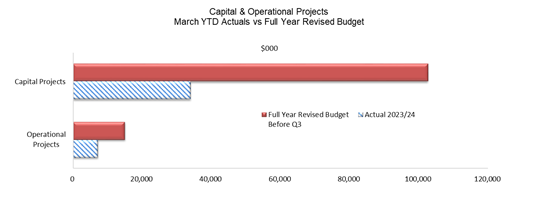
The March review
recommends a net increase of $1.1m to the forecast project budget resulting in
a total revised budget of $118.8m.
The most significant
variations and projects proposed for adjustment are listed below:
· Additional expenditure:
o Golden Jubilee Carpark (recycled asphalt work)
($650k) funded from domestic waste reserve
o LVG Parking meters & software upgrade ($70k)
· Grant funded expenditure:
· Additional grants:
o TfNSW Wombat Crossing Fox Valley Road, Wahroonga
($78k)
o TfNSW Wombat Crossing Hunter Avenue, St Ives
($70k)
o Federal Department of Health-Joint sector support
and development in the Northern Sydney Aged Care Planning Region ($51k)
· Recurrent income funded expenditure:
o Passenger fleet ($49k) funded from increased tree
preservation order fines
· Other internal transfers:
o Transfer from capital projects to operating
projects ($80k)
o Transfer to recurrent for computer hardware
maintenance ($70k)
o Transfer from recurrent for consulting costs
associated with the proposed changes to NSW housing policy ($100k)
All Proposed Budget adjustments
for each Project and explanation for the changes are detailed in
Attachment A2 –
Summary of Capital and Operational Project Budget Adjustments
Statement
by Responsible Accounting Officer
It is my opinion that the Quarterly Budget Review Statement
for Ku-ring-gai Council for the quarter ended 31 March 2024 indicates that
Council’s projected financial position at 30 June 2024 will be
satisfactory, having regard to the projected estimates of income and
expenditure and the original budgeted income and expenditure.
integrated
planning and reporting
Theme 6: Leadership and Governance
|
Community Strategic Plan Long Term Objective
|
Delivery Program
Term Achievement
|
Operational Plan
Task
|
|
L2.1 Council rigorously manages its financial resources
and assets to maximise delivery of services.
|
L2.1.2 Council’s financial services provide
accurate, timely, open and honest advice to the community.
|
Manages financial performance to achieve targets as
defined in the Long Term Financial Plan.
|
Governance
Matters
Section 203(1) of the Local
Government Regulation 2005 requires that at the end of each quarter, a Budget
Review Statement be prepared and submitted to Council that provides the latest
estimate of Income and Expenditure for the current financial year.
Risk
Management
Income and expenditure is managed through the quarterly
budget review process. Although some income and expenditure cannot be directly
controlled, it can be monitored and action taken to mitigate potential
financial or budgetary risk. Further, Council staff utilise monthly management
reporting for managing operational and project income and expenditure, and any
budget variations are reported to the Director. The management team are also
provided with monthly financial reports that allow executives to make informed
decisions and plan ahead to ensure budget targets are met.
Financial
Considerations
Financial impacts from recommended budget adjustments are discussed
in detail in other sections of this report.
Social
Considerations
Not applicable.
Environmental
Considerations
Not applicable.
Community
Consultation
Not applicable.
Internal
Consultation
Finance met with directors and managers as part of the
Quarterly Budget Review process to ensure departmental budget targets reflect
current forecasts.
Summary
Proposed budget adjustments outlined in this review are
projected to have no impact on the net operating result (excluding capital
grants). This is mainly due to additional interest on investments (partly
restricted to reserves), user fees and operating grants fully offset by a
decrease in other revenue, increase in materials and contracts, other expenses
and operating project expenses.
After adjusting for capital and operational grants, project
expenditure and restricted items, the net working capital will remain
unchanged.
|
Recommendation:
That the March 2024 Quarterly Budget Review and the
recommended changes be received and noted.
|
|
Angela Apostol
Acting Director Corporate
|
Mette Kofoed
Strategic Management Accountant
|
|
Ann Wang
Acting Manager Finance
|
|
|
Attachments:
|
A1 ⇩ ⇩
|
Attachment
A1 - Restricted Assets Report - March 2024
|
|
2024/150337
|
|
|
A2 ⇩ ⇩
|
Attachment
A2 - Summary of Capital and Operational Projects Budget Adjustments - March
2024
|
|
2024/150342
|
|
ATTACHMENT No: 1 - Attachment A1
- Restricted Assets Report - March 2024
|
|
Item No: GB.4
|

|
ATTACHMENT No: 2 - Attachment A2
- Summary of Capital and Operational Projects Budget Adjustments - March 2024
|
|
Item No: GB.4
|








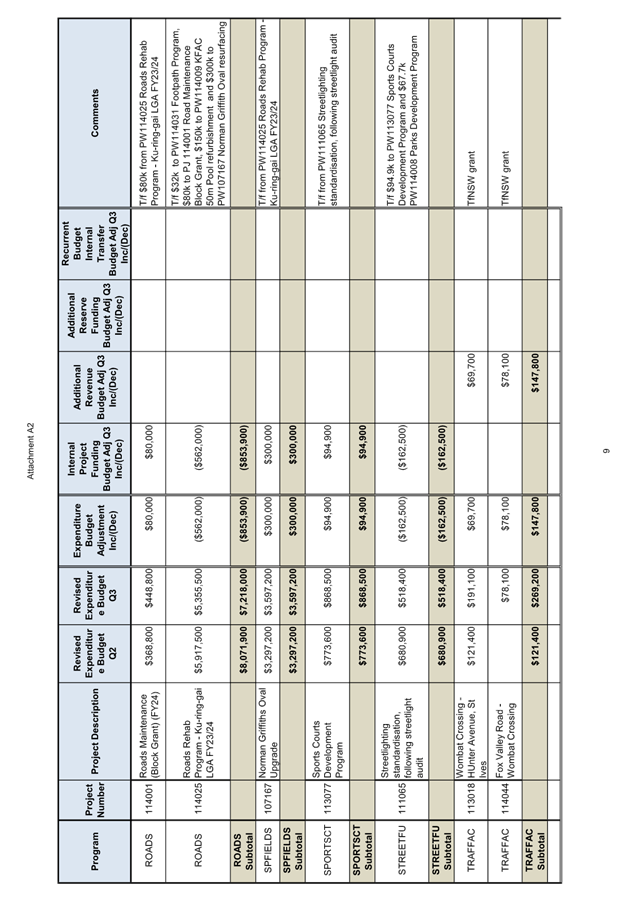
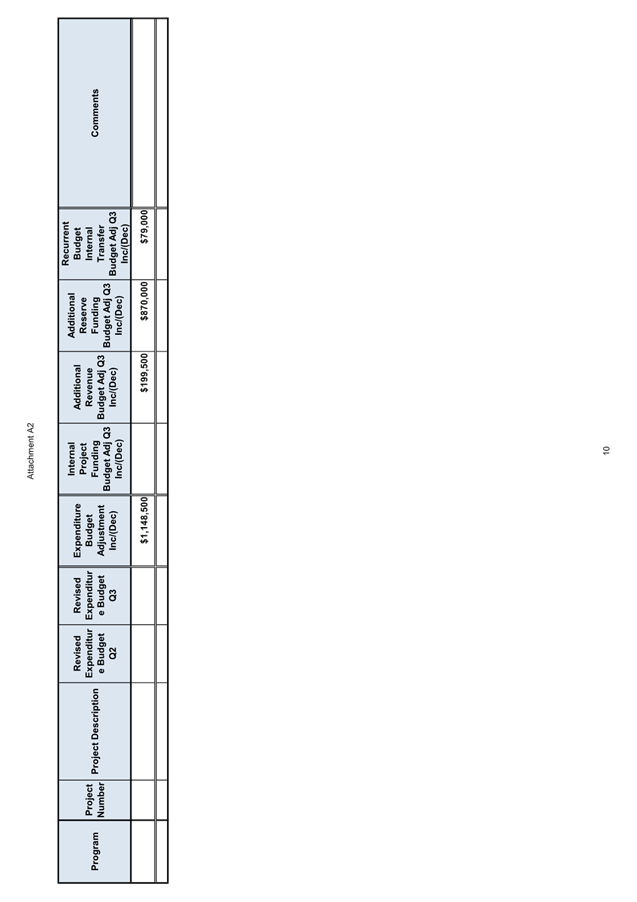
|
Ordinary
Meeting of Council - 21 May 2024
|
GB.5 / 1
|
|
|
|
|
Item
GB.5
|
FY00623/6
|
|
|
1 May 2024
|
Analysis of Land and Environment Court
Costs - 3rd Quarter 2023 to 2024
EXECUTIVE
SUMMARY
Purpose of Report
To report legal costs in relation to development control
matters in the Land and Environment Court for the quarter ended 31 March 2024.
Background
A
person may commence proceedings in the Land and Environment Court in relation
to a development application which has either been refused by Council or is
deemed to have been refused (a development application is deemed to have been
refused if it has not been determined within a period of 40 days or such longer
period that may be calculated in accordance with the Act). An appeal may also
be commenced in relation to conditions of development consent and the issue of
building certificates and orders. Council is a respondent to such
proceedings.
Comments
Appeals
Lodged
In the quarter ended 31 March 2024 there were six new
appeals lodged with the Land and Environment Court. The number of appeals
received in prior years is as follows:
|
Financial year
|
Number of appeals
received (whole year)
|
|
2019/2020
|
25
|
|
2020/2021
|
13
|
|
2021/2022
|
18
|
|
2022/2023
|
36
|
|
2023/2024 (as at 31
March 2024)
|
13
|
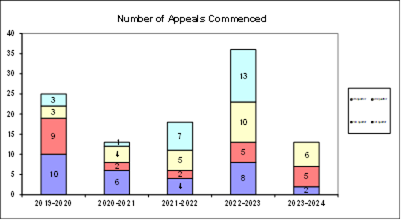
The appeals commenced during the quarter to 31 March 2024
concerned the following subject matter:
· Multi-dwelling
housing
· Subdivision
· Single dwelling
Council was also in receipt of one appeal against a
Development Control Order.
costs
For the quarter ended 31
March 2024, Council made payments of $953,492 on appeals and associated
expenses in relation to Land & Environment Court matters. This compares
with the annual budget of $1,338,800.
In addition to expenditure on appeals, a further amount of
$4,043 was spent in obtaining expert advice regarding development assessment
matters.
|
Land &
Environment Court Costs
2019/2020
- 2023/2024
|
|
Financial Year
|
Total Costs
|
1st quarter September
|
2nd quarter December
|
3rd quarter March
|
4th quarter June
|
|
2019/2020*
(25 appeals lodged)
|
$1,892,040
|
$417,046
|
$446,071
|
$543,218
|
$485,705
|
|
2020/2021*
( 13 appeals lodged)
|
$1,512,459
|
$356,735
|
$501,925
|
$278,510
|
$375,289
|
|
2021/2022 *
(18 appeals lodged)
|
$1,114,447
|
$402,328
|
$258,053
|
$226,500
|
$227,566
|
|
2022/2023
(36 appeals lodged)
|
$1,261,734
|
$324,397
|
$300,017
|
$474,367
|
$162,953
|
|
2023/2024
(7 appeals lodged)
|
$ 953,492
|
$381,788
|
$366,869
|
$204,835
|
|
* Costs reported to Council in previous reports
The costs
incurred in the period to 31 March 2024 represent 71.22% of the annual budget
of $1,338,800. In recent reported periods, there has been a trend of increasing
numbers of appeals.
The
commencement of appeals does not lie within the control of Council, however
there a number of factors that appear to have influenced the volume of appeals:
· Amendments to the Environmental Planning and Assessment
Act made in 2013 and then reintroduced in 2022 reduced the timeframe for
lodgement of an appeal from twelve months to six months. This had the
effect of applicants for more substantial and complex development proposals
lodging appeals for no other reason than as a mechanism to preserve early
appeal rights. The number of development applications received by Council in
recent periods has itself been high.
· In addition, the prospect of changing economic market
conditions in recent periods appears to have led to urgency on the part of
developers, with a particularly high number and proportion of appeals commenced
at an early stage on the basis of deemed refusal. As a result, Court
listings are currently heavily booked and long delays for several months for
the holding of both mediation conferences and hearings are occurring.
· Due to the abovementioned delays, the Court has
increasingly required parties to participate in without-prejudice meetings in
the meantime. These meetings have tended to result in additional
iterations of amended plans being provided by applicants during the appeal
process and therefore, additional costs.
· The additional pressure on application processing times
arising from the Statement of Expectations issued to all NSW councils by the
previous Minister for Planning in December 2021, which remains in force.
Notwithstanding
these factors, Council’s overall success rate in appeals has been high.
In
relation to costs recovered, the amount of $151,395 had been recovered as 31
March 2024 compared to an annual budget for costs recovered of $114,900.
Outcomes
At an early stage of each appeal, Council as respondent, is
required to file with the Court a Statement of Facts and Contentions outlining
the grounds which Council asserts as warranting refusal of a development, or
alternatively, that may be addressed by way of conditions of consent.
In cases
where issues raised by Council are capable of resolution by the provision by
the applicant of additional information or amendment of the proposal, it is the
Court’s expectation that this should occur. The Court’s
current practice of listing appeals for a preliminary mediation conference
before a Commissioner of the Court pursuant to section 34 of the Land &
Environment Court Act, strongly encourages this.
In this
context, any of three outcomes can be regarded as favourable, namely:
1. If the appeal is in
relation to a deemed refusal of an application which, upon assessment, is
appropriate for approval: that the development is determined by Council,
allowing the appeal to be discontinued by the applicant and avoiding as much as
is practicable the incurring of unnecessary legal costs;
2. If the issues raised
by Council are capable of resolution by the applicant providing further
information, or amending the proposal: that this occurs, so that
development consent should be granted, either by Council or the Court;
3. If the issues raised
by Council are either not capable of resolution or the applicant declines to
take the steps that are necessary to resolve them: that the appeal is
either discontinued by the applicant, or dismissed (refused) by the Court.
Six matters were concluded during the quarter. A favourable
outcome was achieved in all matters:
· one appeal was
dismissed
· four appeals were
resolved by agreement in relation to an amended proposal
· one appeal was
upheld in relation to an amended proposal
· one appeal was
discontinued by the applicant
As at 31 March 2024, there was a total of 14 matters
proceeding before the Court.
integrated
planning and reporting
Leadership & Governance
|
Community Strategic Plan Long Term Objective
|
Delivery Program
Term Achievement
|
Operational Plan
Task
|
|
L2.1 Council rigorously manages its financial
resources and assets to maximise delivery of
services.
|
Achieve financial sustainability targets
identified in the Long Term Financial
Plan.
|
Undertake quarterly reporting to Council on the financial
performance of the
organisation.
|
Governance Matters
Under
Section 428 of the Local Government Act 1993, Council is required to report
legal costs, and the outcome of each case in its Annual Report.
Risk Management
Quarterly reporting of legal
costs to Council together with information about the number, character and
outcomes of proceedings enable ongoing oversight of this area of
Council’s activity.
Financial Considerations
Land
& Environment Court legal costs form part of Council’s recurrent
operating budget.
Social Considerations
None undertaken or required.
Environmental Considerations
None undertaken or required.
Community Consultation
None undertaken or required.
Internal Consultation
This
report has been developed with input from Council’s Corporate Lawyer,
Director Corporate and Director Development & Regulation.
Summary
For the
period ended 31 March 2024, Council made payments of $953,492 on Land &
Environment Court appeals. This compares with the annual budget of $1,338,800.
|
Recommendation:
That the analysis of Land and Environment Court costs
for the year ended 31 March 2024 be received and noted.
|
|
Tony Ly
Financial Accounting Officer
|
Jamie Taylor
Corporate Lawyer
|
|
Michael Miocic
Director Development & Regulation
|
|
|
Attachments:
|
A1 ⇩ ⇩
|
Individual
Case Summary March 2024 - Land and Environment Court Costs
|
|
2024/162216
|
|
ATTACHMENT No: 1 - Individual
Case Summary March 2024 - Land and Environment Court Costs
|
|
Item No: GB.5
|
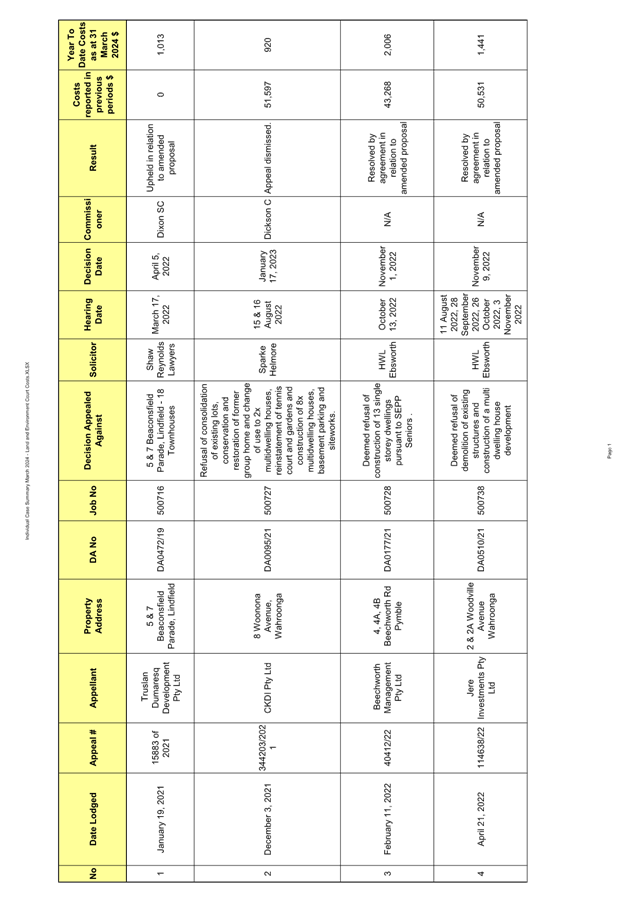
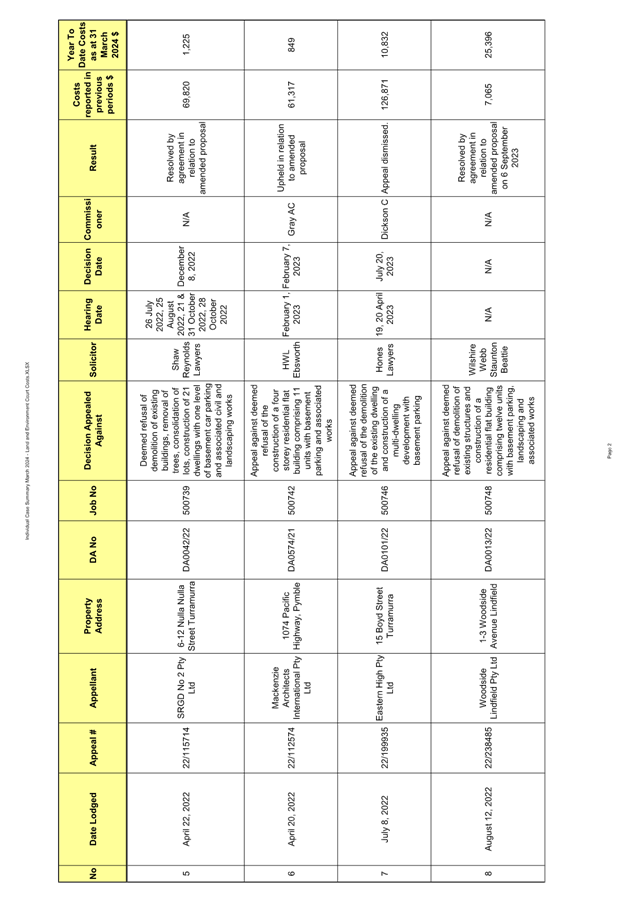
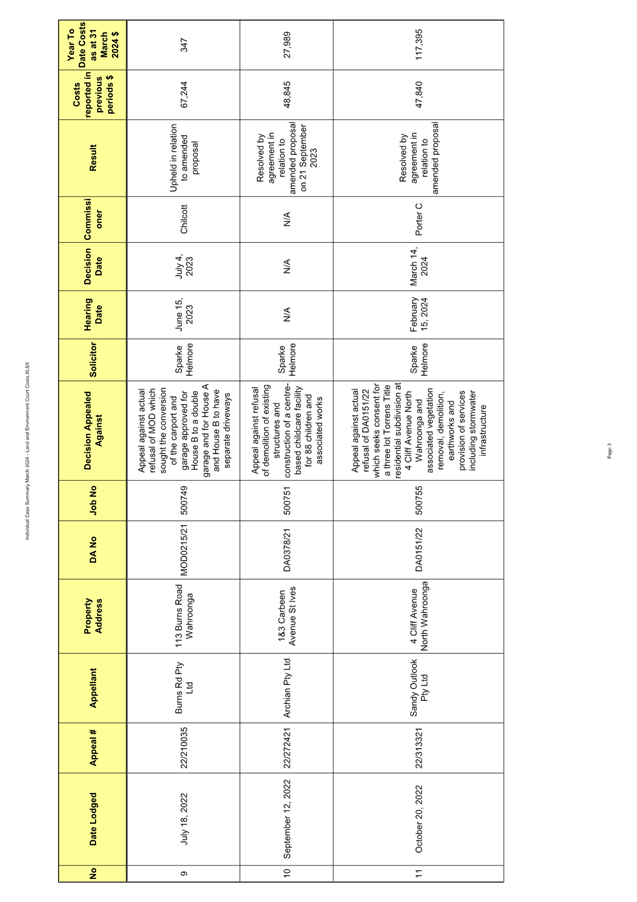
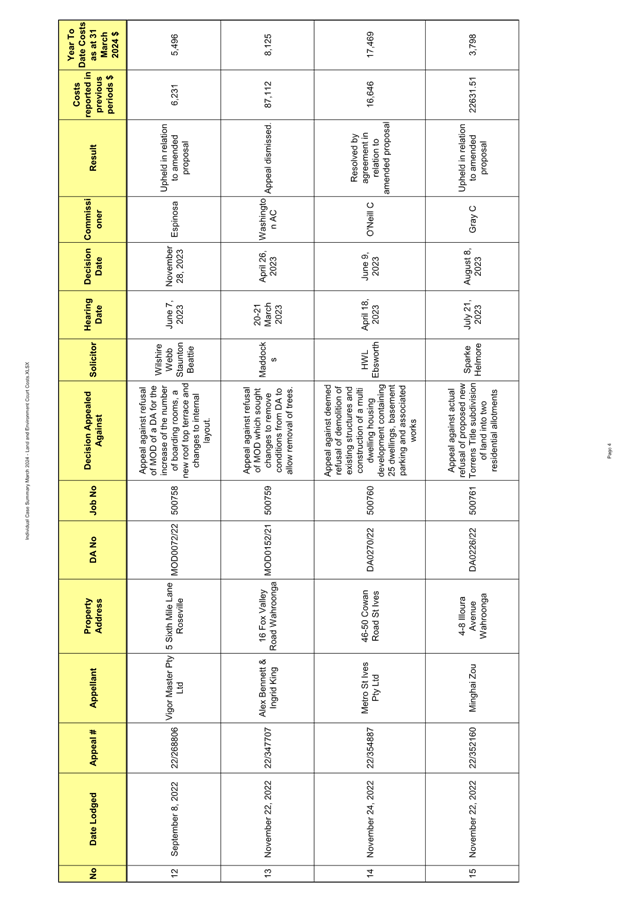
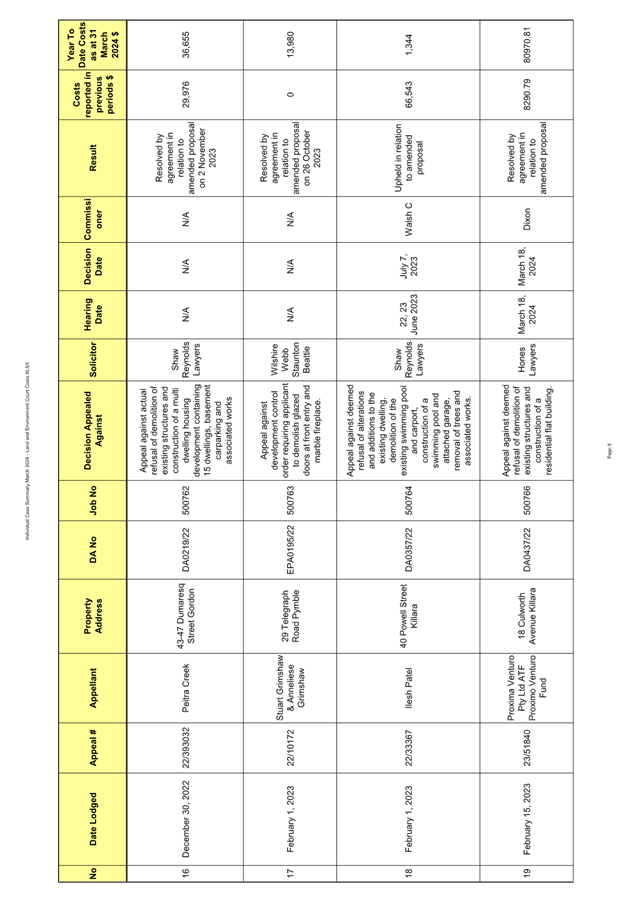
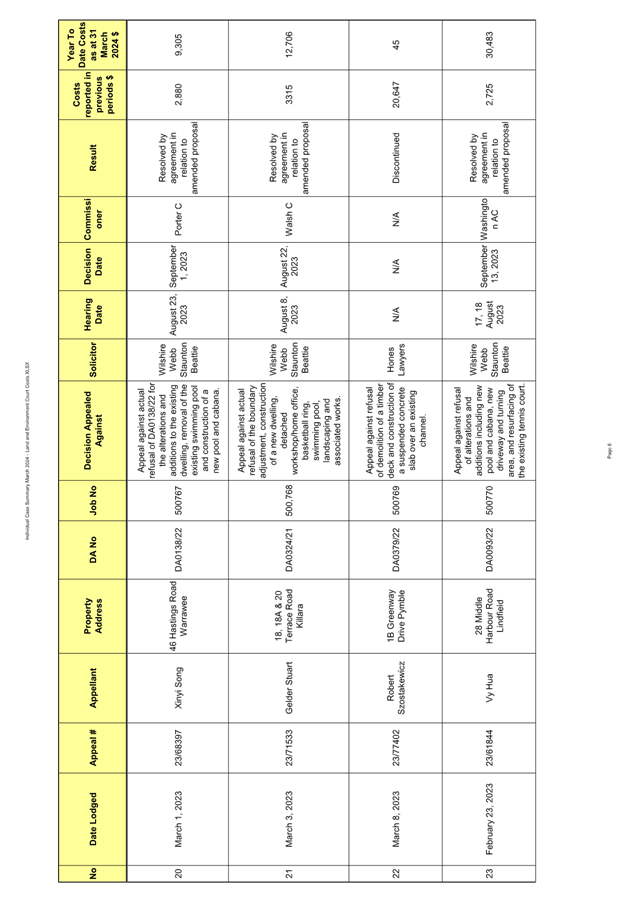
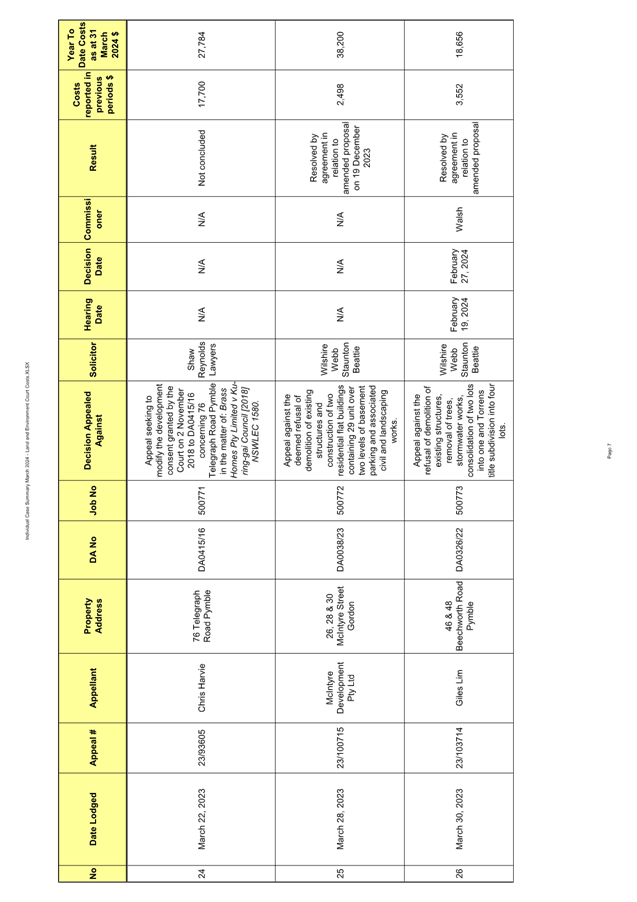
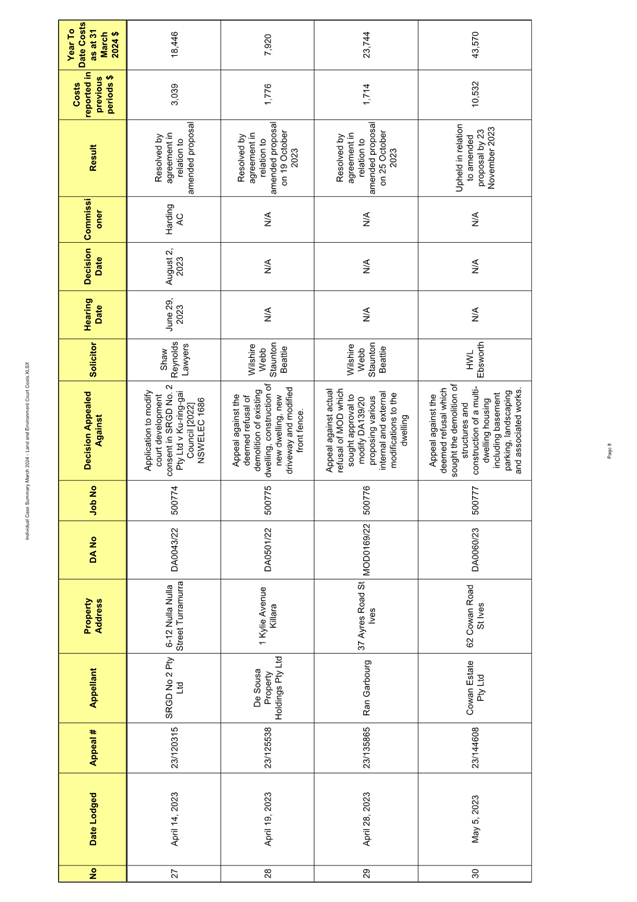
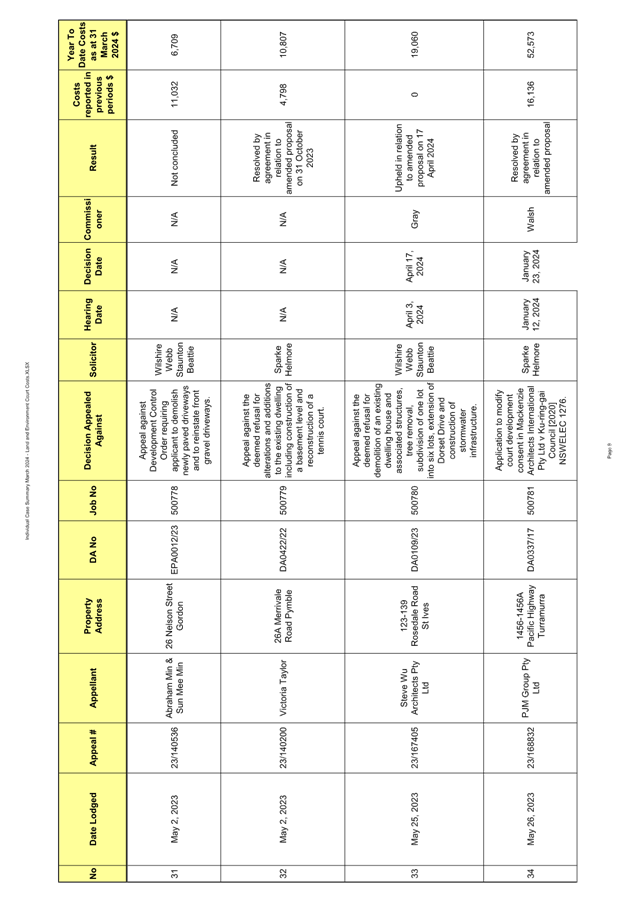
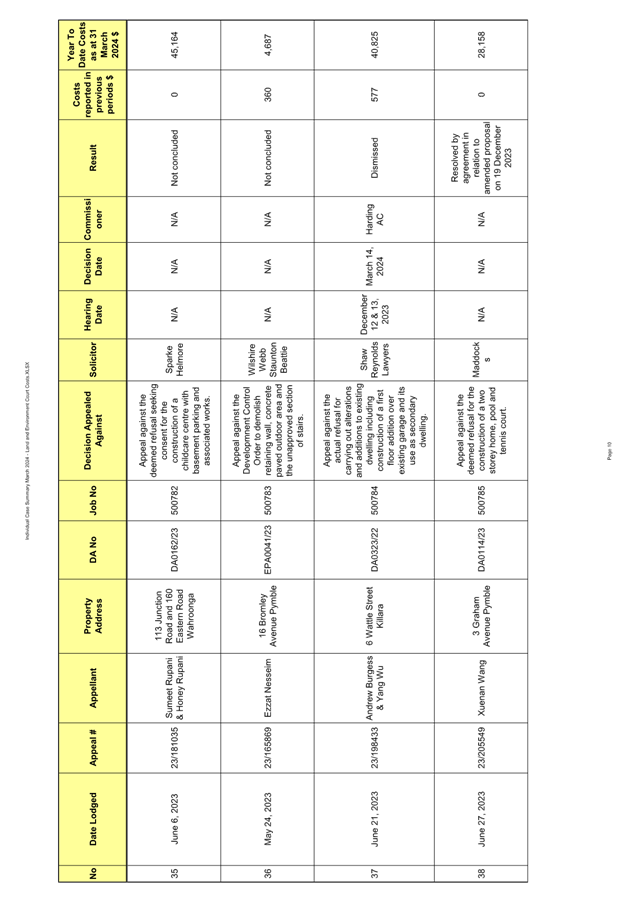
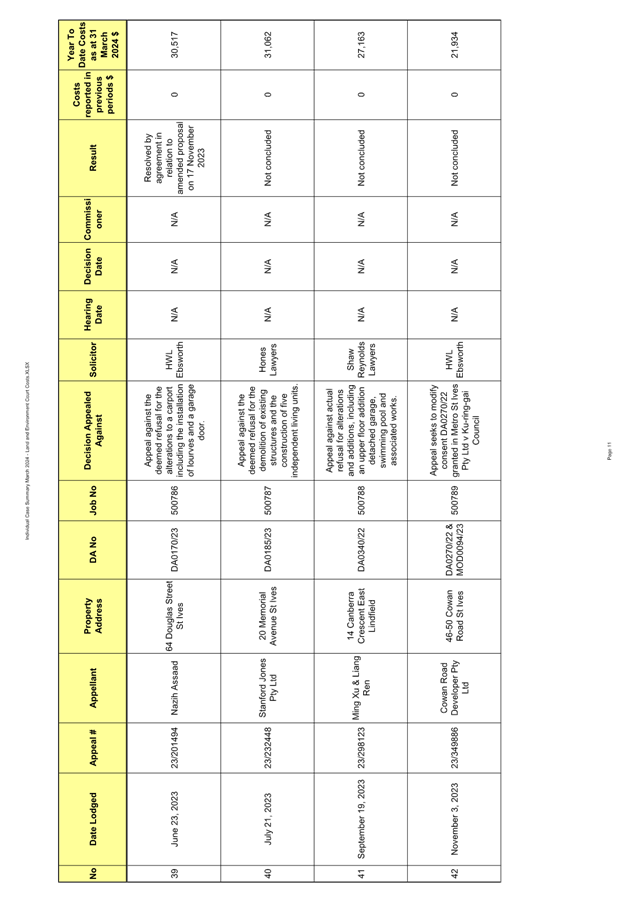
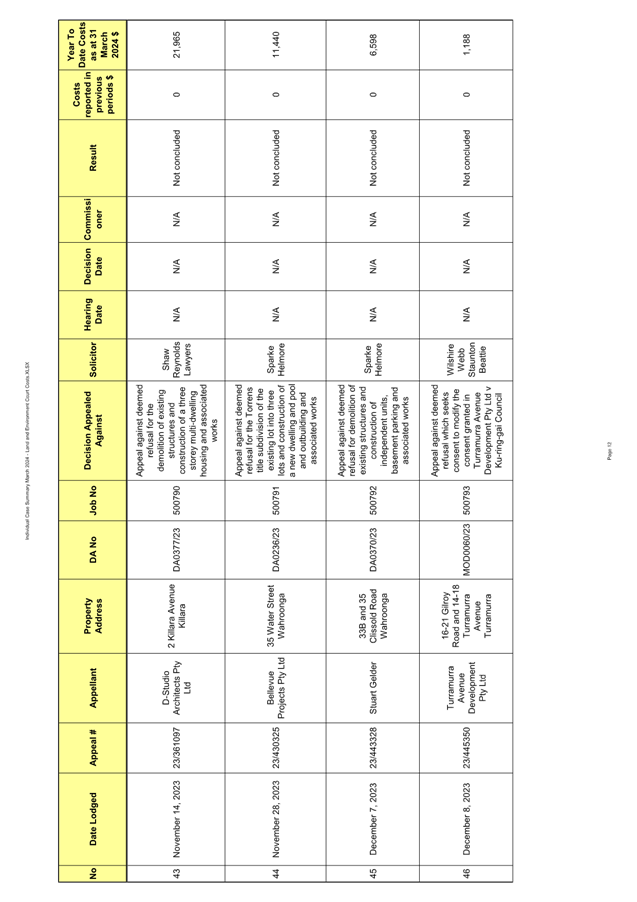
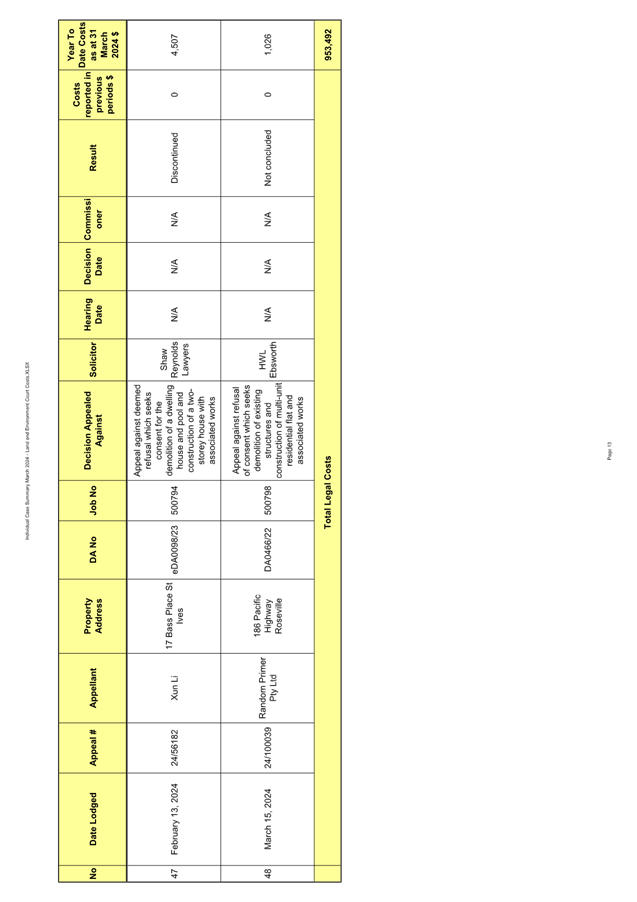
|
Ordinary
Meeting of Council - 21 May 2024
|
GB.6 / 1
|
|
|
|
|
Item
GB.6
|
FY00623/6
|
|
|
23 April 2024
|
Investment Report as at 30 April 2024
EXECUTIVE
SUMMARY
Purpose of Report
To present Council’s investment portfolio performance
for April 2024.
Background
Council’s investments are reported monthly to Council
in accordance with the Local Government Act 1993, the Local Government
(General) Regulation 2005 and Council’s Investment Policy.
Comments
Investment Portfolio Performance Snapshot
The table below provides the investments portfolio
performance against targets identified in Council’s Investment Policy as
well as other key performance indicators based on industry benchmarks.
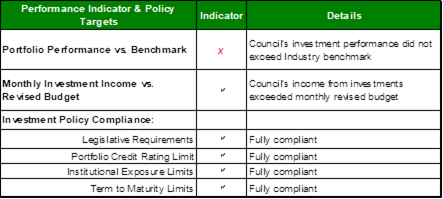
Cumulative
Investment Returns against Revised Budget
The net return on investments for the financial year to 30
April 2024 was $7,449,000 against the revised budget of $6,718,000 giving a
year-to-date favourable variance of $731,000 as shown in the table below. The
investment portfolio performed well with the favourable variance mainly
resulting from more competitive interest rates. Council anticipates further
favourable returns in the upcoming months, and thus, a budget increase of
$511,000 has been recommended as part of the March 2024 Quarterly Budget
Review.

A comparison of the
cumulative investment returns against year-to-date revised budget is shown in
the chart below.
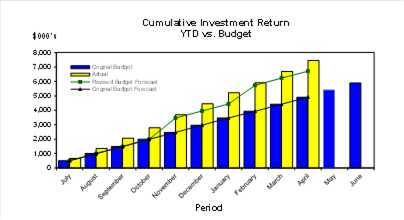
Cash
Flow and Investment Movements
Council’s total cash and
investment portfolio as at 30 April 2024 was $206,810,000 compared to
$208,231,000 at the end of March 2024, a net cash outflow of $1,421,000 mainly due creditor payments. Three investments
matured and three new investments were made during the month.
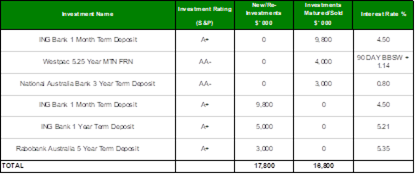
Investment
Performance against Industry Benchmark
Overall during the month of
April, the investment performance was slightly below the industry benchmark.
Previous year’s increases in interest rates announced by RBA have been
reflected in the benchmark rate, while Council’s current investments
portfolio dominated by term deposits take longer to reflect a rate
change.
The benchmark is specific to the
type of investment and the details are provided below. AusBond Bank Bill Index
is used for all Council’s investments.
Table 1 -
Investments Performance against Industry Benchmarks

Table 2
below provides a summary of all investments by type and performance during the
month.
Table 2 - Investments Portfolio Summary during April 2024
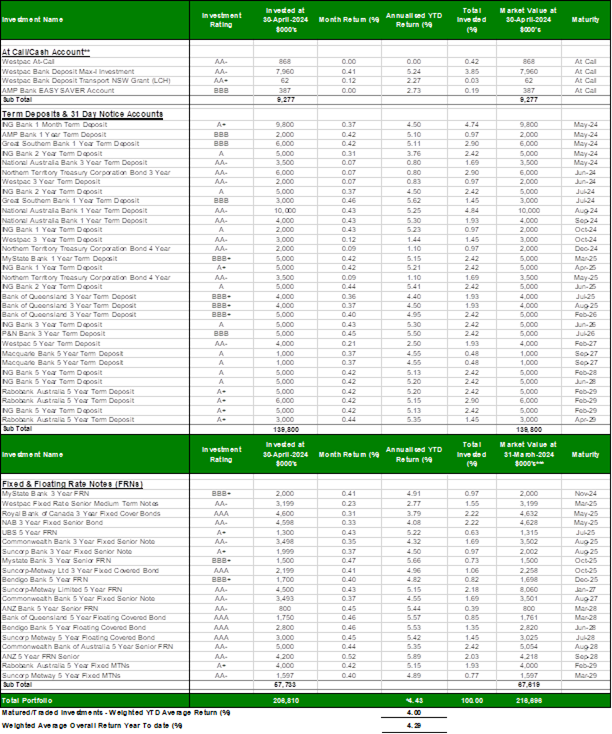
*
Weighted average returns.
**
Funds in at-call/short term accounts are working funds kept for the purpose of
meeting short term cash outflows. At-call investments portfolio is being
monitored on a regular basis to ensure funds are reinvested at higher rates
when opportunities arise, whilst also keeping and adequate balance for
short-term cash outflows.
***
Market Values as at 30 April 2024 were not available at the time of writing the
report.
Investment
by Credit rating and Maturity Profile
The allocation of
Council’s investments by credit rating and the maturity profile are shown
below:

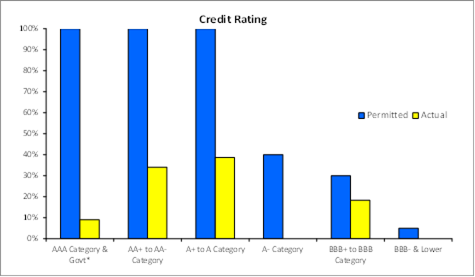
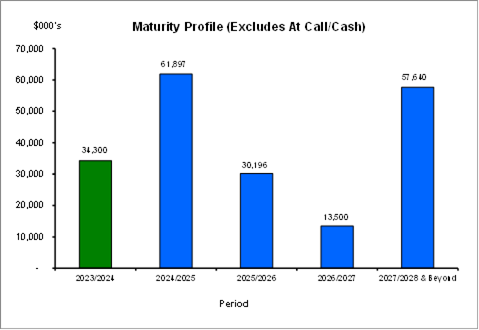
integrated
planning and reporting
Leadership & Governance
|
Community Strategic Plan Long Term Objective
|
Delivery Program
Term Achievement
|
Operational Plan
Task
|
|
L2.1 Council rigorously manages its financial resources
and assets to maximise delivery of services
|
Council maintains and improves its long term financial
position and performance
|
Continue to analyse opportunities to expand the revenue
base of Council
|
Governance
Matters
Council’s investments are made in accordance with the
Local Government Act (1993), the Local Government (General) Regulation 2005 and
Council’s Investment Policy.
Section 212 of the Local Government (General) Regulation
2005 states:
(1) The
responsible accounting officer of a council:
(a) must
provide the council with a written report (setting out details of all money
that the council has invested under section 625 of the Act) to be presented:
(i) if
only one ordinary meeting of the council is held in a month, at that meeting,
or
(ii) if
more than one such meeting is held in a month, at whichever of those meetings
the council by resolution determines, and
(b) must
include in the report a certificate as to whether or not the investment has
been made in accordance with the Act, the regulations and the council’s
investment policies.
(2) The report must be made up to
the last day of the month immediately preceding the meeting.
Risk
Management
Council manages the risk associated with investments by
diversifying the types of investment, credit quality, counterparty exposure and
term to maturity profile.
Council invests its funds in accordance with The Ministerial
Investment Order.
All investments are made with consideration of advice from
Council’s appointed investment advisor, CPG Research & Advisory.
Financial
Considerations
The revised budget for interest on investments for the
financial year 2023/2024 is $7,697,000. Of this amount approximately $4,690,100
is restricted for the benefit of future expenditure relating to development
contributions, $1,214,100 transferred to the internally restricted
Infrastructure & Facility Reserve, and the remainder of $1,792,800 is
available for operations. A favourable budget increase of $511,000 is
recommended in the March QBR in line with continuous positive returns.
Social Considerations
Not applicable.
Environmental Considerations
Not applicable.
Community
Consultation
None undertaken or required.
Internal
Consultation
None undertaken or required.
Certification -
Responsible Accounting Officer
I hereby certify that the investments listed in the attached
report have been made in accordance with Section 625 of the Local Government
Act 1993, clause 212 of the Local Government General Regulation 2005 and
Council’s Investment Policy.
Summary
As at 30
April 2024:
· Council’s
total cash and investment portfolio is $206,810,000, a decrease of $1,421,000
from the previous month.
· The
net return on investments for the financial year to the end of 30 April 2024
was $7,449,000 against the revised budget of $6,718,000 giving a year-to-date
favourable variance of $731,000. The favourable
variance is mainly due to higher interest rates than budgeted.
· A
budget increase of $511,000 is recommended in the March QBR in line with
continuous positive returns.
|
Recommendation:
That:
A. The summary of investments and performance for April 2024 be
received and noted.
B. The Certificate of the Responsible Accounting Officer be
noted and the report adopted.
|
|
Tony Ly
Financial Accounting Officer
|
Ann Wang
Acting Manager Finance
|
|
Angela Apostol
Acting Director Corporate
|
|
|
Ordinary
Meeting of Council - 21 May 2024
|
GB.7 / 1
|
|
|
|
|
Item
GB.7
|
CY00043/16
|
|
|
5 May 2024
|
St Edmund’s College community
fundraising event
EXECUTIVE
SUMMARY
|
purpose of report:
|
To advise Council of the
opportunity to purchase tickets for St Edmund’s College’s community
fundraising event (Eddie’s Big Night Out) on 15 June 2024.
|
|
|
|
|
background:
|
St Edmund’s College is a Year 7-12
co-educational special high school including education and support for
students with mild to moderate intellectual disability, autism and other
sensory impairments.
|
|
|
|
|
comments:
|
Eddie’s Big Night Out will be held on 15 June
2024 at Miramare Gardens, Terrey Hills. Individual tickets for guests are
$200. Table bookings for 10 guests are available for $2,000, with sponsorship
packages available from $3,700.
|
|
|
|
|
recommendation:
|
That:
A. Council decides
whether to purchase a table for St Edmund’s College’s community
fundraising event (Eddie’s Big Night Out); and
B. If supported,
that Councillors interested in attending advise the General Manager by 24 May
2024.
|
Purpose of Report
To advise Council of the opportunity to purchase tickets for
St Edmund’s College’s community fundraising event (Eddie’s
Big Night Out) on 15 June 2024.
Background
St Edmund’s College is a Year 7-12 co-educational
special high school in Wahroonga. It provides education and support for
students with mild to moderate intellectual disability, autism and other
sensory impairments. Ku-Ring-Gai Council has been invited to the school’s
community fundraising event.
Comments
Eddie’s Big Night Out will be held on 15 June 2024 at
Miramare Gardens, Terrey Hills. Individual tickets for guests are $200 and a
table for 10 guests is available for $2,000.
Sponsorship packages are available for $3,700, $5,700,
$8,000 or $10,000.
Further information can be found on the website: https://www.stedmunds.nsw.edu.au/our-community/events/eddies-big-night-out/
integrated
planning and reporting
|
Community Strategic Plan Long Term Objective
|
Delivery Program
Term Achievement
|
Operational Plan
Task
|
|
C3.1: An equitable, inclusive and resilient community that
cares and provides for its residents and embraces healthier lifestyles
|
3.1.1: Council’s policies,
programs and advocacy address the social, information and
health needs of all age groups, reduce disadvantage and address gaps in
service provision.
|
C3.1.1.2: Partner with key stakeholders to deliver
community programs in response to identified
community needs.
|
Governance
Matters
Attendance at functions and events are provided for in the
Councillor Expenses and Facilities Policy, including attendance by accompanying
persons.
Risk
Management
No significant risks.
Financial
Considerations
Under the Councillor Expenses
and Facilities Policy, Council will meet the reasonable cost of attendance at
functions and events held by charities and community organisations relevant to
the LGA or Council’s wider interest.
Social
Considerations
By supporting the school, Council is building strategic
partnerships and connections with local education providers and young people.
Attendance at the event will enable Councillors to meet members of the
community and learn about education and support services delivered to young
people with disability in the Ku-ring-gai area.
Environmental
Considerations
Nil
Community
Consultation
Nil required
Internal
Consultation
Nil required
Summary
Ku-Ring-Gai Council has been invited to attend St
Edmund’s College’s community fundraising event in June 2024 2023.
|
Recommendation:
That:
A. Council decides
whether to purchase a table for St Edmund’s College’s community
fundraising event (Eddie’s Big Night Out); and
B. If supported,
that Councillors interested in attending advise the General Manager by 24 May
2024.
|
|
Christopher M Jones
Manager Governance & Corporate Strategy
|
|
|
Ordinary
Meeting of Council - 21 May 2024
|
GB.8 / 1
|
|
|
|
|
Item
GB.8
|
FY00621/6
|
Project Status Report - May 2024
EXECUTIVE
SUMMARY
|
purpose of report:
|
To provide Council with the
Project Status Report for February, March and April 2024.
|
|
|
|
|
background:
|
On 22 May 2018, a Notice of Motion was considered by
Council regarding the development of a monthly Project Status Report.
On 14 May 2019, Council resolved to extend the reporting
timeframe from monthly to a quarterly.
|
|
|
|
|
comments:
|
The Notice of Motion noted that while projects are
reported to Council and the community through a number of other reports, the
frequency of reporting is a more reliable and recurring method to update
Council and the community.
The report will be placed on Council’s website
following Council’s resolution.
|
|
|
|
|
recommendation:
|
That Council receive and note
the Project Status Report for February, March, and April 2024.
|
Purpose of Report
To provide Council with the Project Status Report for
February, March and April 2024.
Background
On 22 May 2018, a Notice of Motion (NOM) was considered by
Council regarding the development of a monthly Project Status Report. As
a result, Council resolved the following;
A. That
a Capital and Operational Projects Report is to be tabled at an ordinary
meeting of council each month. The reporting will commence in FY19 with a
report for the period of July 2018.
B. That
the report should include any progress made in the month as well as a progress
summary for the financial year to date. Where there has been no progress in the
month, it is acceptable to acknowledge that nothing has progressed. And where a
project has yet to commence, it is acceptable to note the expected start date.
C. That
council staff may use their discretion in deciding whether any additional
columns of information should be presented.
D. That
the reported projects should include, but are not limited to, those that are
mentioned in Council’s Delivery Program and Operational Plan. For
brevity, council staff may choose to aggregate some projects or set a
reasonable threshold for reporting purposes.
E. That
the current and historical monthly reports should be easily found on the Ku-ring-gai
Council website (i.e. not just through searching council agenda items). One
possibility is to create a page for the monthly Capital and Operational
Projects Reports under “Current works and upgrades”.
F. That
after the first six months of the report, the Councillors and Directors should
discuss whether the frequency of the report should be adjusted.
On 14 May 2019, Council resolved to extend the reporting
timeframe from monthly to a quarterly report:
A. That
Council receive and note the Project Status Report for April 2019.
B. That
the Project Status Report be placed on Council’s website.
C. That
the reporting timeframe be changed from monthly to quarterly.
In accordance with Part C of the resolution of 22 May 2019,
the attached report is for the period February, March and April 2024
(Attachment A1).
Comments
Reporting on projects is currently undertaken through:
· Quarterly
Financial Reports;
· Bi-annual reports
on the progress of the Delivery Program & Operational Plan; and
· Annual Report.
The NOM noted that while projects are reported to Council
and the community through these statutory reports, the frequency of quarterly
reporting is a more reliable and recurring method to update Council and the
community.
The NOM guided the report structure and content for the
Project Status Report which Council staff has prepared based on the following
criteria:
· Capital projects
delivering community/public infrastructure;
· Threshold applied
to total budget per project – greater than or equal to $250k;
· No operational
projects are included; and
· Any specific
project that Councillors wish to be included in the report.
The report will be placed on Council’s website
following Council’s resolution.
integrated planning and reporting
Leadership & Governance
|
Community Strategic
Plan Long Term Objective
|
Delivery Program
Term Achievement
|
Operational Plan
Task
|
|
The organisation is recognised and distinguished by its
ethical decision-making, efficient management, innovation and quality
customer service.
|
Council's Governance framework is developed to ensure
probity and transparency.
|
Business papers and associated minutes are published in an
accurate and timely manner for public scrutiny and to encourage community
participation.
|
Governance Matters
The Project Status Report will be submitted to Council the
first meeting following the end of each quarter.
Risk Management
The Project Status Report is
not generated through Council’s corporate information and financial
systems. As such, it is reliant of key staff to provide input and to
critique.
Financial Considerations
There are no financial
implications associated with this report.
Social Considerations
The project status report
will be placed on Council’s website following Council’s resolution.
Environmental Considerations
Not applicable.
Community Consultation
Not applicable.
Internal Consultation
General Manager and
Directors, along with staff from Corporate, Operations and Strategy &
Environment have contributed to the structure and content of the Project Status
Report.
Summary
On 14 May 2019, Council resolved to extend the project
status reporting timeframe from monthly to quarterly.
The Project Status Report has been prepared based on the
following criteria:
· Capital projects
delivering community/public infrastructure;
· Threshold applied
to total budget per project – greater than or equal to $250k;
· No operational
projects are included; and
· Any specific
project that Councillors wish to be included in the report.
In accordance with Council’s resolution the attached
report is for the period February, March, and April 2024
|
Recommendation:
A. That
Council receive and note the Project Status Report for February, March and
April 2024.
B. That
the Project Status Report be placed on Council’s website.
|
|
Peter Lichaa
Manager Technical Services
|
Amanda Halcrow
PA to Director Operations
|
|
Attachments:
|
A1 ⇩ ⇩
|
Project
Status Report - February - April 2024
|
|
2024/159950
|
|
ATTACHMENT No: 1 - Project
Status Report - February - April 2024
|
|
Item No: GB.8
|
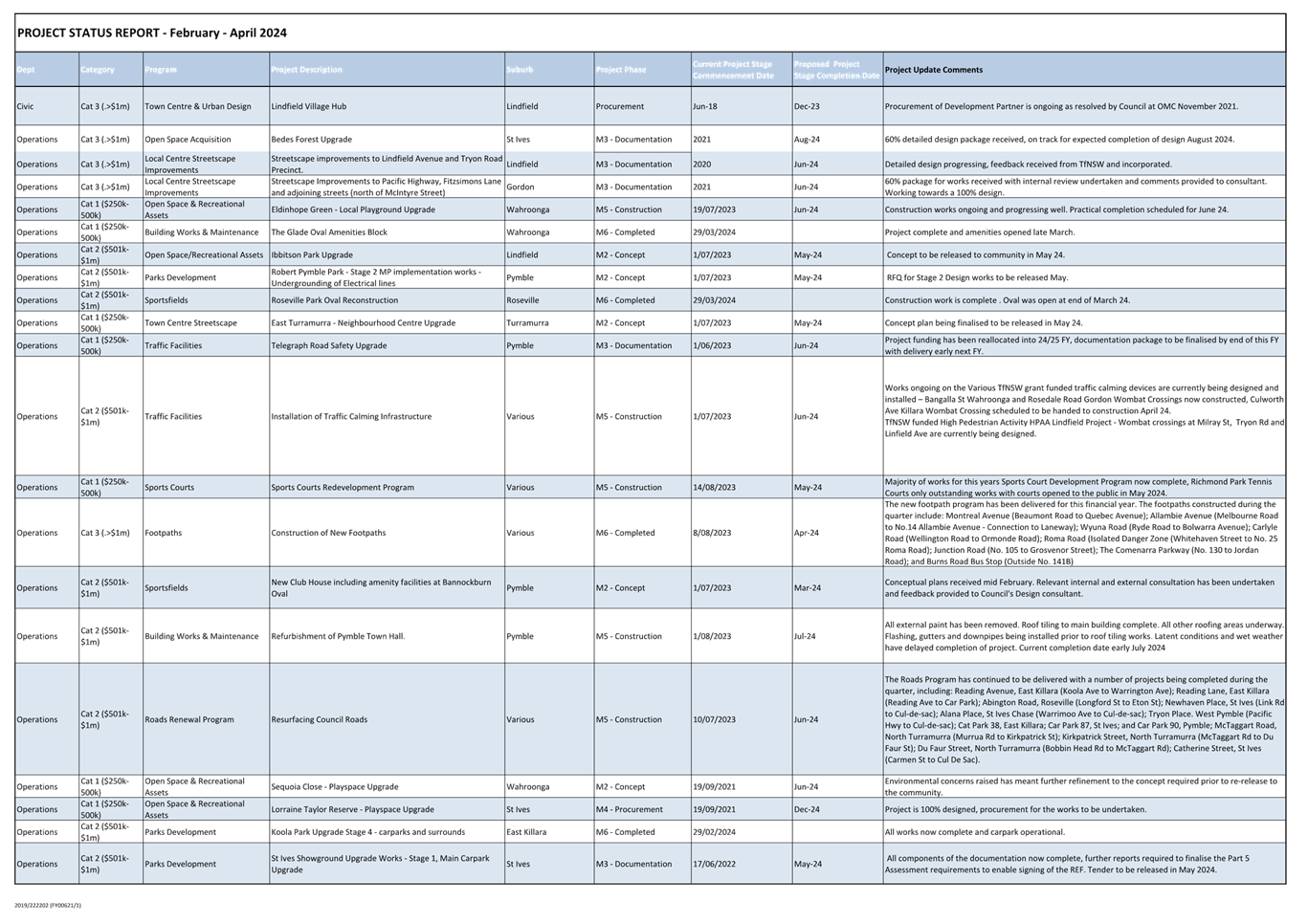
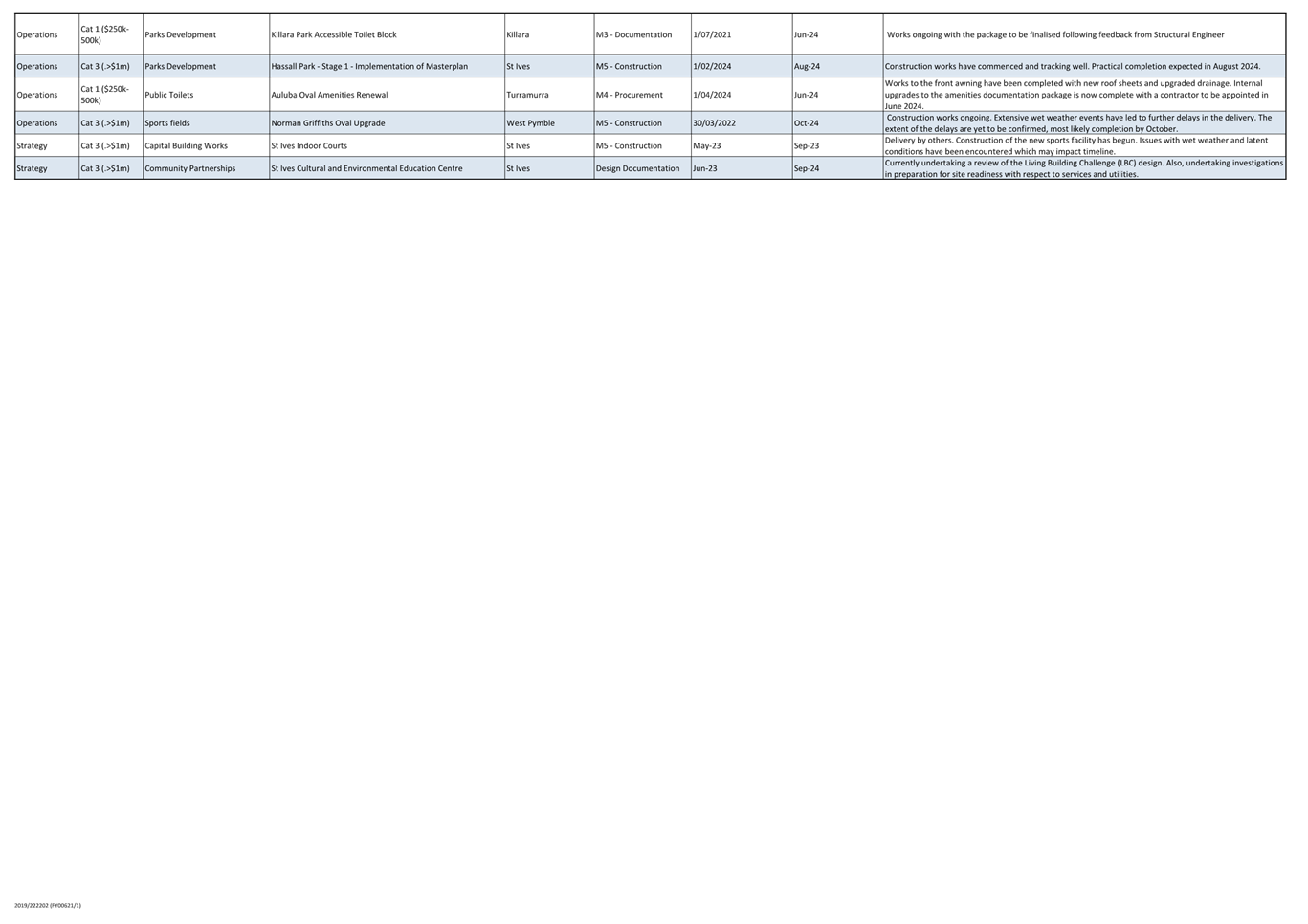
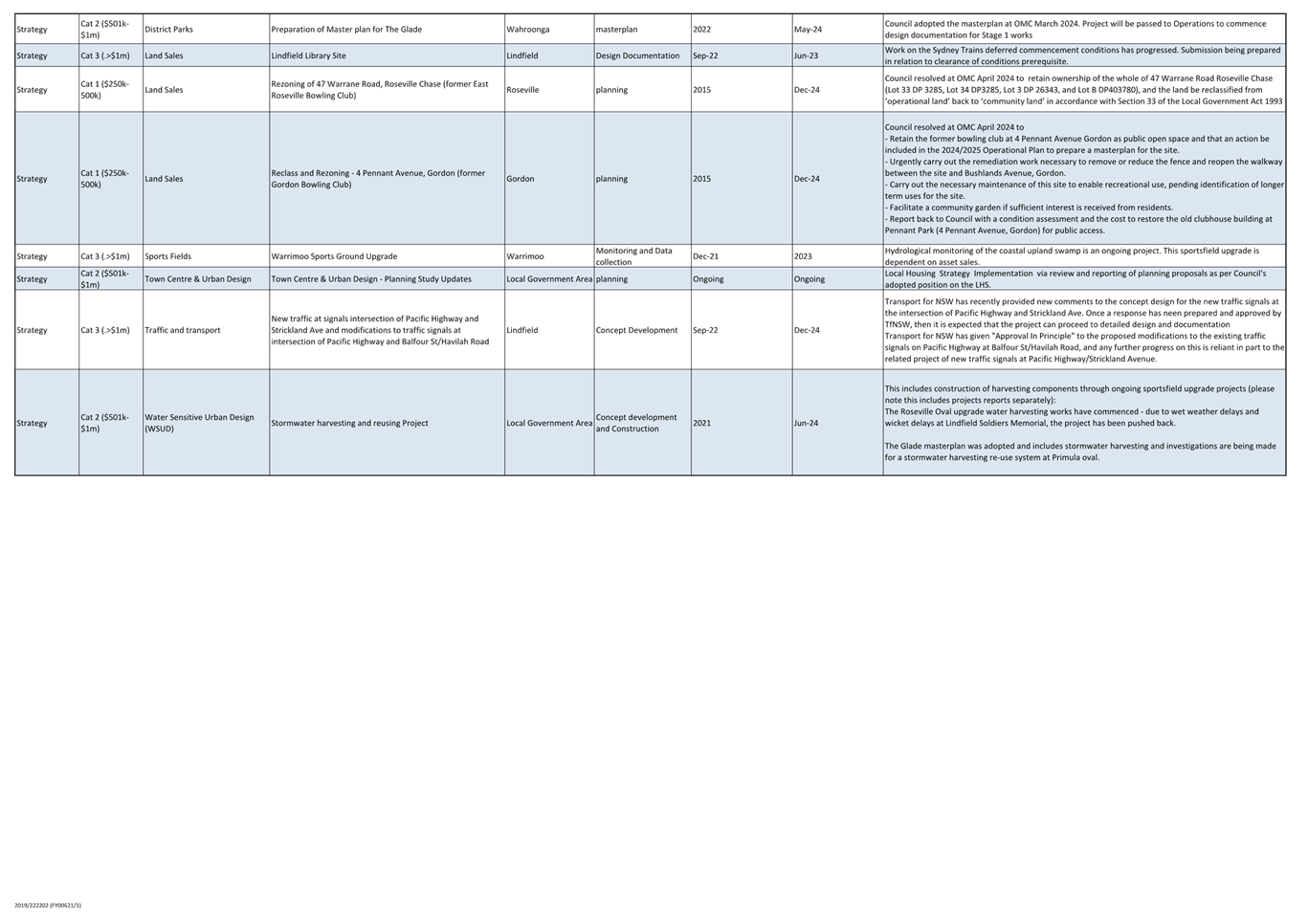

|
Ordinary
Meeting of Council - 21 May 2024
|
GB.9 / 1
|
|
|
|
|
Item
GB.9
|
S12227
|
No net loss of tree canopy
EXECUTIVE
SUMMARY
|
purpose of report:
|
Report back as per NM.5 of the OMC
of 19 March, which resolved that, Council reports back by May 2024 on the
feasibility of:
A. Amending the KDCP to achieve no net loss of canopy area at maturity and seek to
achieve a net gain, including some
quantification of the
historical change in canopy area pre and post development (at maturity) for
different types of development.
B. Adopting a policy of 'achieving a net
gain' of canopy area and under-storey vegetation during material changes to
Council-owned land; and
C. A system with supporting marketing to
promote and supply resident planting of locally indigenous trees and
vegetation across all storeys, from an ecosystem to suit their site-specific
soils and initially targeting green corridors.
|
|
|
|
|
background:
|
At the OMC of 19 March 2024, Council considered NM.5
on ‘No net loss of tree canopy’. The motion resolved that Council
report back by May 2024 on the feasibility of 3 proposals.
|
|
|
|
|
comments:
|
The feasibility of the 3 elements referred to in NM.5
of the OMC from 19 March have been considered and now reported back to
Council The proposals are multifaceted and complex and while this report
provides preliminary feasibility assessment for each component, additional
assessment and consultation will be required, particularly for part A and B
which respectively relate to amendments to the KDCP and a Policy for
“achieving a net gain” on Council owned land.
|
|
|
|
|
recommendation:
(Refer to the full Recommendation at the end of this
report)
|
That Council receive and note
this report.
That possible future amendments to the Ku-ring-gai DCP
be investigated as part of the Urban Forest Canopy Loss Analysis in
Ku-ring-gai Local Government Area project.
|
Purpose of Report
Report back as per NM.5 of the OMC of 19 March, which
resolved that, Council reports back by May 2024 on the feasibility of:
A. Amending the KDCP to achieve no net loss of canopy area at maturity and seek to
achieve a net gain, including some
quantification of the
historical change in canopy area pre and post development (at maturity) for
different types of development.
B. Adopting a policy of 'achieving a net
gain' of canopy area and under-storey vegetation during material changes to
Council-owned land; and
C. A system with supporting marketing to
promote and supply resident planting of locally indigenous trees and vegetation
across all storeys, from an ecosystem to suit their site-specific soils and
initially targeting green corridors.
Background
At the OMC of 19 March 2024, Council considered the
Notice of Motion .5 on ‘No net loss of tree canopy’ and resolved to
report back by May 2024 on the feasibility of 3 proposals. The motion is
included as attachment 1 to this report and provided in full below:
MOTION TO PROTECT
AND ENHANCE THE TREE CANOPY IN KU-RING-GAI
Notice
of Motion from Councillors A.Taylor, G.Taylor and Lennon dated 1 March 2024
Trees and vegetation are an important part of a healthy
lifestyle and Ku-ring-gai’s cultural identity and are valued greatly by
our community. Council is focused on protecting and enhancing the urban forest
to ensure this unique character and established canopy cover is preserved and
improved for future generations. This includes working with the community to
protect trees and our canopy, including increased scrutiny of building works,
monitoring any illegal tree removal and enforcing penalties and replacement
orders.
Ku-ring-gai has a current canopy cover of 45% and an
ambitious target for its tree canopy to grow to 49% by 2036. However, most of
the trees in Ku-ring-gai stand on private land. Mature trees are protected by
the Ku-ring-gai Development Control Plan (KDCP) through a ‘no net
loss’ principle - development applications are assessed and modified to
ensure that any trees requiring removal are replaced with similar species on
site. Despite this policy Ku-ring-gai’s tree canopy continues to shrink.
We, therefore, move that Council reports back by May 2024
on the feasibility of:
A. Amending the KDCP to achieve no net loss of canopy area at maturity and seek to
achieve a net gain, including some
quantification of the
historical change in canopy area pre and post development (at maturity) for
different types of development
B. Adopting a policy of 'achieving a net
gain' of canopy area and under-storey vegetation during material changes to
Council-owned land
C. A system with supporting marketing to
promote and supply resident planting of locally indigenous trees and vegetation
across all storeys, from an ecosystem to suit their site-specific soils and
initially targeting green corridors
For this report each Parts (A,B
and C) have been considered separately.
In relation to Part A and
specifically the proposed KDCP amendment, this report provides a preliminary
assessment of the feasibility of the amendment noting the intention to ‘achieve
no net loss of canopy
area at maturity and seek to achieve a net gain’.
To further understand the
feasibility of Council controls to achieve a net gain, Council
have also recently commissioned a report on ‘Urban Forest Canopy Loss
Analysis in Ku-ring-gai Local Government Area’ which will provide a more
in-depth assessment of what mechanisms are available to Council and which
controls have proven successful within other Local Government Areas (LGAs).
The
objective of the ‘Urban Forest Canopy Loss Analysis in Ku-ring-gai
Local Government Area’ is to provide an in-depth analysis of the
mechanisms driving canopy loss on private land in the Ku-ring-gai Local
Government Area. The project will examine the circumstances around tree
removal, identify weak points in current practices, benchmark against similar
LGAs, and propose strategies and actions to prevent canopy loss.
The
second element of Part A of NM.5, ‘quantification of the
historical change in canopy area pre and post development (at maturity) for
different types of development’ is dealt with using data and examples
from the Urban Forest Strategy (UFS). This too however will require further
analysis and forms part of the Urban Forest monitoring program.
In relation to Part B of NM.5,
‘Adopting a policy of 'achieving a net gain' of canopy area and
under-storey vegetation during material changes to Council-owned land’,
this report focuses on Council’s Environmental Impact Assessment
guidelines which guides assessment and offset for Council projects. Potential
amendments and opportunities to improve the outcomes of council projects in
relation to canopy loss (with the intention of net gain) are discussed.
In relation to Part C of NM.5
‘A system with supporting marketing to promote and supply resident
planting of locally indigenous trees and vegetation across all storeys, from an
ecosystem to suit their site-specific soils and initially targeting green corridors’
this report highlights some of the existing programs and potential future
opportunities and challenges for the community nursery and our greenstyle
programs which are run through the Environment and Sustainability Business Unit
within Environment and Strategy Department.
Comments
Council
has broadly considered the feasibility of the 3 elements referred to in NM.5 of
the OMC from 19 March and report these back to Council. The proposals are
multifaceted and complex and while this report provides preliminary feasibility
assessment for each component, additional assessment and consultation will be
required, particularly for part A and B which respectively relate to amendments
to the KDCP and a Policy for “achieving a net gain” on Council
owned land.
Consideration
on the feasibility of each section of the NoM is outlined below.
1. Amending the KDCP to achieve no net loss of canopy area at maturity and seek to
achieve a net gain, including some quantification of the historical change in canopy area pre and
post development (at maturity) for different types of development.
The feasibility of ‘amending the KDCP to achieve
no net loss of canopy area at maturity and seek to achieve a net gain’
needs to consider the purpose and application of the KDCP in development and
canopy management throughout the LGA. In particular, the ‘strength’
i.e. the effective enforcement, and the ‘scope’ i.e. the activities
to which the controls apply. Both the strength and scope have a large
impact on whether amending the controls will result in tangible benefit being
feasible.
Discussion on the strength and
scope of the KDCP
The Ku-ring-gai Development
Control Plan (KDCP) serves as a supplementary planning document to the
Ku-ring-gai Local Environmental Plan (KLEP). It holds a “guideline”
status and its primary role is to provide detailed planning and design guidance
for development within the local government area.
While the KDCP plays a critical
role in guiding development and ensuring consistency with local planning
objectives, it has limitations in terms of its legal authority and scope of
application. It operates within the broader framework of planning legislation
and regulations and must be applied in conjunction with other planning
instruments and assessment processes.
DCPs cannot override
Environmental Planning Instruments, such as Local Environmental Plans (LEPs)
and State Environmental planning Policies (SEPPs), which are legally binding.
DCPs are non-statutory documents, whereas LEPs and SEPPs are statutory
instruments established under the Environmental Planning and Assessment Act
1979 and carry legal force. In addition, a DCP cannot conflict with the
requirements of other relevant Acts such as the Biodiversity Conservation
Act.
The KDCP contains multiple
definitions, objectives and controls that seek tree retention and increase in
tree provision; however, it is recognised that these requirements cannot be
applied consistently across the LGA due to the multiple planning instruments
that relate to different types of development, each instrument having their own
(lesser) considerations of the requirement for tree planting and retention.
For example, development (single
dwellings, town houses) carried out as Complying Development under a SEPP has
no obligation to apply the KDCP controls; and, development carried out on and
near bushfire prone land has no obligation to provide the KDCP specified trees
and vegetation in areas where the 10/50 Vegetation Clearing Scheme entitlement
exists.
In addition, the recent housing
policy reforms provide for extremely limited deep soil provisions and standard
minimum distances to trees (instead of a TPZ based distance), both of which
will negate the ability to provide tall canopy trees on the proposed dual
occupancy sites or manor houses (two-storey residential flat buildings with no
minimum unit number). The deep soil and communal open space (supporting tree
planting) that the KDCP enlists on larger residential flat building sites and
mixed-use building podiums will also be nullified by the standards of the
SEPP housing reforms.
The KDCP will not apply at all to
development under the recently made TOD Housing SEPP controls in Roseville,
Lindfield, Killara and Gordon. At this stage, it is unknown if the KDCP will
apply to future development under the State Government’s proposed Low and
Mid-rise Housing SEPP provisions.
The KDCP provides guidance on
delivering quality and considered development and only comes into play where
there is a ‘development’ application (DA) under the KLEP. A DA has
to navigate the many competing requirements regarding development, and Council’s
assessment must be balanced, fair and defensible in NSW Land & Environment
Court. The KDCP cannot be overly restrictive and prevent development on private
land unless the reasons can be defended in Court. Court cases that are lost set
clear and public negative precedent for future similar challenge, and
consequently undermine the value of the KDCP. Therefore, the controls that are
included in the KDCP must be realistic and achievable.
Further, it is important to
ensure that any new controls are enforceable. This is important when
considering ‘canopy area at maturity’. A tree’s potential
growth depends on many factors and it is unclear how ‘canopy area at
maturity’ would be measured at DA stage, although an average canopy spread
for some species is likely available within the scientific literature.
Operationally, it is unclear how much Council’s compliance and operations
teams are able to monitor and then enforce breaches of the tree and landscaping
aspects of development approvals and other tree removal and tree decline. To
clarify this, discussions will be required with the Compliance and Operations
teams to determine their ability and resources to conduct this level of
scrutiny.
Current DCP Controls
Currently only trees removed
under KDCP PART 13 TREE AND VEGETATION PRESERVATION (Tree permit removals) need
to be directly replaced and, there is no specific DCP ‘offset
measure’ provided for this. Offset requirements are at Council officer
discretion.
Landscaping provisions in
Council’s DCP currently do not have controls requiring specific
replacement of trees removed. Rather, lots are required to support a minimum
number of large trees. This ensures that a trigger for planting of large trees
is not dependant on tree removal to begin with.
For example: Part 4 DWELLING
HOUSES 4A.4 Landscaping, includes:
Tree replenishment and planting
2. All
lots are to support a minimum number of trees capable of attaining a minimum
height of 13m on shale and transitional soils and 10m on sandstone derived
soils as per the table below. Council may in special circumstances, consider
the reduction of this standard.
|
Lot size
|
Number of trees
|
|
Less than 850m2
|
3
|
|
850m2 to 1,000m2
|
5
|
|
1,001 m2 to 1,500m2
|
7
|
|
Over 1,500m2
|
10
or as directed
|
3. Landscaping
is to include tall trees, small trees, shrubs and ground covers. Continuous
rows of monoculture planting and high hedging to boundaries is to be avoided.
In areas identified as part of
Council’s Biodiversity Mapping (GreenWeb Map), controls for protection
and offsetting requirements are outlined in Part 18 BIODIVERSITY. This
section outlines specific consideration for development impacting these areas
and includes objects to protect, restore and enhance biodiversity values
(noting canopy extent is not a specific measure of biodiversity value). Part 18.7
provides the considerations for offsetting (where unavoidable) in order to
achieve no net loss (and overall improvement to biodiversity). This does not
directly relate to canopy area.
Potential
amendment/s to the KDCP
The
following KDCP amendment could support the intention to “achieve no net
loss, and where possible a net gain, of canopy area on maturity” noting
that it will only apply to tree and vegetation removal outside of a DA.
|
PART 13 -
TREE AND VEGETATION PRESERVATION
|
|
PART
|
DCP EXISTING
|
PROPOSED
AMENDMENT
|
|
13.4
|
Control 5
Council will require the
planting of replacement trees and/or vegetation and may specify the number,
species, provenance, location and stock size of the replacement trees and
vegetation.
|
Control 5
Council
will require the planting of replacement trees and/or vegetation and may
specify the number, species, provenance, location and stock size of the
replacement trees and vegetation to achieve no net loss, and where possible a
net gain, of canopy area on maturity.
New Objective
To conserve and enhance the
tree canopy.
Control 6
In
a mapped biodiversity area, trees and vegetation are to be replaced with
suitable species from the ecological community.
Note: Refer
to the Ku-ring-gai Council Tree Replacement Planting List.
Note: Check
the Ku-ring-gai Local Environmental Plan 2015 Biodiversity Mapping on
Council’s website Map Viewer.
|
Additional definitions are proposed to be included within
the KDCP to clarify the meaning of “canopy” and “canopy
cover” to avoid dispute on what level of tree is considered as
contributing to canopy.
Additional definitions proposed to be included in the
KDCP
Canopy
Tree canopy refers to the
uppermost branches of the trees, forming a more or less continuous layer of
foliage, from all plants above 3m.
Canopy cover
Canopy cover is a measure of the
extent of canopy over a specific area. It is typically measured as a percentage
of the total land area to determine the existing tree canopy cover and to
understand changes over time.
The
above amendment is just an example of how the KDCP could be strengthened in
line with the intention of NM.5. During the ‘Urban
Forest Canopy Loss Analysis in Ku-ring-gai Local Government Area’
project which will commence shortly, the above amendment, as well as any others
identified through a benchmarking of other local government areas will be
considered. Where an amendment is considered likely to offer a benefit in terms
of tree protection, it will be formally presented to council for adoption within the a future amendment
of the KDCP.
Quantification of the historical change in canopy area pre and
post development (at maturity) for different types of development
Quantifying the impact for different development types,
using zones and as proxy for development type was completed for the Urban
Forest Strategy (UFS) and will continue to be monitored and analysed through
the UFS monitoring program. It is important to note that land zoned for
residential development needs to allow development. Generally, the more intense
the development the less space is available for canopy trees, particularly tall
canopy species. This is demonstrated in figure 1 below, which shows canopy
cover of each land zone in Ku-ring-gai Council and highlights the relationship
between development intensity and canopy coverage.
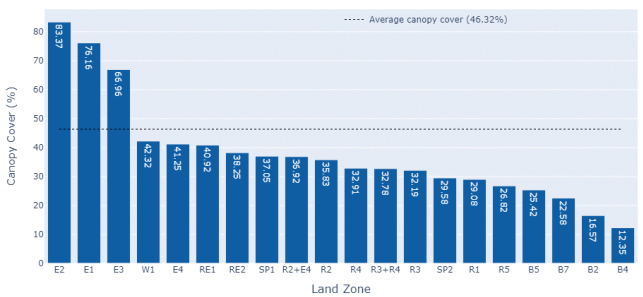
Figure 1: Canopy cover of each land zone in Ku-ring-gai Council
by percentage of total land zone area (image from Urban Forest Monitoring
Report 2020).
Also important to note is that the above graph is the entire
picture because controls on development related to canopy take time to be
realised. For example, where a development in a particular zone clear fells the
site for construction but was required to include deep soil plantings, these
plantings and the resultant canopy will not be evident for several years post
construction.
Currently if a DA is received for a new dwelling house on a
900m2 lot that has no existing canopy, the landscaping provisions state that at
least 5 canopy trees need to be established, which will result in an increase
in canopy on the site. However, if the development can be completed under the
CODES SEPP, Council’s landscaping provisions are not applicable.
If a DA is received for a new dwelling house on a 900m2 lot
that has existing canopy, comprised of 10 trees of varying size, and 3 are
required to be removed to facilitate the development, the landscaping
provisions are met (in fact exceeded) by the remaining 7 trees on site.
Therefore, there may not be a requirement to establish any more canopy on the
site. Whether this results in a loss of canopy area will depend on the size and
location of the 3 trees removed.
In addition to the analysis by zone, a number of case
studies looking at the impact of development types on the canopy were completed
as part of the UFS. These are included as Attachment A2 to this
report.
Overall, increases in housing density and provision of
secondary dwellings to meet housing reform objectives leads to an increase of
developed area and a reduction in deep soil areas that can safely maintain
trees that provide for a large canopy.
Further analysis of particular development types and how
they impact on canopy will continue to be conducted through the UFS monitoring
project and the ‘Urban
Forest Canopy Loss Analysis in Ku-ring-gai Local Government Area’
project.
Adopting a policy of
'achieving a net gain' of canopy area and under-storey vegetation during
material changes to Council-owned land
All of Council’s new works and development activities
are carried out according to council’s internal Environmental Impact
Assessment guidelines for council activities. Ku-ring-gai Council has a
standardised and transparent framework for offsetting residual biodiversity
impacts on trees, native vegetation or habitat on Council owned or care control
and managed lands, conducted under Division 5.1 or exempt development
activities within the EP&A Act. Ku-ring-gai’s offsetting principles are:
Principle 1: Avoid, minimise, and
mitigate
Principle 2: Improve or maintain
overall biodiversity or canopy cover
Principle 3: Like-for-like
Principle 4: Supplement existing
protection and management
Principle 5:
Enforceability
Principle 6: The precautionary principle
Principle 7: Long term viability
Where works cannot avoid impact to trees or vegetation,
council currently applies the following offset ratios:
|
Criteria
|
Offset
ratio
|
|
Dead or non-protected (those
exempt species, etc) trees
|
1:1
|
|
Removal of non-native or
non-local trees
|
2:1
|
|
Removal of non-native or
non-local trees – Large / significant trees [due to the presence of
habitat (e.g. a hollow), provision of food for wildlife, and / or exceptional
form or size].
|
3:1
|
|
Removal of scattered native /
remnant trees (native mid and understorey absent or reduced to scattered
clumps and individual plants )
|
3:1
|
|
Removal of scattered native /
remnant trees (native mid and understorey absent or reduced to scattered
clumps and individual plants) - Scattered trees include large remnant natives
with a higher habitat value or resilience of area is determined to be
moderate / high.
|
4:1
|
|
Removal within mostly intact
overstorey vegetation, considerable weed infestation amongst the understorey
|
5:1
|
|
Removal within mostly intact
overstorey vegetation, moderate weed infestation amongst the understorey.
|
6:1
|
|
Removal within mostly intact
overstorey, mid and / or understorey vegetation (the original vegetation is
still dominant).
Weed infestation is low to
moderate and / or no evidence of regeneration.
|
8:1
|
|
Removal within intact
vegetation - canopy,
midstorey and understorey in good condition (the original vegetation is still dominant).
Weed infestation is low and
evidence of regeneration.
|
10:1
|
Adopting a formal offsetting policy that applies to all
types of development (not just Council) will help to ensure that there is not
net loss of canopy into the future.
A policy aiming for 'achieving a net gain' of canopy area
and under-storey vegetation will be hard to achieve in many circumstances,
given the many constraints that exist within the urban landscape. However there
is definitely scope for council works to continue to apply the “Improve
or maintain overall biodiversity or canopy cover”
principle/objective and have it incorporated into a Council adopted offset
policy.
Council will continue to identify opportunities to increase
biodiversity through programs such as verge gardens, woody meadows, tiny
forests and street tree replenishment in an effort to increase canopy cover
across the LGA.
A system with
supporting marketing to promote and supply resident planting of locally
indigenous trees and vegetation across all storeys, from an ecosystem to suit
their site-specific soils and initially targeting green corridors
Council recognises the important role that residents and
private property play in the retention and enhancement of the LGAs canopy.
Programs which support residents in planting private property are a key
component of our environment and education program and are supported through
the community nursery and greenstyle programs.
After consideration of the NoM and internal consultation
around our existing program and opportunities for improvement, a trilateral
approach is being proposed:
1. Improved
information on Council’s website.
A dedicated webpage could be
published to promote the protection and enhancement of indigenous vegetation on
residential land. This would provide information to assist residents in
selecting suitable species for planting alongside general advice regarding
garden and bushland maintenance and habitat enhancement. Production and
promotion of such a webpage is feasible in the short term with existing
resources.
2. Land
stewardship consultations.
Council’s existing
Greenstyle Gardens program is delivered through the Environment &
Sustainability business unit and currently offers a limited number of garden
consultations each year, providing tailored, site-specific advice to support
residents in improving biodiversity and sustainability outcomes on their land.
This program could be adapted and expanded to encourage further indigenous
plantings on residential land in targeted areas.
Consultations could be
prioritised for properties identified on the LEP ‘Terrestrial
Biodiversity’ mapping. Introducing this allocation system will ensure the
delivery of resource-intensive tailored advice is focussed in areas of
environmental sensitivity and areas where stewardship of land has higher
potential environmental benefits.
The primary factor limiting the
feasibility of this strategy is budget allocations for staffing consultations.
Current budget allocations allow for up to 35 consultations annually. This
could be scaled with additional funding. An annual budget increase of $10,000
would enable delivery of approximately 100 land stewardship consultations per
year.
Factors such as bushfire safety
concerns and the potential for plantings to restrict future permissible uses of
the land may reduce residents’ willingness to increase vegetation cover.
This can be addressed through the provision of full and reliable information
including about lower-risk species for planting.
A range of constraints inherent
to certain land parcels such as development controls, limited availability of
space for planting, and altered soil profiles may influence and limit species
selections for planting. Such factors are identified during direct consultation
and strategies to increase vegetation cover and/or improve biodiversity values
within site constraints are suggested.
An important factor potentially
limiting the planting of indigenous vegetation on residential land is the
availability of such plants. This is discussed further in the following
section.
3. Increased
nursery production.
Council’s nursery at 430
Mona Vale Rd produces plants for use in revegetation projects and threatened
species conservation projects, as well as for sale at the Ku-ring-gai
Wildflower Gardens retail nursery. A small quantity (approximately 1500 per year)
are provided to residents at citizenship ceremonies, community events, and to
Greenstyle Garden clients.
All plants produced by the
nursery for revegetation projects or given away, are indigenous species of
local provenance, and most of these species are not readily available
commercially. The nursery therefore has an important role in securing
Ku-ring-gai’s biodiversity.
With increased nursery production
more plants could be made available to residents either for free or at a
subsidised price, incentivising residents to plant indigenous species. The
supply of plants to land stewardship consultation clients could also provide an
incentive for residents to engage with that program.
Nursery production is currently
at capacity and is constrained by limited facilities and staffing resources. An
increase in nursery production would require additional fenced and irrigated
hardstand areas at the site, which is not currently funded.
Existing staffing resources
include approximately 21 hours per week from qualified nursery officers and
approximately 18 hours per week from environmental programs volunteers. An
increase in nursery production would require additional staffing resources, a
significant portion of which could be volunteer labour. Additional paid staff
hours are not currently funded.
integrated
planning and reporting
PLACES, SPACES AND INFRASTRUCTURE
|
Community Strategic Plan Long Term Objective
|
Delivery Program
Term Achievement
|
Operational Plan
Task
|
|
P2.1: A robust planning framework is in place to deliver
quality design outcomes and maintain the identity and character of
Ku-ring-gai.
P1.1: Ku-ring-gai’s unique visual character and
identity is maintained
|
P1.1.1: Strategies, plans and processes are in place to
protect and enhance Ku-ring-gai’s unique visual and landscape character
|
P1.1.1.4: Implement the urban forest replenishment program
for Ku-ring-gai including identification of funding opportunities.
P1.1.1.6: Implement priority monitoring from the Urban
Forest Strategy.
P1.1.1.7: Oversee and monitor the implementation of the
Urban Forest Strategy
|
|
N1: Appreciating Ku-ring-gai’s unique natural
environment Long-Term Objective N1.1: A community empowered with knowledge,
learning and information that drives participation in activities that benefit
the environment.
|
N1.1.1: The community has an enhanced appreciation of the
value of the natural environment, local environmental issues and impacts
|
N1.1.1.1: Utilise a variety of communication mechanisms
and channels for different target groups to deliver environmental
information.
|
Governance
Matters
The Ku-ring-gai Development
Control Plan (KDCP) serves as a supplementary planning document to the
Ku-ring-gai Local Environmental Plan (KLEP). It holds a “guideline”
status and its primary role is to provide detailed planning and design guidance
for development within the local government area.
Feasibility of amendments to the
KDCP will be identified through rigorous analysis and any amendments to the DCP
will have to be consulted internally, and then proposed to Council for
adoption.
Risk Management
Risk associated with planning
controls and will be managed through internal consultation to ensure
effectiveness and consistency.
Financial Considerations
Whilst there are no direct financial considerations
associated with this report, many of the programs and objectives referred to,
particularly in regard to part C and the ‘system with supporting
marketing to promote and supply resident planting of locally indigenous trees
and vegetation across all storeys, from an ecosystem to suit their site-specific
soils and initially targeting green corridors’ are supported through the
environmental levy.
Social Considerations
Any program or DCP amendments
related to this report will be consulted as required.
Environmental Considerations
Environmental considerations
are central to the UFS and associated strategies.
Community Consultation
Any program or DCP amendments
related to this report will be consulted as required.
Internal Consultation
This report was discussed
internally with relevant section of Council including Environment and
Sustainability, Urban Planning, Landscape and Ecological Assessment and Tree
Management.
Summary
At the OMC of 19 March 2024, Council considered a NM.5 on
‘No net loss of tree canopy’. The motion resolved that council
report back by May 2024 on the feasibility of 3 proposals.
A. Amending
the KDCP to achieve no net loss of canopy area at maturity
and seek to achieve a net gain,
including some quantification of the historical change in canopy area pre and post development (at
maturity) for different types of development.
B. Adopting a policy of 'achieving a net
gain' of canopy area and under-storey vegetation during material changes to
Council-owned land
C. A system with supporting marketing to
promote and supply resident planting of locally indigenous trees and vegetation
across all storeys, from an ecosystem to suit their site-specific soils and
initially targeting green corridors.
Council has broadly considered the feasibility of the 3
elements referred to in NM.5 of the OMC from 19 March and reported these back
to Council in this report with each component of
the motion considered.
In relation to Part A, an
example of an amendment to 13.4 has been demonstrated with its limitations and
feasibility discussed. Some quantification of the historical change in
canopy area pre and post development has been included in the report and
additional examples are included as Attachment A2.
In relation to Part B, the
report has outlined council’s existing Environmental Impact
Assessment guidelines and referred to the underlying offsetting principles,
which are:
Principle 1: Avoid, minimise, and
mitigate.
Principle 2: Improve or maintain
overall biodiversity or canopy cover.
Principle 3: Like-for-like
Principle 4: Supplement existing
protection and management
Principle 5:
Enforceability
Principle 6: The precautionary
principle
Principle 7: Long term viability
The
feasibility of a broader Offset Policy is discussed and will continue to be
discussed internally.
Council
have recently commissioned a report on ‘Urban Forest Canopy Loss Analysis
in Ku-ring-gai Local Government Area’ which will further consider each of
the components highlighted in this report. The objective of the ‘Urban
Forest Canopy Loss Analysis in Ku-ring-gai Local Government Area’ is to
provide an in-depth analysis of the mechanisms driving canopy loss on private
land in the Ku-ring-gai Local Government Area. The project will examine the
circumstances around tree removal, identify weak points in current practices,
benchmark against similar LGAs, and propose strategies and actions to prevent
canopy loss.
In relation to Part C, this
report has detailed some of the relevant programs delivered through the
environment and sustainability section of council and identified areas for
improvement and expansion. These will be considered through the budget cycle
for additional resourcing where required.
Recommendation:
A. That
Council receive and note this report.
B. That
possible future amendments to the Ku-ring-gai DCP be investigated as part of
the Urban Forest Canopy Loss Analysis in Ku-ring-gai Local Government Area project.
|
Jacob Sife
Manager Environment & Sustainability
|
Sophia Findlay
Natural Areas Team Leader
|
|
Sybylla Brown
Natural Areas Program Leader
|
Rathna Rana
Senior Urban Planner
|
|
Craige Wyse
Team Leader Urban Planning
|
Antony Fabbro
Manager Urban & Heritage Planning
|
|
Andrew Watson
Director Strategy & Environment
|
|
|
Attachments:
|
A1 ⇩ ⇩
|
NM.5
OMC 1 March 2024 - Motion to protect and enhance the tree canopy in
Ku-ring-gai
|
|
2024/107418
|
|
|
A2 ⇩ ⇩
|
UFS
Case Studies on particular development types
|
|
2024/159798
|
|
ATTACHMENT No: 1 - NM.5 OMC 1
March 2024 - Motion to protect and enhance the tree canopy in Ku-ring-gai
|
|
Item No: GB.9
|
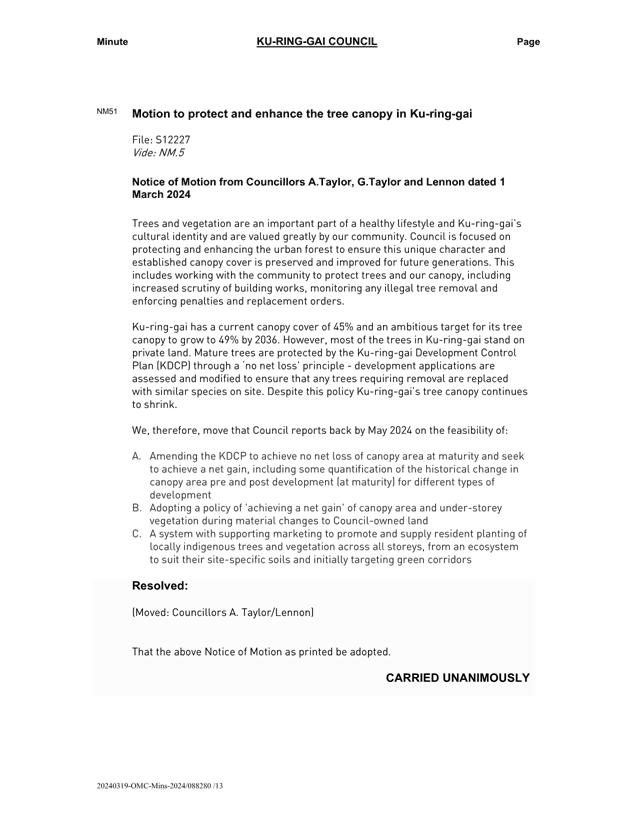
|
ATTACHMENT No: 2 - UFS Case
Studies on particular development types
|
|
Item No: GB.9
|


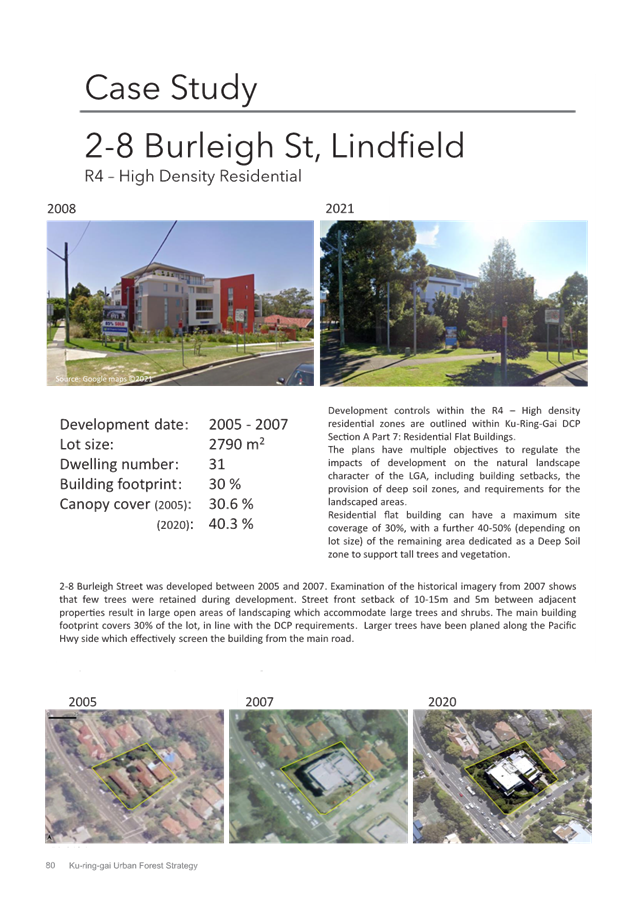
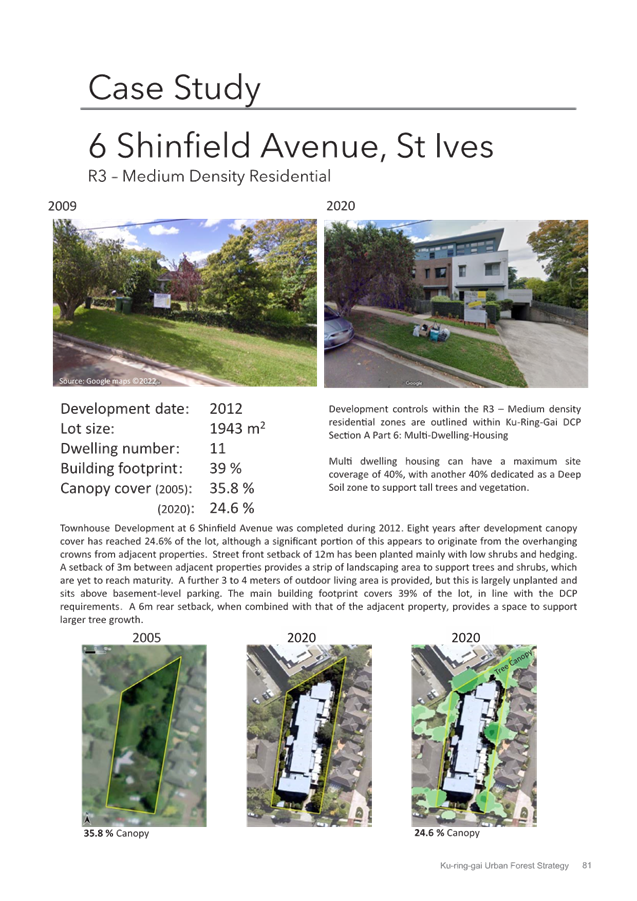
|
Ordinary
Meeting of Council - 21 May 2024
|
GB.10 / 1
|
|
|
|
|
Item
GB.10
|
S14395
|
Planning Proposal 17a Edward Street,
Gordon - Consideration of Submissions
EXECUTIVE
SUMMARY
|
purpose of report:
|
For Council to consider the
submissions received during the public exhibition of the Planning Proposal to
heritage list 17a Edward Street, Gordon.
|
|
|
|
|
background:
|
On 21 March 2023 Council resolved to request an
Interim Heritage Order to be made by the Minister for Heritage. On 28 April
2024 the Interim Heritage Order was made to enable Council to investigate the
property’s heritage significance.
Council commissioned HeriCon Consultants to undertake
a heritage assessment for the property. Their assessment determines that the
property has sufficient heritage significance to warrant listing as a local
heritage item.
At OMC 21 November 2023 Council resolved to prepare a
Planning Proposal to heritage list 17a Edward Street, Gordon.
A Gateway Determination was issued by the Department
of Planning, Housing and Infrastructure on 8 March 2024 which enabled the
Planning Proposal to be publicly exhibited.
|
|
|
|
|
comments:
|
The Planning Proposal was publicly exhibited from
Friday, 22 March – Friday, 12 April 2024.
3 submissions were received from the community in
response to the public exhibition.
|
|
|
|
|
recommendation:
(Refer to the full Recommendation at the end of this
report)
|
That Council resolves to make
the plan under Section 3.36 of the Environmental Planning and Assessment
Act 1979.
|
Purpose of Report
For Council to consider the submissions received during the
public exhibition of the Planning Proposal to heritage list 17a Edward Street,
Gordon.
Background
Denholm
(‘the site’) is located at 17A Edward Street, Gordon (Lot 2 DP 504958). The
site is a battle-axe lot located roughly 450m east of Gordon Station and
contains a Dutch Colonial Revival style two storey dwelling. The site is within
the Robert Grant Heritage Conservation Area (C13) and is not currently heritage
listed as a Heritage Item.
|
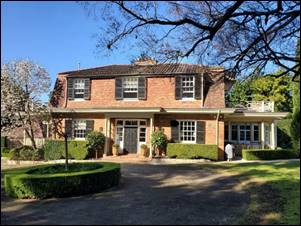
Figure 1: Denholm, 17A Edward Street, Gordon
(‘The site’) Source: HeriCon Consulting,
Denholm, 17A Edward Street, Gordon Assessment of Heritage Significance,
September 2023
|
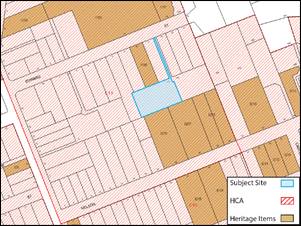
Figure 2: 17A Edward Street, Gordon located within
the Robert Grant Heritage Conservation Area (C13)
|
A development application was lodged
for the site on 24 November 2022 which sought extensive alterations and
additions to the property. Council officers inspected the site on 18 January
2023. Council heritage officers conducted a preliminary heritage assessment
of the property to investigate its potential heritage significance.
On 16 February 2023,
Council’s Heritage Reference Committee (HRC) resolved that the HRC advise
Council to request the NSW Minister for Heritage to place an Interim Heritage
Order (IHO) on the site.
On 21 March 2023, Council resolved
to request the Minister for Heritage to place an IHO on the site under section
24 of the Heritage Act 1977. On 28 April 2023, the IHO was published
in the NSW Government Gazette (Attachment A1). The order is in effect
for 12 months to enable Council to investigate the property’s heritage
significance and listing.
Council commissioned HeriCon Consultants to undertake a
heritage assessment for the property. Their assessment (Attachment A2)
determines that the property has sufficient heritage significance to warrant
listing as a local heritage item.
At OMC 21 November 2023 Council resolved to prepare a
Planning Proposal to heritage list 17a Edward Street, Gordon. The Council
report and resolution from November 2023 OMC is included at Attachment A3 and
the Planning Proposal is included at Attachment A4.
A Gateway Determination (Attachment
A5) was issued by the Department of Planning, Housing and Infrastructure on
8 March 2024 which enabled the Planning Proposal to be publicly exhibited.
Comments
The Planning Proposal was placed on public exhibition in
accordance with the requirements of the Gateway Determination and the
Ku-ring-gai Community Participation Plan between 22 March 2024 – 12 April
2024.
A total of three (3) submissions were received from the
community during the public exhibition. A Submission Summary table is included
at Attachment A6.
All three (3) submissions received were not in support of
the Planning Proposal, and raised matters such as:
· House is not
visible from street;
· existing
development within street and potential future development under State
Government planning reforms;
· unfair process;
· devaluing
property; and
· not good example
of architecture.
The independent heritage assessment by Hericon Consulting
was undertaken in line with NSW Heritage Council standards, including
assessment of the documentary, physical and comparative evidence. The
assessment concludes that the property meets the NSW Heritage Council criteria
for local heritage listing as an important Colonial Revival style house in
Ku-ring-gai, which is rare. The assessed significance does not rely on the
streetscape presentation or surrounding development.
Council has an obligation to identify places of heritage
significance. The owners and public have been notified and consulted with due
process as set out the Heritage Act 1977 and the Environmental
Planning and Assessment Act 1979.
integrated planning and reporting
Theme 3: Places, Spaces and Infrastructure
|
Community Strategic
Plan Long Term Objective
|
Delivery Program
Term Achievement
|
Operational Plan
Task
|
|
P5.1 Ku-ring-gai’s heritage is protected, promoted
and responsibly managed
|
P5.1.1 Strategies, plans and processes are in place to
effectively protect and preserve Ku-ring-gai’s heritage assets
|
P5.1.1.1 Implement, monitor and review Ku-ring-gai’s
heritage planning controls including the development of a heritage strategy
|
Governance Matters
The preparation and
implementation of Planning Proposals is governed by the provisions within the Environmental
Planning and Assessment Act 1979 and Environmental Planning and
Assessment Regulation 2000.
Under the Ministerial Direction Local Planning Panels
Direction – Planning Proposals and the delegations granted to the General
Manager, this matter was not required to be referred to Ku-ring-gai Local
Planning Panel on the basis the proposal will not have any significant adverse
impact on the environment or adjoining land.
The Gateway Determination
issued by the Department of Planning, Housing and Infrastructure on
8 March 2024, considered the nature of the Planning Proposal and
conditioned the Gateway Determination for Council to be authorised as the Planning
Proposal Authority. Council can resolve to make the plan in accordance with
section 3.36(2) of the EP&A Act and liaise with Parliamentary
Counsel’s Office (PCO) to draft the required Local Environmental Plan to
give effect to the Planning Proposal, as well as the Ministers function in
making the plan.
Risk Management
There is a community
expectation that places of heritage significance within the Ku-ring-gai local
government area will be identified and protected. There is a strategic risk to
Council and its reputation if these culturally significant places are not
identified and considered for protection.
Financial Considerations
The cost of preparing this
report is covered by the Urban Planning & Heritage Budget – Strategy
and Environment Department.
Social Considerations
The identification and
protection of Ku-ring-gai’s heritage places contributes to the ongoing
conservation of Ku-ring-gai’s historic landscape and the garden suburbs
that are valued by the community.
Environmental Considerations
Council is responsible for
the identification and management of Ku-ring-gai’s local environmental
heritage. Consideration of this matter will assist Council in meeting this
requirement. The retention and conservation of heritage places has an important
role in protecting the environment. The environmental sustainability benefits
afforded by the retention of heritage places include the substantial reduction
in building, demolition and new construction waste, and the conservation of embodied
energy in the existing buildings.
Community Consultation
The Planning Proposal was
placed on public exhibition from 22 March 2024 – 12 April 2024 in
accordance with the requirements of the Gateway determination and
Ku-ring-gai’s Community Participation Plan.
The affected property owners
and 52 adjoining property owners were notified of the public exhibition in
writing and had the opportunity to provide feedback during the formal
exhibition period.
The Planning Proposal and
supporting information was made available on Council’s website and was
available to be viewed at the customer service desk in accordance with
Ku-ring-gai’s Community Participation Plan.
As a result of the public
exhibition, a total of three (3) submissions were received from the community.
All persons who made a
submission were notified of this matter being reported back to Council.
Internal Consultation
Consultation with the
relevant internal sections of Council has been undertaken where required for
this report, in particular, Development and Regulation. Council’s
Heritage Reference Committee supported the Interim Heritage Order in February
2023.
Summary
On 21 November 2023 Council
resolved to prepare a Planning Proposal to heritage list 17a Edward Street,
Gordon as a local heritage item in Schedule 5 of the Ku-ring-gai Local
Environmental Plan 2015.
A Gateway Determination was
issued by the Department of Planning, Housing and Infrastructure on 8 March
2024. The Planning Proposal was placed on public exhibition from 22 March
– 12 April 2024 in accordance with the requirements of the Gateway
Determination and Ku-ring-gai Community Participation Plan.
Three (3) submissions were
received from the community.
It is recommended that
Council proceeds with the Planning Proposal to heritage list 17a Edward Street,
Gordon.
Recommendation:
A. That
Council adopt the Planning Proposal to include 17a Edward Street, Gordon as
local heritage items in Schedule 5 of Ku-ring-gai Local Environmental Plan2015.
B. That
Council proceed to make the plan, using its delegated authority under section
3.36(2) of the Environmental Planning and Assessment Act 1979.
C. That
those who made submissions be notified of Council’s decision.
|
Alexandra Plumb
Urban Planner
|
Claudine Loffi
Heritage Specialist Planner
|
|
Craige Wyse
Team Leader Urban Planning
|
Antony Fabbro
Manager Urban & Heritage Planning
|
|
Andrew Watson
Director Strategy & Environment
|
|
|
Attachments:
|
A1 ⇩ ⇩
|
IHO
Documents - 17a Edward Street, Gordon
|
|
2023/380368
|
|
|
A2 ⇩ ⇩
|
Heritage
Assessment - 17A Edward Street Gordon - HeriCon Consulting - final -
September 2023
|
|
2023/304441
|
|
|
A3 ⇩ ⇩
|
OMC
Report and Resolution 21 November 2023 - 17a Edward Street, Gordon
|
|
2023/380359
|
|
|
A4 ⇩ ⇩
|
Exhibition
Version - Planning Proposal to Heritage List Denholm, 17A Edward Street,
Gordon
|
|
2024/084108
|
|
|
A5 ⇩ ⇩
|
Gateway
determination - PP-2023-2739 - 17a Edward Street, Gordon
|
|
2024/078891
|
|
|
A6 ⇩ ⇩
|
SUBMISSION
SUMMARY TABLE - For Council Report - Consideration of Submissions - 17a
Edward Street, Gordon
|
|
2024/131694
|
|
ATTACHMENT No: 1 - IHO Documents
- 17a Edward Street, Gordon
|
|
Item No: GB.10
|
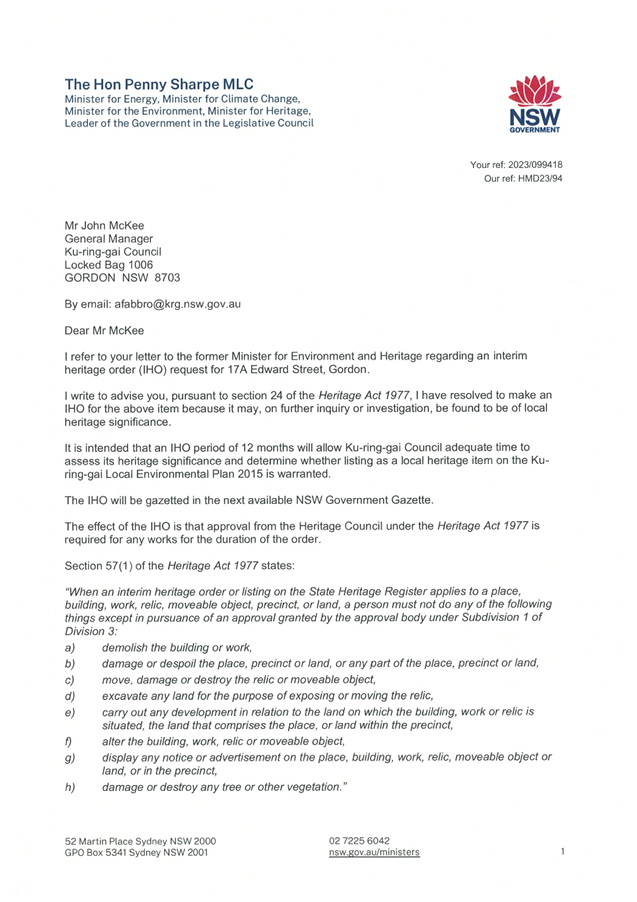
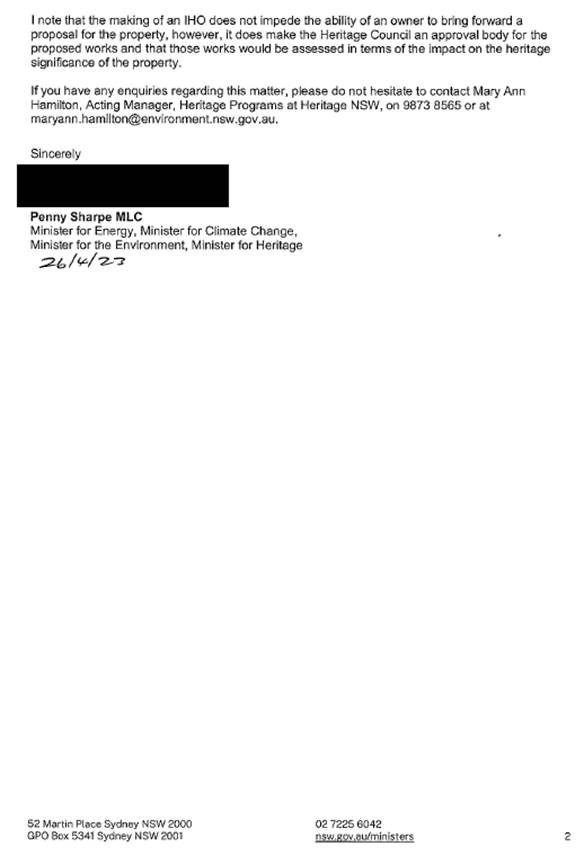
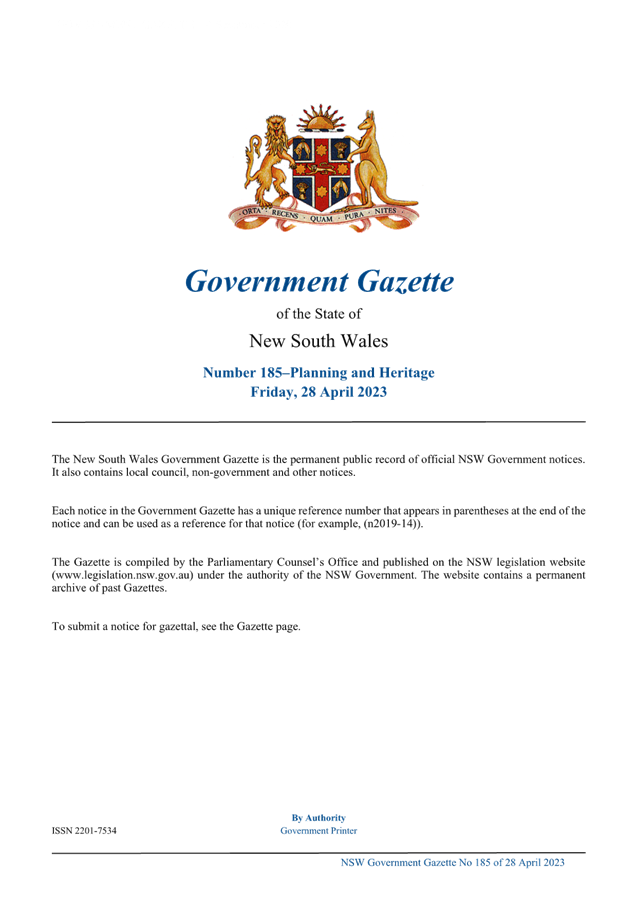
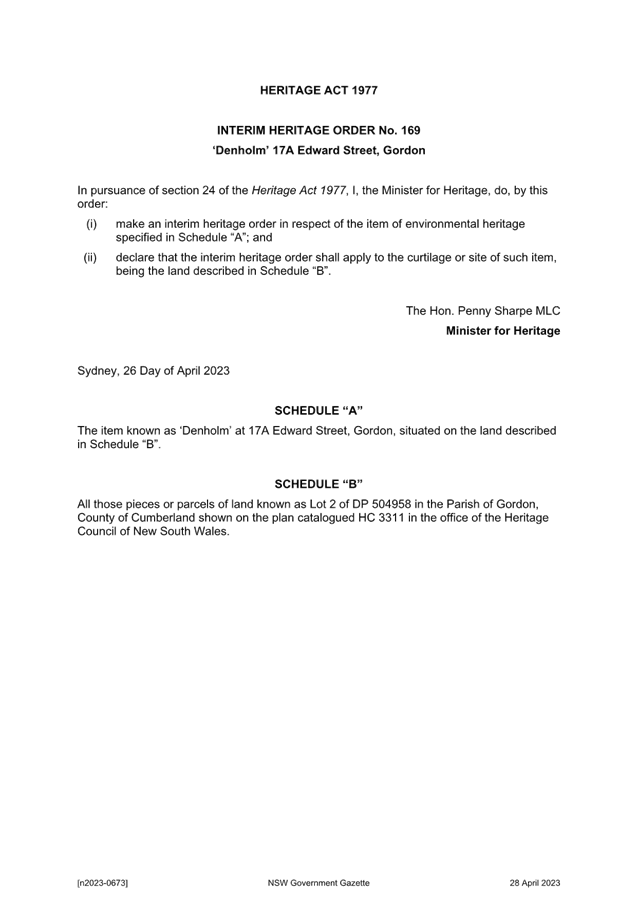
|
ATTACHMENT
No: 2 - Heritage
Assessment - 17A Edward Street Gordon - HeriCon Consulting - final - September
2023
|
|
Item No: GB.10
|

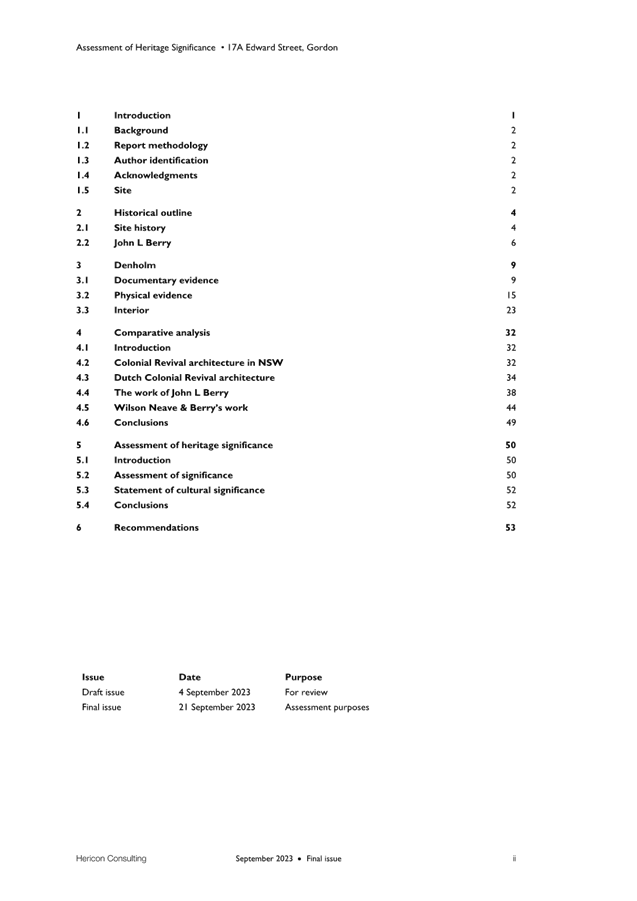
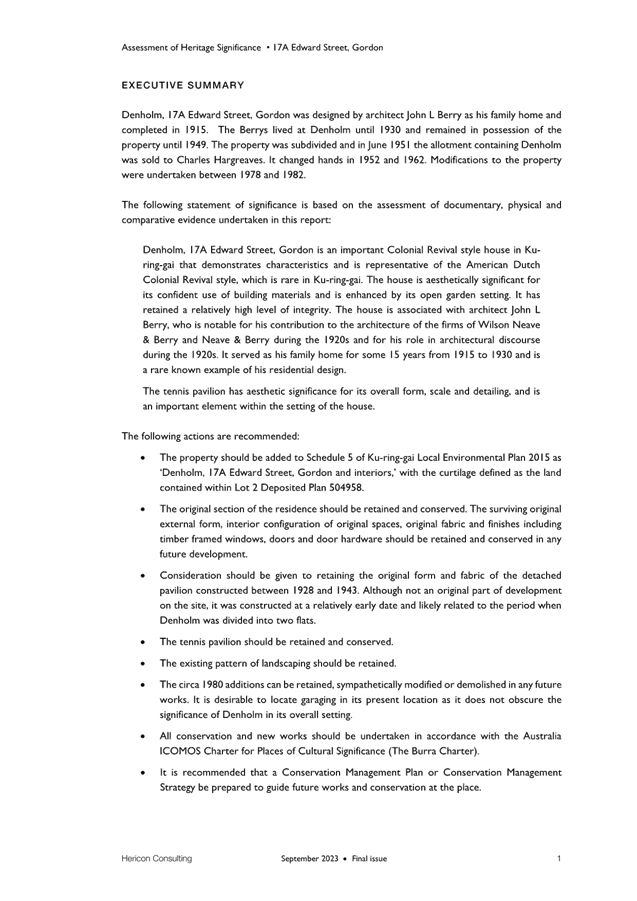
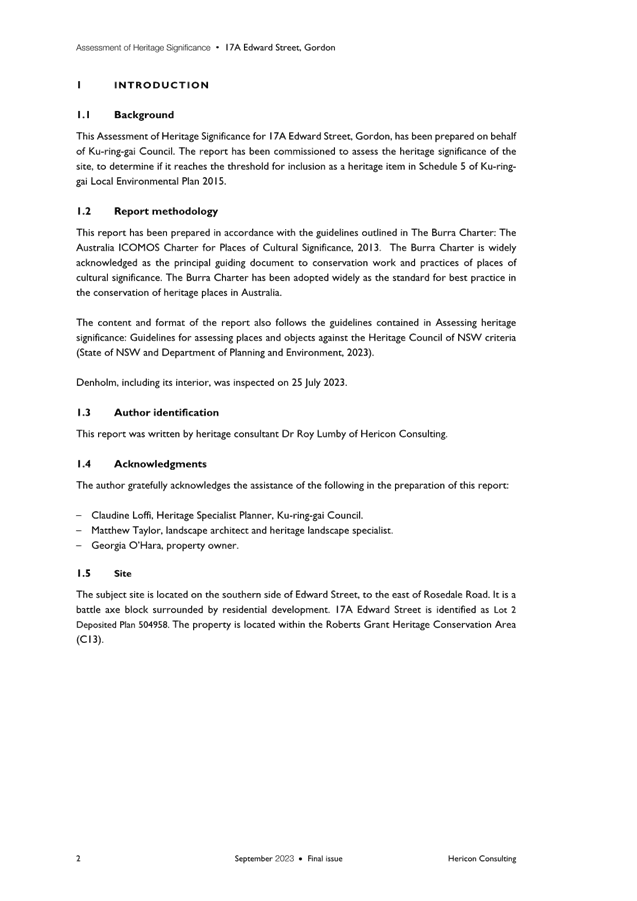
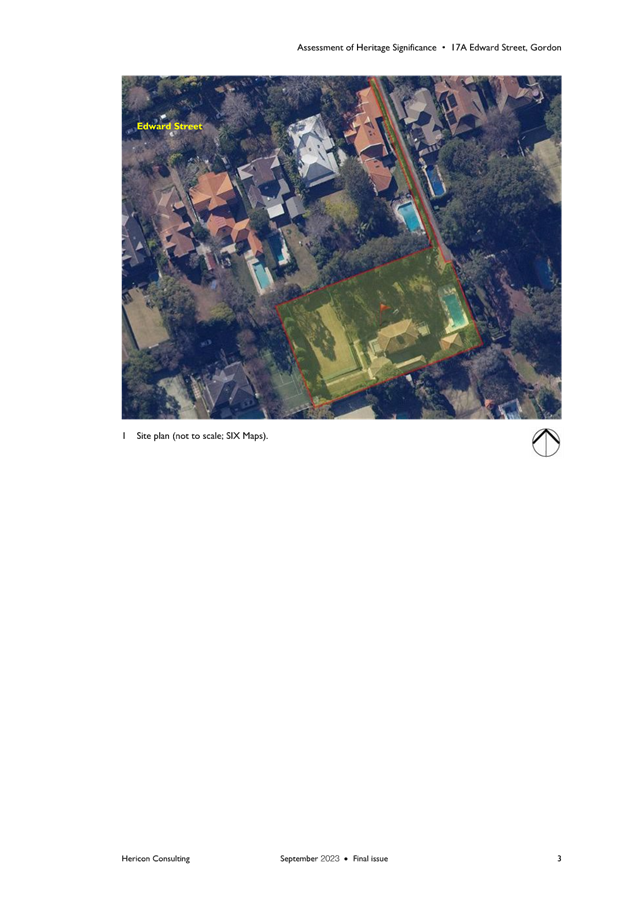
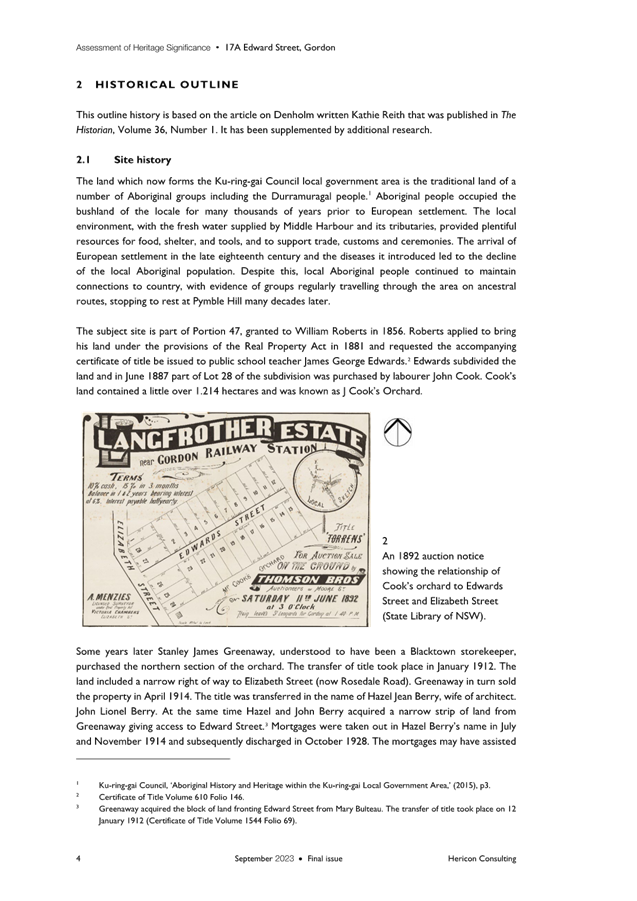
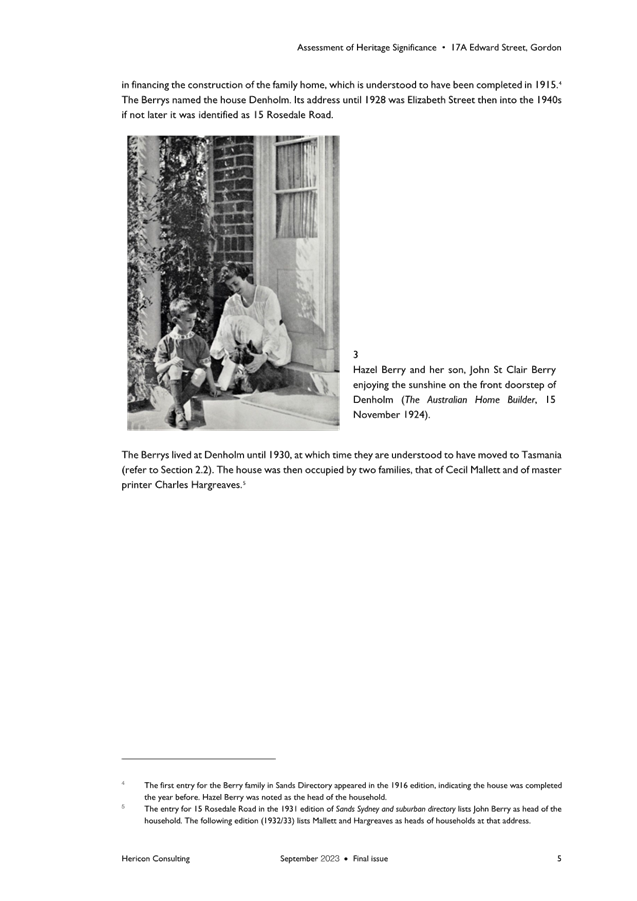
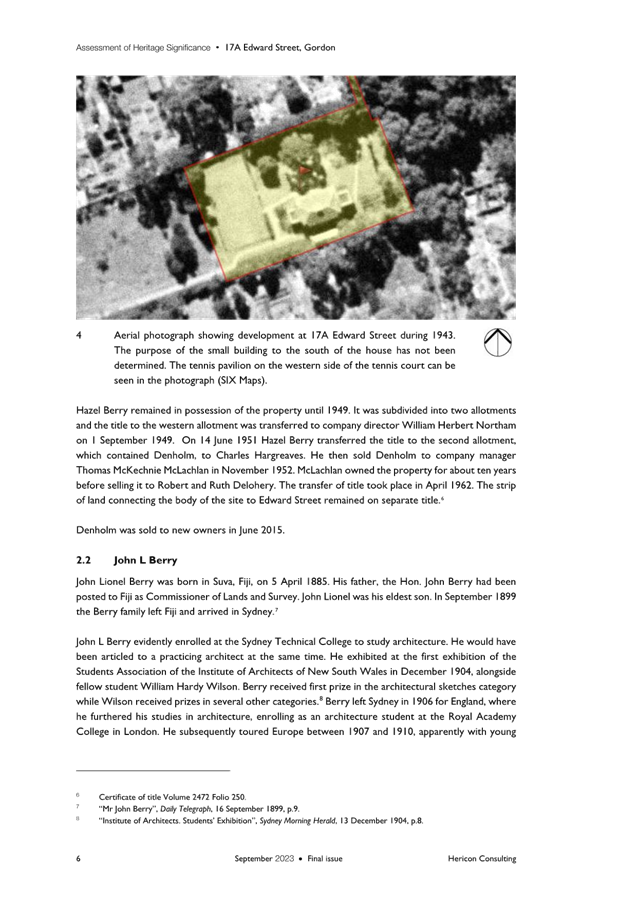
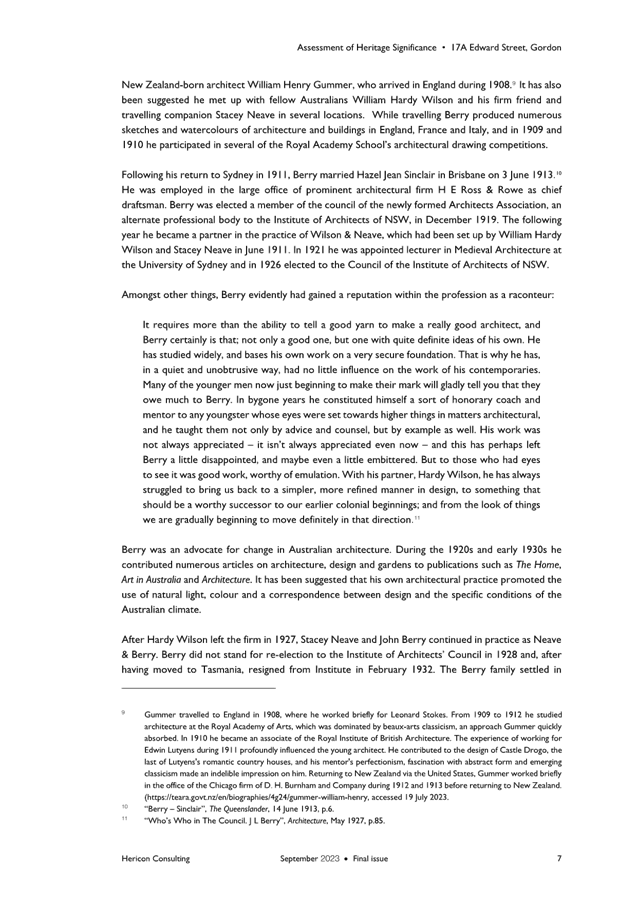
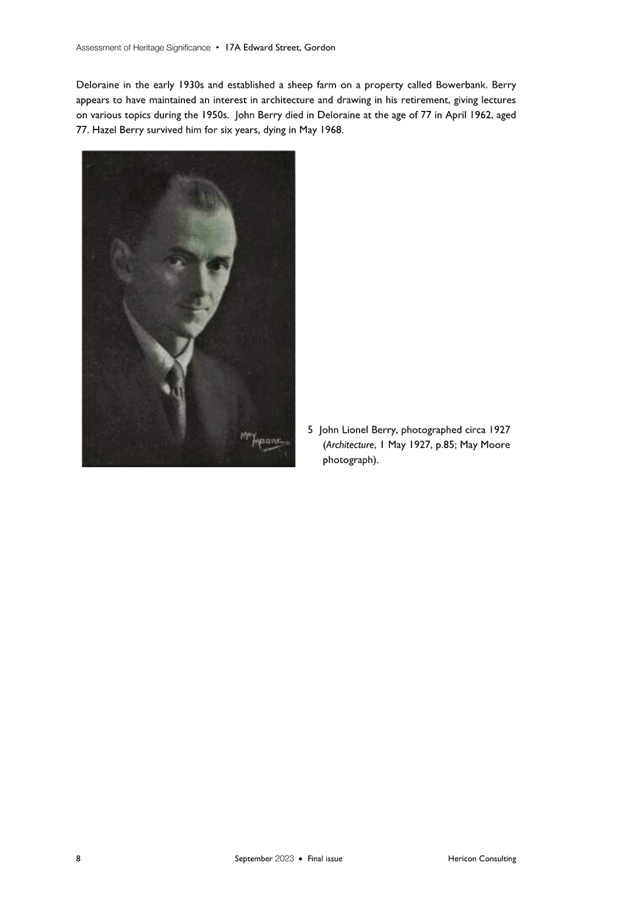
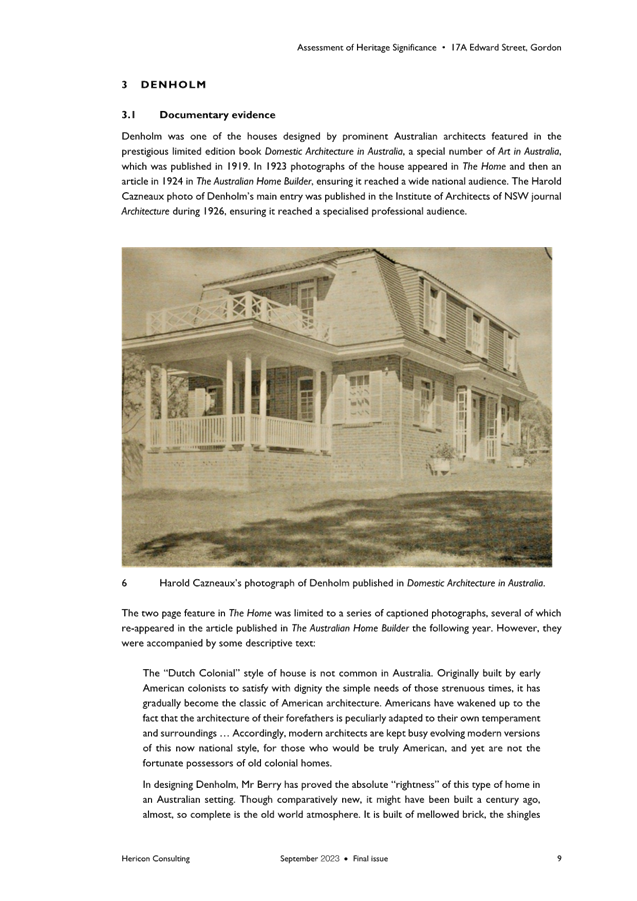
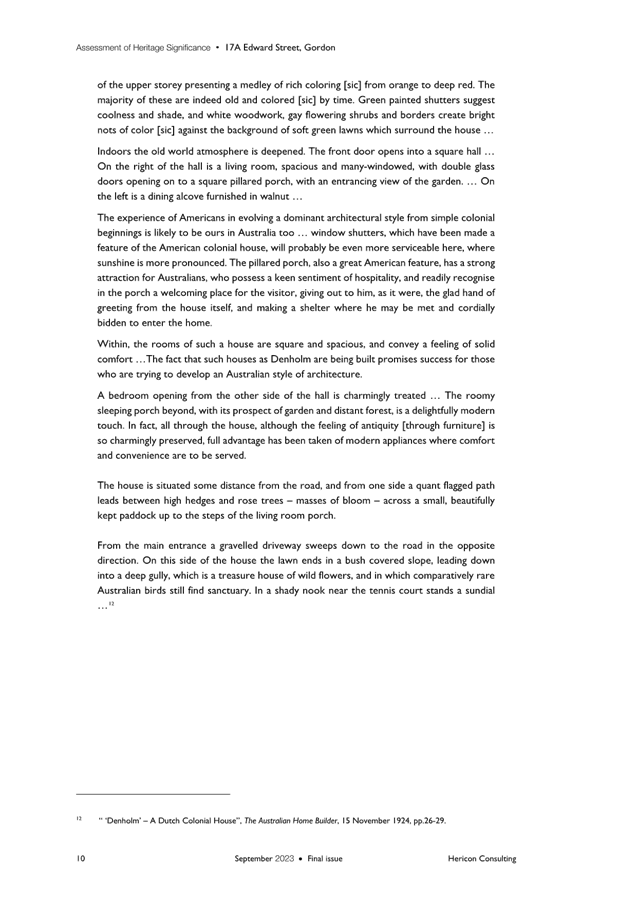
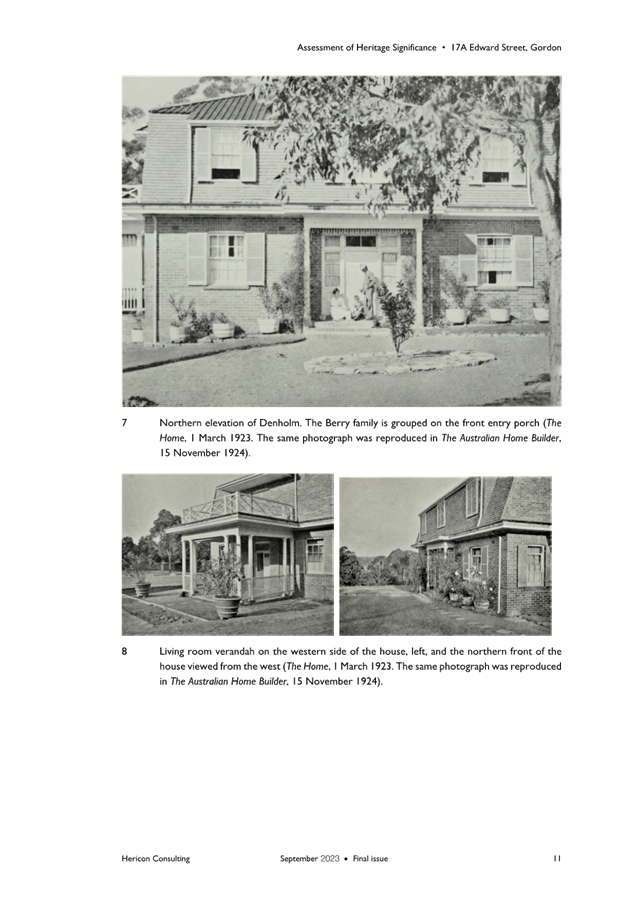
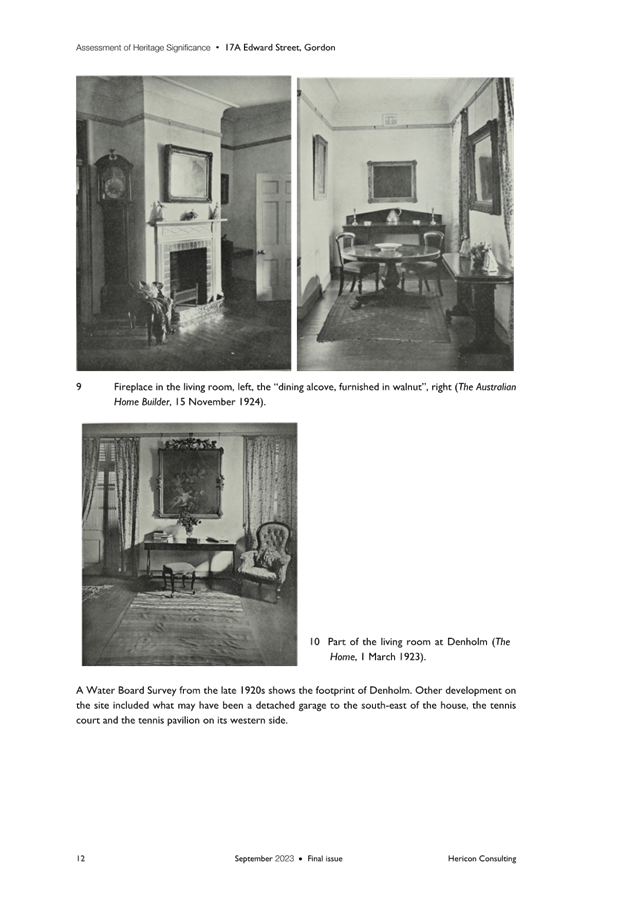
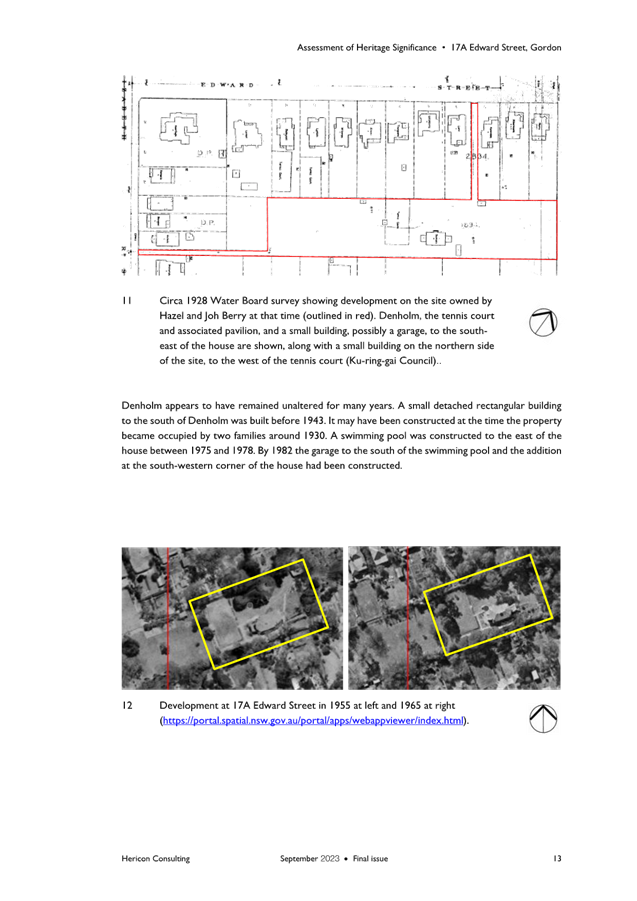
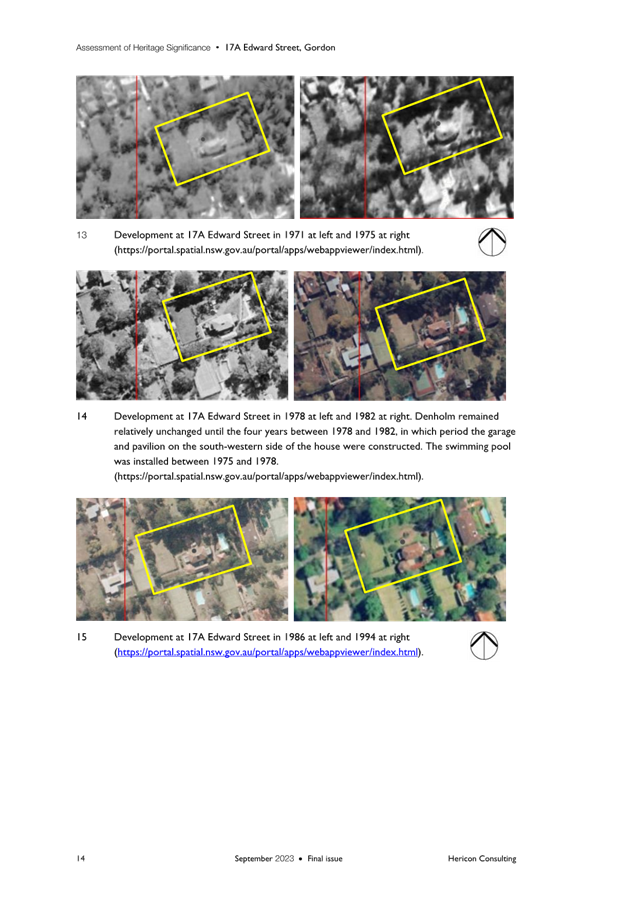
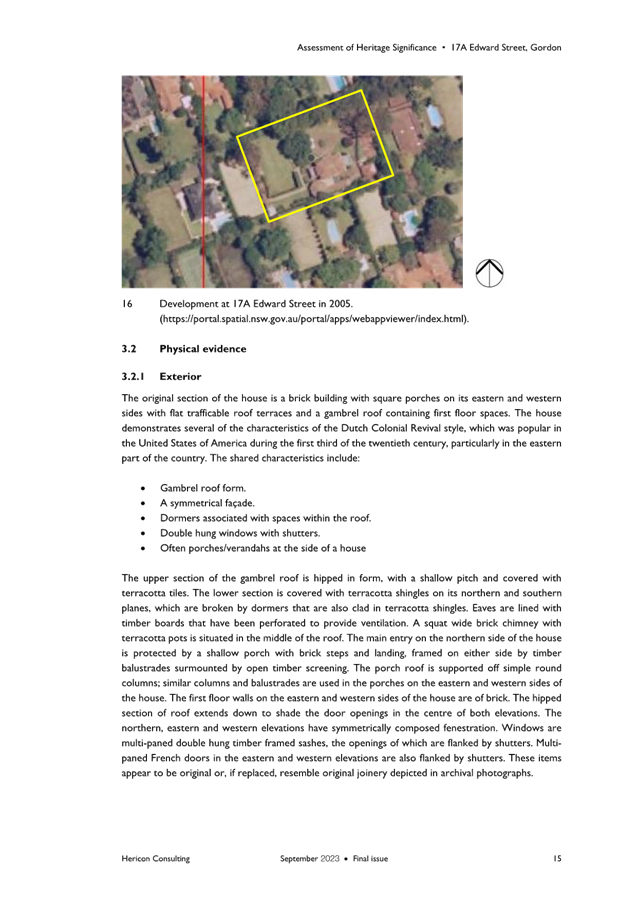
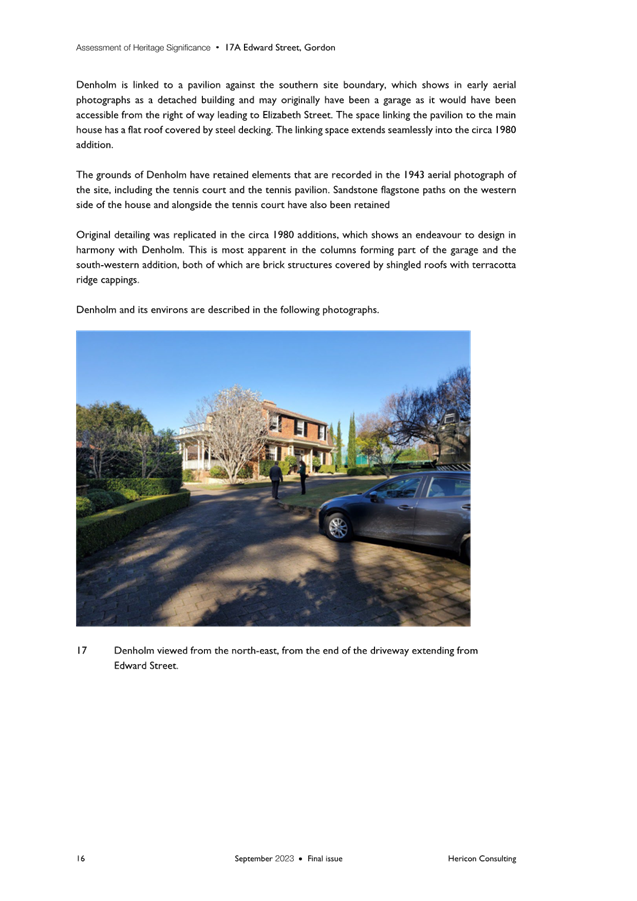
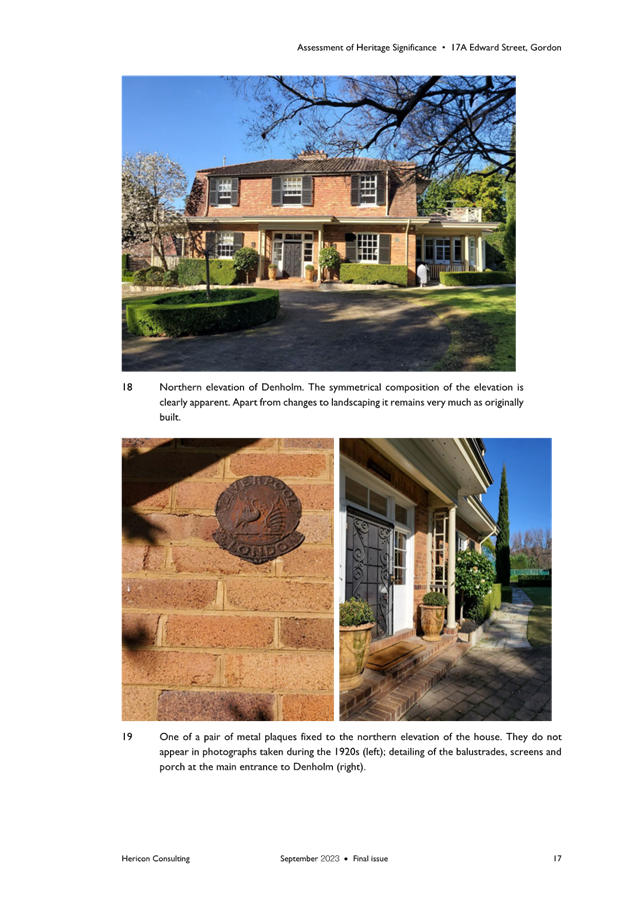
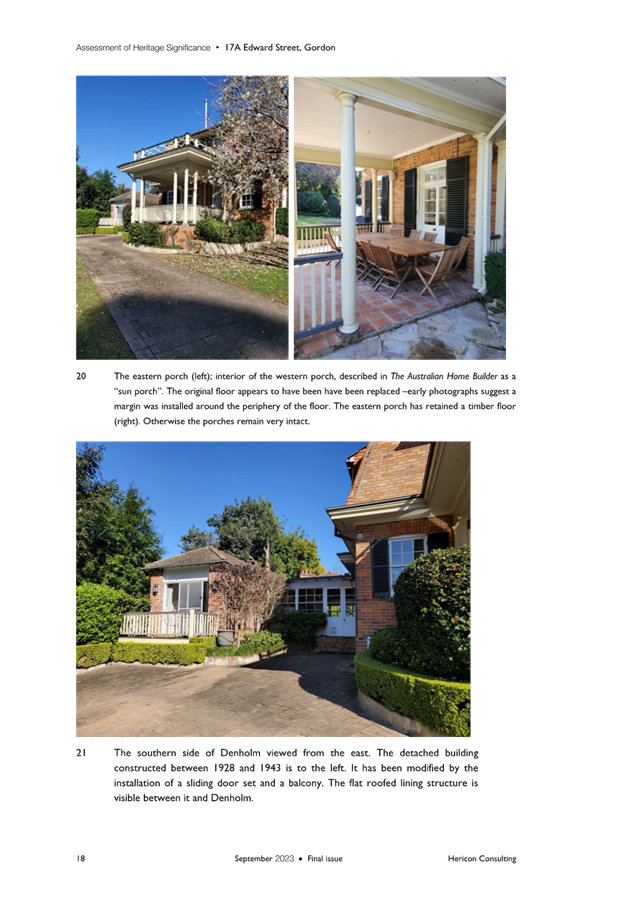
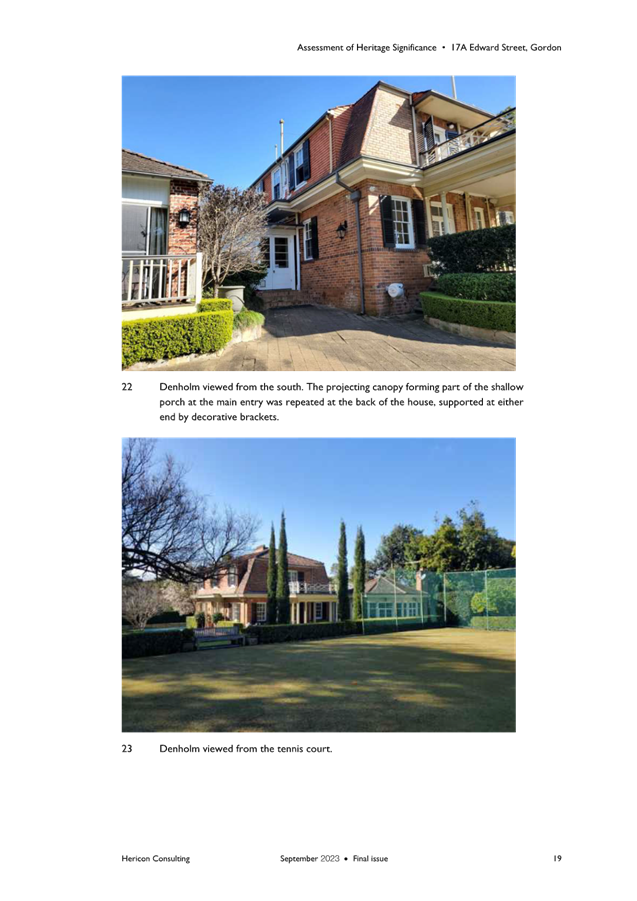
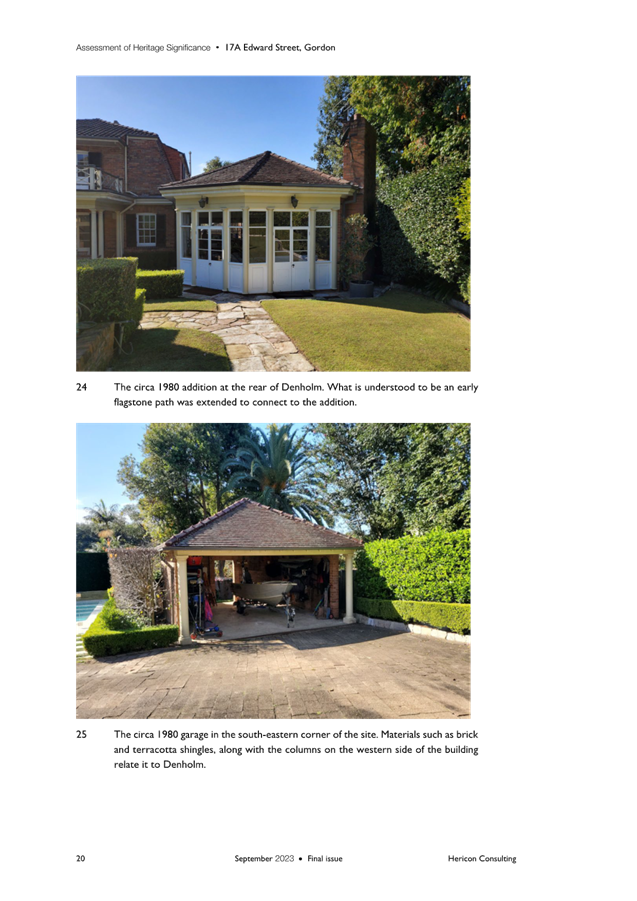
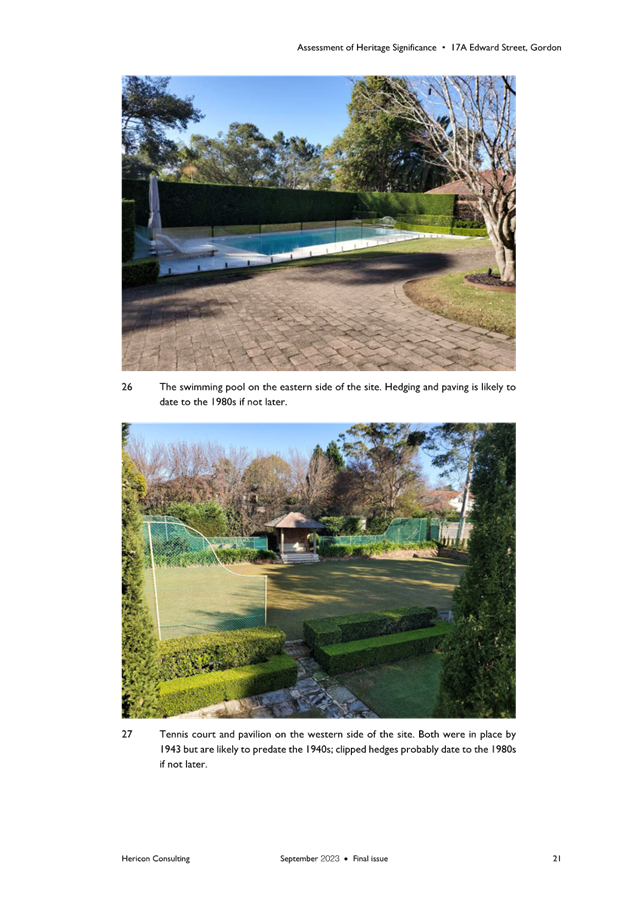
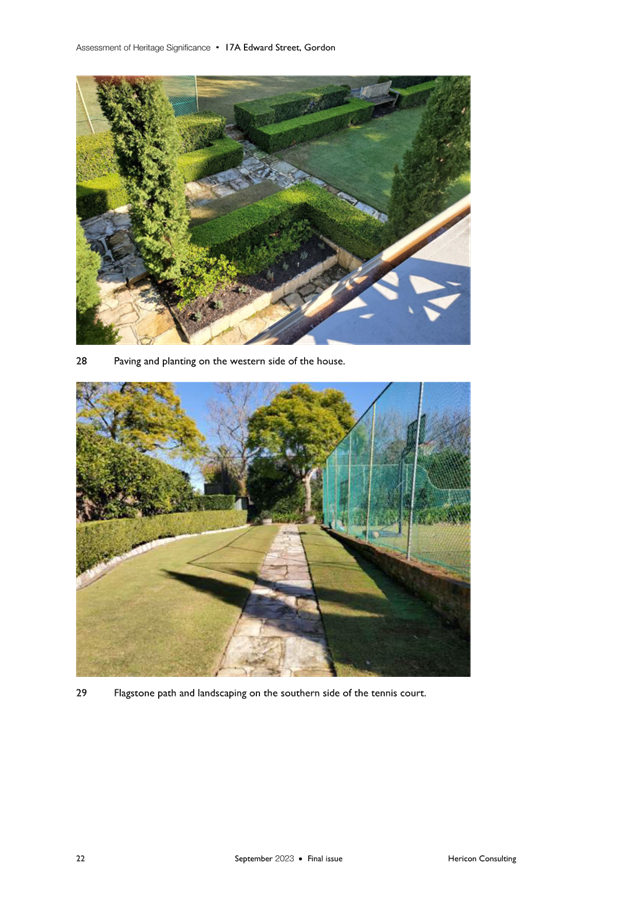
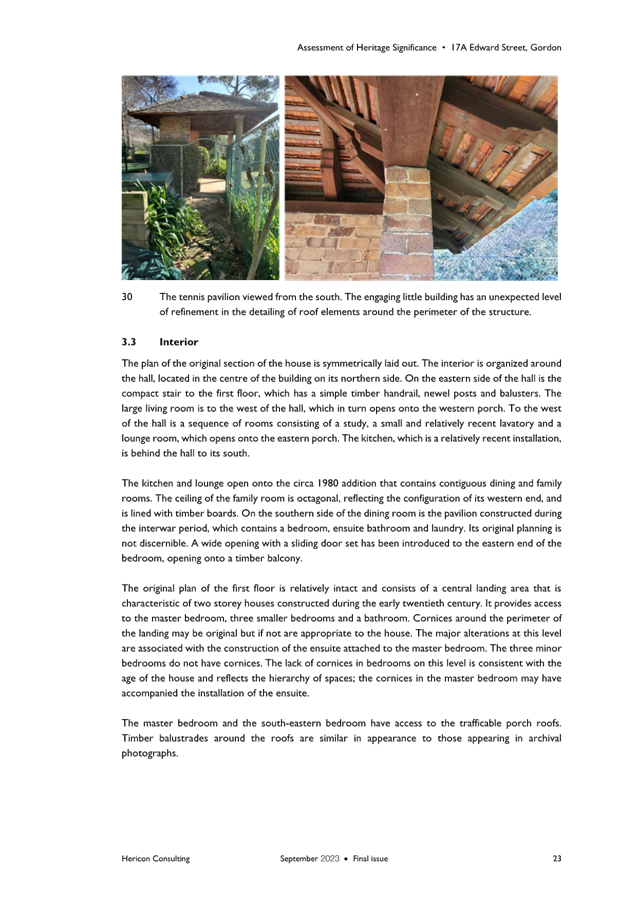
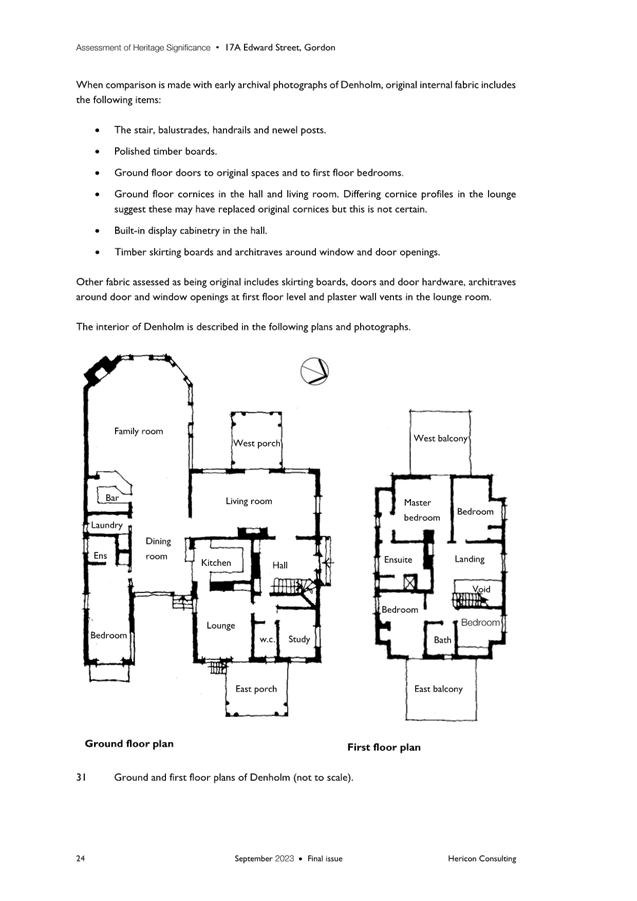
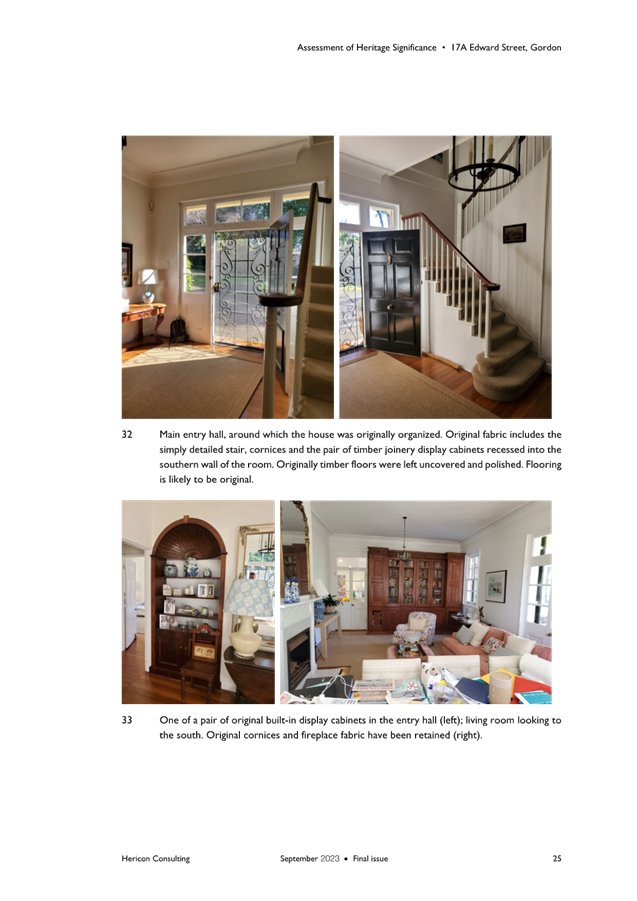
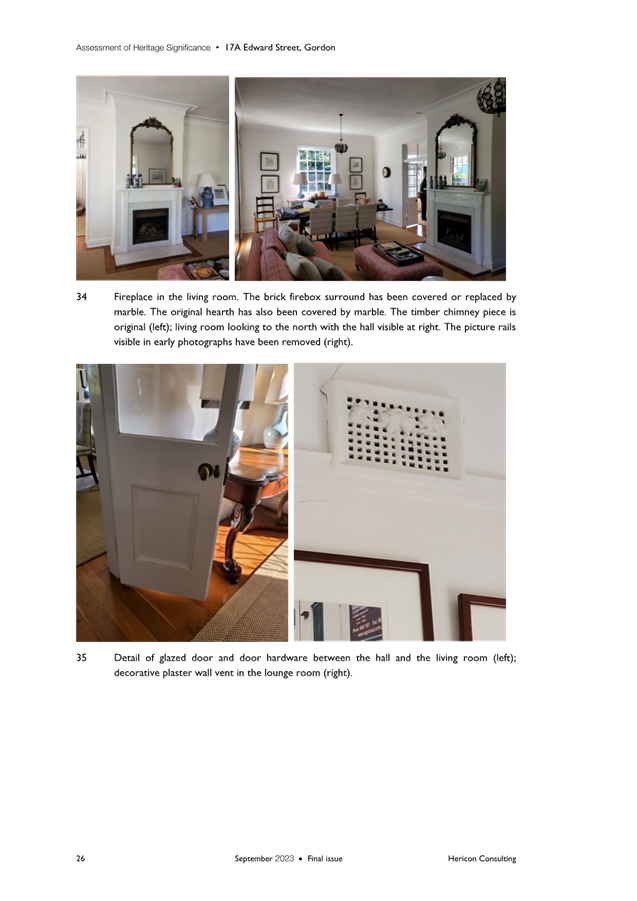
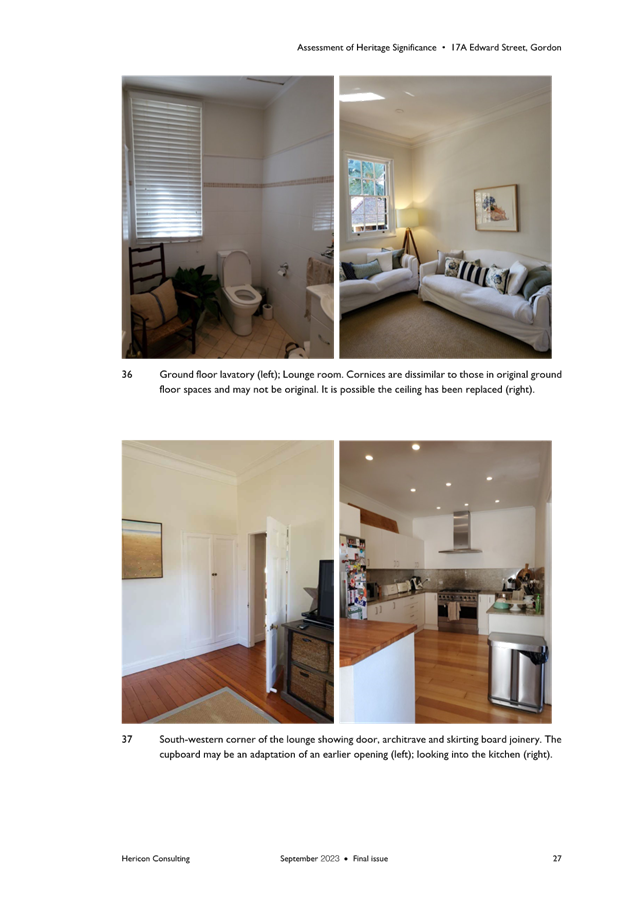
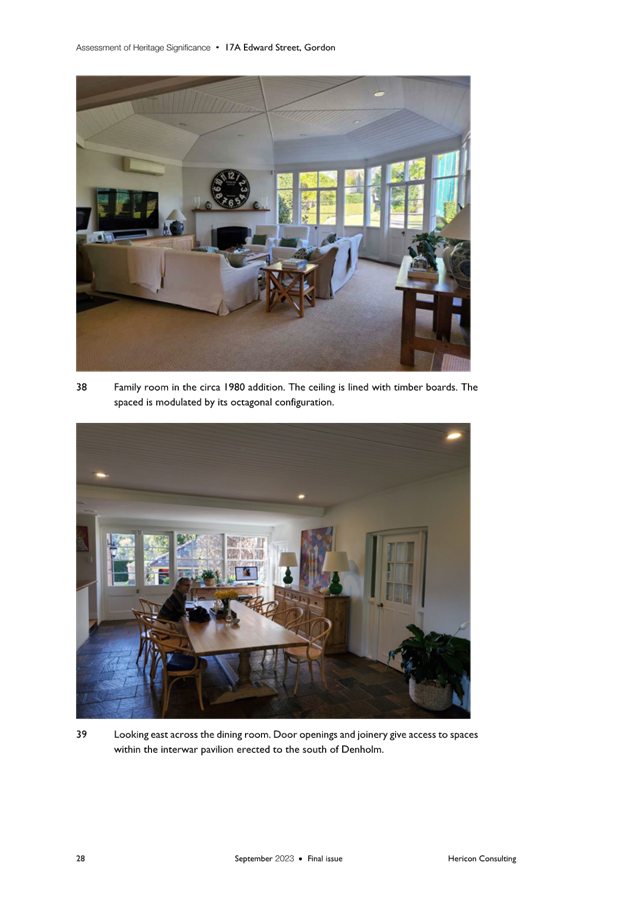
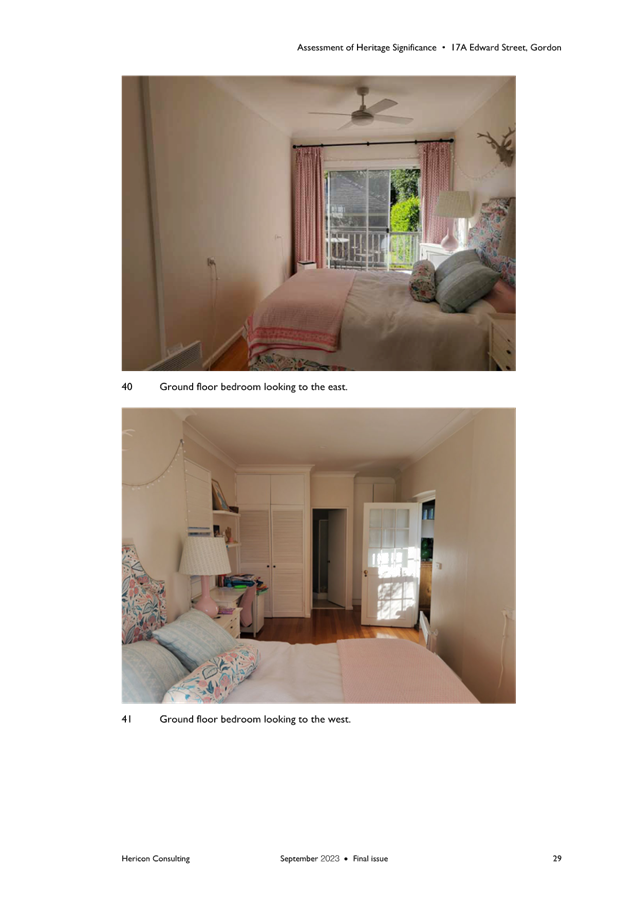

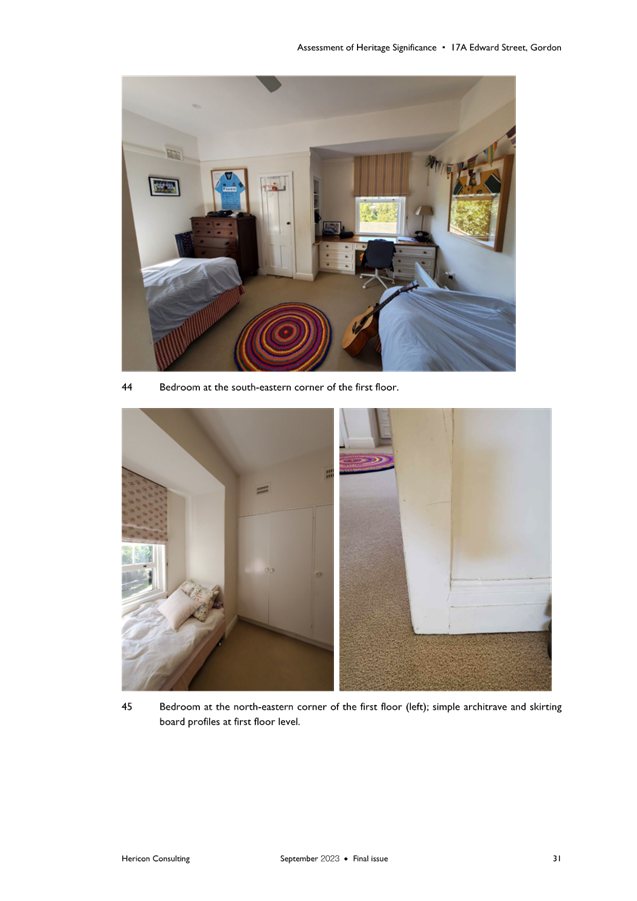

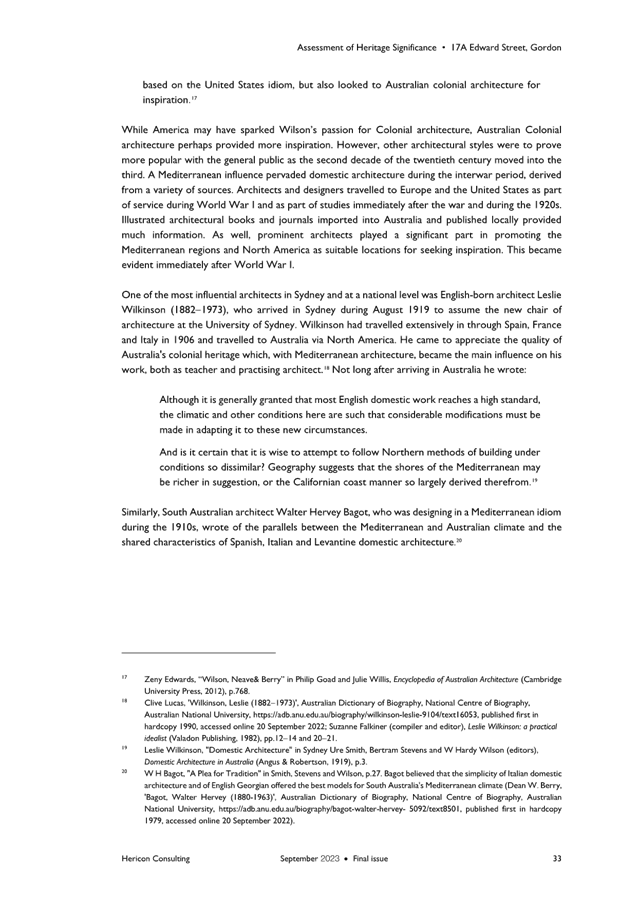
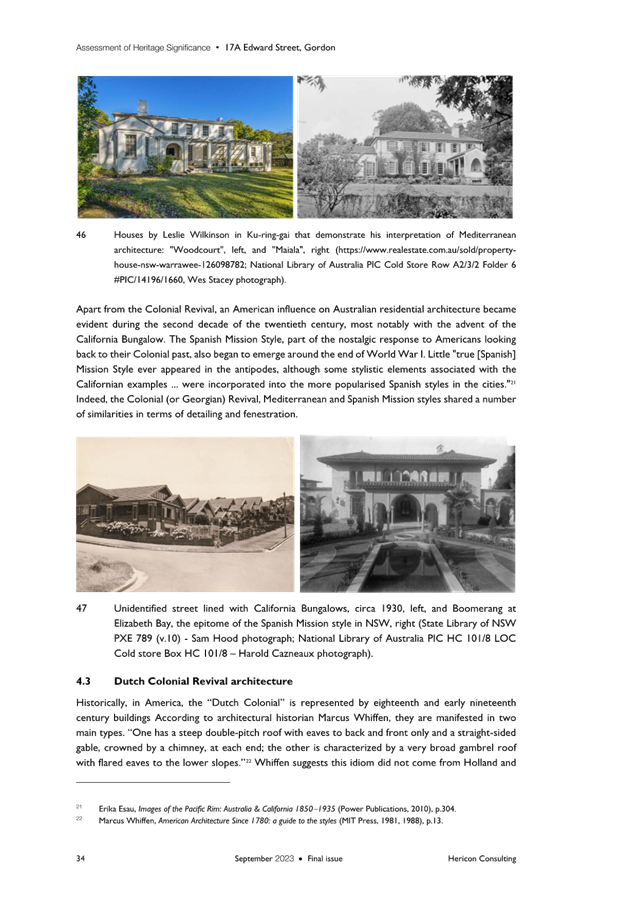
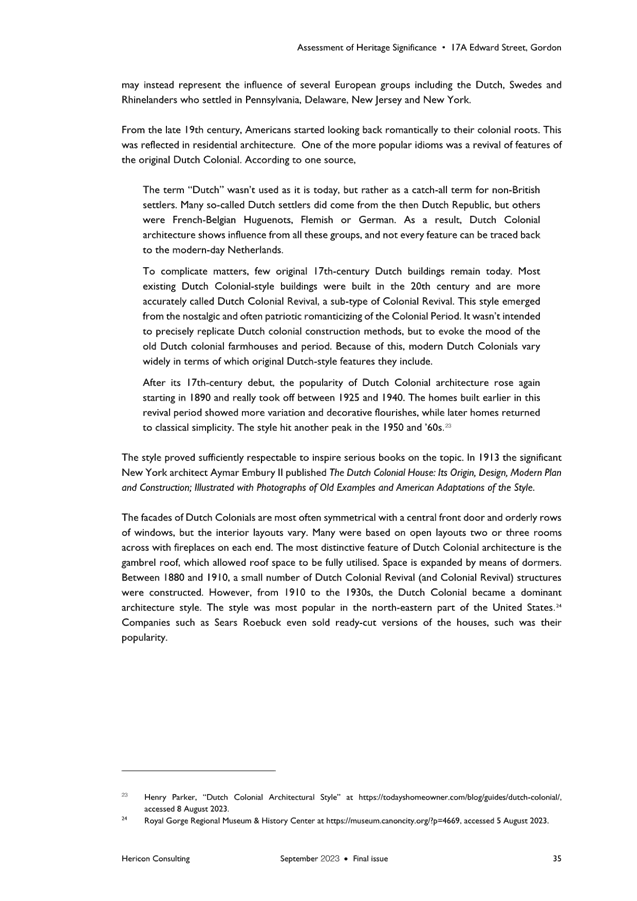
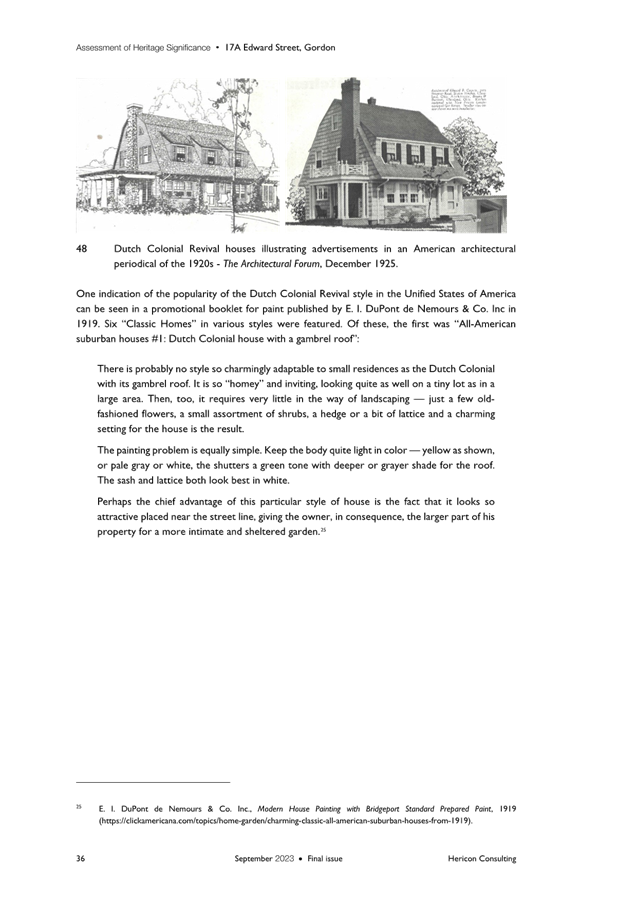
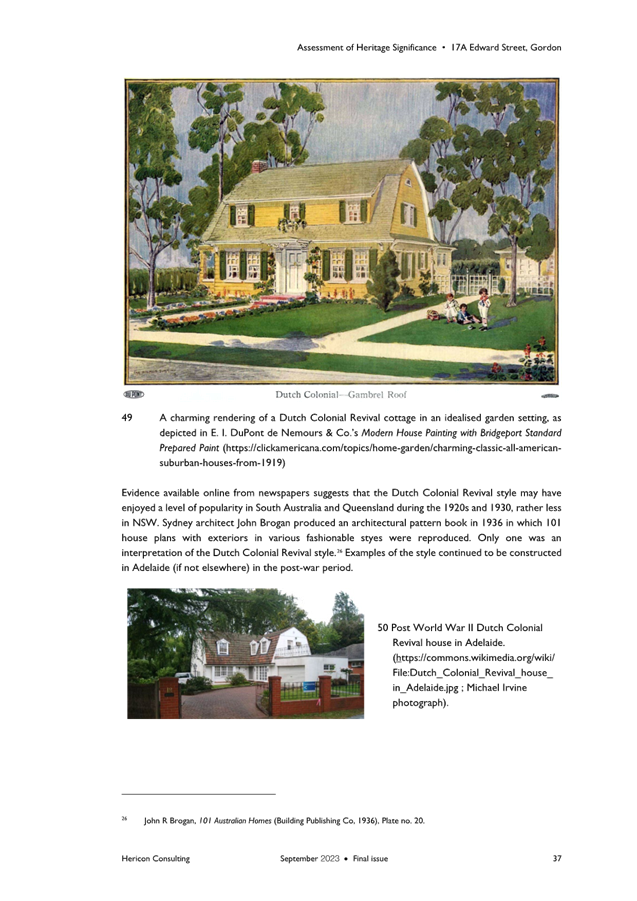
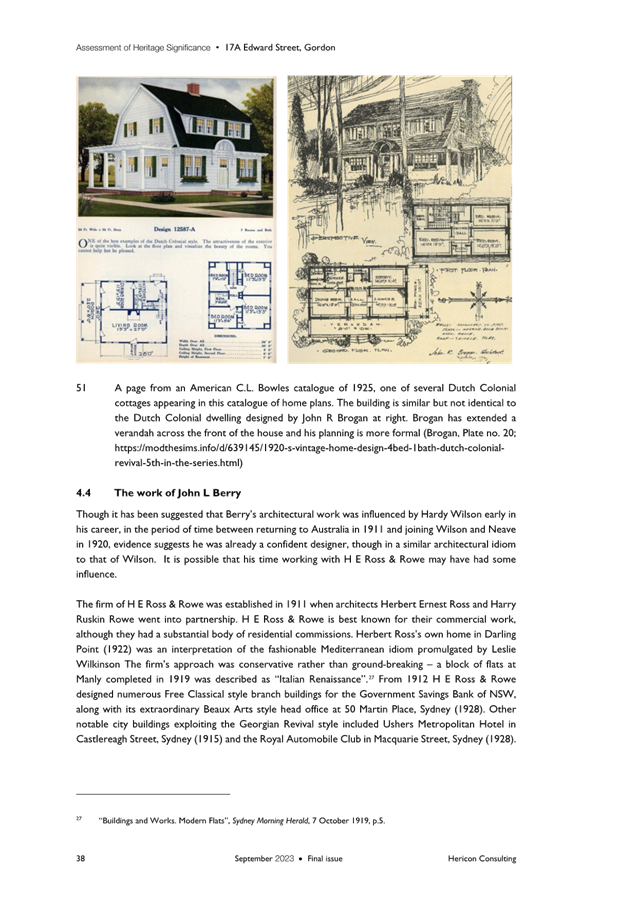
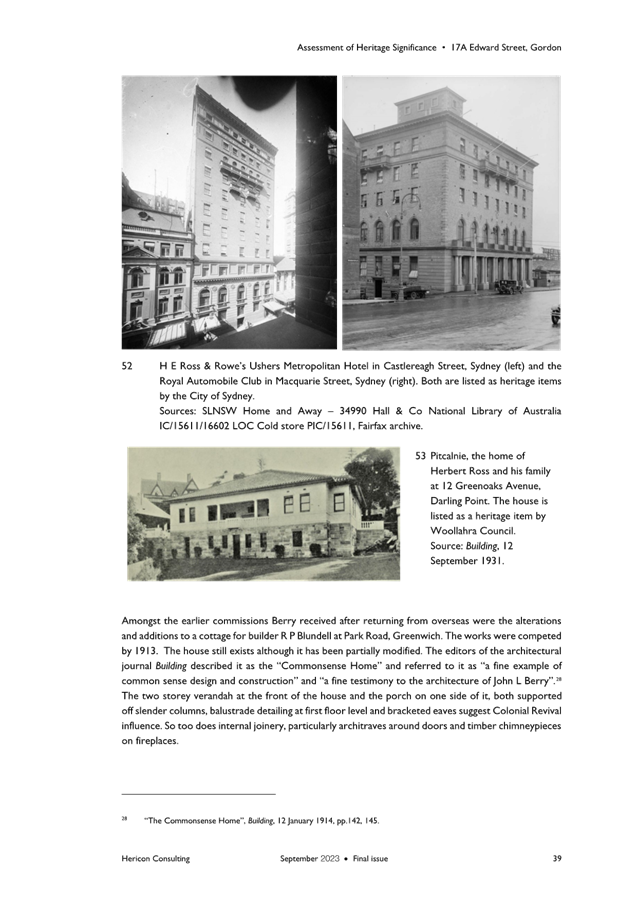
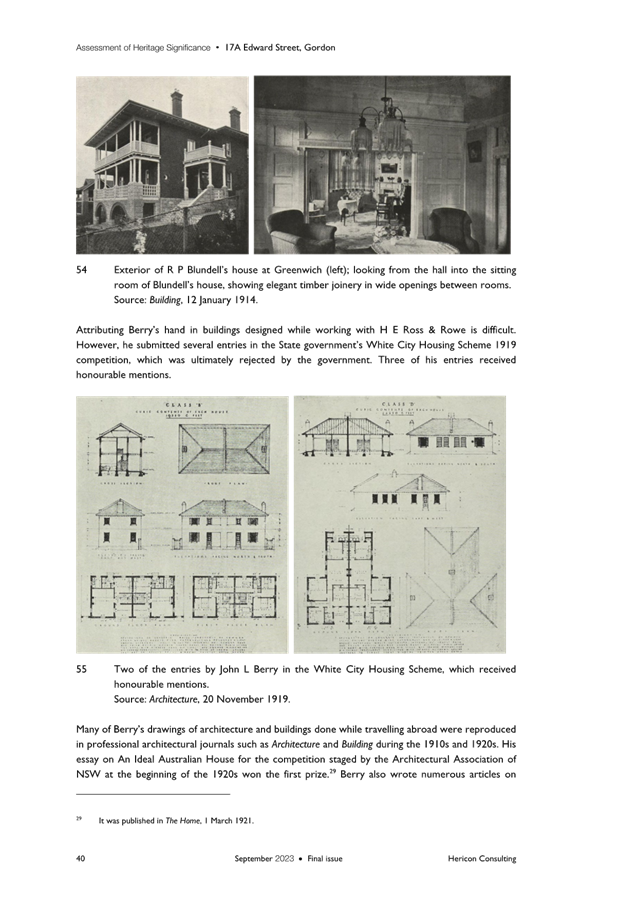
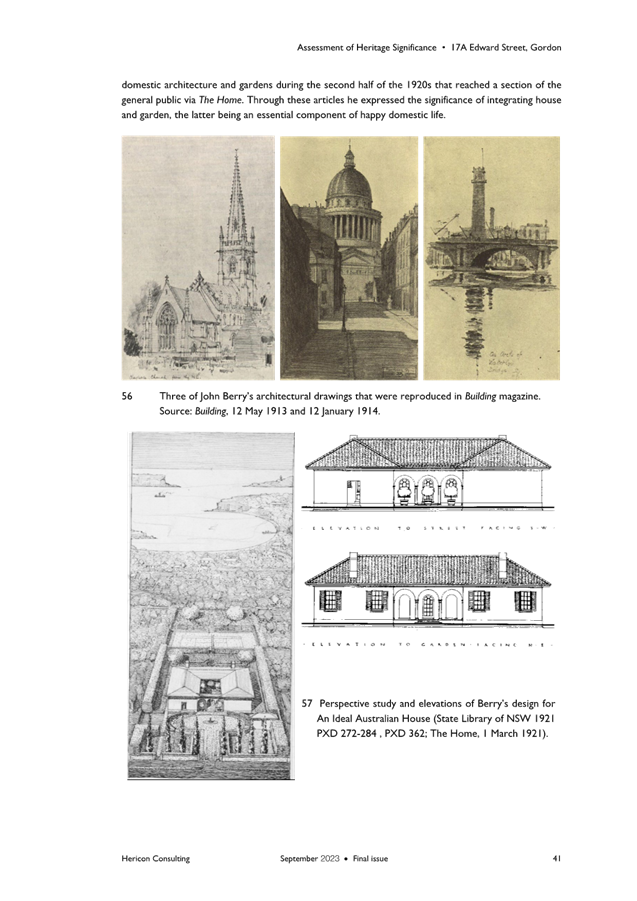
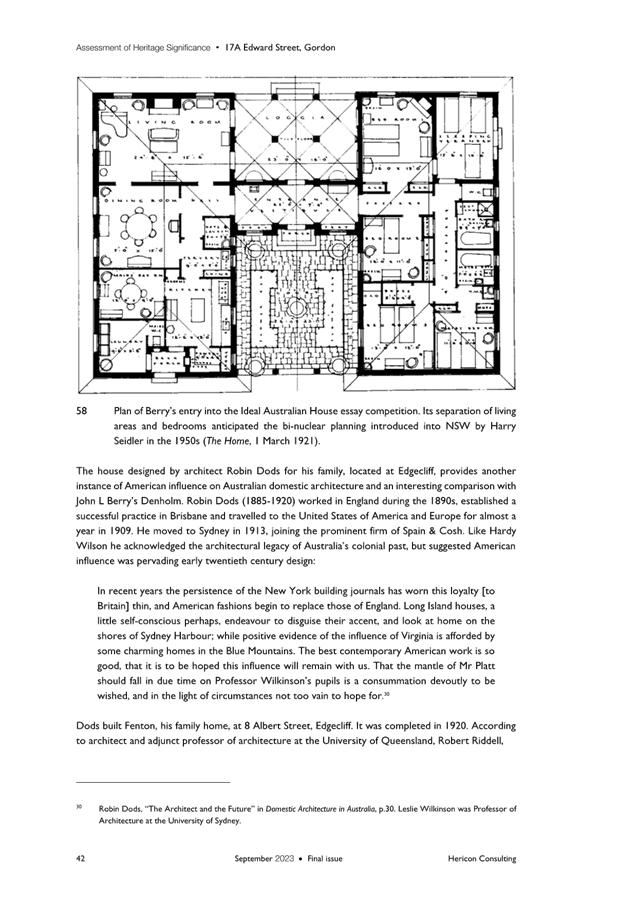
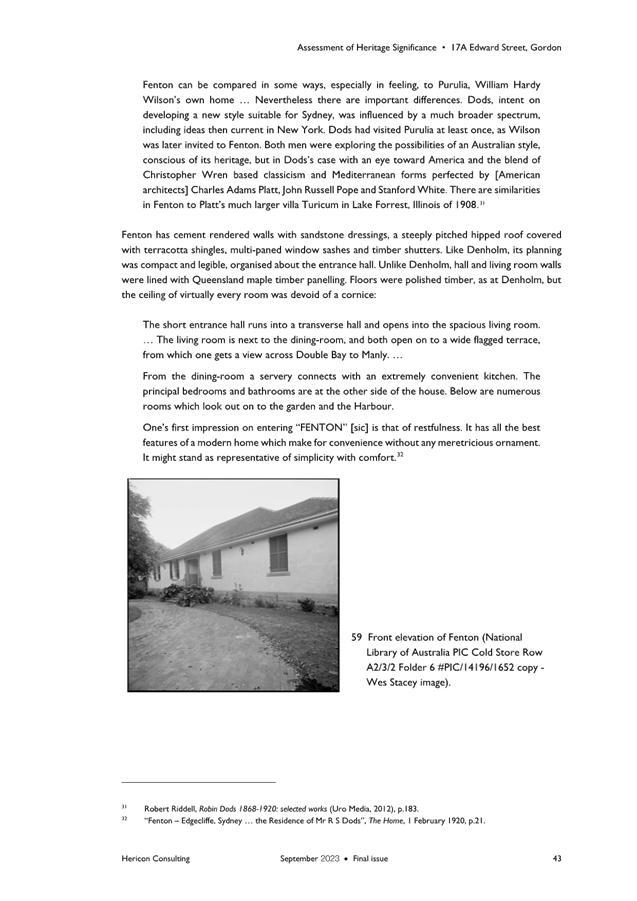
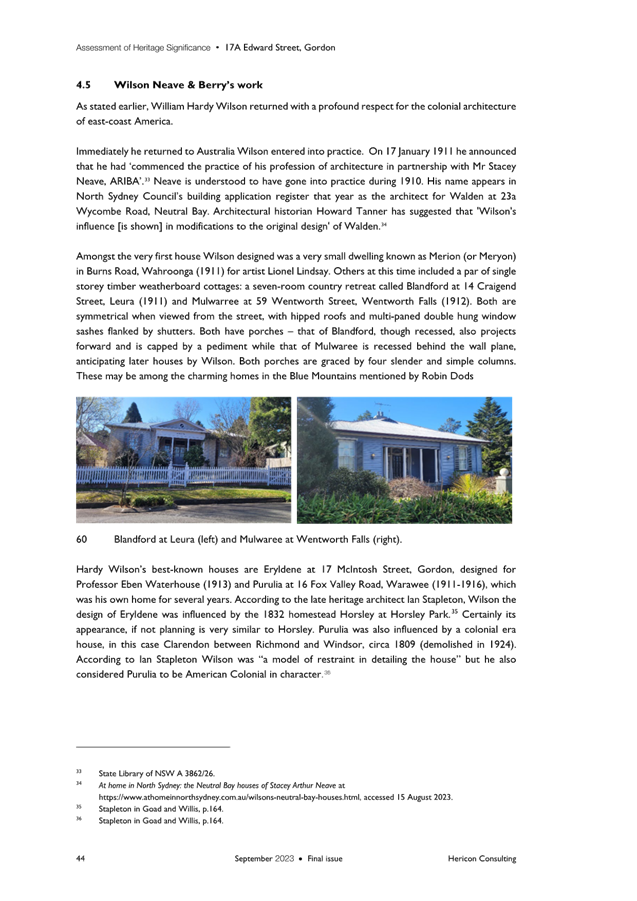
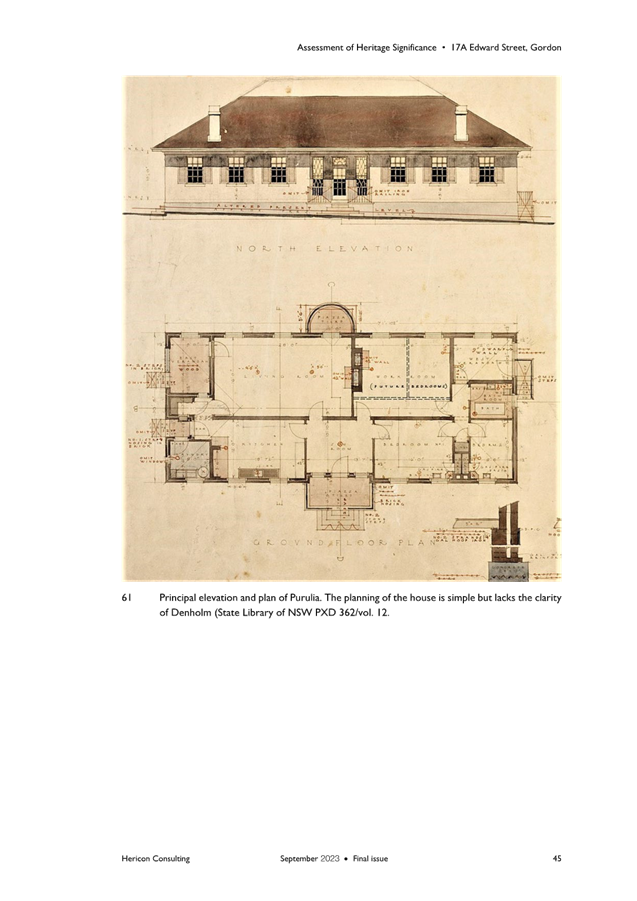
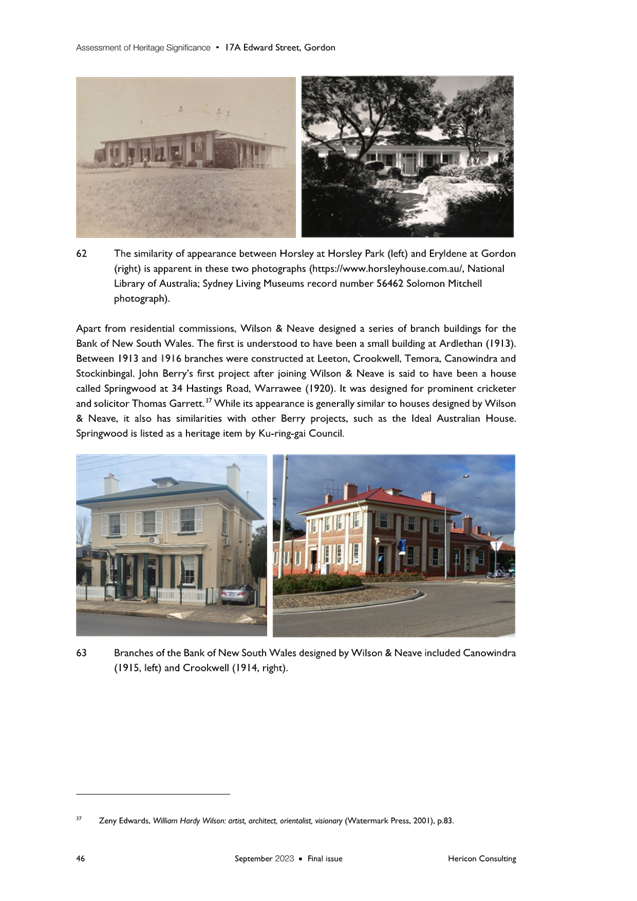
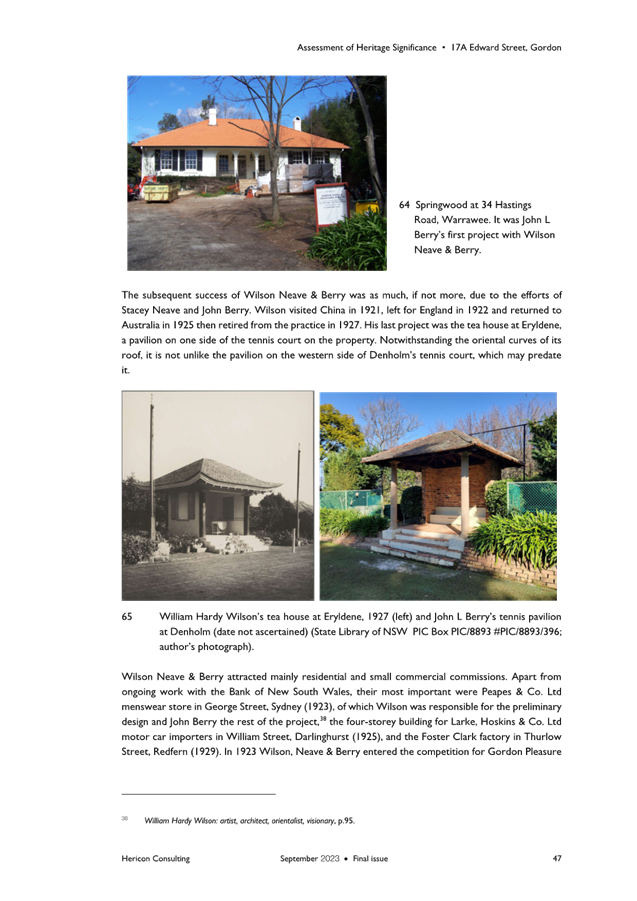
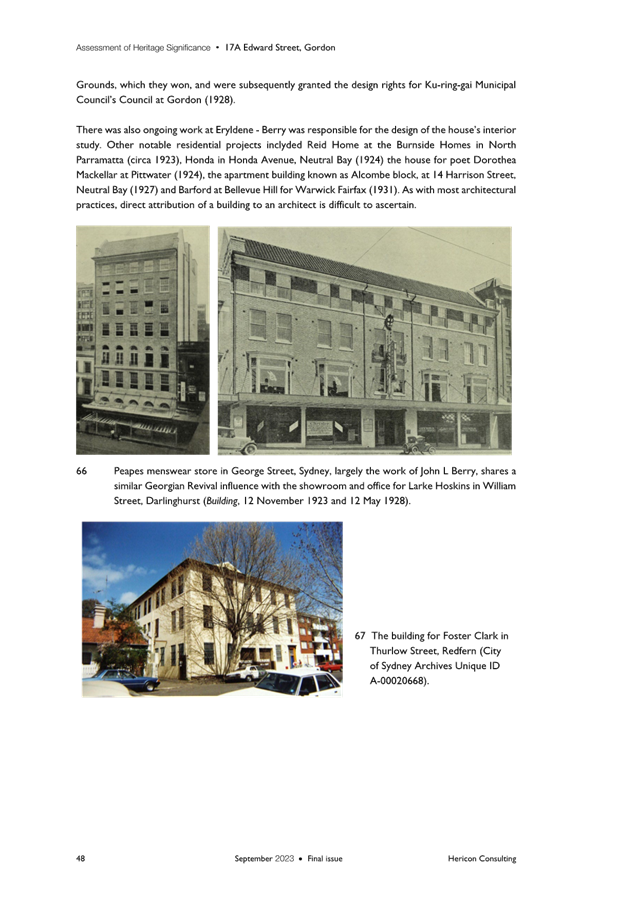
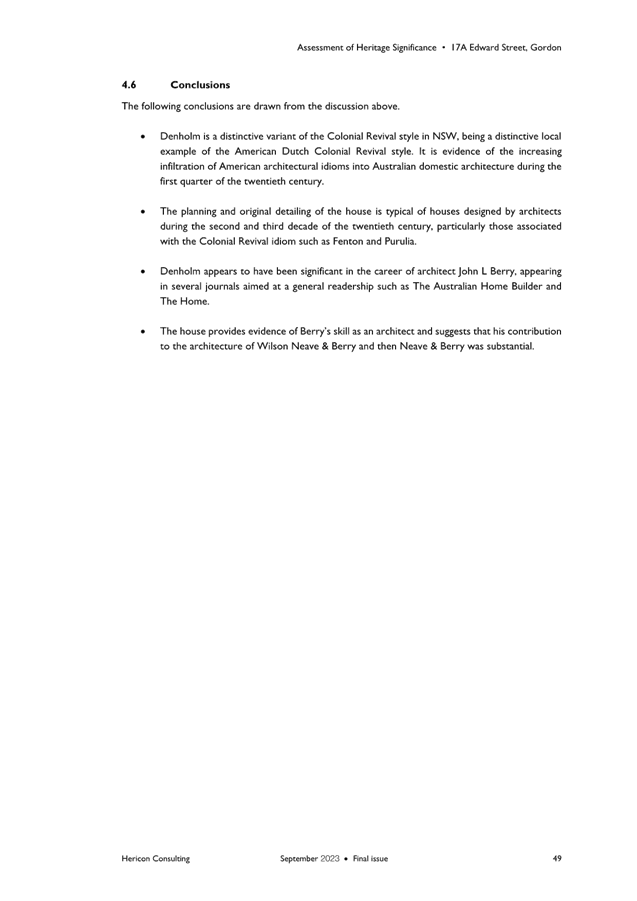
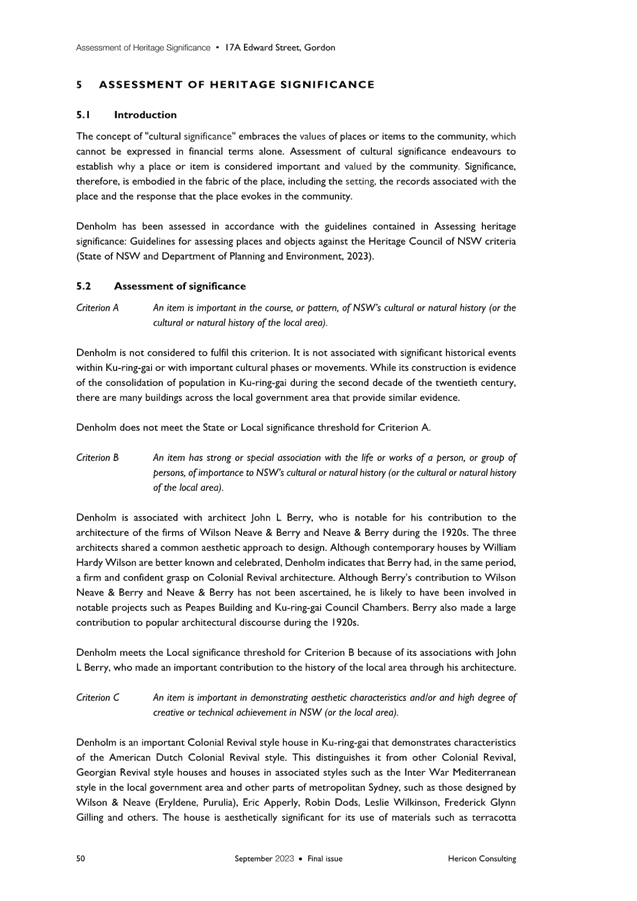
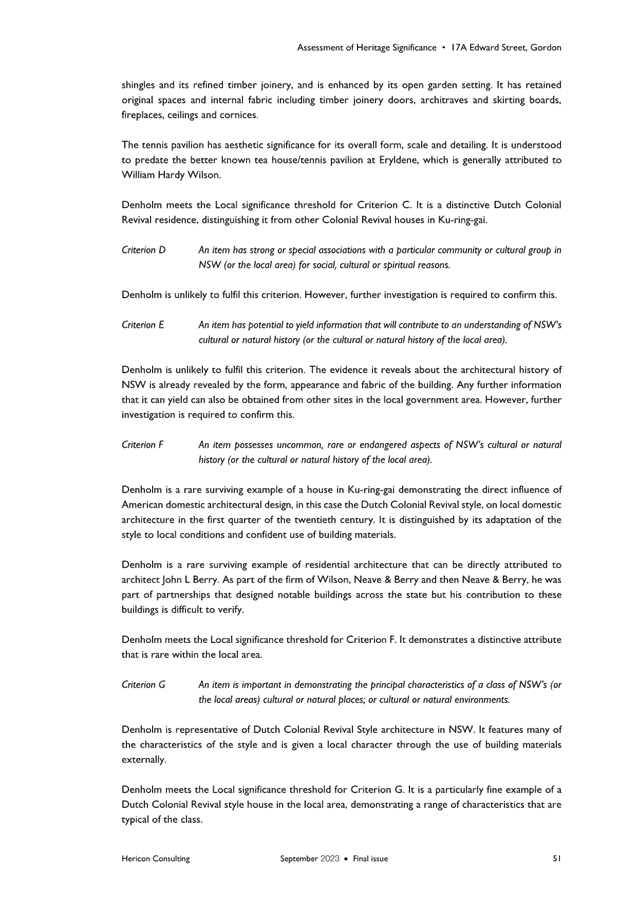
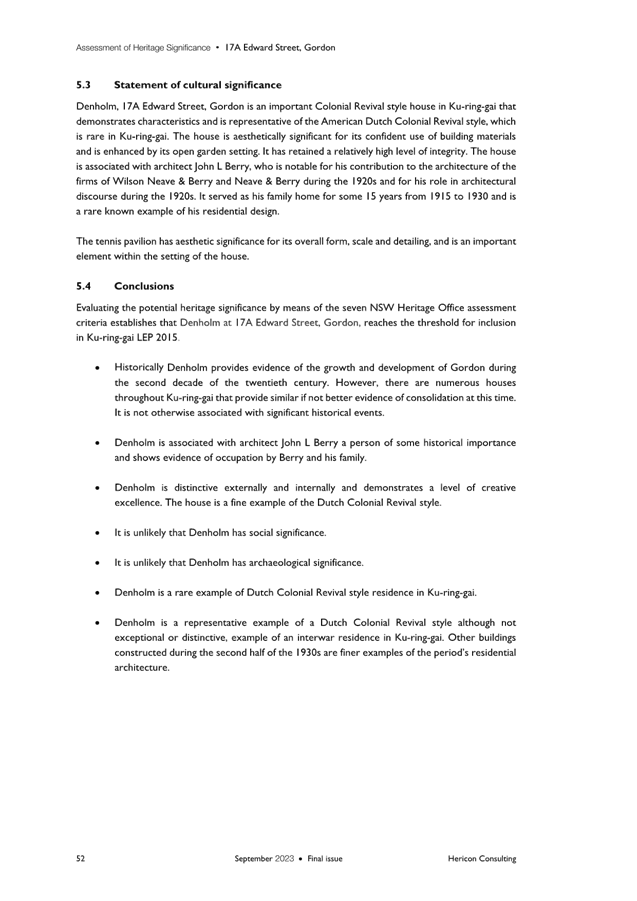

|
ATTACHMENT
No: 3 - OMC
Report and Resolution 21 November 2023 - 17a Edward Street, Gordon
|
|
Item No: GB.10
|
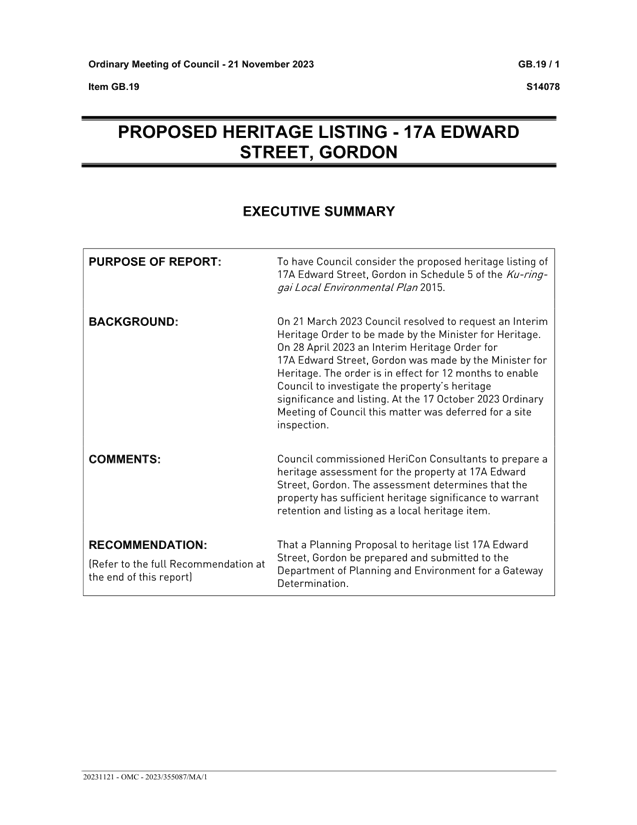
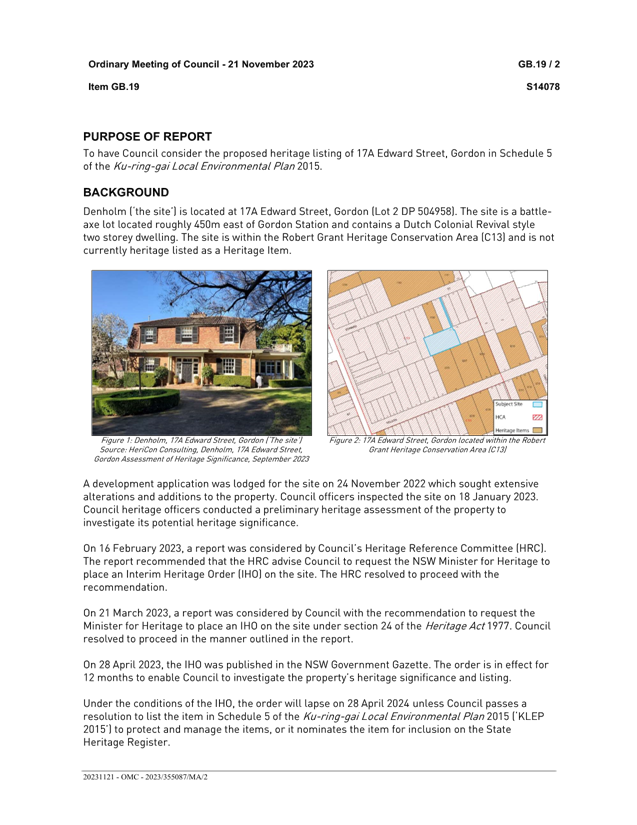
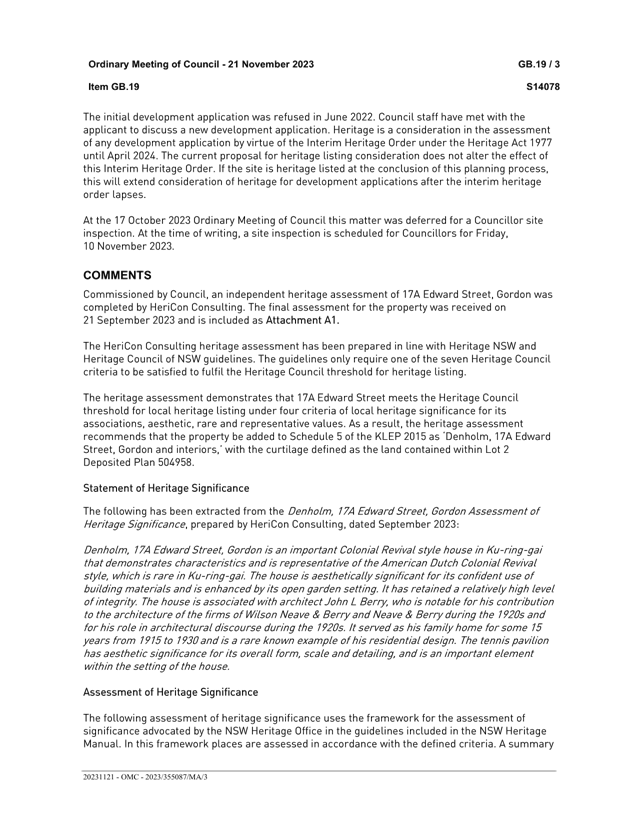
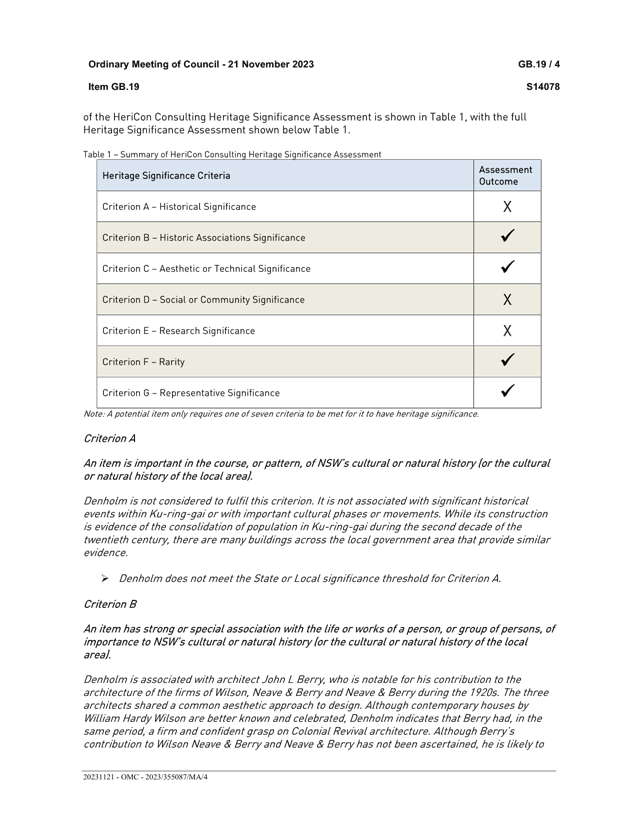
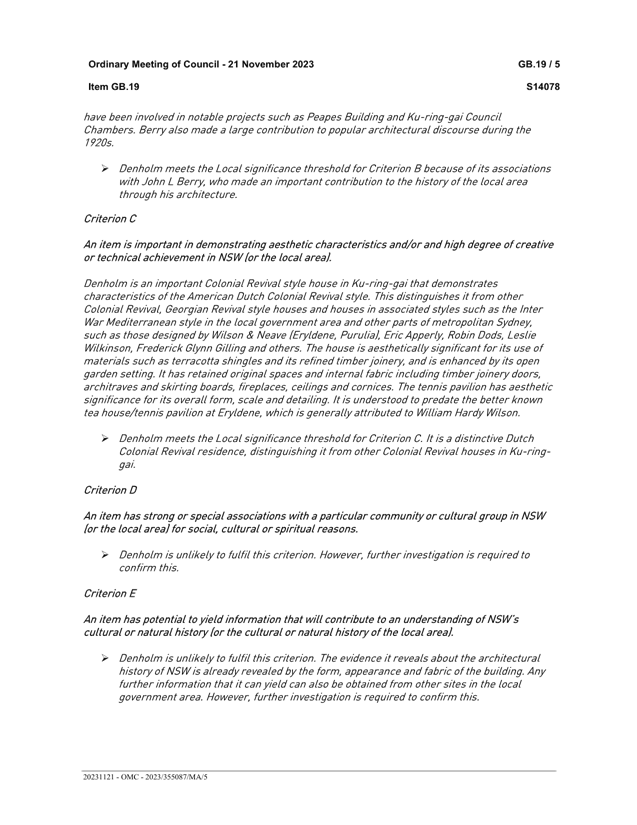
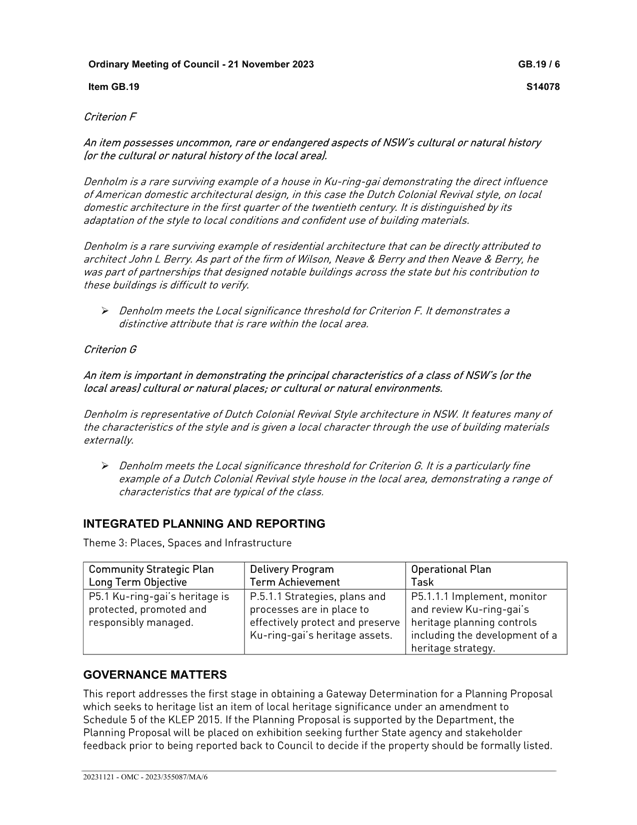
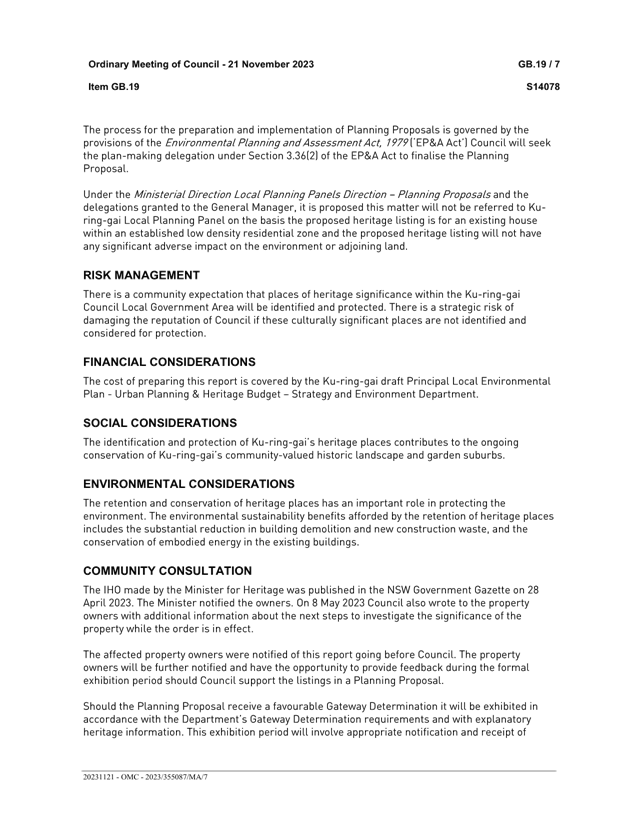
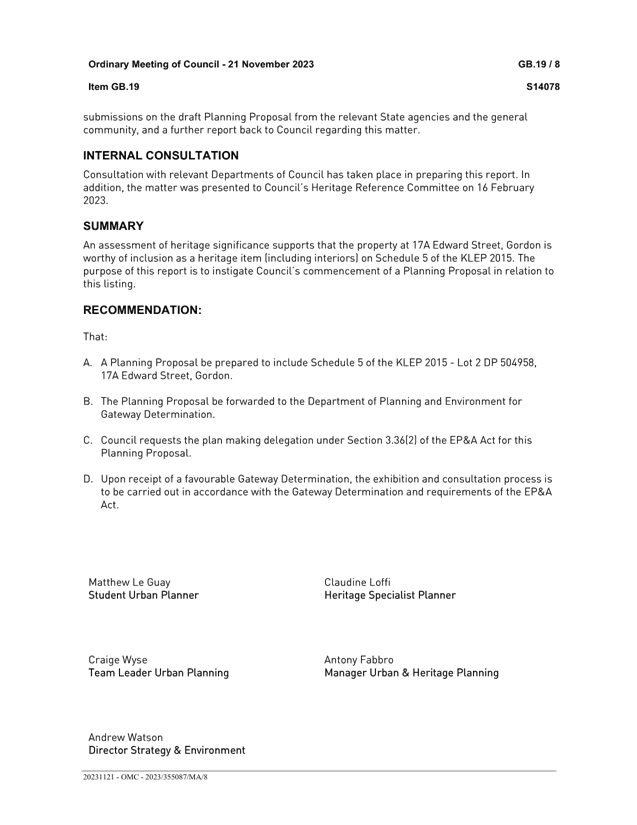

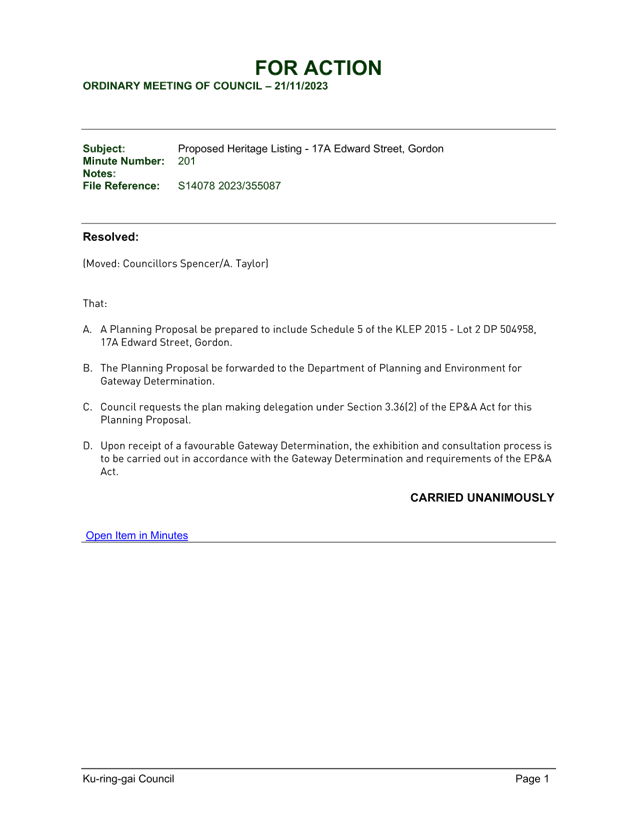
|
ATTACHMENT
No: 4 - Exhibition
Version - Planning Proposal to Heritage List Denholm, 17A Edward Street,
Gordon
|
|
Item No: GB.10
|
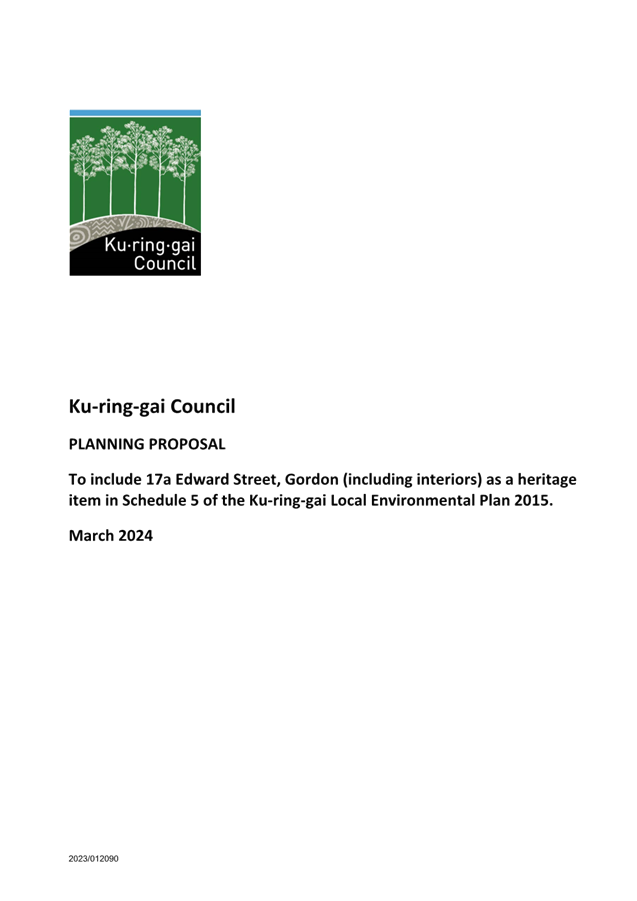
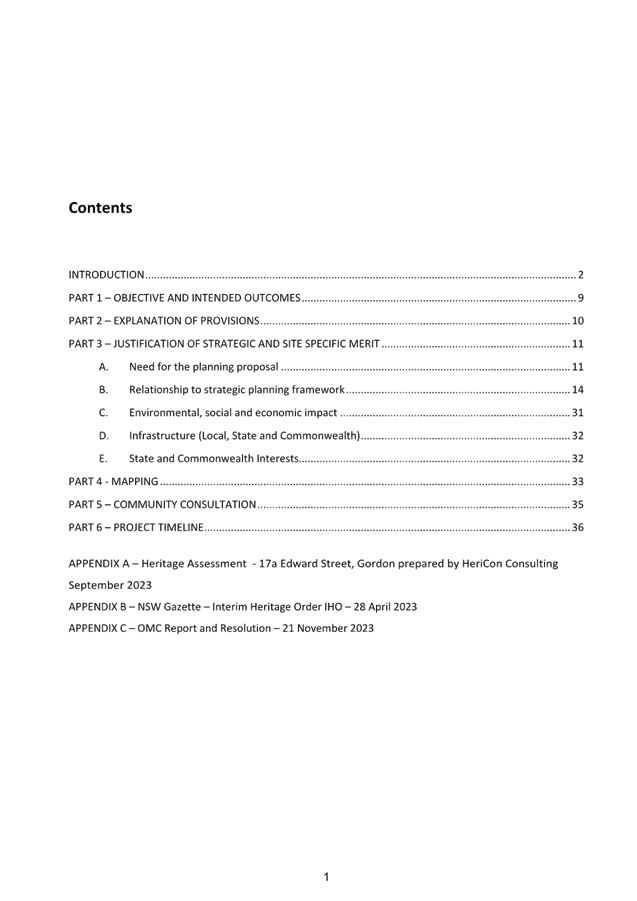
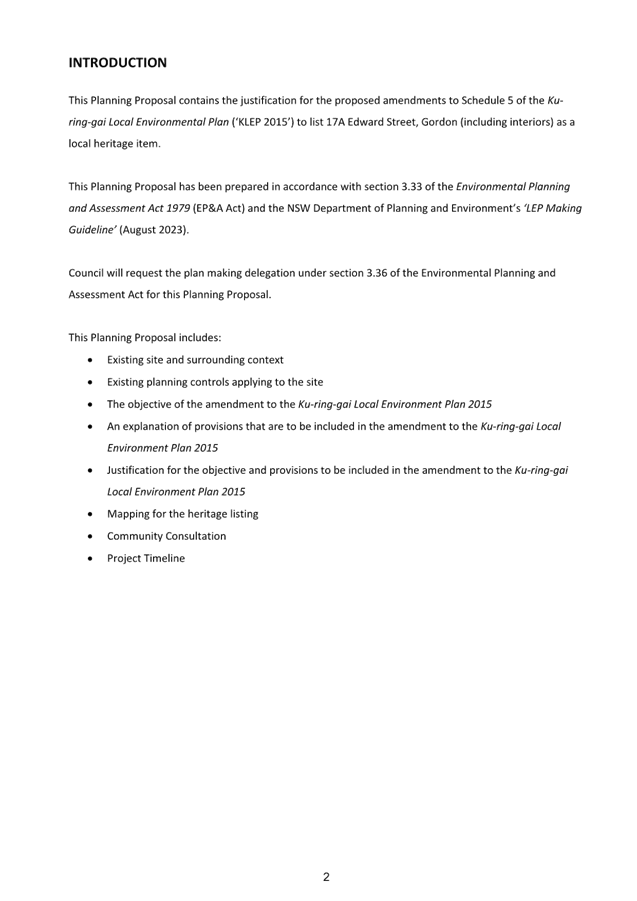
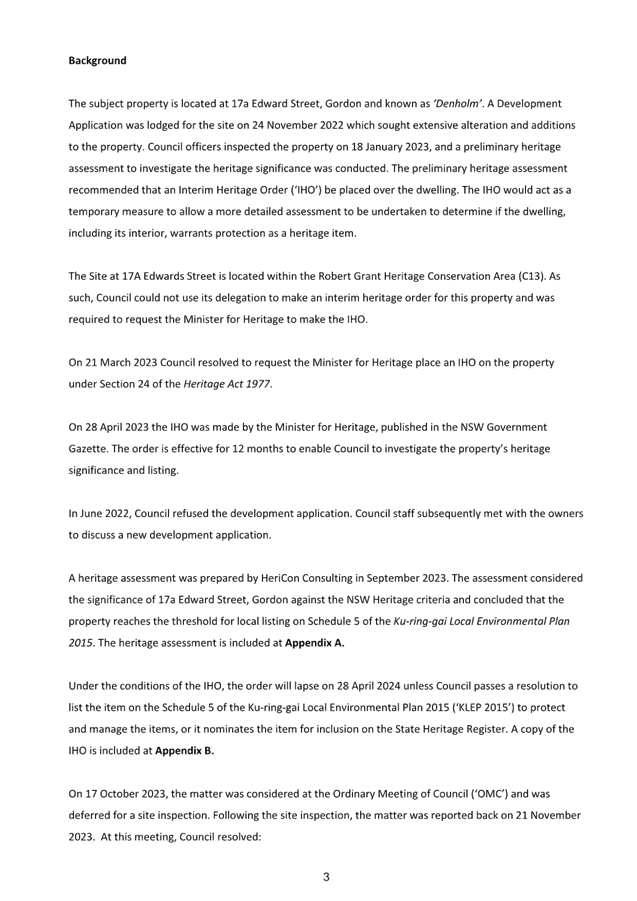
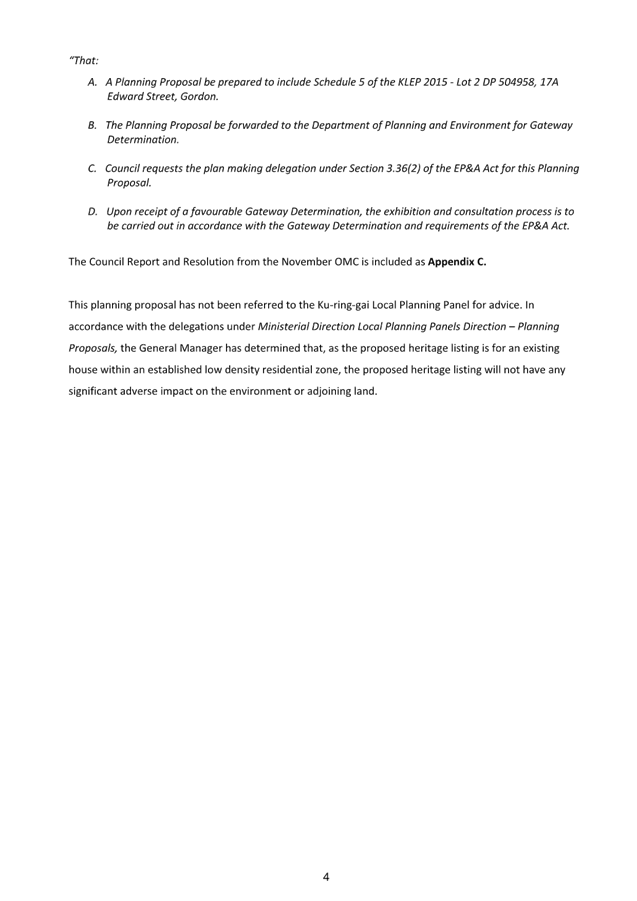
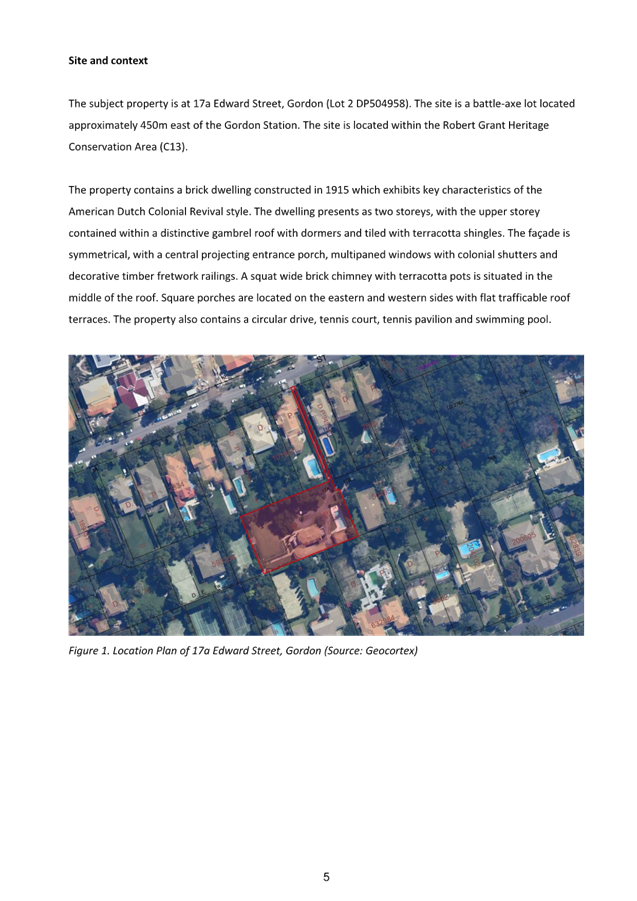
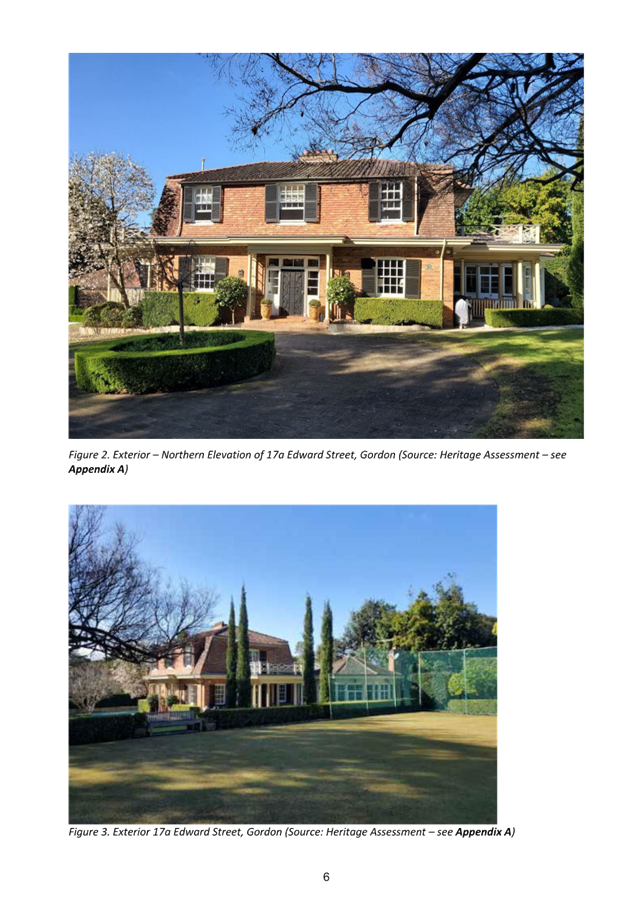
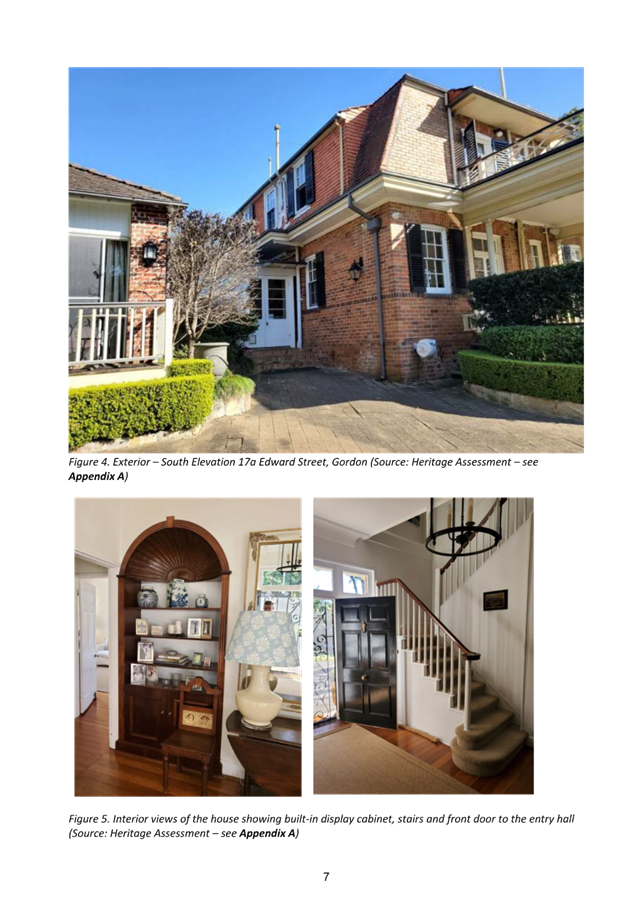
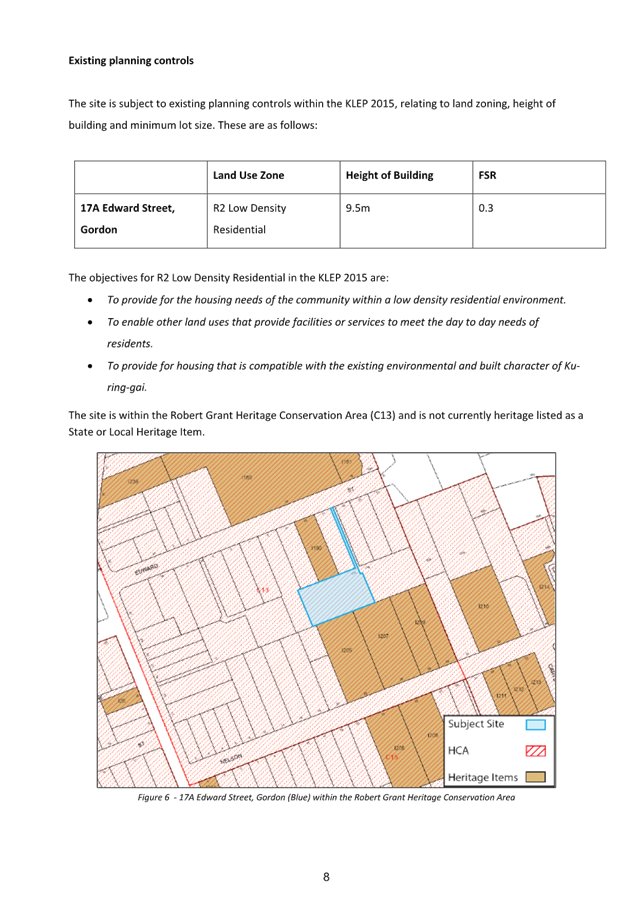

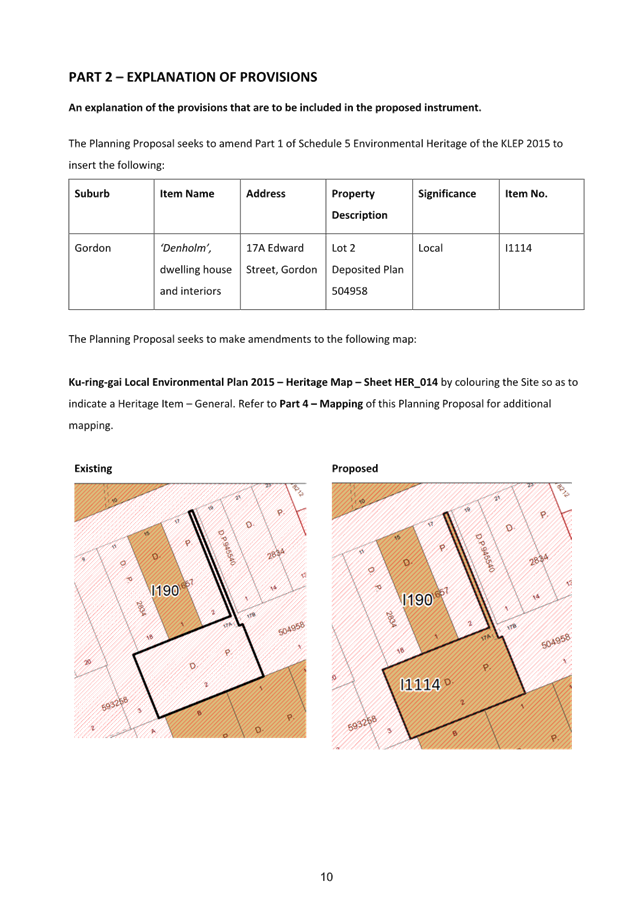
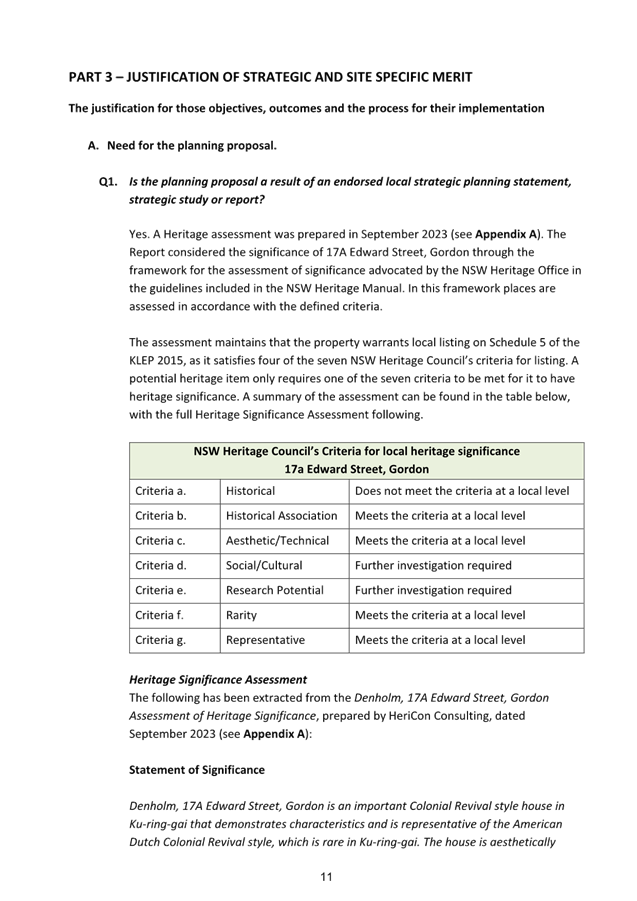
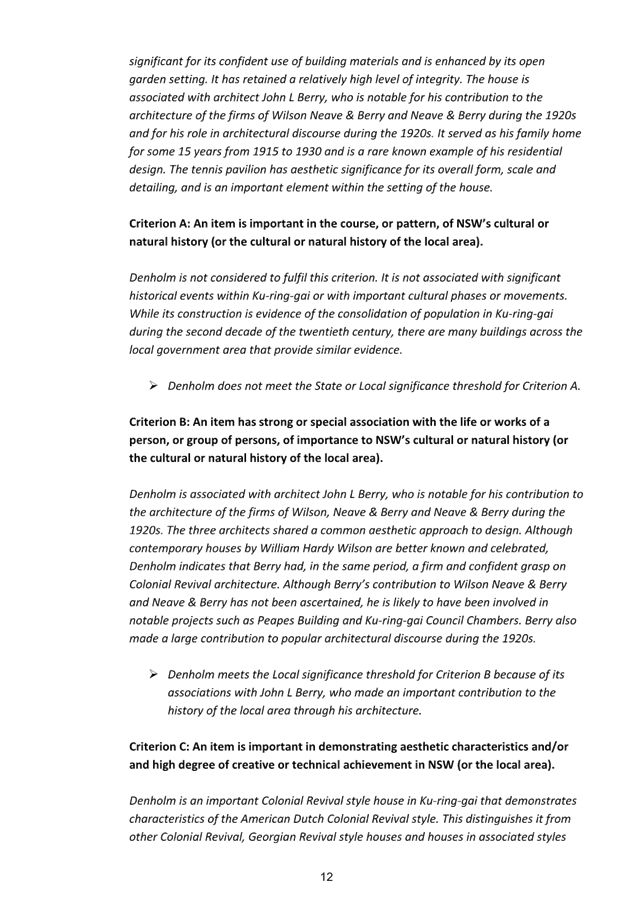
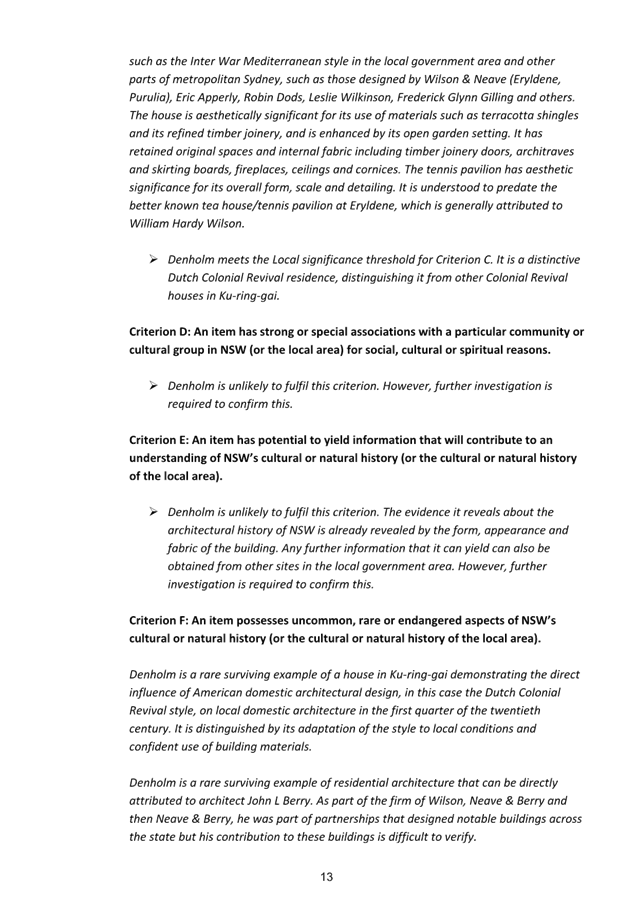
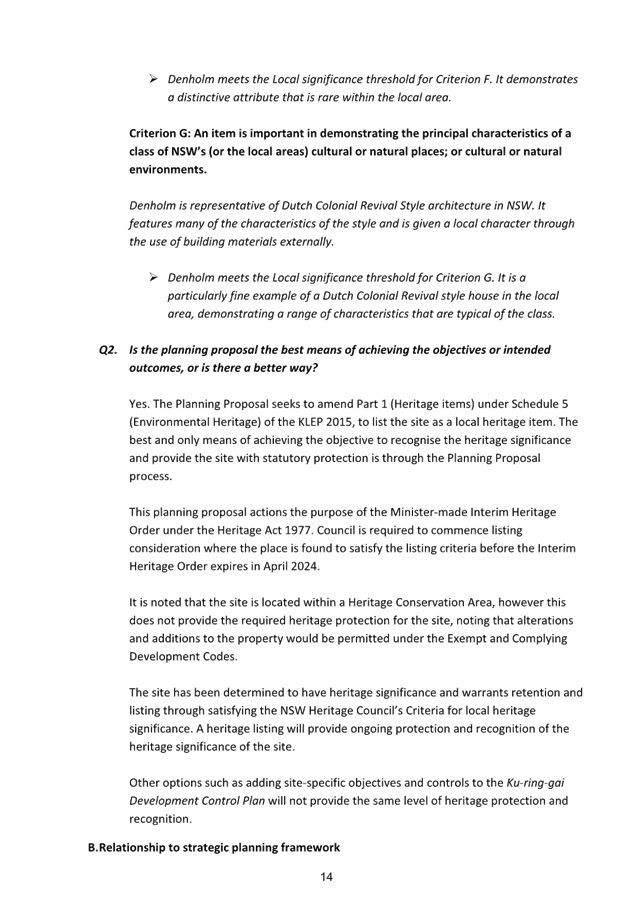
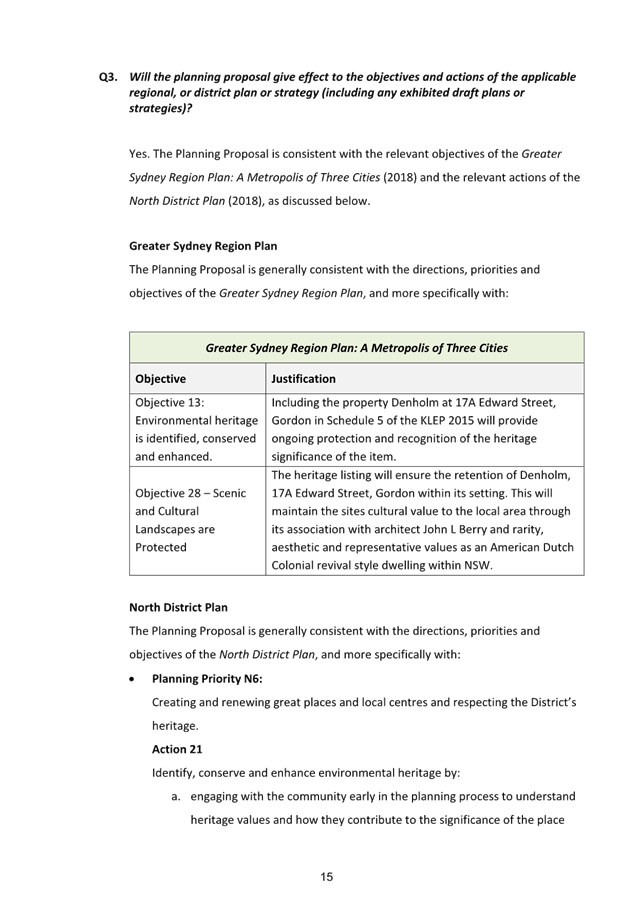
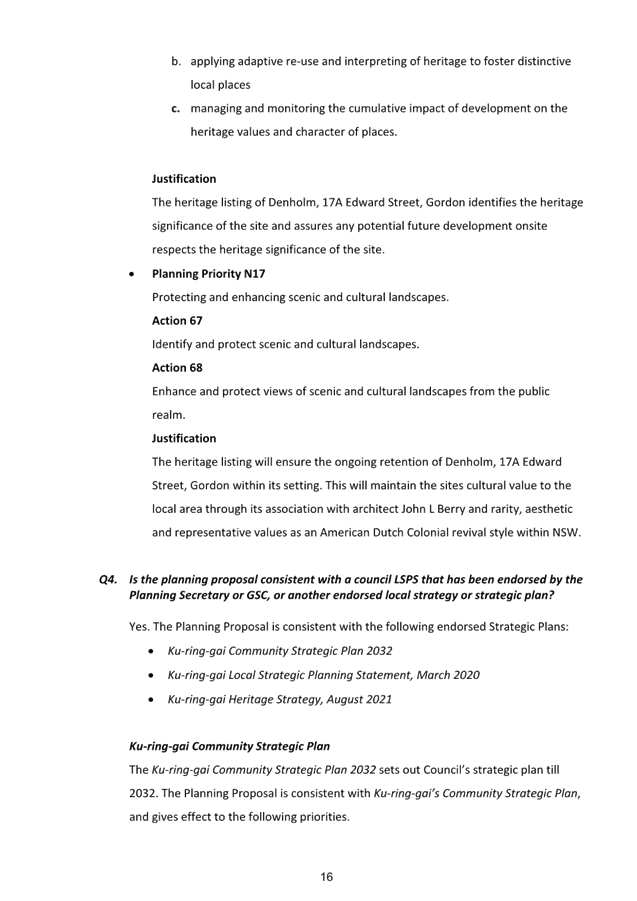
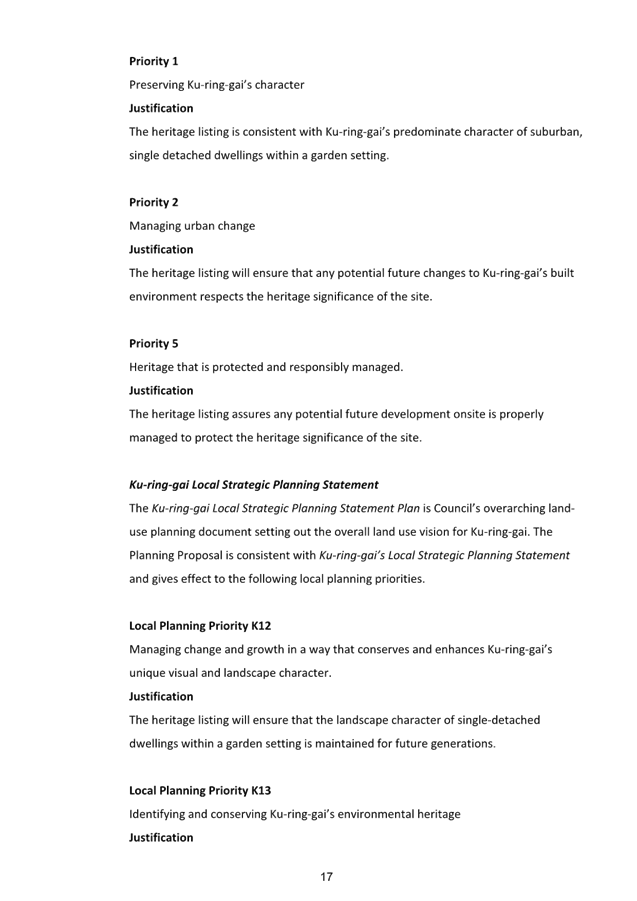
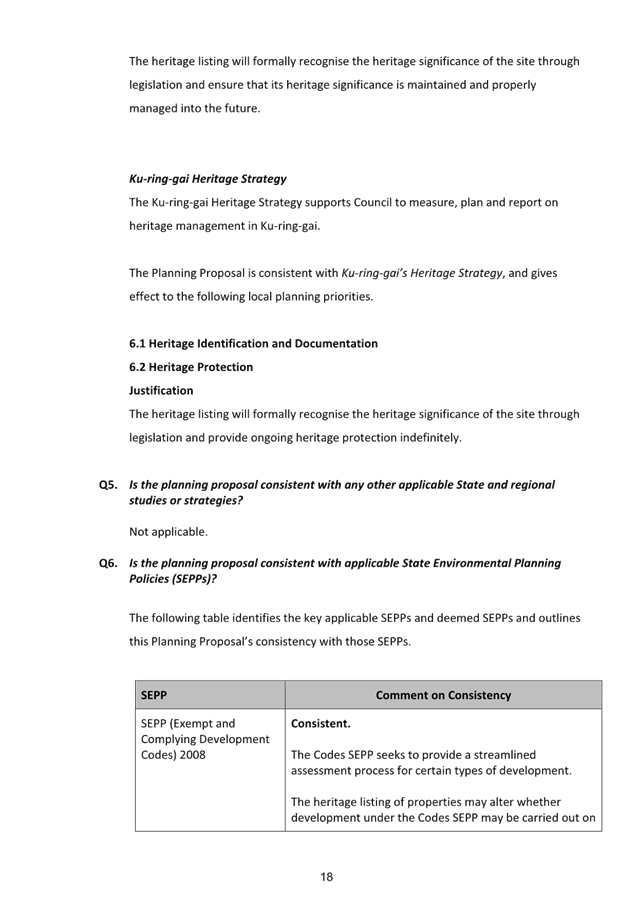
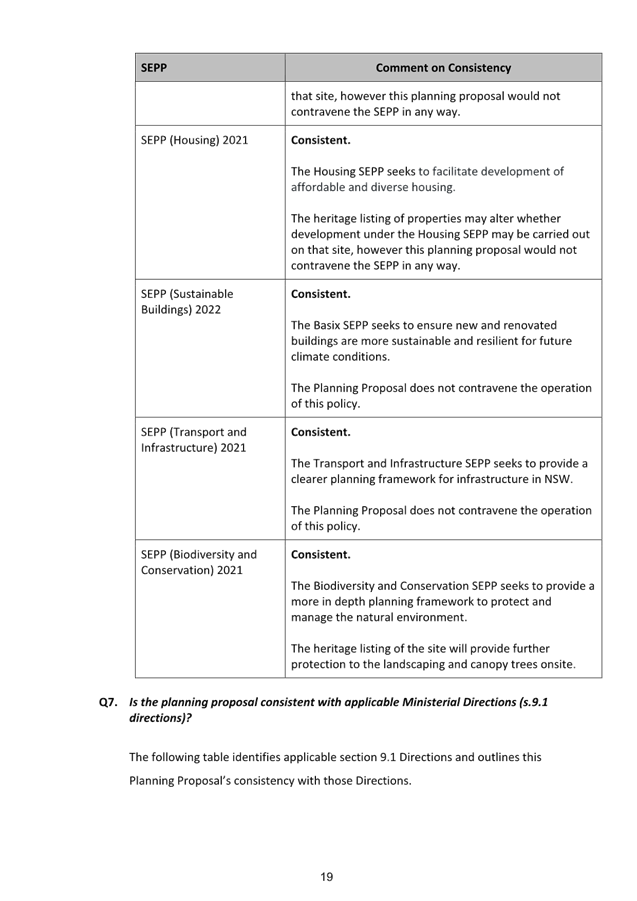
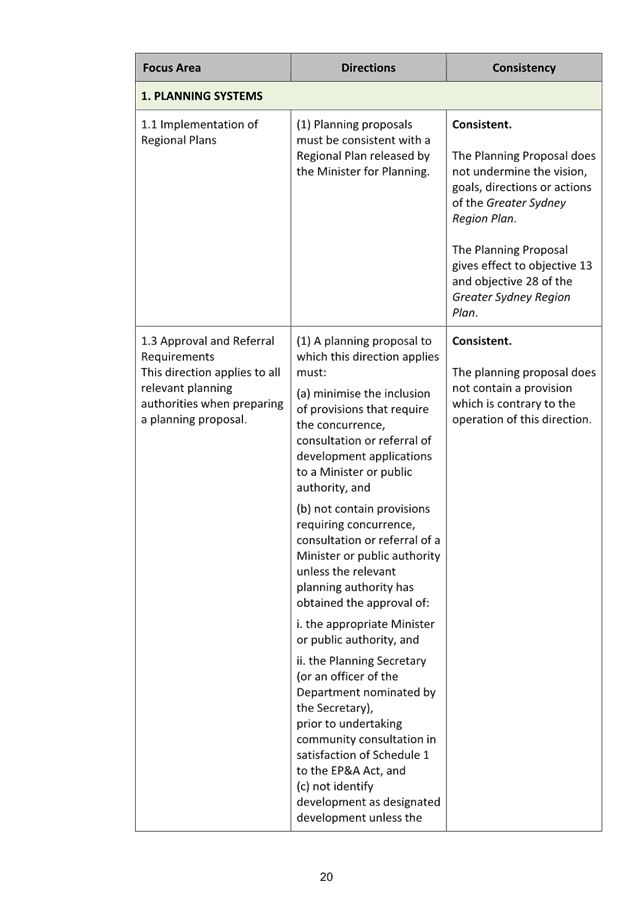
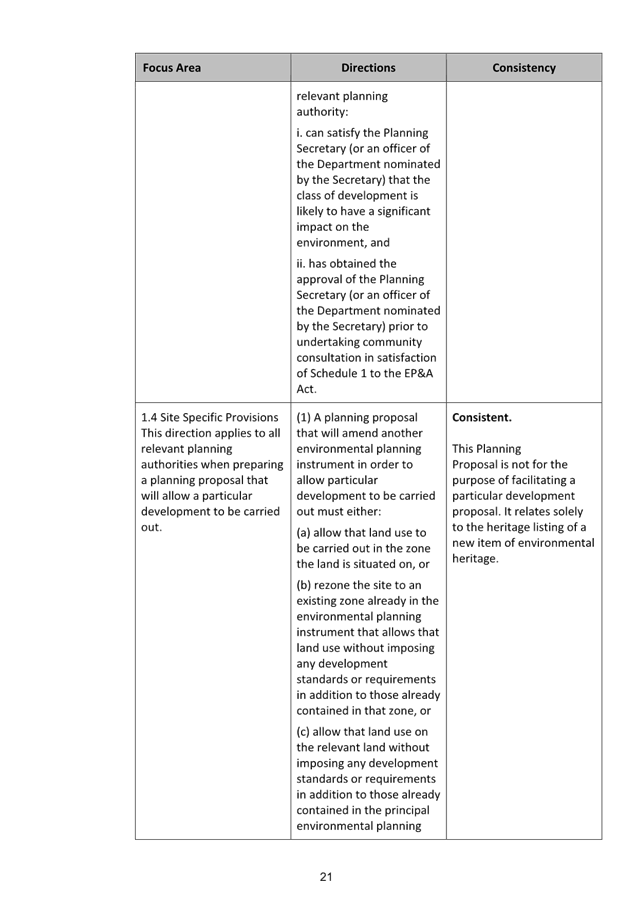
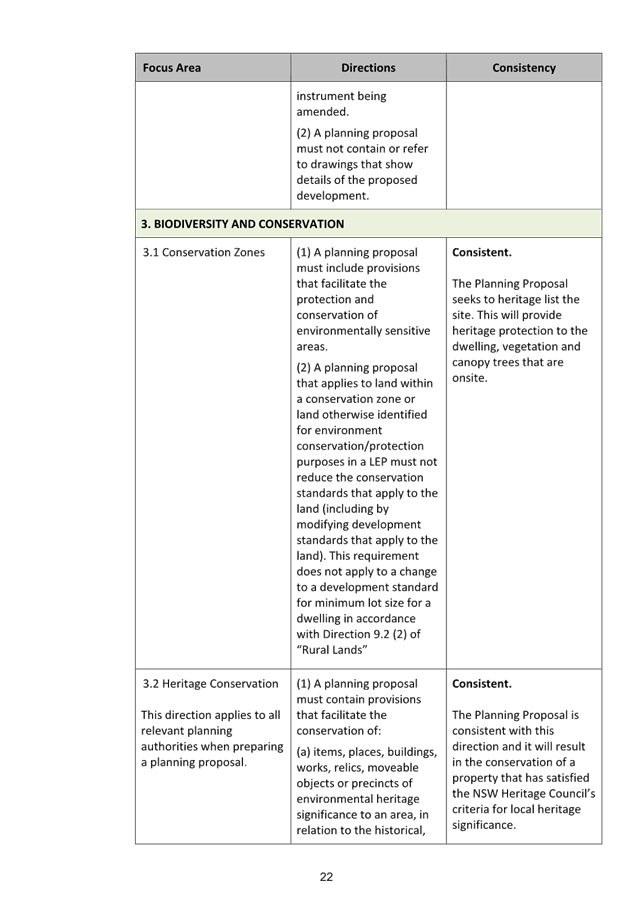
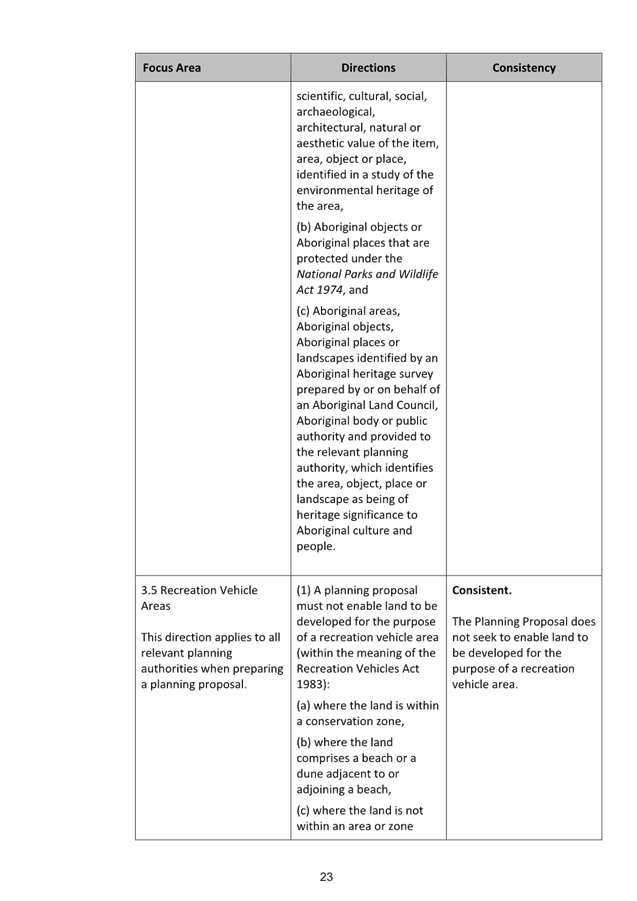
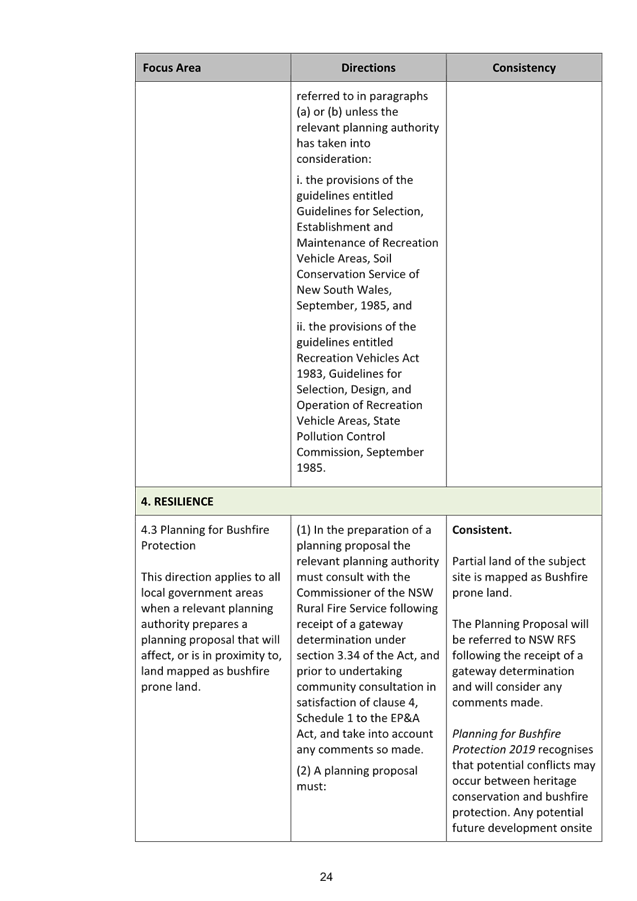
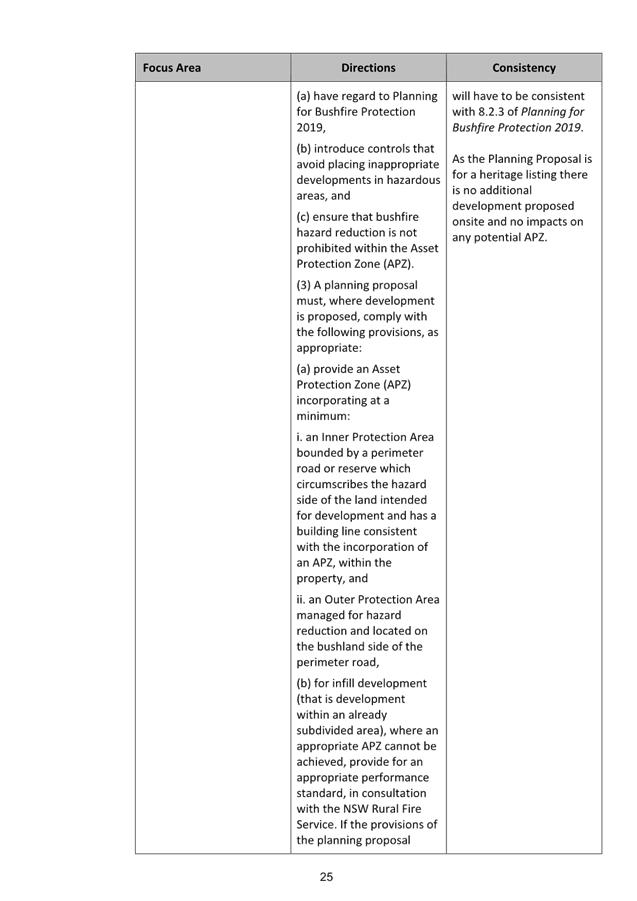
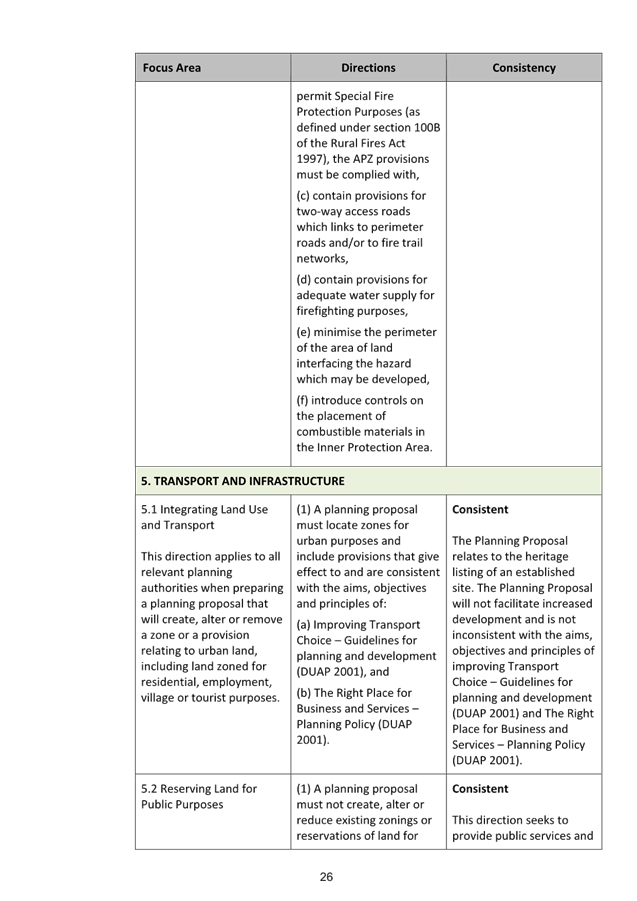
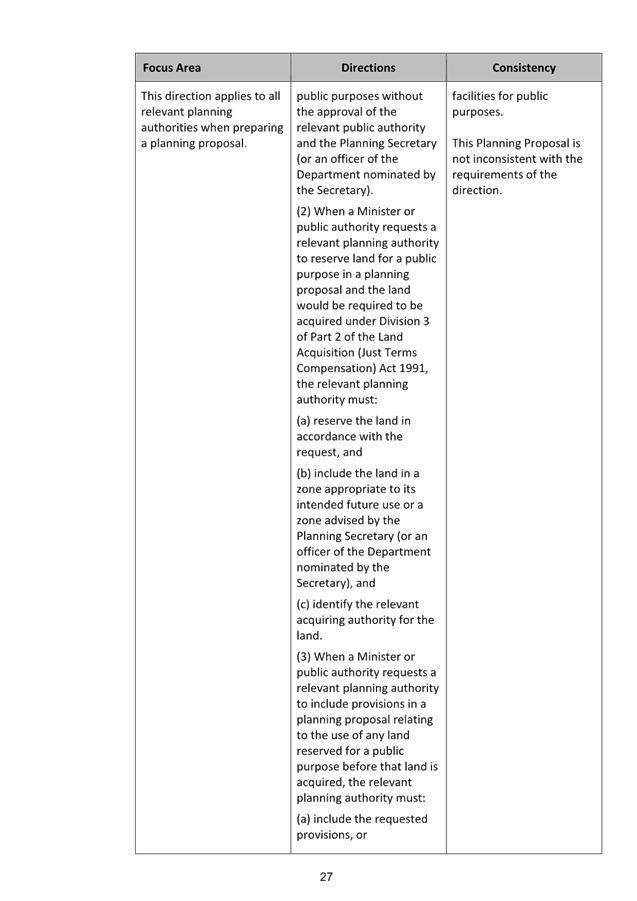
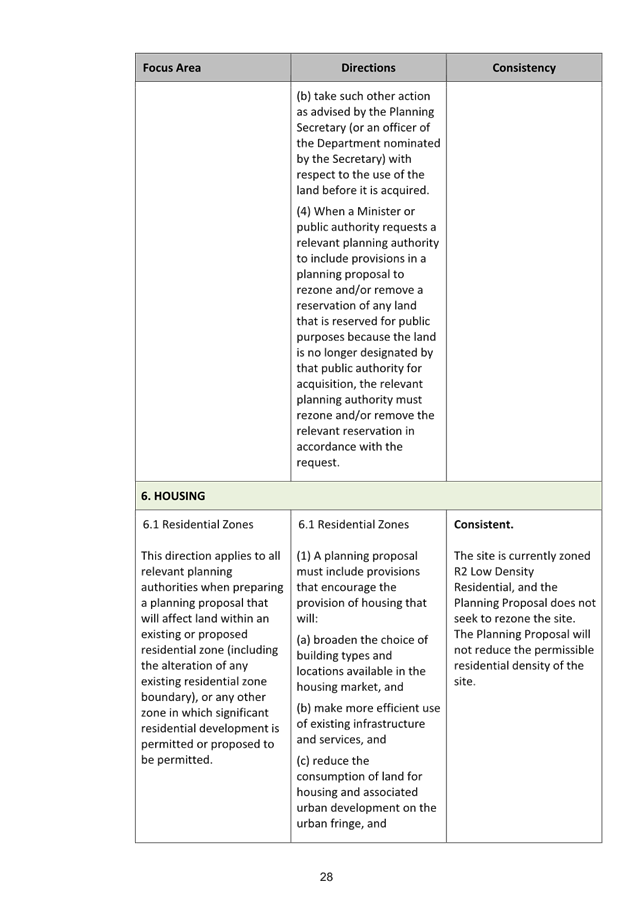
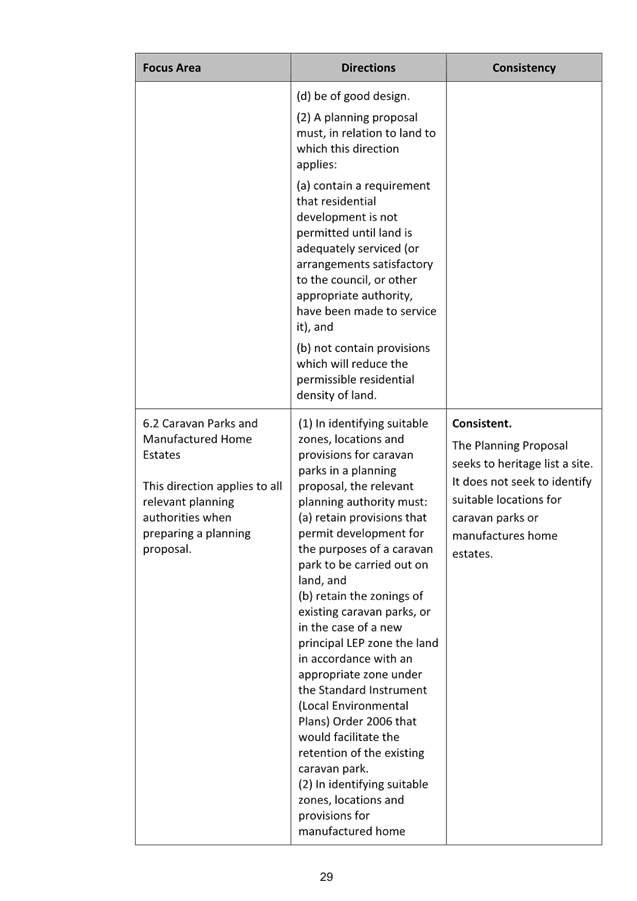
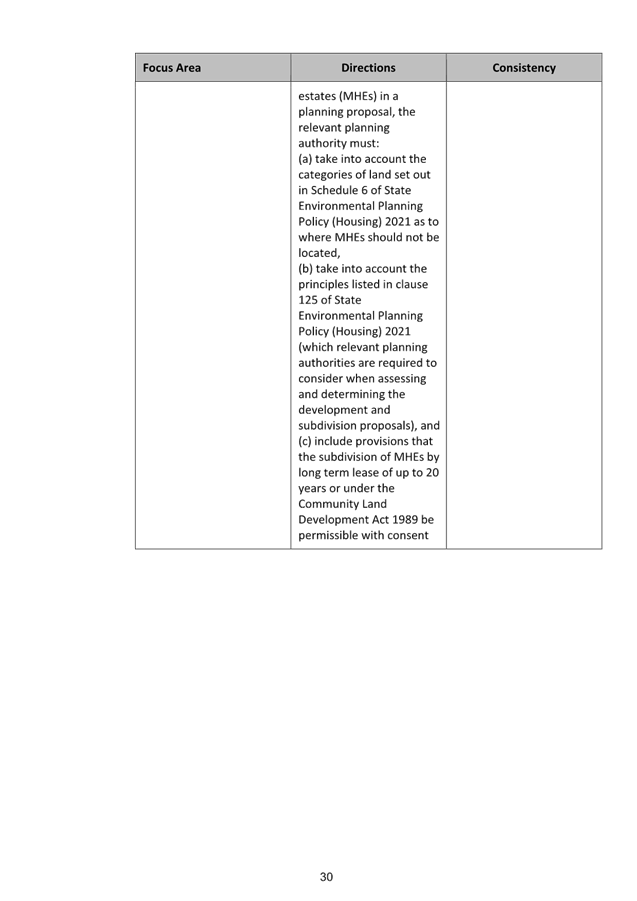
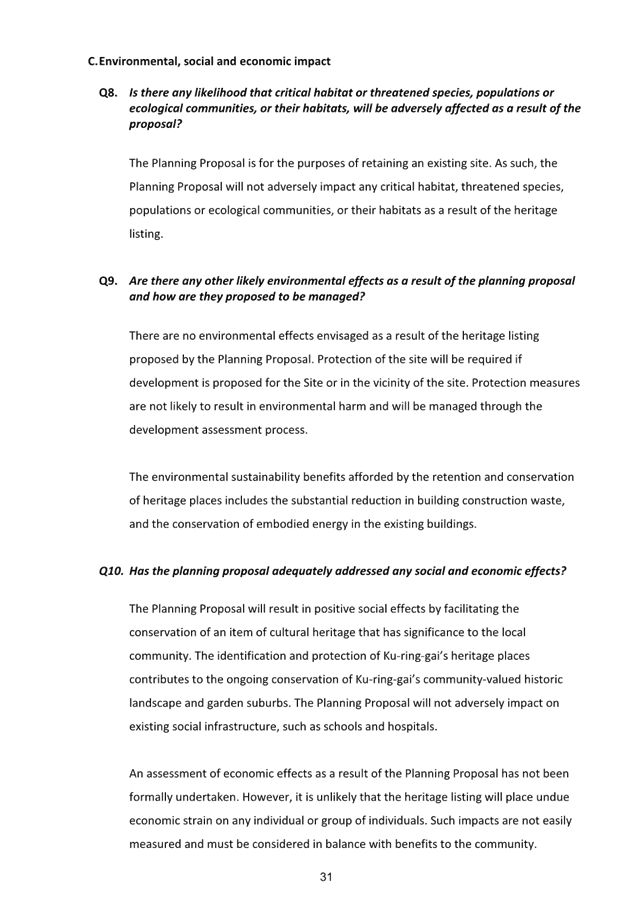

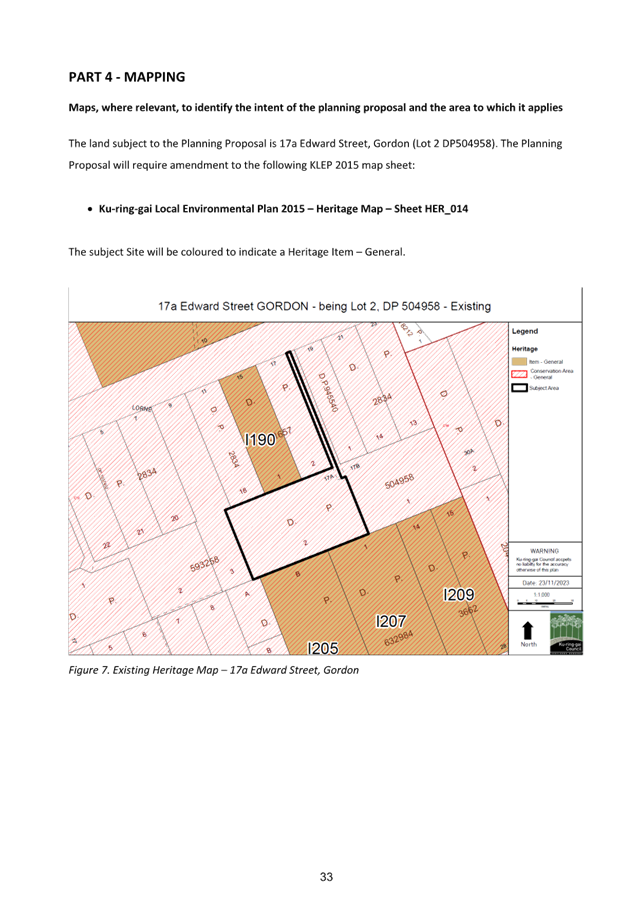
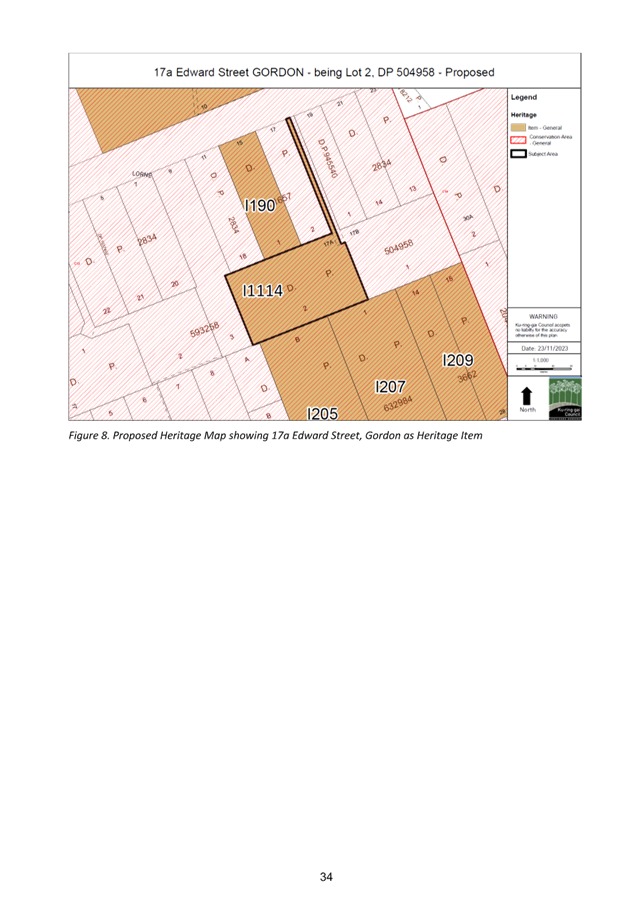
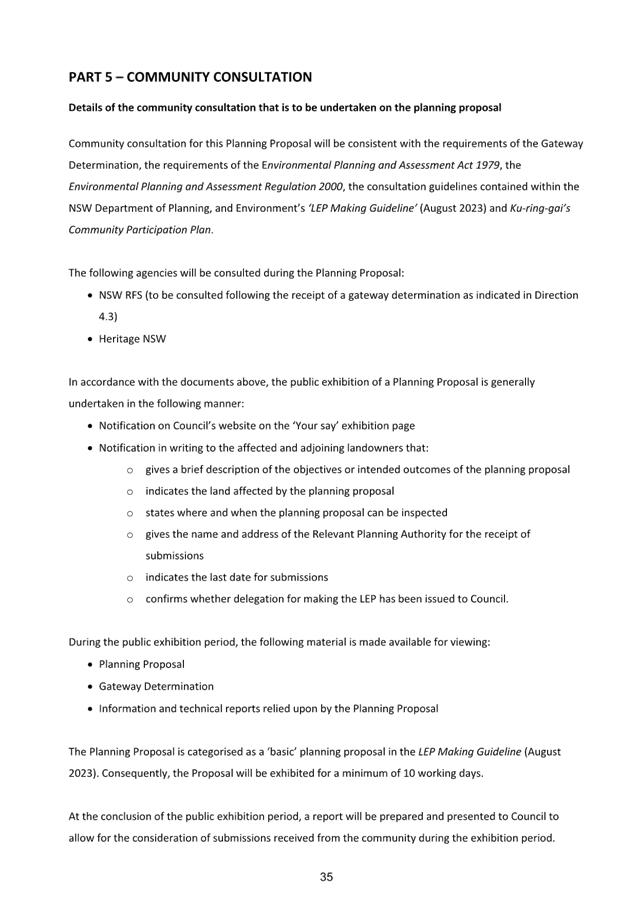
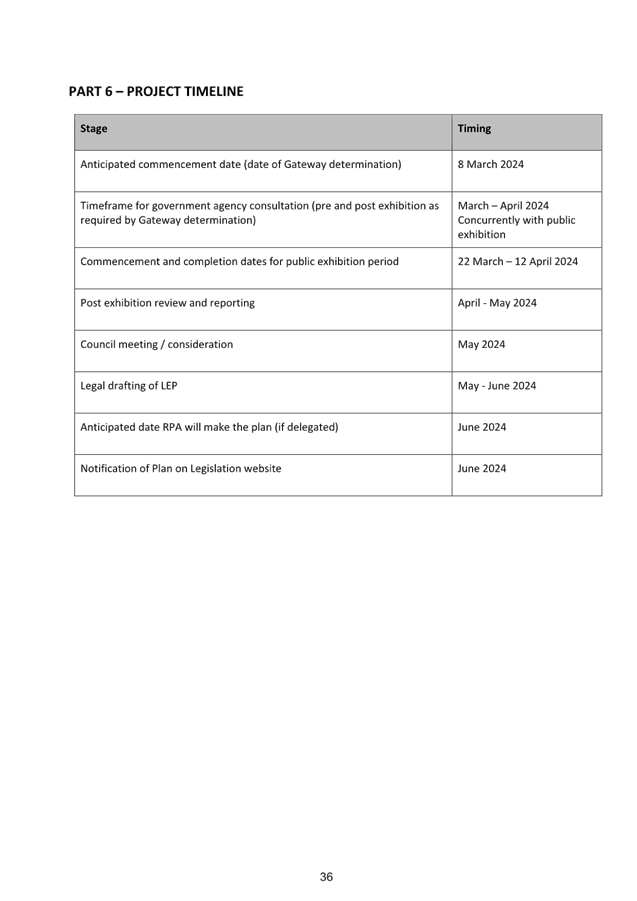



|
ATTACHMENT
No: 5 - Gateway
determination - PP-2023-2739 - 17a Edward Street, Gordon
|
|
Item No: GB.10
|
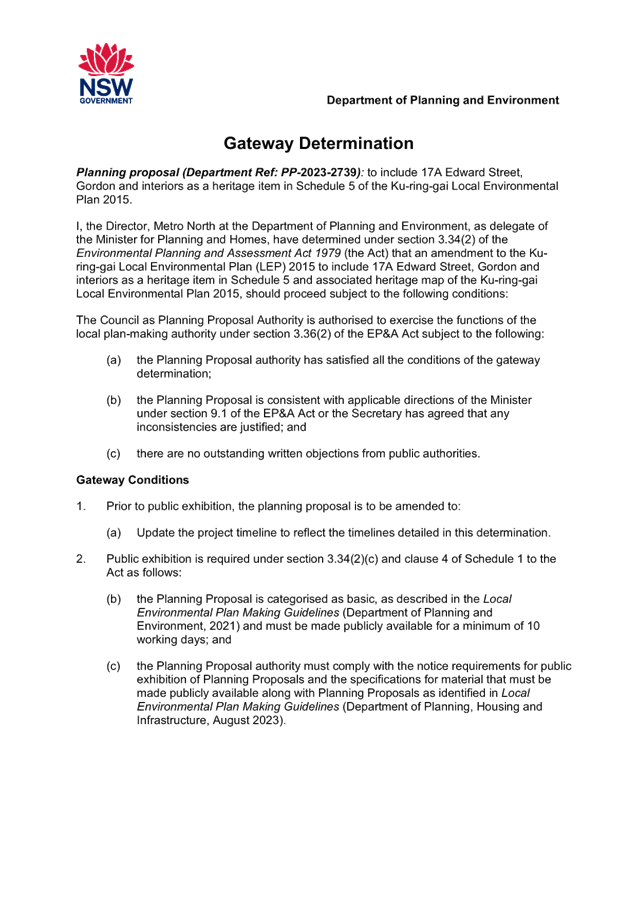
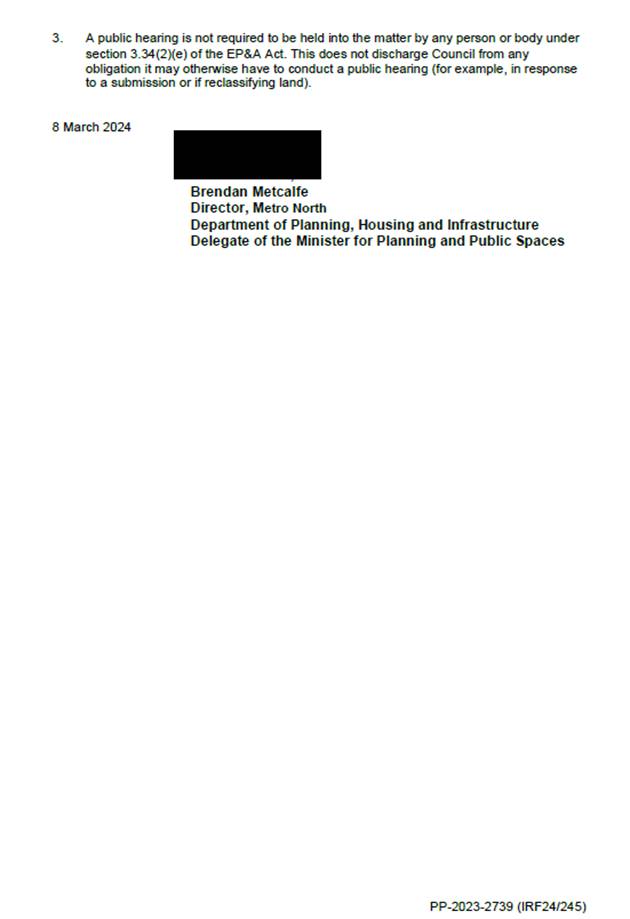
|
ATTACHMENT
No: 6 - SUBMISSION
SUMMARY TABLE - For Council Report - Consideration of Submissions - 17a
Edward Street, Gordon
|
|
Item No: GB.10
|
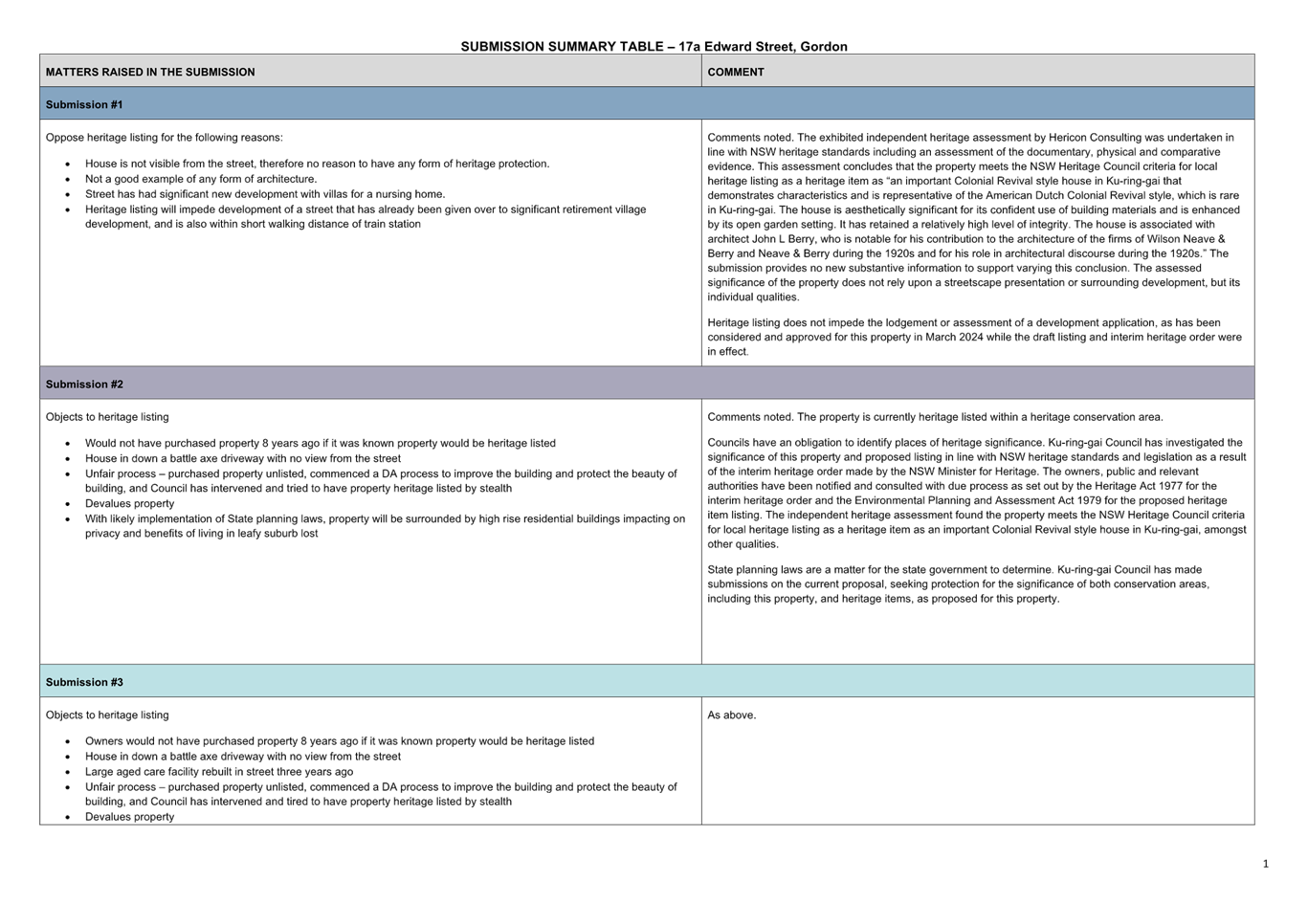

|
Ordinary
Meeting of Council - 21 May 2024
|
NM.1 / 1
|
|
|
|
|
Item
NM.1
|
S12062
|
Marian
Street Theatre, Lindfield Library
Notice of Motion from Councillor Lennon
dated 2 May 2024
Council owns the land on which the Lindfield Library stands.
That land also provides space for the Ku-ring-gai Youth Development Service
(KYDS), a senior citizens centre, accommodation, car parking, and lawns. If
Council resolves to sell that land, it would ensure that it provides
replacement library, KYDS, and senior citizen facilities, with parking.
On 14 February 2023, Council resolved at GB.1:
C. The required proceeds from the future sale of the
existing Lindfield Library will be quarantined and dedicated to the Lindfield
Village Hub project.
As a result of the state government (through Transport for
New South Wales) in November 2023 withdrawing $9.8 million funding for
additional commuter car parking in Ku-ring-gai, the Lindfield Village Hub might
not proceed at this time.
Council has not previously sought federal government, New
South Wales state government, philanthropic, or community funding for the
repairs and/or construction necessary to re-open the Marian Street Theatre as a
functional professional theatre.
I, therefore, move that:
A. Council
explore federal government, New South Wales state government, philanthropic,
and community funding for the repairs and/or construction necessary to re-open
the Marian Street Theatre as a functional professional theatre.
B. If
Council resolves to sell the Lindfield Library site, Council apply such of the
proceeds of any sale of the Lindfield Library site as are necessary to fund the
redevelopment of the Marian Street Theatre, after setting aside:
i. any
amount required for the Lindfield Village Hub, and
ii. if
the Lindfield Village Hub does not proceed or proceeds without a replacement
library, any other amount required to establish a new Lindfield library and to
replace the other community facilities that Council currently provides on the
Lindfield Library site.
Recommendation:
That the above Notice of Motion as printed be adopted.
|
Councillor Simon Lennon
Councillor for Gordon Ward
|
|
|
Ordinary
Meeting of Council - 21 May 2024
|
NM.2 / 1
|
|
|
|
|
Item
NM.2
|
CY00438/12
|
Updating
the Code of Meeting Practice to improve the accessibility and transparency of
our public forums and take action on urgent issues
Notice of Motion from Councillor Kay
dated 2 May 2024
Ku-ring-gai Council is committed to principles of good
governance: transparency, accessibility, and accountability. We recognise the
crucial role of community engagement in the democratic process.
As councillors are elected by their communities to make
decisions on their behalf, it is important that the community can see this
decision-making in action and understand how and why decisions are made. Live
streaming of council meetings assists with this (see the NSW Office of Local
Government’s Guide to Webcasting Council and Committee Meetings 2021).
By further leveraging this technology, we propose
livestreaming public forums as well. This would extend participation beyond the
physical council chambers, making these forums accessible to all, regardless of
physical limitations, geographic location, or scheduling constraints.
Livestreaming not only broadens engagement by offering a
real-time view into council operations, but also promotes greater public
confidence in the integrity of our processes. It ensures that council decisions
and the decision-making process are open and visible to the community,
reinforcing our dedication to transparency and ensuring the community's voice
is heard.
This approach will also provide a reliable record of
discussions and decisions. It curtails the spread of misinformation by allowing
direct public access to source material and enhances the accountability of
everyone involved in the council’s operations.
Adopting a policy to livestream all public forums would meet
the expectations of Ku-ring-gai residents for a modern, accessible and
responsive government. It would ensure that every community member can see and
participate in local government no matter where they are. This will maintain and
enhance public trust, engagement and allow a broader community to participate.
Lane Cove, Kiama and Kempsey Councils also hold public
forums on separate nights from meetings and livestream them. The benefits of
this are:
· Enhanced
Transparency: This openness builds trust between council and its residents
by showing that council is committed to transparency.
· Increased
Accessibility: By live streaming public forums, council can ensure that all
community members, including those who are unable to attend in person due to
disabilities, transport limitations or time constraints can stay informed and
engaged with local issues.
· Broader
Engagement: Live streaming can reach a larger audience, engaging residents
who might not typically attend council forums. This can lead to greater
community involvement and input in local government affairs, potentially
increasing public participation in surveys, feedback sessions and community
discussions.
· Accountability:
When meetings are accessible to a wider audience, council members and officials
are likely to be more mindful of their conduct and decisions. This
accountability can lead to more thoughtful, deliberate decision-making and can
enhance the integrity of the council.
· Record Keeping
and Review: Recorded live streams provide a permanent record of meetings,
which can be useful for creating accurate minutes, reviewing decisions and
allowing residents to access past forums at their convenience. This can be
particularly helpful for people who want to stay informed but have scheduling
conflicts.
· Reduction of
Misinformation: Providing direct access to meetings via live stream helps
ensure that information disseminated in the community is accurate and sourced
directly from the decision-makers, reducing misunderstandings and
misinformation.
Remote participation in public forums
This Council recently provided the opportunity for community
members to join our public forums remotely via Zoom.
In the same spirit of accessibility and inclusivity, it is
time to re-establish this option for the members of our community who are unable
to attend in person - and amend the Code of Meeting Practice to make this
permanent. We should be increasing opportunities for all our residents to have
their voices heard.
Granting the General Manager the authority to call an
extraordinary meeting.
This amendment would clarify any uncertainty in the current
Code of Meeting Practice about whether the General Manager can call an
extraordinary meeting to deal with urgent or unforeseen operational matters.
In line with Section 366 of the Local Government Act, the
current Code of Meeting Practice requires that the Mayor call an extraordinary
meeting if requested in writing by at least two councillors. However, the Act
and Code is silent on other ways that a meeting could be called.
There will be times when Council needs to come together to
deal with a matter of great urgency and importance. This could be to deal with
a natural disaster, an unexpected event in a major contract, a major policy
announcement, or to take advantage of a funding opportunity.
By updating the Code of Meeting Practice to incorporate
these amendments, we can create a more accessible and transparent Council,
encourage greater public engagement and take more timely action on critical
issues.
I, therefore, move that Council:
A. prepare
a new draft Code of Meeting Practice to allow for:
· public forums to
be webcast and recordings of public forums to be made available on
Council’s website
· public forums to
always be held as a hybrid meeting, unless the meeting is unable to be held
physically in the Council Chamber in which case it will be held by audio-visual
link only
· the General
Manager, in consultation with the Mayor, to call an extraordinary meeting to
consider urgent business without the need to obtain the signatures of two
councillors.
B. place
the draft Code of Meeting Practice on public exhibition for 28 days and bring a
report back to Council at the end of the consultation period summarising the
public response and providing a final version of the new Code of Meeting
Practice for adoption.
Recommendation:
That the above Notice of Motion as printed be adopted.
|
Councillor Christine Kay
Councillor for St Ives Ward
|
|
|
Ordinary
Meeting of Council - 21 May 2024
|
NM.3 / 1
|
|
|
|
|
Item
NM.3
|
S03289
|
Explore
Regional Sister City Relationships
Notice of Motion from Councillor Kay
dated 3 May 2024
Sister cities or twin towns are cooperative agreements
between communities, formalised through memorandums of understanding and
typically signed by local government representatives.
These agreements aim to promote collaboration and connection
through cultural exchange and understanding, economic collaboration, and mutual
support.
Sister Cities Australia facilitates such relationships by
matching communities within Australia, as well as internationally, that share
similar values yet offer diverse experiences. Establishing a Sister City
relationship could offer Ku-ring-gai Council significant cultural enrichment
and opportunities for economic and educational interchange, especially with
another town, city, or shire within New South Wales that shares our commitment
to sustainability and cultural diversity.
Potential Benefits of a Regional Sister City
Relationship:
1. Enhanced
cultural exchange that promotes deeper understanding and appreciation of
diverse Australian cultures, including Aboriginal heritage.
2. Economic
collaborations that could range from joint tourism promotions to shared local
business support initiatives.
3. Educational
exchanges focused on best practices in environmental sustainability,
particularly around Net Zero and Climate Wise communities.
4. Increased
community engagement through shared projects involving youth ambassadors,
culturally and linguistically diverse (CALD) communities, and volunteer
programs.
This initiative not only promises to enrich our community's
cultural landscape and economic vitality but also strengthens ties with other
regional centres, fostering a broader sense of cooperation and mutual growth
within the state.
I, therefore, move that
Ku-ring-gai Council:
A. investigate
the potential benefits, opportunities and costs of establishing Sister City
relationships with other regional communities in New South Wales.
B. reach
out to Sister Cities Australia to express interest in identifying and
progressing potential partnerships that align with our values and priorities.
Recommendation:
That the above Notice of Motion as printed be adopted.
|
Councillor Christine Kay
Councillor for St Ives Ward
|
|
|
Ordinary
Meeting of Council - 21 May 2024
|
NM.4 / 1
|
|
|
|
|
Item
NM.4
|
S08654
|
Domestic
Violence
Notice of Motion from Councillor Ward
dated 3 May 2024
Based on data provided by the NSW Police, it is distressing
to note that, on average, one woman loses her life every week due to violence
inflicted by a current or former partner.
One in three women has experienced physical or sexual
violence at the hands of someone they know. Shockingly, one in four young
people is willing to excuse violent behaviour from a partner. One in five women
have experienced violence from a partner. A woman is killed every two weeks in
Australia by their partner.
In 2023, NSW Police reported that there were 128 incidents
of domestic violence reported in Ku-ring-gai, along with 102 cases of sexual
assault or offence.
Domestic and family violence does not discriminate and has
increased. It impacts everyone no matter their age, background or
socio-economic status. People from culturally and linguistically diverse
backgrounds may misunderstand what domestic violence is and not know their
legal rights in relation to it.
The cycle of domestic and family violence starts with
disrespectful personal and/or family attitudes and behaviours.
All violence is unacceptable, whether it occurs in the home
or elsewhere, and no matter who perpetrates it. The underlying causes of
violence are complex but there is a growing body of research and evidence
linking gender-based violence to gender inequality.
Violence against women and girls is a prevalent, serious and
preventable violation of human rights, therefore we must take action and do all
we can to change the landscape. Everyone deserves to be safe, supported and
respected.
Domestic Violence Remembrance Day was on 1 May 2024, and
communities across Australia came together to remember those we’ve lost
to domestic and family violence. I attended a number of events held by various
Councils where we came together to light a candle and honour the memory of
those lost as a result of domestic or family violence.
As a Patron of Hornsby Ku-ring-gai Women’s Shelter - I
am acutely aware that domestic and family violence is the main reason women and
children leave their homes which leads to so many issues including housing
insecurity and homelessness. Whilst the Shelter support many, sadly many
aren’t helped because of a lack of resources.
As a council, we must do everything we can to raise
awareness, partner with other levels of government, and support the critical
work of our community groups.
I, therefore, move that Council:
A. Develops
and implements an Action Plan to increase awareness and prevention of domestic,
family, and sexual violence.
B. Embeds
gender equality and respect in Council and our community.
C. Marks
Domestic Violence Remembrance Day by holding or supporting an event in
Ku-ring-gai.
Recommendation:
That the above Notice of Motion as printed be adopted.
|
Councillor Barbara Ward
Councillor for Gordon Ward
|
|
|
Ordinary
Meeting of Council - 21 May 2024
|
NM.5 / 1
|
|
|
|
|
Item
NM.5
|
S07823
|
Optimising
the management of natural turf sporting fields to enable increased usage
Notice of Motion from Councillor G.
Taylor dated 3 May 2024
Across Ku-ring-gai, and as reported in the recently
developed Recreation Needs Study, demand for recreational spaces and sports
fields is high. This demand for sports fields is expected to increase along
with population growth and increased housing density. This increased demand for
recreational spaces in Ku-ring-gai reflects trends seen across Greater Sydney.
Due to the scarcity and affordability of land for new public
spaces within Ku-ring-gai, meeting any increased demand for sporting fields
poses a significant challenge. Land for new sports spaces may not be
financially, socially, or environmentally feasible and as such there is a need
to improve the capacity and quality of existing sports fields.
There are many factors in the construction and development
of high-capacity fields including location and solar access, soil and turf
selection, drainage, construction method, budget, and water availability.
Similarly, there are many factors for the management of high-capacity fields
including activity types, player numbers and intensity as well as budget,
nutrient, fertilisation and chemical regimes, aeration and soil improvement,
pest and disease management practices and education of users. By addressing
these factors, the capacity and quality of natural turf fields could be
significantly improved, providing sustainable and high-quality playing surfaces
for sports and recreational activities.
Ku-ring-gai currently has 55 sports fields and optimising
the quality and capacity of these fields may represent a significant
opportunity to meet future demand. By selecting key sites that have recently
been constructed or which are below average condition, Council could partner
with industry experts to design a trial aimed at improving management practices
and capacity across the LGA.
I, therefore, move:
That a report be brought back to Council outlining a trial
aimed at increasing the usage capacity of selected existing natural turf
sporting fields when supported by optimal soil and turf amendments, maintenance,
and wear and usage management regimes.
Recommendation:
That the above Notice of Motion as printed be adopted.
|
Councillor Greg Taylor
Councillor for Comenarra Ward
|
|
|
Ordinary
Meeting of Council - 21 May 2024
|
NM.6 / 1
|
|
|
|
|
Item
NM.6
|
S13239
|
Support
for Pymble Ladies College
Notice of Motion from Councillor Ward
dated 3 May 2024
Pymble Ladies’ College has been a steadfast supporter
of HerVillage Foundation since former student Tahmara Thomas presented
her ideas to assist recently arrived refugees from Afghanistan following the
resurgence of the Taliban in 2021. The College readily provided access to its
sports fields, buildings, buses and staff, while actively encouraging student
participation and promoting Tahmara’s initiative.
Recognising the importance of cultural cohesion in Sydney,
the school, renowned for celebrating its diverse student population, places
great value on fostering intercultural understanding and cultivating a sense of
belonging. Through various inclusive avenues such as sport, performing arts,
curriculum, STEM activities and interfaith dialogue, Pymble Ladies’
College actively endeavours to bring people together, nurturing familial and
communal engagement in inclusive spaces.
HerVillage Foundation is a non-for-profit that
focuses on empowering young women of refugee background as the leaders of our
tomorrow. At HerVillage, the vision is to create lifelong learning
opportunities for girls who are recently arrived refugees in Australia. Their
program, the Village Championship, focuses on raising funds and awareness as
well as promoting settlement into Australian society for recently arrived
refugee students through friendship-building and sport.
In partnership with Pymble Ladies’ College and Barker
College, HerVillage Foundation is expanding the communities they work
with to involve students from the Ukrainian community and the Rohingya
community as well as the Afghan community. An event is planned,
which will be held at Pymble Ladies' College on Sunday June 2nd from 12.45-5pm.
Day one is a leadership program/ice break event, day two is a football training
day and day three is the big cultural festival that is open to general public.
On this day there will be food stalls, inspirational speakers, live music and
cultural activities, and it all centres around a football match played by the
girls involved.
HerVillage Foundation and PLC are doing amazing work
in this space, and I believe the community will benefit from learning more
about this work.
I, therefore, move that Council:
A. Support
the event by acknowledging and allowing the use of its logo
B. If
practicable promote through its social media and or website
C. Promote
in its newsletter
Recommendation:
That the above Notice of Motion as printed be adopted.
|
Councillor Barbara Ward
Councillor for Gordon Ward
|
|
|
Ordinary
Meeting of Council - 21 May 2024
|
QN.1 / 1
|
|
|
|
|
Item
QN.1
|
S13633
|
What
is Council's Position on Environmental Issues at the North Turramurra
Recreation Area ("NTRA") and if Leased will the Lessee be Legally
Responsible?
QUESTION:
Question from Councillor Spencer dated 29 April 2024
Facts:
This question with notice is to avoid residents from having
to spend their hard-earned money on legal actions taken against council over
its obligations to the environment and community – e.g., the recent case
between resident groups and council over environmental issues at the Norman
Griffiths Football Field costs both parties a significant amount of money.
Questions:
1. How
many pit traps are there at NTRA to catch microplastic movement?
2. What
monitoring of the Duffy's forest plant community below the oval has council
undertaken?
3. What
monitoring of chemical and microplastic movement from the oval has council
undertaken?
4. If
the NTRA is leased, will the lessee be responsible for environmental issues,
not limited to issues raised in 1, 2 and 3 above?
5. If
the lessee is in breach of their environmental obligations, not limited to
issues raised in 1, 2 and 3 above, what recourse will council have against
them?
6. As
a matter of public interest, will the General Manager provide answers to the
above questions in written format to be distributed to councillors at the OMC
dated 21 May 2024?
|
Councillor Cedric Spencer
Councillor for Wahroonga Ward
|
|
|
Ordinary
Meeting of Council - 21 May 2024
|
QN.2 / 1
|
|
|
|
|
Item
QN.2
|
S13191
|
Norman
Griffiths Oval
QUESTION:
Question from Councillor Kay dated 2 May 2024.
Delays to Construction
Council states online that the oval has been delayed due to "excessive wet weather, unsuitable ground material
and the identification of contaminated soil".
1. In terms of unsuitable ground material and identification
of contaminated soil, studies in the Review of Environmental Factors (REF)
point to the presence of unconsolidated fill and the risk of asbestos. Why were
these possibilities not explored nor taken into account before embarking on
construction?
2. Given
this is the case, has the contactor been paid for any extra costs due to
unconsolidated fill or asbestos?
3. Can you please list the causes for
the delays at Norman Griffiths Oval?
4. Please also advise whether council
or the contractor is liable for additional costs regarding each cause.
5. Please also advise whether the
contractor is liable for any liquidated damages for delay.
Costs of Oval
1. What
was the contracted cost for the oval?
2. Have
there been any variations to the contract. Please provide what the variations
were for and what the costs of these variations were.
3. How
much is the oval costing to date?
4. What is
the predicted final cost of the whole project?
Flood Risk and Impact on Sydney Turpentine Ironbark
Forest and Microplastics
1. The
REF outlines an overland path in a flood event in that goes through the Sydney
Turpentine Ironbark Forest (STIF). How has council satisfied itself that this
will not impact on the critically endangered forest?
2. What
studies or modelling has council undertaken with regards to the movement of the
cork infill and plastic turf in the event of a probable maximum flood?
3. When
will the council be undertaking comprehensive modelling of the flood risk and
impact at Norman Griffith oval, including impact on Quarry Creek downstream and
the STIF around it?
4. How
many traps are there to collect microplastic infill at Charles Bean Oval, North
Turramurra Recreation Area (NTRA) and Norman Griffiths Oval?
Legal Issues
On 19 November 2019 when asked about the liability concerns
of councillors and council staff given the flood risk at Norman
Griffith? A senior member of staff stated:
In the event, the example
being export of that material into the creek – if that was deemed to be
environmental harm, it may well be that the officers that signed the REF would
be personally responsible for prosecution and there has been precedence for
that in the past.
Given this statement and the fact that the Chief Scientist
report says that synthetic field should not be placed on flood prone land or
sensitive ecosystems, what advice has council received as to the legal
liability of councillors and staff in the event of:
1. Microplastic
and chemical pollution entering Quarry Creek downstream from Norman Griffith
oval?
2. Damage
to the STIF?
|
Councillor Christine Kay
Councillor for St Ives Ward
|
|
|
Ordinary
Meeting of Council - 21 May 2024
|
QN.3 / 1
|
|
|
|
|
Item
QN.3
|
S12198
|
Stranded
Heritage Items in Transport Oriented Development Precincts
QUESTION:
Question from Councillor Sam Ngai dated 2 May 2024.
Following the publication of the State Government’s
draft Transport Oriented Development (TOD) precinct mapping, multiple residents
have approached councillors with a dilemma. In each case, they live in a
locally listed heritage item while being surrounded by properties that have the
TOD provisions applied. In the future, this means that they will be walled off
by 22m buildings on 2 or 3 sides while also losing access to privacy and
amenity.
What assurances or options are available to these residents?
|
Councillor Sam Ngai
Mayor
|
|



































































































































































































